Compositions And Methods For Inhibiting Ptpn22
MEFFRE; Eric ; et al.
U.S. patent application number 16/304807 was filed with the patent office on 2020-10-08 for compositions and methods for inhibiting ptpn22. The applicant listed for this patent is YALE UNIVERSITY. Invention is credited to Eric MEFFRE, Jean-Nicolas SCHICKEL.
| Application Number | 20200316070 16/304807 |
| Document ID | / |
| Family ID | 1000004970362 |
| Filed Date | 2020-10-08 |





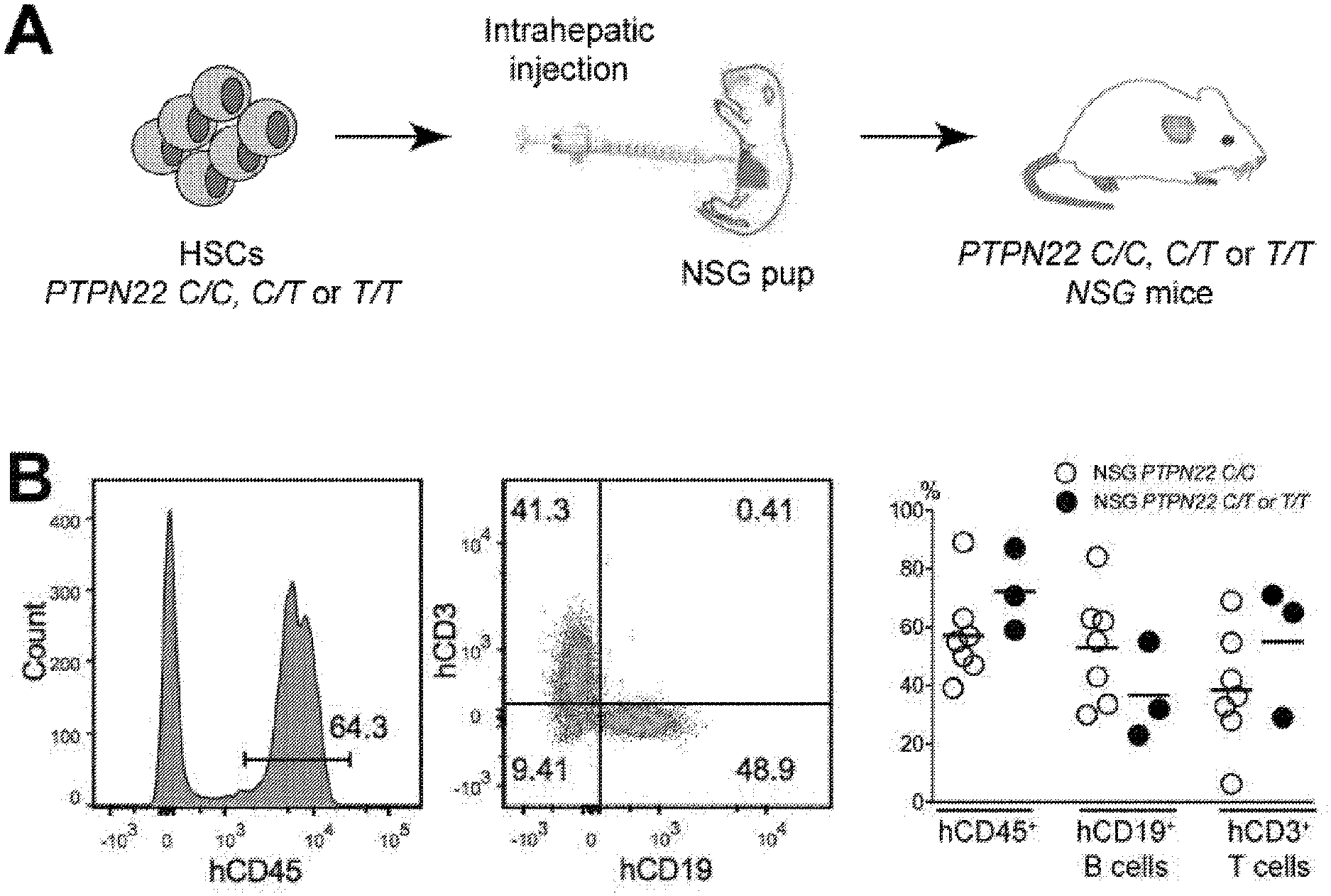
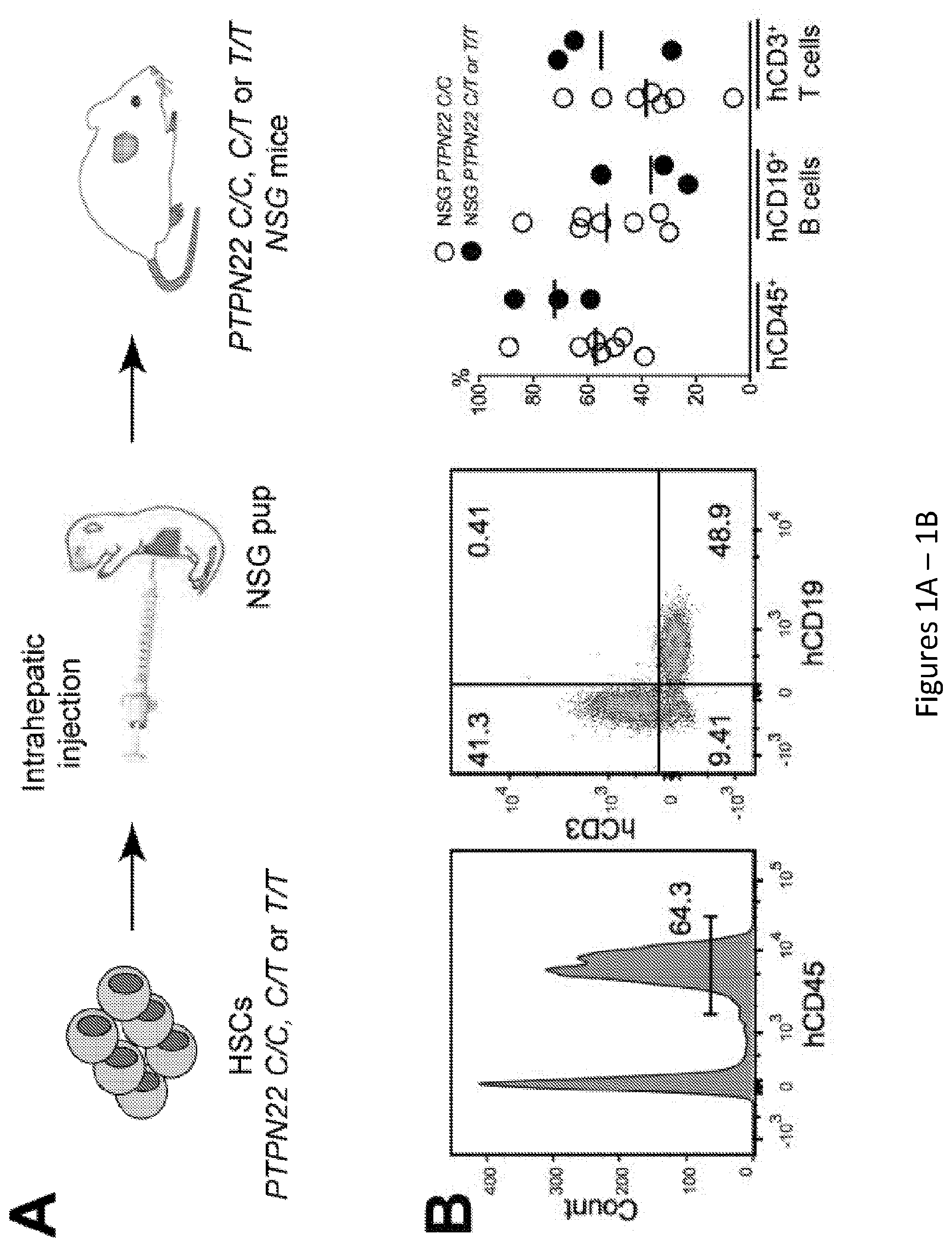
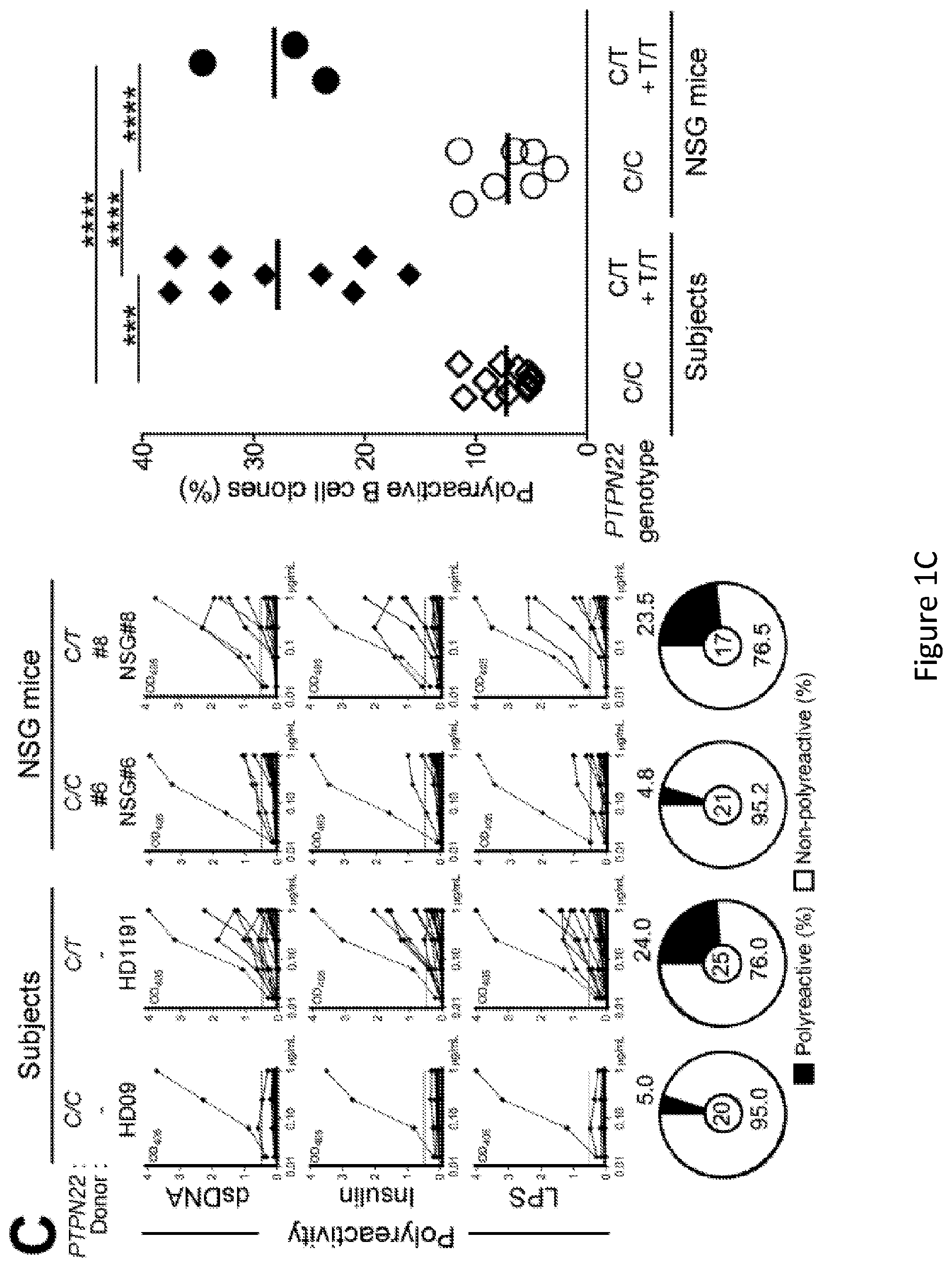
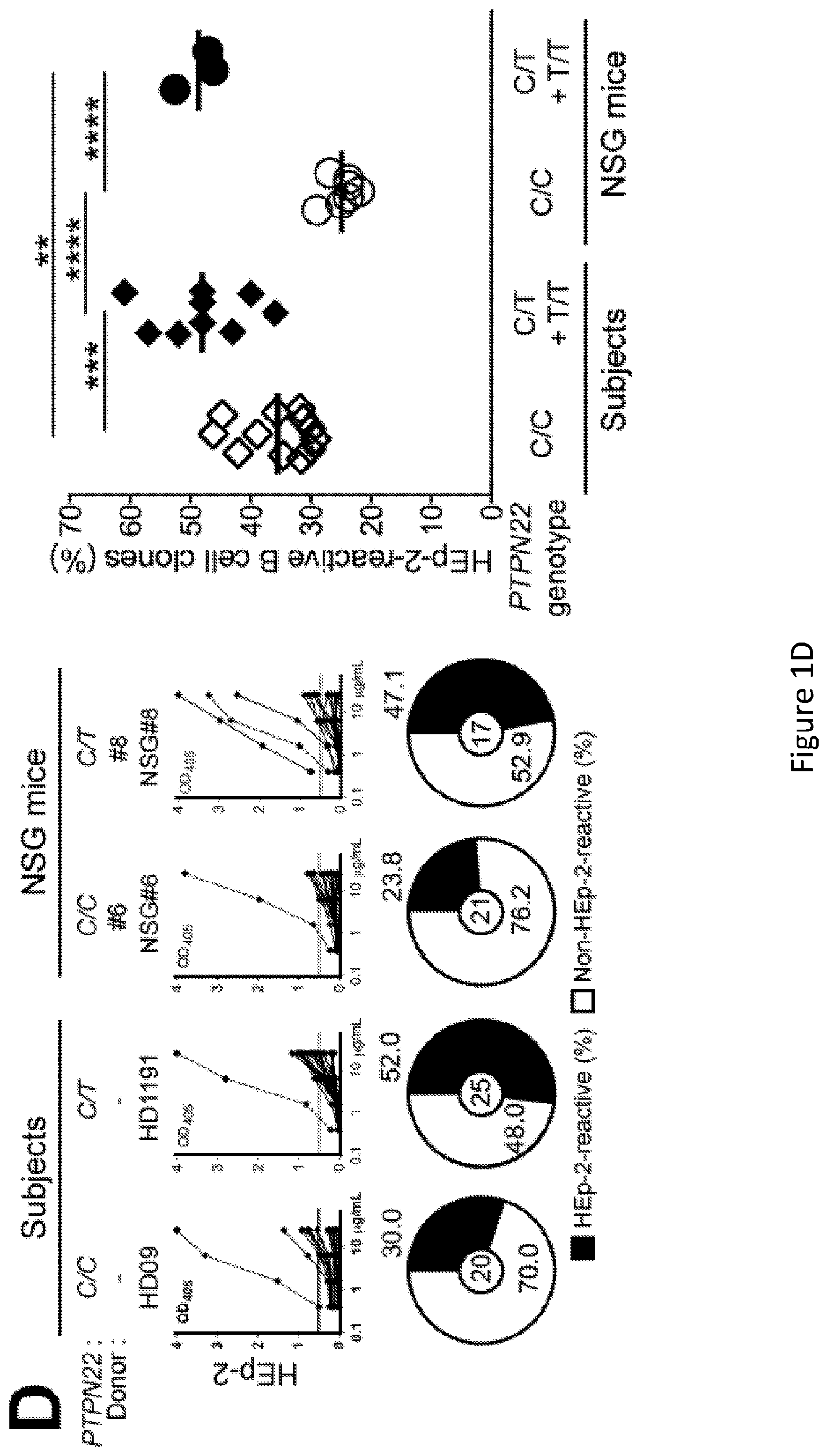

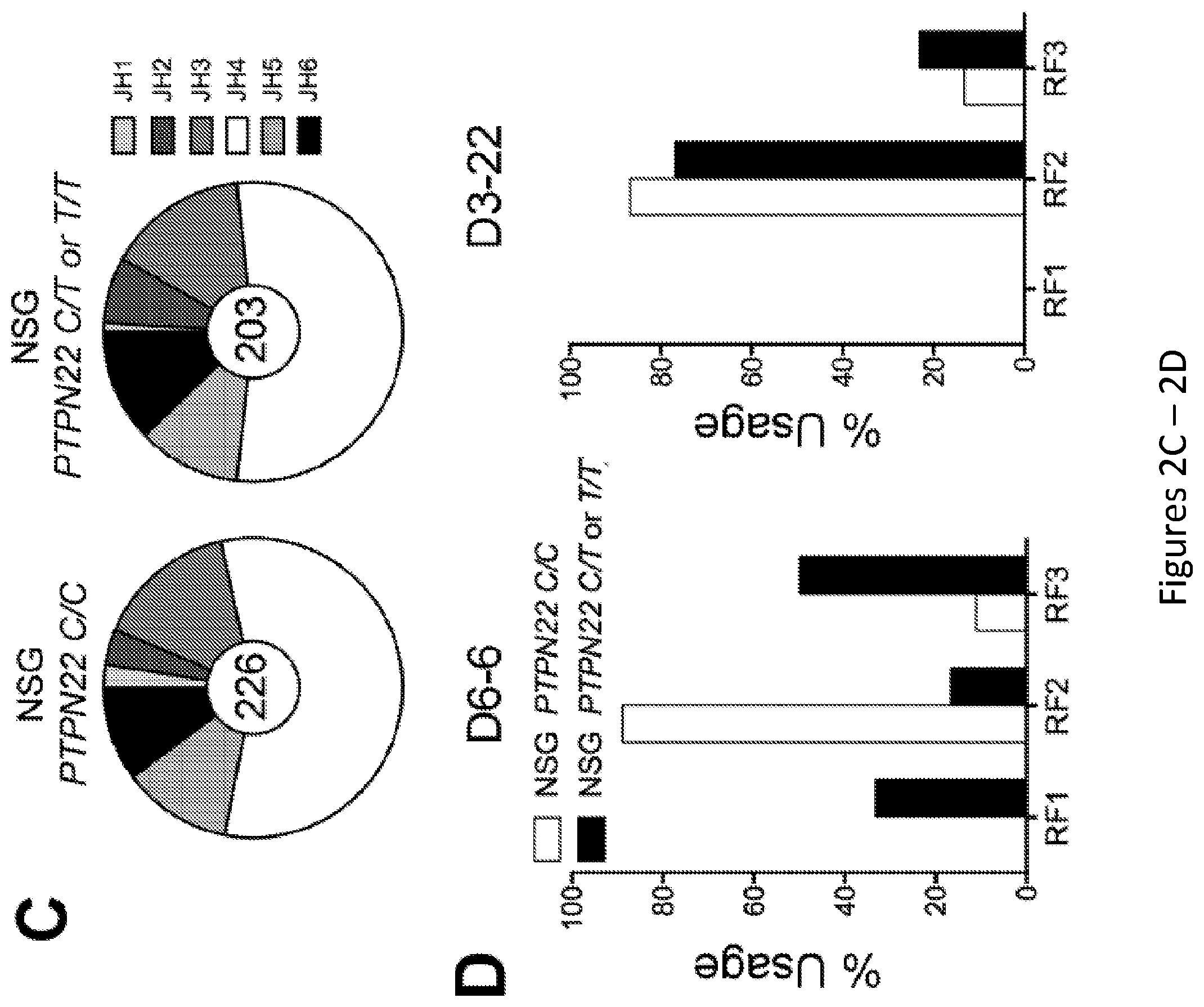
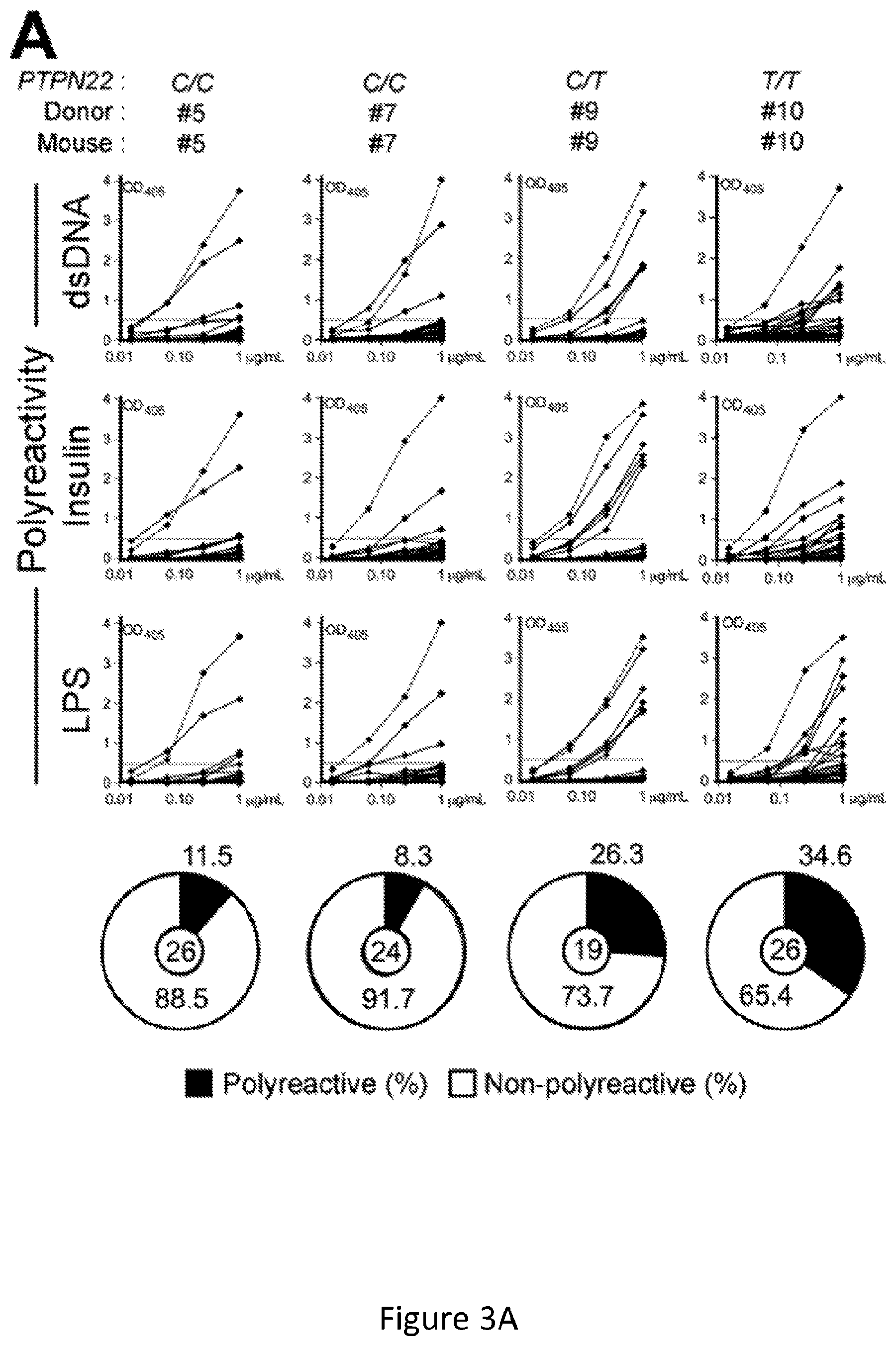
View All Diagrams
| United States Patent Application | 20200316070 |
| Kind Code | A1 |
| MEFFRE; Eric ; et al. | October 8, 2020 |
COMPOSITIONS AND METHODS FOR INHIBITING PTPN22
Abstract
The present invention provides compositions and methods for inhibiting PTPN22 for restoring human central B-cell tolerance or for treating or preventing an autoimmune disease or disorder.
| Inventors: | MEFFRE; Eric; (New Haven, CT) ; SCHICKEL; Jean-Nicolas; (New Haven, CT) | ||||||||||
| Applicant: |
|
||||||||||
|---|---|---|---|---|---|---|---|---|---|---|---|
| Family ID: | 1000004970362 | ||||||||||
| Appl. No.: | 16/304807 | ||||||||||
| Filed: | May 26, 2017 | ||||||||||
| PCT Filed: | May 26, 2017 | ||||||||||
| PCT NO: | PCT/US2017/034720 | ||||||||||
| 371 Date: | November 27, 2018 |
Related U.S. Patent Documents
| Application Number | Filing Date | Patent Number | ||
|---|---|---|---|---|
| 62342250 | May 27, 2016 | |||
| Current U.S. Class: | 1/1 |
| Current CPC Class: | A61K 31/515 20130101; C12N 2310/14 20130101; C12N 15/113 20130101; C12N 2310/531 20130101; A61K 45/06 20130101; A61K 31/7105 20130101 |
| International Class: | A61K 31/515 20060101 A61K031/515; C12N 15/113 20060101 C12N015/113; A61K 31/7105 20060101 A61K031/7105 |
Claims
1. A composition for treating or preventing an abnormal early B-cell tolerance checkpoint comprising an inhibitor of PTPN22.
2. The composition of claim 1, wherein the inhibitor of PTPN22 is at least one selected from the group consisting of a protein, a peptide, a peptidomemetic, an antibody, a ribozyme, a small molecule chemical compound, a nucleic acid, a vector, an antisense nucleic acid molecule.
3. The composition of claim 2, wherein the inhibitor of PTPN22 is a small molecule chemical compound.
4. The composition of claim 3, wherein the small molecule chemical compound is ##STR00005## a derivative thereof, or a salt thereof.
5. The composition of claim 2, wherein the inhibitor of PTPN22 is a nucleic acid.
6. The composition of claim 5, wherein the nucleic acid comprises a nucleotide sequence selected from SEQ ID NO:1 and SEQ ID NO:2.
7. The composition of claim 1, wherein the abnormal early B-cell tolerance checkpoint is associated with an autoimmune disease or disorder.
8. The composition of claim 7, wherein the autoimmune disease or disorder is selected from the group consisting of type 1 diabetes, rheumatoid arthritis, multiple sclerosis, systemic lupus erythematosus, systemic sclerosis, Sjogren's syndrome, autoimmune thyroiditis, myasthenia gravis, and pemphigus.
9. A method for treating or preventing an autoimmune disease or disorder the method comprising administering a composition comprising an inhibitor of PTPN22 to a subject in need thereof.
10. The method of claim 9, wherein the inhibitor of PTPN22 is at least one of the group consisting of a chemical compound, a protein, a peptide, a peptidomemetic, an antibody, a ribozyme, a small molecule chemical compound, a nucleic acid, a vector, an antisense nucleic acid molecule.
11. The method of claim 9, wherein the autoimmune disease or disorder is selected from the group consisting of type 1 diabetes, rheumatoid arthritis, multiple sclerosis, and systemic lupus erythematosus.
12. The method of claim 9 wherein the subject has a 1858T PTPN22 polymorphism on at least one allele.
13. The method of claim 9, wherein the subject is human.
14. A method for restoring human central B-cell tolerance in a subject the method comprising administering a composition comprising an inhibitor of PTPN22 to a subject in need thereof.
15. The method of claim 14, wherein the inhibitor of PTPN22 is at least one of the group consisting of a chemical compound, a protein, a peptide, a peptidomemetic, an antibody, a ribozyme, a small molecule chemical compound, a nucleic acid, a vector, an antisense nucleic acid molecule.
16. The method of claim 15, wherein the autoimmune disease or disorder is selected from the group consisting of type 1 diabetes, rheumatoid arthritis, multiple sclerosis, and systemic lupus erythematosus.
17. The method of claim 14, wherein the subject fails to properly remove developing autoreactive B cells.
18. The method of claim 14 wherein the subject has a 1858T PTPN22 polymorphism on at least one allele.
19. The method of claim 14, wherein the subject is human.
Description
CROSS-REFERENCE TO RELATED APPLICATIONS
[0001] The present application is entitled to priority to U.S. Provisional Application No. 62/342,250, filed May 27, 2016, which is incorporated by reference herein in its entirety.
BACKGROUND OF THE INVENTION
[0002] A role for B cells in autoimmune disease is now established both in mouse models as well as in humans by successful treatment of rheumatoid arthritis and by showing efficacy at delaying other autoimmune diseases with anti-CD20 monoclonal antibodies that eliminate B cells. However, B cell depletion is a severe insult to the immune system that may be harmful for patients. In addition, patients often relapse after anti-B cell therapy several months later coinciding with the reappearance of B cells in the blood of these subjects. These newly generated B cells likely include many autoreactive clones because patients with rheumatoid arthritis (RA), systemic lupus erythematosus (SLE) and type 1 diabetes (T1D) display abnormal early B-cell tolerance checkpoints resulting in a failure to remove developing autoreactive B cells. Hence, the efficacy of anti-B cell therapy may be limited because it may not fix the intrinsic tolerance mechanisms defective in autoimmune diseases, such as RA, SLE and T1D.
[0003] Rituximab, an anti-CD20 monoclonal antibody that eliminates B cells, has shown efficacy in T1D, RA and multiple sclerosis (MS), and exposes a role for B cells in promoting autoimmunity (Pescovitz et al., 2009, NEJM 361:2143-52; Edwards et al., 2004, NEJM 350:2572-81; Hauser et al., 2008, NEJM 358:676-88). However, anti-B cell therapy does not reset early B cell tolerance checkpoints defective in T1D likely because these impaired autoreactive B cell counterselection steps may be primary to the development of this autoimmune disease (Chamberlain et al., 2015, J Clin Invest 126:282-7). Indeed, asymptomatic individuals carrying the PTPN22 T allele display elevated frequencies of autoreactive B cells in their blood similar to those in T1D, RA and SLE patients (Menard et al., 2011, J Clin Invest 121:3635-44).
[0004] There is thus a need in the art for restoring human central B-cell tolerance and for prevention or treatment of autoimmunity. The present invention addresses this unmet need in the art.
SUMMARY OF THE INVENTION
[0005] In one aspect, the invention provides compositions and methods for treating or preventing an abnormal early B-cell tolerance checkpoint. In one embodiment, the composition of the invention comprises an inhibitor of PTPN22.
[0006] In one embodiment, the inhibitor of PTPN22 is at least one selected from the group consisting of a protein, a peptide, a peptidomemetic, an antibody, a ribozyme, a small molecule chemical compound, a nucleic acid, a vector, an antisense nucleic acid molecule.
[0007] In one embodiment, the inhibitor of PTPN22 is a small molecule chemical compound. For example, in one embodiment, the inhibitor of PTPN22 is
##STR00001##
a derivative thereof, or a salt thereof.
[0008] In one embodiment, the inhibitor of PTPN22 is a nucleic acid. For example, in one embodiment, the inhibitor of PTPN22 is a nucleic acid comprising a nucleoctide sequence selected from SEQ ID NO:1 and SEQ ID NO:2.
[0009] In one embodiment, the abnormal early B-cell tolerance checkpoint is associated with an autoimmune disease or disorder. For example, in one embodiment, the autoimmune disease or disorder is selected from the group consisting of type 1 diabetes, rheumatoid arthritis, multiple sclerosis, systemic lupus erythematosus, systemic sclerosis, Sjogren's syndrome, autoimmune thyroiditis, myasthenia gravis, and pemphigus.
[0010] In one aspect, the invention provides a method for treating or preventing an autoimmune disease or disorder. The invention also provides a method for restoring human central B-cell tolerance in a subject. In one embodiment, the method comprises administering a composition comprising an inhibitor of PTPN22 to a subject in need thereof.
[0011] In one embodiment, the inhibitor of PTPN22 is at least one of the group consisting of a chemical compound, a protein, a peptide, a peptidomemetic, an antibody, a ribozyme, a small molecule chemical compound, a nucleic acid, a vector, an antisense nucleic acid molecule.
[0012] In one embodiment, the autoimmune disease or disorder is selected from the group consisting of type 1 diabetes, rheumatoid arthritis, multiple sclerosis, and systemic lupus erythematosus.
[0013] In one embodiment, the subject fails to properly remove developing autoreactive B cells. In one embodiment, the subject has a 1858T PTPN22 polymorphism on at least one allele. In one embodiment, the subject is human.
BRIEF DESCRIPTION OF THE DRAWINGS
[0014] The foregoing summary, as well as the following detailed description of exemplary embodiments of the invention, will be better understood when read in conjunction with the appended drawings. It should be understood, however, that the invention is not limited to the precise arrangements and instrumentalities of the embodiments shown in the drawings.
[0015] FIG. 1, comprising FIG. 1A through FIG. 1D, depicts results of experiments demonstrating defective central B-cell tolerance in humanized mouse engrafted with HSCs carrying PTPN22 T allele(s). FIG. 1A depicts a schematic diagram depicting the generation of humanized mice. CD34+ hematopoietic stem cells (HSCs) carrying or not PTPN22 T allele(s) were injected in the liver of 3-day-old recipient NOD.Cg-Prkdcscid Il2rgtm1Wjl/SzJ (NSG) mice. FIG. 1B depicts representative flow cytometry analysis of the frequency of human CD45+, CD3+ and CD19+ cells in the blood of the indicated recipient mice. The summary of blood engraftment from NSG mice transplanted with PTPN22 C/C, C/T or T/T HSCs is represented. Each dot represents an individual mouse and bars indicate mean values. FIG. 1C depicts the frequencies of polyreactive new emigrant B cells from different types of humanized mice transplanted with indicated HSCs were determined and compared to those of healthy donors carrying or not PTPN22 T allele(s). Dotted line shows positive control. For each B-cell fraction, the frequency of reactive (filled area) and non-reactive (open area) clones is summarized in pie charts, with the total number of clones tested indicated in the center. In summarized reactivity panels on the right, each diamond represents an individual and each dot a mouse. Averages are shown with a bar. FIG. 1D depicts the frequencies of HEp-2 reactive new emigrant B cells from different types of humanized mice transplanted with indicated HSCs were determined and compared to those of healthy donors carrying or not PTPN22 T allele(s). Dotted line shows positive control. For each B-cell fraction, the frequency of reactive (filled area) and non-reactive (open area) clones is summarized in pie charts, with the total number of clones tested indicated in the center. In summarized reactivity panels on the right, each diamond represents an individual and each dot a mouse. Averages are shown with a bar.
[0016] FIG. 2, comprising FIG. 2A through FIG. 2D depicts results of experiments demonstrating new migrant B cells isolated from NSG mice engrafted with PTPN22 C/T or T/T HSCs display normal IgH repertoire. FIG. 2A depicts VH gene-usage frequencies in new emigrant B cells are represented for 7 NSG mice engrafted with PTPN22 C/C HSCs and 6 NSG mice engrafted with PTPN22 C/T or T/T HSCs. Sequences from 226 NSG PTPN22 C/C and 203 NSG PTPN22 C/T or T/T single transitional B cells were pooled. FIG. 2B depicts D gene-usage frequencies in new emigrant B cells are represented for 7 NSG mice engrafted with PTPN22 C/C HSCs and 6 NSG mice engrafted with PTPN22 C/T or T/T HSCs. Sequences from 226 NSG PTPN22 C/C and 203 NSG PTPN22 C/T or T/T single transitional B cells were pooled. FIG. 2C depicts JH gene-usage frequencies in new emigrant B cells are represented for 7 NSG mice engrafted with PTPN22 C/C HSCs and 6 NSG mice engrafted with PTPN22 C/T or T/T HSCs. Sequences from 226 NSG PTPN22 C/C and 203 NSG PTPN22 C/T or T/T single transitional B cells were pooled. FIG. 2D depicts reading frame (RF) usages for the D6-6 and D3-22 genes are compared between new emigrant/transitional B cells from 7 NSG mice engrafted with PTPN22 C/C HSCs and 6 NSG mice engrafted with PTPN22 C/T or T/T HSCs.
[0017] FIG. 3, comprising FIG. 3A through FIG. 3C, depicts results from experiments demonstrating defective central B-cell tolerance in humanized mouse engrafted with HSCs carrying PTPN22 T allele(s). FIG. 3A depicts the frequencies of polyreactive new emigrant B cells from different types of humanized mice transplanted with indicated HSCs were determined and compared to those of healthy donors carrying or not PTPN22 T allele(s). Dotted line shows positive control. For each B-cell fraction, the frequency of reactive (filled area) and non-reactive (open area) clones is summarized in pie charts with the total number of clones tested indicated in the center. FIG. 3B depicts the frequencies of HEp-2 reactive new emigrant B cells from different types of humanized mice transplanted with indicated HSCs were determined and compared to those of healthy donors carrying or not PTPN22 T allele(s). Dotted line shows positive control. For each B-cell fraction, the frequency of reactive (filled area) and non-reactive (open area) clones is summarized in pie charts with the total number of clones tested indicated in the center. FIG. 3C depicts the frequencies of antinuclear new emigrant B cells are compared between mouse engrafted with HSCs carrying or not the PTPN22 T allele.
[0018] FIG. 4, comprising FIG. 4A through FIG. 4C, depicts results from experiments demonstrating PTPN22 620W overexpression interferes with central B cell tolerance. FIG. 4A depicts a schematic of the experimental design. Humanized mice were generated with CD34+ HSCs transduced with lentiviruses allowing the expression of different variants of PTPN22 before being injected in the liver of 3-day-old recipient NSG mice. FIG. 4B depicts the frequencies of polyreactive new emigrant B cells from sorted GFP+ fractions expressing 620W PTPN22, 620R PTPN22 or 263Q PTPN22 were determined and compared to those of GFP- new emigrant B cells. Dotted line shows positive control. For each B-cell fraction, the frequency of reactive (filled area) and non-reactive (open area) clones is summarized in pie charts, with the total number of clones tested indicated in the center. In summarized reactivity panels on the right, each symbols represents a mouse overexpressing 620W PTPN22 (green dots), 620R PTPN22 (green squares) or 263Q PTPN22 (green triangles) and averages are shown with a bar. FIG. 4C depicts the frequencies of HEp-2 reactive new emigrant B cells from sorted GFP+ fractions expressing 620W PTPN22, 620R PTPN22 or 263Q PTPN22 were determined and compared to those of GFP- new emigrant B cells. Dotted line shows positive control. For each B-cell fraction, the frequency of reactive (filled area) and non-reactive (open area) clones is summarized in pie charts, with the total number of clones tested indicated in the center. In summarized reactivity panels on the right, each symbol represents a mouse overexpressing 620W PTPN22 (green dots), 620R PTPN22 (green squares) or 263Q PTPN22 (green triangles) and averages are shown with a bar.
[0019] FIG. 5, comprising FIG. 5A and FIG. 5B, depicts results from experiments demonstrating overexpression of PTPN22 variants in NSG mice. FIG. 5A depicts western blot analysis of PTPN22 protein expression in Ramos B cell transduced with lentiviruses allowing the overexpression of PTPN22 620W variant. .beta.-actin is used for normalization of protein expression. FIG. 5B depicts representative flow cytometry analysis of CD19+ cells isolated from the spleen of NSG mice engrafted with HSCs transduced with a GFP-tagged lentivirus expressing 620W PTPN22, 620R PTPN22 and 263Q PTPN22. CD19+ were stained with anti-hCD19, anti-IgM and anti-hCD10 antibodies. The frequencies of GFP- and GFP+ shRNA+ new emigrant B cells are shown.
[0020] FIG. 6, comprising FIG. 6A through FIG. 6D, depicts results from experiments demonstrating 620W PTPN22 overexpression interferes with the central B cell tolerance checkpoint. FIG. 6A depicts the frequencies of polyreactive new emigrant B cells from sorted GFP+ fractions expressing 620W PTPN22, 620R PTPN22 or 263Q PTPN22 were determined and compared to those of GFP- new emigrant B cells. Dotted line shows positive control. For each B-cell fraction, the frequency of reactive (filled area) and non-reactive (open area) clones is summarized in pie charts with the total number of clones tested indicated in the center. FIG. 6B depicts the frequencies of HEp-2 reactive new emigrant B cells from sorted GFP+ fractions expressing 620W PTPN22, 620R PTPN22 or 263Q PTPN22 were determined and compared to those of GFP- new emigrant B cells. Dotted line shows positive control. For each B-cell fraction, the frequency of reactive (filled area) and non-reactive (open area) clones is summarized in pie charts with the total number of clones tested indicated in the center. FIG. 6C depicts the frequencies of antinuclear new emigrant B cells are compared between GFP- and GFP+ few emigrant B cells expressing 620W PTPN22, 620R PTPN22 or 263Q PTPN22. FIG. 6D depicts autoreactive antibodies from GFP+620W PTPN22 expressing new emigrant B cells show various patterns of anti-nuclear HEp-2 staining. Original magnification, .times.40.
[0021] FIG. 7, comprising FIG. 7A through FIG. 7C depicts results of experiments showing inhibition of PTPN22 enzymatic activity resets central B cell tolerance. FIG. 7A depicts a schematic diagram depicting the PTPN22 inhibitor treatment strategy. NSG mice generated with CD34+ HSCs carrying PTPN22 T allele(s) were injected twice daily with 0.75 mg or 0.15 mg of PTPN22 inhibitor for one week. FIG. 7B depicts the frequencies of polyreactive new emigrant B cells from NSG mice carrying PTPN22 T allele(s) and treated with the PTPN22 inhibitor were determined and compared to those of non-treated NSG mice. Dotted line shows positive control. For each B-cell fraction, the frequency of reactive (filled area) and non-reactive (open area) clones is summarized in pie charts with the total number of clones tested indicated in the center. In summarized reactivity panels on the right, each dot represents an untreated mouse and full and half-filled diamonds mice treated with either 0.75 or 0.15 mg of LTV-1 PTPN22 inhibitor, respectively. Averages are shown with a bar. FIG. 7C depicts the frequencies of HEp-2 reactive new emigrant B cells from NSG mice carrying PTPN22 T allele(s) and treated with the PTPN22 inhibitor were determined and compared to those of non-treated NSG mice. Dotted line shows positive control. For each B-cell fraction, the frequency of reactive (filled area) and non-reactive (open area) clones is summarized in pie charts with the total number of clones tested indicated in the center. In summarized reactivity panels on the right, each dot represents an untreated mouse and full and half-filled diamonds mice treated with either 0.75 or 0.15 mg of LTV-1 PTPN22 inhibitor, respectively. Averages are shown with a bar.
[0022] FIG. 8 depicts frequencies of anti-nuclear new emigrant B cells in PTPN22 C/T or T/T NSG mice treated with the LTV-1 PTPN22 inhibitor. Anti-nuclear frequencies are compared between the PTPN22 C/T or T/T NSG mice treated or not with 0.75 mg or 0.15 mg of LTV-1 PTPN22 inhibitor. Each symbol represents a mouse and horizontal bars denote means.
[0023] FIG. 9, comprising FIG. 9A through FIG. 9E, depicts results from experiments demonstrating inhibition of PTPN22 expression during B cell development resets central B cell tolerance. FIG. 9A depicts a schematic of the experimental design. CD34+ HSCs carrying PTPN22 T allele(s) were transduced with lentiviruses allowing the expression of PTPN22 shRNA before injection in the liver of 3 day-old NSG mice. FIG. 9B depicts representative flow cytometry analysis of CD19+ cells isolated from the spleen of NSG mouse engrafted with PTPN22 C/T HSCs transduced with a GFP-tagged lentivirus expressing PTPN22 specific shRNA. CD19+B cells were stained with anti-hCD19, anti-IgM and anti-hCD10 antibodies. The frequencies of GFP- and GFP+ shRNA+ new emigrant B cells are shown. FIG. 9C depicts PTPN22 protein expression in GFP- and GFP+ shRNA+hCD19+ cells isolated from the spleen of NSG mice; .beta.-actin is used for normalization of protein expression. Percentage of knock-down is indicated. FIG. 9D depicts results of experiments demonstrating that B-cell intrinsic PTPN22 expression is required for central B-cell tolerance. The frequencies of polyreactive new emigrant B cells from sorted GFP+ fractions expressing PTPN22 shRNA were determined and compared to those of GFP- new emigrant B cells. Dotted line shows positive control. For each B cell fraction, the frequency of reactive (filled area) and non-reactive (open area) clones is summarized in pie charts with the total number of clones tested indicated in the center. In summarized reactivity panels on the right, each symbol represents a mouse and the average is shown with a bar. FIG. 9E depicts results of experiments demonstrating that B-cell intrinsic PTPN22 expression is required for central B-cell tolerance. The frequencies of HEp-2 reactive new emigrant B cells from sorted GFP+ fractions expressing PTPN22 shRNA were determined and compared to those of GFP- new emigrant B cells. Dotted line shows positive control. For each B cell fraction, the frequency of reactive (filled area) and non-reactive (open area) clones is summarized in pie charts with the total number of clones tested indicated in the center. In summarized reactivity panels on the right, each symbol represents a mouse and the average is shown with a bar.
[0024] FIG. 10, comprising FIG. 10A through FIG. 10D, depicts results from experiments demonstrating inhibition of PTPN22 expression during B cell development resets central B cell tolerance. FIG. 10A depicts flow cytometry analysis of Ramos B cells transduction efficiency. Ramos B cells were transduced with three different GFP-tagged shRNA PTPN22 expressing lentiviruses and probed for GFP expression. Right panel shows PTPN22 protein expression in GFP- and GFP+ shRNA + Ramos B cells. .beta.-actin is used for normalization of protein expression. Percentage of knock-down is indicated. FIG. 10B depicts the frequencies of polyreactive new emigrant B cells from sorted GFP- fractions were determined. Dotted line shows positive control. For each B-cell fraction, the frequency of reactive (filled area) and non-reactive (open area) clones is summarized in pie charts with the total number of clones tested indicated in the center. FIG. 10C depicts the frequencies of HEp-2 reactive new emigrant B cells from sorted GFP- fractions were determined. Dotted line shows positive control. For each B-cell fraction, the frequency of reactive (filled area) and non-reactive (open area) clones is summarized in pie charts with the total number of clones tested indicated in the center. FIG. 10D depicts the frequencies of antinuclear new emigrant B cells are compared between GFP- and GFP+ shRNA+ new emigrant B cells.
[0025] FIG. 11 depicts results from experiments demonstrating the repertoire and reactivity of antibodies from new emigrant B cells of Mouse #1.
[0026] FIG. 12 depicts results from experiments demonstrating the repertoire and reactivity of antibodies from new emigrant B cells of Mouse #2.
[0027] FIG. 13 depicts results from experiments demonstrating the repertoire and reactivity of antibodies from new emigrant B cells of Mouse #3.
[0028] FIG. 14 depicts results from experiments demonstrating the repertoire and reactivity of antibodies from new emigrant B cells of Mouse #4.
[0029] FIG. 15 depicts results from experiments demonstrating the repertoire and reactivity of antibodies from new emigrant B cells of Mouse #5.
[0030] FIG. 16 depicts results from experiments demonstrating the repertoire and reactivity of antibodies from new emigrant B cells of Mouse #6.
[0031] FIG. 17 depicts results from experiments demonstrating the repertoire and reactivity of antibodies from new emigrant B cells of Mouse #7.
[0032] FIG. 18 depicts results from experiments demonstrating the repertoire and reactivity of antibodies from new emigrant B cells of Mouse #8.
[0033] FIG. 19 depicts results from experiments demonstrating the repertoire and reactivity of antibodies from new emigrant B cells of Mouse #9.
[0034] FIG. 20 depicts results from experiments demonstrating the repertoire and reactivity of antibodies from new emigrant B cells of Mouse #10.
[0035] FIG. 21 depicts results from experiments demonstrating the repertoire and reactivity of antibodies from new emigrant B cells of Mouse #11 GFP.
[0036] FIG. 22 depicts results from experiments demonstrating the repertoire and reactivity of antibodies from new emigrant B cells of Mouse #11 GFP+ PTPN22 620W expression.
[0037] FIG. 23 depicts results from experiments demonstrating the repertoire and reactivity of antibodies from new emigrant B cells of Mouse #12 GFP.
[0038] FIG. 24 depicts results from experiments demonstrating the repertoire and reactivity of antibodies from new emigrant B cells of Mouse #12 GFP+ PTPN22 620W expression.
[0039] FIG. 25 depicts results from experiments demonstrating the repertoire and reactivity of antibodies from new emigrant B cells of Mouse #13 GFP.
[0040] FIG. 26 depicts results from experiments demonstrating the repertoire and reactivity of antibodies from new emigrant B cells of Mouse #13 GFP+ PTPN22 620W expression.
[0041] FIG. 27 depicts results from experiments demonstrating the repertoire and reactivity of antibodies from new emigrant B cells of Mouse #14 GFP+ PTPN22 WT expression.
[0042] FIG. 28 depicts results from experiments demonstrating the repertoire and reactivity of antibodies from new emigrant B cells of Mouse #15 GFP+ PTPN22 WT expression.
[0043] FIG. 29 depicts results from experiments demonstrating the repertoire and reactivity of antibodies from new emigrant B cells of Mouse #16 GFP+ PTPN22 263Q expression.
[0044] FIG. 30 depicts results from experiments demonstrating the repertoire and reactivity of antibodies from new emigrant B cells of Mouse #17 GFP+ PTPN22 263Q expression.
[0045] FIG. 31 depicts results from experiments demonstrating the repertoire and reactivity of antibodies from new emigrant B cells of Mouse #18 treated with 0.75 mg of LTV-1 PTPN22 inhibitor.
[0046] FIG. 32 depicts results from experiments demonstrating the repertoire and reactivity of antibodies from new emigrant B cells of Mouse #19 treated with 0.75 mg of LTV-1 PTPN22 inhibitor.
[0047] FIG. 33 depicts results from experiments demonstrating the repertoire and reactivity of antibodies from new emigrant B cells of Mouse #20 treated with 0.15 mg of LTV-1 PTPN22 inhibitor.
[0048] FIG. 34 depicts results from experiments demonstrating the repertoire and reactivity of antibodies from new emigrant B cells of Mouse #21 GFP.
[0049] FIG. 35 depicts results from experiments demonstrating the repertoire and reactivity of antibodies from new emigrant B cells of Mouse #21 GFP+ shRNA PTPN22.
[0050] FIG. 36 depicts results from experiments demonstrating the repertoire and reactivity of antibodies from new emigrant B cells of Mouse #22 GFP.
[0051] FIG. 37 depicts results from experiments demonstrating the repertoire and reactivity of antibodies from new emigrant B cells of Mouse #22 GFP+ PTPN22 shRNA.
[0052] FIG. 38 depicts results from experiments demonstrating the repertoire and reactivity of antibodies from new emigrant B cells of Mouse #23 GFP.
[0053] FIG. 39 depicts results from experiments demonstrating the repertoire and reactivity of antibodies from new emigrant B cells of Mouse #23 GFP+ PTPN22 shRNA.
[0054] FIG. 40, comprising FIG. 40A through FIG. 40D, depicts experimental results demonstrating that inhibition of PTPN22 diminishes the activation of Lyn and SHIP1 and augments calcium flux in B cells. FIG. 40A depicts the phosphorylation of SHIP1, Lyn and ERK1/2 in total cell lysates of Ramos B cells treated or not with the PTPN22 inhibitor LTV-1 (5 .mu.g/mL) for the indicated times. The cells were subjected to immunoblot analysis of P-LYN P-SHIP1, P-ERK1/2, and .beta.-ACTIN. FIG. 40B depicts flow cytometry analysis of calcium flux of Ramos B cells treated or not with the PTPN22 inhibitor LTV-1 (5 .mu.g/mL) for the indicated times followed by stimulation with anti-IgM F(ab')2 at the indicated concentrations. FIG. 40C depicts flow cytometry analysis of calcium flux of splenocyte cells treated or not with LTV-1 (0.75 mg) twice daily for 7 days and stimulated with anti-IgM F(ab')2 (25 .mu.g/mL). FIG. 40D depicts flow cytometry analysis of calcium flux of splenocyte expressing PTPN22 shRNA and stimulated with anti-IgM F(ab')2 (25 .mu.g/mL).
[0055] FIG. 41, comprising FIG. 41A through FIG. 41C, depicts experimental results demonstrating that PTPN22 enzymatic inhibition restores peripheral B cell tolerance. FIG. 41A depicts a schematic diagram depicting the LTV-1 PTPN22 inhibitor treatment strategy. A NSG+thymus mouse generated with CD34.sup.+ HSCs and thymic graft carrying the 1858T PTPN22 allele was injected twice daily with 0.75 mg of PTPN22 inhibitor for four weeks. FIG. 41B depicts the frequencies of HEp-2 reactive mature naive B cells from NSG+thymus mice treated or not with the PTPN22 inhibitor were determined. Dotted line shows positive control. For each B cell fraction, the frequency of reactive (filled area) and non-reactive (open area) clones is summarized in pie charts with the total number of clones tested indicated in the center. In summarized reactivity panels on the right, each symbol represents either a subject or a humanized mouse. Averages are shown with a bar. Statistically significant differences are indicated ****P.ltoreq.0.0001, ***P.ltoreq.0.001. FIG. 41C depicts the frequencies of polyreactive mature naive B cells from NSG+thymus mice treated or not with the PTPN22 inhibitor were determined. Dotted line shows positive control. For each B cell fraction, the frequency of reactive (filled area) and non-reactive (open area) clones is summarized in pie charts with the total number of clones tested indicated in the center. In summarized reactivity panels on the right, each symbol represents either a subject or a humanized mouse. Averages are shown with a bar. Statistically significant differences are indicated ****P.ltoreq.0.0001, ***P.ltoreq.0.001.
DETAILED DESCRIPTION
[0056] The present invention relates to compositions and methods for restoring human central B-cell tolerance in a subject. In certain instances, the subject is one who fails to properly remove developing autoreactive B cells. For example, in one embodiment, the subject has an autoimmune disease. In certain instances, the compositions and methods described herein relate to inhibiting protein tyrosine phosphatase non-receptor type 22 (PTPN22).
[0057] In one embodiment, the composition of the present invention comprises an inhibitor of PTPN22. For example, in one embodiment, the inhibitor of PTPN22 inhibits the expression, activity, or both of PTPN22. In one embodiment, PTPN22 of the subject comprises a nucleotide change (cytidine to thymidine) at residue 1858 that results in an amino acid substitution from arginine to tryptophan at position 620 of the PTPN22.
[0058] In one embodiment, the method of the present invention comprises restoring human central B-cell tolerance in a subject. In another embodiment, the method of the present invention comprises treating or preventing an autoimmune disease. For example, in some embodiments, the method of the present invention comprises treating or preventing type 1 diabetes (T1D), rheumatoid arthritis (RA), multiple sclerosis (MS), or systemic lupus erythematosus (SLE). In one embodiment, the method comprises administering to a subject an effective amount of a composition comprising an inhibitor of PTPN22.
Definitions
[0059] Unless defined otherwise, all technical and scientific terms used herein have the same meaning as commonly understood by one of ordinary skill in the art to which this invention belongs. Although any methods and materials similar or equivalent to those described herein can be used in the practice or testing of the present invention, the preferred methods and materials are described.
[0060] Generally, the nomenclature used herein and the laboratory procedures in cell culture, molecular genetics, organic chemistry, and nucleic acid chemistry and hybridization are those well-known and commonly employed in the art.
[0061] Standard techniques are used for nucleic acid and peptide synthesis. The techniques and procedures are generally performed according to conventional methods in the art and various general references (e.g., Sambrook and Russell, 2012, Molecular Cloning, A Laboratory Approach, Cold Spring Harbor Press, Cold Spring Harbor, N.Y., and Ausubel et al., 2002, Current Protocols in Molecular Biology, John Wiley & Sons, NY), which are provided throughout this document.
[0062] As used herein, each of the following terms has the meaning associated with it in this section.
[0063] The articles "a" and "an" are used herein to refer to one or to more than one (i.e., to at least one) of the grammatical object of the article. By way of example, "an element" means one element or more than one element.
[0064] "About" as used herein when referring to a measurable value such as an amount, a temporal duration, and the like, is meant to encompass variations of .+-.20%, .+-.10%, .+-.5%, .+-.1%, or .+-.0.1% from the specified value, as such variations are appropriate to perform the disclosed methods.
[0065] The term "abnormal" when used in the context of organisms, tissues, cells or components thereof, refers to those organisms, tissues, cells or components thereof that differ in at least one observable or detectable characteristic (e.g., age, treatment, time of day, etc.) from those organisms, tissues, cells or components thereof that display the "normal" (expected) respective characteristic. Characteristics which are normal or expected for one cell or tissue type, might be abnormal for a different cell or tissue type.
[0066] "Antisense" refers particularly to the nucleic acid sequence of the non-coding strand of a double stranded DNA molecule encoding a protein, or to a sequence which is substantially homologous to the non-coding strand. As defined herein, an antisense sequence is complementary to the sequence of a double stranded DNA molecule encoding a protein. It is not necessary that the antisense sequence be complementary solely to the coding portion of the coding strand of the DNA molecule. The antisense sequence may be complementary to regulatory sequences specified on the coding strand of a DNA molecule encoding a protein, which regulatory sequences control expression of the coding sequences.
[0067] A "disease" is a state of health of an animal wherein the animal cannot maintain homeostasis, and wherein if the disease is not ameliorated then the animal's health continues to deteriorate.
[0068] In contrast, a "disorder" in an animal is a state of health in which the animal is able to maintain homeostasis, but in which the animal's state of health is less favorable than it would be in the absence of the disorder. Left untreated, a disorder does not necessarily cause a further decrease in the animal's state of health.
[0069] A disease or disorder is "alleviated" if the severity of a sign or symptom of the disease or disorder, the frequency with which such a sign or symptom is experienced by a patient, or both, is reduced.
[0070] An "effective amount" or "therapeutically effective amount" of a compound is that amount of a compound which is sufficient to provide a beneficial effect to the subject to which the compound is administered.
[0071] "Encoding" refers to the inherent property of specific sequences of nucleotides in a polynucleotide, such as a gene, a cDNA, or an mRNA, to serve as templates for synthesis of other polymers and macromolecules in biological processes having either a defined sequence of nucleotides (i.e., rRNA, tRNA and mRNA) or a defined sequence of amino acids and the biological properties resulting therefrom. Thus, a gene encodes a protein if transcription and translation of mRNA corresponding to that gene produces the protein in a cell or other biological system. Both the coding strand, the nucleotide sequence of which is identical to the mRNA sequence and is usually provided in sequence listings, and the non-coding strand, used as the template for transcription of a gene or cDNA, can be referred to as encoding the protein or other product of that gene or cDNA.
[0072] As used herein, an "instructional material" includes a publication, a recording, a diagram, or any other medium of expression which can be used to communicate the usefulness of a compound, composition, vector, or delivery system of the invention in the kit for effecting alleviation of the various diseases or disorders recited herein. Optionally, or alternately, the instructional material can describe one or more methods of alleviating the diseases or disorders in a cell or a tissue of a mammal. The instructional material of the kit of the invention can, for example, be affixed to a container which contains the identified compound, composition, vector, or delivery system of the invention or be shipped together with a container which contains the identified compound, composition, vector, or delivery system. Alternatively, the instructional material can be shipped separately from the container with the intention that the instructional material and the compound be used cooperatively by the recipient.
[0073] The terms "patient," "subject," "individual," and the like are used interchangeably herein, and refer to any animal, or cells thereof whether in vitro or in vivo, amenable to the methods described herein. In certain non-limiting embodiments, the patient, subject or individual is a human.
[0074] A "therapeutic" treatment is a treatment administered to a subject who exhibits signs or symptoms of a disease or disorder, for the purpose of diminishing or eliminating those signs or symptoms.
[0075] As used herein, "treating a disease or disorder" means reducing the severity and/or frequency with which a sign or symptom of the disease or disorder is experienced by a patient.
[0076] By the term "specifically binds," as used herein with respect to an antibody, is meant an antibody which recognizes a specific antigen, but does not substantially recognize or bind other molecules in a sample. For example, an antibody that specifically binds to an antigen from one species may also bind to that antigen from one or more species. But, such cross-species reactivity does not itself alter the classification of an antibody as specific. In another example, an antibody that specifically binds to an antigen may also bind to different allelic forms of the antigen. However, such cross reactivity does not itself alter the classification of an antibody as specific. In some instances, the terms "specific binding" or "specifically binding," can be used in reference to the interaction of an antibody, a protein, or a peptide with a second chemical species, to mean that the interaction is dependent upon the presence of a particular structure (e.g., an antigenic determinant or epitope) on the chemical species; for example, an antibody recognizes and binds to a specific protein structure rather than to proteins generally. If an antibody is specific for epitope "A", the presence of a molecule containing epitope A (or free, unlabeled A), in a reaction containing labeled "A" and the antibody, will reduce the amount of labeled A bound to the antibody.
[0077] A "coding region" of a gene consists of the nucleotide residues of the coding strand of the gene and the nucleotides of the non-coding strand of the gene which are homologous with or complementary to, respectively, the coding region of an mRNA molecule which is produced by transcription of the gene.
[0078] A "coding region" of a mRNA molecule also consists of the nucleotide residues of the mRNA molecule which are matched with an anti-codon region of a transfer RNA molecule during translation of the mRNA molecule or which encode a stop codon. The coding region may thus include nucleotide residues comprising codons for amino acid residues which are not present in the mature protein encoded by the mRNA molecule (e.g., amino acid residues in a protein export signal sequence).
[0079] "Complementary" as used herein to refer to a nucleic acid, refers to the broad concept of sequence complementarity between regions of two nucleic acid strands or between two regions of the same nucleic acid strand. It is known that an adenine residue of a first nucleic acid region is capable of forming specific hydrogen bonds ("base pairing") with a residue of a second nucleic acid region which is antiparallel to the first region if the residue is thymine or uracil. Similarly, it is known that a cytosine residue of a first nucleic acid strand is capable of base pairing with a residue of a second nucleic acid strand which is antiparallel to the first strand if the residue is guanine. A first region of a nucleic acid is complementary to a second region of the same or a different nucleic acid if, when the two regions are arranged in an antiparallel fashion, at least one nucleotide residue of the first region is capable of base pairing with a residue of the second region. Preferably, the first region comprises a first portion and the second region comprises a second portion, whereby, when the first and second portions are arranged in an antiparallel fashion, at least about 50%, and preferably at least about 75%, at least about 90%, or at least about 95% of the nucleotide residues of the first portion are capable of base pairing with nucleotide residues in the second portion. More preferably, all nucleotide residues of the first portion are capable of base pairing with nucleotide residues in the second portion.
[0080] The term "DNA" as used herein is defined as deoxyribonucleic acid.
[0081] The term "expression" as used herein is defined as the transcription and/or translation of a particular nucleotide sequence driven by its promoter.
[0082] The term "expression vector" as used herein refers to a vector containing a nucleic acid sequence coding for at least part of a gene product capable of being transcribed. In some cases, RNA molecules are then translated into a protein, polypeptide, or peptide. In other cases, these sequences are not translated, for example, in the production of antisense molecules, siRNA, ribozymes, and the like. Expression vectors can contain a variety of control sequences, which refer to nucleic acid sequences necessary for the transcription and possibly translation of an operatively linked coding sequence in a particular host organism. In addition to control sequences that govern transcription and translation, vectors and expression vectors may contain nucleic acid sequences that serve other functions as well.
[0083] The term "fusion polypeptide" refers to a chimeric protein containing a protein of interest (e.g., luciferase) joined to a heterologous sequence (e.g., a non-luciferase amino acid or protein).
[0084] The term "homology" refers to a degree of complementarity. There may be partial homology or complete homology (i.e., identity). Homology is often measured using sequence analysis software (e.g., Sequence Analysis Software Package of the Genetics Computer Group. University of Wisconsin Biotechnology Center. 1710 University Avenue. Madison, Wis. 53705). Such software matches similar sequences by assigning degrees of homology to various substitutions, deletions, insertions, and other modifications. Conservative substitutions typically include substitutions within the following groups: glycine, alanine; valine, isoleucine, leucine; aspartic acid, glutamic acid, asparagine, glutamine; serine, threonine; lysine, arginine; and phenylalanine, tyrosine.
[0085] "Isolated" means altered or removed from the natural state. For example, a nucleic acid or a peptide naturally present in its normal context in a living animal is not "isolated," but the same nucleic acid or peptide partially or completely separated from the coexisting materials of its natural context is "isolated." An isolated nucleic acid or protein can exist in substantially purified form, or can exist in a non-native environment such as, for example, a host cell.
[0086] The term "isolated" when used in relation to a nucleic acid, as in "isolated oligonucleotide" or "isolated polynucleotide" refers to a nucleic acid sequence that is identified and separated from at least one contaminant with which it is ordinarily associated in its source. Thus, an isolated nucleic acid is present in a form or setting that is different from that in which it is found in nature. In contrast, non-isolated nucleic acids (e.g., DNA and RNA) are found in the state they exist in nature. For example, a given DNA sequence (e.g., a gene) is found on the host cell chromosome in proximity to neighboring genes; RNA sequences (e.g., a specific mRNA sequence encoding a specific protein), are found in the cell as a mixture with numerous other mRNAs that encode a multitude of proteins. However, isolated nucleic acid includes, by way of example, such nucleic acid in cells ordinarily expressing that nucleic acid where the nucleic acid is in a chromosomal location different from that of natural cells, or is otherwise flanked by a different nucleic acid sequence than that found in nature. The isolated nucleic acid or oligonucleotide may be present in single-stranded or double-stranded form. When an isolated nucleic acid or oligonucleotide is to be utilized to express a protein, the oligonucleotide contains at a minimum, the sense or coding strand (i.e., the oligonucleotide may be single-stranded), but may contain both the sense and anti-sense strands (i.e., the oligonucleotide may be double-stranded).
[0087] The term "isolated" when used in relation to a polypeptide, as in "isolated protein" or "isolated polypeptide" refers to a polypeptide that is identified and separated from at least one contaminant with which it is ordinarily associated in its source. Thus, an isolated polypeptide is present in a form or setting that is different from that in which it is found in nature. In contrast, non-isolated polypeptides (e.g., proteins and enzymes) are found in the state they exist in nature.
[0088] By "nucleic acid" is meant any nucleic acid, whether composed of deoxyribonucleosides or ribonucleosides, and whether composed of phosphodiester linkages or modified linkages such as phosphotriester, phosphoramidate, siloxane, carbonate, carboxymethylester, acetamidate, carbamate, thioether, bridged phosphoramidate, bridged methylene phosphonate, phosphorothioate, methylphosphonate, phosphorodithioate, bridged phosphorothioate or sulfone linkages, and combinations of such linkages. The term nucleic acid also specifically includes nucleic acids composed of bases other than the five biologically occurring bases (adenine, guanine, thymine, cytosine and uracil). The term "nucleic acid" typically refers to large polynucleotides.
[0089] Conventional notation is used herein to describe polynucleotide sequences: the left-hand end of a single-stranded polynucleotide sequence is the 5'-end; the left-hand direction of a double-stranded polynucleotide sequence is referred to as the 5'-direction.
[0090] The direction of 5' to 3' addition of nucleotides to nascent RNA transcripts is referred to as the transcription direction. The DNA strand having the same sequence as an mRNA is referred to as the "coding strand"; sequences on the DNA strand which are located 5' to a reference point on the DNA are referred to as "upstream sequences"; sequences on the DNA strand which are 3' to a reference point on the DNA are referred to as "downstream sequences."
[0091] By "expression cassette" is meant a nucleic acid molecule comprising a coding sequence operably linked to promoter/regulatory sequences necessary for transcription and, optionally, translation of the coding sequence.
[0092] The term "operably linked" as used herein refer to the linkage of nucleic acid sequences in such a manner that a nucleic acid molecule capable of directing the transcription of a given gene and/or the synthesis of a desired protein molecule is produced. The term also refers to the linkage of sequences encoding amino acids in such a manner that a functional (e.g., enzymatically active, capable of binding to a binding partner, capable of inhibiting, etc.) protein or polypeptide is produced.
[0093] As used herein, the term "promoter/regulatory sequence" means a nucleic acid sequence which is required for expression of a gene product operably linked to the promoter/regulator sequence. In some instances, this sequence may be the core promoter sequence and in other instances, this sequence may also include an enhancer sequence and other regulatory elements which are required for expression of the gene product. The promoter/regulatory sequence may, for example, be one which expresses the gene product in a n inducible manner.
[0094] An "inducible" promoter is a nucleotide sequence which, when operably linked with a polynucleotide which encodes or specifies a gene product, causes the gene product to be produced substantially only when an inducer which corresponds to the promoter is present.
[0095] A "constitutive" promoter is a nucleotide sequence which, when operably linked with a polynucleotide which encodes or specifies a gene product, causes the gene product to be produced in a cell under most or all physiological conditions of the cell.
[0096] The term "polynucleotide" as used herein is defined as a chain of nucleotides. Furthermore, nucleic acids are polymers of nucleotides. Thus, nucleic acids and polynucleotides as used herein are interchangeable. One skilled in the art has the general knowledge that nucleic acids are polynucleotides, which can be hydrolyzed into the monomeric "nucleotides." The monomeric nucleotides can be hydrolyzed into nucleosides. As used herein polynucleotides include, but are not limited to, all nucleic acid sequences which are obtained by any means available in the art, including, without limitation, recombinant means, i.e., the cloning of nucleic acid sequences from a recombinant library or a cell genome, using ordinary cloning technology and PCR, and the like, and by synthetic means.
[0097] In the context of the present invention, the following abbreviations for the commonly occurring nucleic acid bases are used. "A" refers to adenosine, "C" refers to cytosine, "G" refers to guanosine, "T" refers to thymidine, and "U" refers to uridine.
[0098] As used herein, the terms "peptide," "polypeptide," and "protein" are used interchangeably, and refer to a compound comprised of amino acid residues covalently linked by peptide bonds. A protein or peptide must contain at least two amino acids, and no limitation is placed on the maximum number of amino acids that can comprise a protein's or peptide's sequence. Polypeptides include any peptide or protein comprising two or more amino acids joined to each other by peptide bonds. As used herein, the term refers to both short chains, which also commonly are referred to in the art as peptides, oligopeptides and oligomers, for example, and to longer chains, which generally are referred to in the art as proteins, of which there are many types. "Polypeptides" include, for example, biologically active fragments, substantially homologous polypeptides, oligopeptides, homodimers, heterodimers, variants of polypeptides, modified polypeptides, derivatives, analogs, fusion proteins, among others. The polypeptides include natural peptides, recombinant peptides, synthetic peptides, or a combination thereof.
[0099] As used herein, a "peptidomimetic" is a compound containing non-peptidic structural elements that is capable of mimicking the biological action of a parent peptide. A peptidomimetic may or may not comprise peptide bonds.
[0100] The term "RNA" as used herein is defined as ribonucleic acid.
[0101] "Recombinant polynucleotide" refers to a polynucleotide having sequences that are not naturally joined together. An amplified or assembled recombinant polynucleotide may be included in a suitable vector, and the vector can be used to transform a suitable host cell.
[0102] A recombinant polynucleotide may serve a non-coding function (e.g., promoter, origin of replication, ribosome-binding site, etc.) as well.
[0103] The term "recombinant polypeptide" as used herein is defined as a polypeptide produced by using recombinant DNA methods.
[0104] As used herein, "conjugated" refers to covalent attachment of one molecule to a second molecule.
[0105] As used herein, the term "transdominant negative mutant gene" refers to a gene encoding a polypeptide or protein product that prevents other copies of the same gene or gene product, which have not been mutated (i.e., which have the wild-type sequence) from functioning properly (e.g., by inhibiting wild type protein function). The product of a transdominant negative mutant gene is referred to herein as "dominant negative" or "DN" (e.g., a dominant negative protein, or a DN protein).
[0106] The phrase "inhibit," as used herein, means to reduce a molecule, a reaction, an interaction, a gene, an mRNA, and/or a protein's expression, stability, function or activity by a measurable amount or to prevent entirely. Inhibitors are compounds that, e.g., bind to, partially or totally block stimulation, decrease, prevent, delay activation, inactivate, desensitize, or down regulate a protein, a gene, and an mRNA stability, expression, function and activity, e.g., antagonists.
[0107] "Variant" as the term is used herein, is a nucleic acid sequence or a peptide sequence that differs in sequence from a reference nucleic acid sequence or peptide sequence respectively, but retains essential biological properties of the reference molecule. Changes in the sequence of a nucleic acid variant may not alter the amino acid sequence of a peptide encoded by the reference nucleic acid, or may result in amino acid substitutions, additions, deletions, fusions and truncations. Changes in the sequence of peptide variants are typically limited or conservative, so that the sequences of the reference peptide and the variant are closely similar overall and, in many regions, identical. A variant and reference peptide can differ in amino acid sequence by one or more substitutions, additions, deletions in any combination. A variant of a nucleic acid or peptide can be a naturally occurring such as an allelic variant, or can be a variant that is not known to occur naturally. Non-naturally occurring variants of nucleic acids and peptides may be made by mutagenesis techniques or by direct synthesis.
[0108] A "vector" is a composition of matter which comprises an isolated nucleic acid and which can be used to deliver the isolated nucleic acid to the interior of a cell. Numerous vectors are known in the art including, but not limited to, linear polynucleotides, polynucleotides associated with ionic or amphiphilic compounds, plasmids, and viruses. Thus, the term "vector" includes an autonomously replicating plasmid or a virus. The term should also be construed to include non-plasmid and non-viral compounds which facilitate transfer of nucleic acid into cells, such as, for example, polylysine compounds, liposomes, and the like. Examples of viral vectors include, but are not limited to, adenoviral vectors, adeno-associated virus vectors, retroviral vectors, and the like.
[0109] Ranges: throughout this disclosure, various aspects of the invention can be presented in a range format. It should be understood that the description in range format is merely for convenience and brevity and should not be construed as an inflexible limitation on the scope of the invention. Accordingly, the description of a range should be considered to have specifically disclosed all the possible subranges as well as individual numerical values within that range. For example, description of a range such as from 1 to 6 should be considered to have specifically disclosed subranges such as from 1 to 3, from 1 to 4, from 1 to 5, from 2 to 4, from 2 to 6, from 3 to 6 etc., as well as individual numbers within that range, for example, 1, 2, 2.7, 3, 4, 5, 5.3, and 6. This applies regardless of the breadth of the range.
DESCRIPTION
[0110] The present invention relates to compositions and methods for treating or preventing an autoimmune disease or for restoring human central B-cell tolerance in a subject. The present invention is based upon the finding that that the PTPN22 T allele interferes with the establishment of central B cell tolerance using NOD-scid-common gamma chain (.gamma.c) knockout (NSG) mice engrafted with human hematopoietic stem cells (HSCs) expressing this allele. In contrast, the inhibition of either PTPN22 enzymatic activity or its expression by RNA interference restored defective central B cell tolerance in this model. Thus, the present invention relates to compositions and method to inhibit PTPN22 in order to restore human central B-cell tolerance.
[0111] In one embodiment, the composition of the present invention comprises an inhibitor of PTPN22. In one embodiment, the composition comprises an inhibitor PTPN22 expression. For example, in one embodiment, the composition comprises an isolated nucleic acid (e.g., siRNA, miRNA, ribozyme, antisense RNA, etc.) that reduces the expression level of PTPN22 in a cell.
[0112] In one embodiment, the composition comprises an inhibitor of PTPN22 activity. For example, in one embodiment, the composition comprises a nucleic acid, peptide, antibody, small molecule, antagonist, aptamer, or peptidomimetic that reduces the activity of PTPN22.
[0113] In one embodiment, the present invention provides a method for restoring human central B-cell tolerance in a subject. In one embodiment, the method comprises administering to a subject an effective amount of a composition comprising an inhibitor of PTPN22.
[0114] In another embodiment, the present invention provides a method for treating or preventing autoimmune disease in a subject. In one embodiment, the method comprises administering to a subject an effective amount of a composition comprising an inhibitor of PTPN22. In one embodiment, the autoimmune disease is T1D, RA, MS, or SLE. In another embodiment, the subject has at an 1858T PTPN22 polymorphism on at least one allele.
Inhibitors
[0115] In one embodiment, the present invention provides a composition for treating or preventing a disease or disorder associated with abnormal early B-cell tolerance checkpoints in a subject. In certain embodiments, the composition inhibits the expression, activity, or both of PTPN22 in the subject.
[0116] In one embodiment, the composition of the invention comprises an inhibitor of PTPN22. An inhibitor of PTPN22 is any compound, molecule, or agent that reduces, inhibits, or prevents the function of PTPN22. For example, an inhibitor of PTPN22 is any compound, molecule, or agent that reduces PTPN22 expression, activity, or both. In one embodiment, an inhibitor of PTPN22 comprises a nucleic acid, a peptide, a small molecule, a siRNA, a ribozyme, an antisense nucleic acid, an antagonist, an aptamer, a peptidomimetic, or any combination thereof.
[0117] Small Molecule Inhibitors
[0118] In various embodiments, the inhibitor is a small molecule. When the inhibitor is a small molecule, a small molecule may be obtained using standard methods known to the skilled artisan. Such methods include chemical organic synthesis or biological means. Biological means include purification from a biological source, recombinant synthesis and in vitro translation systems, using methods well known in the art. In one embodiment, a small molecule inhibitor of the invention comprises an organic molecule, inorganic molecule, biomolecule, synthetic molecule, and the like.
[0119] Combinatorial libraries of molecularly diverse chemical compounds potentially useful in treating a variety of diseases and conditions are well known in the art as are method of making the libraries. The method may use a variety of techniques well-known to the skilled artisan including solid phase synthesis, solution methods, parallel synthesis of single compounds, synthesis of chemical mixtures, rigid core structures, flexible linear sequences, deconvolution strategies, tagging techniques, and generating unbiased molecular landscapes for lead discovery vs. biased structures for lead development.
[0120] In a general method for small library synthesis, an activated core molecule is condensed with a number of building blocks, resulting in a combinatorial library of covalently linked, core-building block ensembles. The shape and rigidity of the core determines the orientation of the building blocks in shape space. The libraries can be biased by changing the core, linkage, or building blocks to target a characterized biological structure ("focused libraries") or synthesized with less structural bias using flexible cores.
[0121] The small molecule and small molecule compounds described herein may be present as salts even if salts are not depicted and it is understood that the invention embraces all salts and solvates of the inhibitors depicted here, as well as the non-salt and non-solvate form of the inhibitors, as is well understood by the skilled artisan. In some embodiments, the salts of the inhibitors of the invention are pharmaceutically acceptable salts.
[0122] Where tautomeric forms may be present for any of the inhibitors described herein, each and every tautomeric form is intended to be included in the present invention, even though only one or some of the tautomeric forms may be explicitly depicted. For example, when a 2-hydroxypyridyl moiety is depicted, the corresponding 2-pyridone tautomer is also intended.
[0123] The invention also includes any or all of the stereochemical forms, including any enantiomeric or diasteriomeric forms of the inhibitors described. The recitation of the structure or name herein is intended to embrace all possible stereoisomers of inhibitors depicted. All forms of the inhibitors are also embraced by the invention, such as crystalline or non-crystalline forms of the inhibitors. Compositions comprising an inhibitor of the invention are also intended, such as a composition of substantially pure inhibitor, including a specific stereochemical form thereof, or a composition comprising mixtures of inhibitors of the invention in any ratio, including two or more stereochemical forms, such as in a racemic or non-racemic mixture.
[0124] In one embodiment, the small molecule inhibitor of the invention comprises an analog or derivative of an inhibitor described herein.
[0125] In one embodiment, the small molecules described herein are candidates for derivatization. As such, in certain instances, the analogs of the small molecules described herein that have modulated potency, selectivity, and solubility are included herein and provide useful leads for drug discovery and drug development. Thus, in certain instances, during optimization new analogs are designed considering issues of drug delivery, metabolism, novelty, and safety.
[0126] In some instances, small molecule inhibitors described herein are derivatized/analoged as is well known in the art of combinatorial and medicinal chemistry. The analogs or derivatives can be prepared by adding and/or substituting functional groups at various locations. As such, the small molecules described herein can be converted into derivatives/analogs using well known chemical synthesis procedures. For example, all of the hydrogen atoms or substituents can be selectively modified to generate new analogs. Also, the linking atoms or groups can be modified into longer or shorter linkers with carbon backbones or hetero atoms. Also, the ring groups can be changed so as to have a different number of atoms in the ring and/or to include hetero atoms. Moreover, aromatics can be converted to cyclic rings, and vice versa. For example, the rings may be from 5-7 atoms, and may be homocycles or heterocycles.
[0127] As used herein, the term "analog," "analogue," or "derivative" is meant to refer to a chemical compound or molecule made from a parent compound or molecule by one or more chemical reactions. As such, an analog can be a structure having a structure similar to that of the small molecule inhibitors described herein or can be based on a scaffold of a small molecule inhibitor described herein, but differing from it in respect to certain components or structural makeup, which may have a similar or opposite action metabolically. An analog or derivative of any of a small molecule inhibitor in accordance with the present invention can be used to treat an autoimmune disease or disorder.
[0128] In one embodiment, the small molecule inhibitors described herein can independently be derivatized/analoged by modifying hydrogen groups independently from each other into other substituents. That is, each atom on each molecule can be independently modified with respect to the other atoms on the same molecule. Any traditional modification for producing a derivative/analog can be used. For example, the atoms and substituents can be independently comprised of hydrogen, an alkyl, aliphatic, straight chain aliphatic, aliphatic having a chain hetero atom, branched aliphatic, substituted aliphatic, cyclic aliphatic, heterocyclic aliphatic having one or more hetero atoms, aromatic, heteroaromatic, polyaromatic, polyamino acids, peptides, polypeptides, combinations thereof, halogens, halo-substituted aliphatics, and the like. Additionally, any ring group on a compound can be derivatized to increase and/or decrease ring size as well as change the backbone atoms to carbon atoms or hetero atoms.
[0129] In one embodiment, the small molecule inhibitor is
##STR00002## ##STR00003## ##STR00004##
derivatives thereof and salts thereof.
Nucleic Acid Inhibitors
[0130] In other related aspects, the invention includes an isolated nucleic acid. In some instances, the inhibitor is an siRNA, miRNA, or antisense molecule, which inhibits PTPN22. In one embodiment, the nucleic acid comprises a promoter/regulatory sequence such that the nucleic acid is preferably capable of directing expression of the nucleic acid. Thus, the invention encompasses expression vectors and methods for the introduction of exogenous DNA into cells with concomitant expression of the exogenous DNA in the cells such as those described, for example, in Sambrook et al. (2012, Molecular Cloning: A Laboratory Manual, Cold Spring Harbor Laboratory, New York), and in Ausubel et al. (1997, Current Protocols in Molecular Biology, John Wiley & Sons, New York) and as described elsewhere herein.
[0131] In another aspect of the invention, PTPN22, can be inhibited by way of inactivating and/or sequestering PTPN22. As such, inhibiting the activity of PTPN22 can be accomplished by using a transdominant negative mutant.
[0132] In one embodiment, siRNA is used to decrease the level of PTPN22 protein. RNA interference (RNAi) is a phenomenon in which the introduction of double-stranded RNA (dsRNA) into a diverse range of organisms and cell types causes degradation of the complementary mRNA. In the cell, long dsRNAs are cleaved into short 21-25 nucleotide small interfering RNAs, or siRNAs, by a ribonuclease known as Dicer. The siRNAs subsequently assemble with protein components into an RNA-induced silencing complex (RISC), unwinding in the process. Activated RISC then binds to complementary transcript by base pairing interactions between the siRNA antisense strand and the mRNA. The bound mRNA is cleaved and sequence specific degradation of mRNA results in gene silencing. See, for example, U.S. Pat. No. 6,506,559; Fire et al., 1998, Nature 391(19):306-311; Timmons et al., 1998, Nature 395:854; Montgomery et al., 1998, TIG 14 (7):255-258; David R. Engelke, Ed., RNA Interference (RNAi) Nuts & Bolts of RNAi Technology, DNA Press, Eagleville, P A (2003); and Gregory J. Hannon, Ed., RNAi A Guide to Gene Silencing, Cold Spring Harbor Laboratory Press, Cold Spring Harbor, N.Y. (2003). Soutschek et al. (2004, Nature 432:173-178) describe a chemical modification to siRNAs that aids in intravenous systemic delivery. Optimizing siRNAs involves consideration of overall G/C content, C/T content at the termini, Tm and the nucleotide content of the 3' overhang. See, for instance, Schwartz et al., 2003, Cell, 115:199-208 and Khvorova et al., 2003, Cell 115:209-216. Therefore, the present invention also includes methods of decreasing levels of PTPN22 using RNAi technology.
[0133] In another aspect, the invention includes a vector comprising an siRNA or antisense polynucleotide. Preferably, the siRNA or antisense polynucleotide is capable of inhibiting the expression of a target polypeptide, wherein the target polypeptide is PTPN22. The incorporation of a desired polynucleotide into a vector and the choice of vectors is well-known in the art as described in, for example, Sambrook et al. (2012), and in Ausubel et al. (1997), and elsewhere herein.
[0134] In certain embodiments, the expression vectors described herein encode a short hairpin RNA (shRNA) inhibitor. shRNA inhibitors are well known in the art and are directed against the mRNA of a target, thereby decreasing the expression of the target. In certain embodiments, the encoded shRNA is expressed by a cell, and is then processed into siRNA. For example, in certain instances, the cell possesses native enzymes (e.g., dicer) that cleaves the shRNA to form siRNA.
[0135] In some embodiments, the shRNA inhibitors comprise a sequence of CTAGTGCTCTTGGTGTATATT (SEQ ID NO:1) or AAGAATCCACCTGACTTCC (SEQ ID NO:2).
[0136] The siRNA, shRNA, or antisense polynucleotide can be cloned into a number of types of vectors as described elsewhere herein. For expression of the siRNA or antisense polynucleotide, at least one module in each promoter functions to position the start site for RNA synthesis.
[0137] In order to assess the expression of the siRNA, shRNA, or antisense polynucleotide, the expression vector to be introduced into a cell can also contain either a selectable marker gene or a reporter gene or both to facilitate identification and selection of expressing cells from the population of cells sought to be transfected or infected using a viral vector. In other embodiments, the selectable marker may be carried on a separate piece of DNA and used in a co-transfection procedure. Both selectable markers and reporter genes may be flanked with appropriate regulatory sequences to enable expression in the host cells. Useful selectable markers are known in the art and include, for example, antibiotic-resistance genes, such as neomycin resistance and the like.
[0138] Therefore, in another aspect, the invention relates to a vector, comprising the nucleotide sequence of the invention or the construct of the invention. The choice of the vector will depend on the host cell in which it is to be subsequently introduced. In a particular embodiment, the vector of the invention is an expression vector. Suitable host cells include a wide variety of prokaryotic and eukaryotic host cells. In specific embodiments, the expression vector is selected from the group consisting of a viral vector, a bacterial vector and a mammalian cell vector. Prokaryote- and/or eukaryote-vector based systems can be employed for use with the present invention to produce polynucleotides, or their cognate polypeptides. Many such systems are commercially and widely available.
[0139] Further, the expression vector may be provided to a cell in the form of a viral vector. Viral vector technology is well known in the art and is described, for example, in Sambrook et al. (2012), and in Ausubel et al. (1997), and in other virology and molecular biology manuals. Viruses, which are useful as vectors include, but are not limited to, retroviruses, adenoviruses, adeno-associated viruses, herpes viruses, and lentiviruses. In general, a suitable vector contains an origin of replication functional in at least one organism, a promoter sequence, convenient restriction endonuclease sites, and one or more selectable markers. (See, e.g., WO 01/96584; WO 01/29058; and U.S. Pat. No. 6,326,193.
[0140] By way of illustration, the vector in which the nucleic acid sequence is introduced can be a plasmid, which is or is not integrated in the genome of a host cell when it is introduced in the cell. Illustrative, non-limiting examples of vectors in which the nucleotide sequence of the invention or the gene construct of the invention can be inserted include a tet-on inducible vector for expression in eukaryote cells.
[0141] The vector may be obtained by conventional methods known by persons skilled in the art (Sambrook et al., 2012). In a particular embodiment, the vector is a vector useful for transforming animal cells.
[0142] In one embodiment, the recombinant expression vectors may also contain nucleic acid molecules, which encode a peptide or peptidomimetic inhibitor of invention, described elsewhere herein.
[0143] A promoter may be one naturally associated with a gene or polynucleotide sequence, as may be obtained by isolating the 5' non-coding sequences located upstream of the coding segment and/or exon. Such a promoter can be referred to as "endogenous." Similarly, an enhancer may be one naturally associated with a polynucleotide sequence, located either downstream or upstream of that sequence. Alternatively, certain advantages will be gained by positioning the coding polynucleotide segment under the control of a recombinant or heterologous promoter, which refers to a promoter that is not normally associated with a polynucleotide sequence in its natural environment. A recombinant or heterologous enhancer refers also to an enhancer not normally associated with a polynucleotide sequence in its natural environment. Such promoters or enhancers may include promoters or enhancers of other genes, and promoters or enhancers isolated from any other prokaryotic, viral, or eukaryotic cell, and promoters or enhancers not "naturally occurring," i.e., containing different elements of different transcriptional regulatory regions, and/or mutations that alter expression. In addition to producing nucleic acid sequences of promoters and enhancers synthetically, sequences may be produced using recombinant cloning and/or nucleic acid amplification technology, including PCR, in connection with the compositions disclosed herein (U.S. Pat. Nos. 4,683,202, 5,928,906). Furthermore, it is contemplated the control sequences that direct transcription and/or expression of sequences within non-nuclear organelles such as mitochondria, chloroplasts, and the like, can be employed as well.
[0144] Naturally, it will be important to employ a promoter and/or enhancer that effectively directs the expression of the DNA segment in the cell type, organelle, and organism chosen for expression. Those of skill in the art of molecular biology generally know how to use promoters, enhancers, and cell type combinations for protein expression, for example, see Sambrook et al. (2012). The promoters employed may be constitutive, tissue-specific, inducible, and/or useful under the appropriate conditions to direct high level expression of the introduced DNA segment, such as is advantageous in the large-scale production of recombinant proteins and/or peptides. The promoter may be heterologous or endogenous.
[0145] The recombinant expression vectors may also contain a selectable marker gene, which facilitates the selection of transformed or transfected host cells. Suitable selectable marker genes are genes encoding proteins such as G418 and hygromycin, which confer resistance to certain drugs, .beta.-galactosidase, chloramphenicol acetyltransferase, firefly luciferase, or an immunoglobulin or portion thereof such as the Fc portion of an immunoglobulin preferably IgG. The selectable markers may be introduced on a separate vector from the nucleic acid of interest.
[0146] Following the generation of the siRNA polynucleotide, a skilled artisan will understand that the siRNA polynucleotide will have certain characteristics that can be modified to improve the siRNA as a therapeutic compound. Therefore, the siRNA polynucleotide may be further designed to resist degradation by modifying it to include phosphorothioate, or other linkages, methylphosphonate, sulfone, sulfate, ketyl, phosphorodithioate, phosphoramidate, phosphate esters, and the like (see, e.g., Agrwal et al., 1987, Tetrahedron Lett. 28:3539-3542; Stec et al., 1985 Tetrahedron Lett. 26:2191-2194; Moody et al., 1989 Nucleic Acids Res. 12:4769-4782; Eckstein, 1989 Trends Biol. Sci. 14:97-100; Stein, In: Oligodeoxynucleotides. Antisense Inhibitors of Gene Expression, Cohen, ed., Macmillan Press, London, pp. 97-117 (1989)).
[0147] Any polynucleotide may be further modified to increase its stability in vivo. Possible modifications include, but are not limited to, the addition of flanking sequences at the 5' and/or 3' ends; the use of phosphorothioate or 2' O-methyl rather than phosphodiester linkages in the backbone; and/or the inclusion of nontraditional bases such as inosine, queosine, and wybutosine and the like, as well as acetyl-methyl-, thio- and other modified forms of adenine, cytidine, guanine, thymine, and uridine.
[0148] In one embodiment of the invention, an antisense nucleic acid sequence, which is expressed by a plasmid vector is used to inhibit PTPN22 protein expression. The antisense expressing vector is used to transfect a mammalian cell or the mammal itself, thereby causing reduced endogenous expression of PTPN22.
[0149] Antisense molecules and their use for inhibiting gene expression are well known in the art (see, e.g., Cohen, 1989, In: Oligodeoxyribonucleotides, Antisense Inhibitors of Gene Expression, CRC Press). Antisense nucleic acids are DNA or RNA molecules that are complementary, as that term is defined elsewhere herein, to at least a portion of a specific mRNA molecule (Weintraub, 1990, Scientific American 262:40). In the cell, antisense nucleic acids hybridize to the corresponding mRNA, forming a double-stranded molecule thereby inhibiting the translation of genes.
[0150] The use of antisense methods to inhibit the translation of genes is known in the art, and is described, for example, in Marcus-Sakura (1988, Anal. Biochem. 172:289). Such antisense molecules may be provided to the cell via genetic expression using DNA encoding the antisense molecule as taught by Inoue, 1993, U.S. Pat. No. 5,190,931.
[0151] Alternatively, antisense molecules of the invention may be made synthetically and then provided to the cell. Antisense oligomers of between about 10 to about 30, and more preferably about 15 nucleotides, are preferred, since they are easily synthesized and introduced into a target cell. Synthetic antisense molecules contemplated by the invention include oligonucleotide derivatives known in the art which have improved biological activity compared to unmodified oligonucleotides (see U.S. Pat. No. 5,023,243).
[0152] In one embodiment of the invention, a ribozyme is used to inhibit PTPN22 protein expression. Ribozymes useful for inhibiting the expression of a target molecule may be designed by incorporating target sequences into the basic ribozyme structure, which are complementary, for example, to the mRNA sequence encoding PTPN22. Ribozymes targeting PTPN22, may be synthesized using commercially available reagents (Applied Biosystems, Inc., Foster City, Calif.) or they may be genetically expressed from DNA encoding them.
[0153] In one embodiment, the inhibitor of PTPN22 may comprise one or more components of a CRISPR-Cas system. CRISPR methodologies employ a nuclease, CRISPR-associated (Cas), that complexes with small RNAs as guides (gRNAs) to cleave DNA in a sequence-specific manner upstream of the protospacer adjacent motif (PAM) in any genomic location. CRISPR may use separate guide RNAs known as the crRNA and tracrRNA. These two separate RNAs have been combined into a single RNA to enable site-specific mammalian genome cutting through the design of a short guide RNA. Cas and guide RNA (gRNA) may be synthesized by known methods. Cas/guide-RNA (gRNA) uses a non-specific DNA cleavage protein Cas, and an RNA oligo to hybridize to target and recruit the Cas/gRNA complex. In one embodiment, a guide RNA (gRNA) targeted to a gene encoding PTPN22, and a CRISPR-associated (Cas) peptide form a complex to induce mutations within the targeted gene. In one embodiment, the inhibitor comprises a gRNA or a nucleic acid molecule encoding a gRNA. In one embodiment, the inhibitor comprises a Cas peptide or a nucleic acid molecule encoding a Cas peptide.
Polypeptide Inhibitors
[0154] In other related aspects, the invention includes an isolated peptide inhibitor that inhibits PTPN22. For example, in one embodiment, the peptide inhibitor of the invention inhibits PTPN22 directly by binding to PTPN22 thereby preventing the normal functional activity of PTPN22. In another embodiment, the peptide inhibitor of the invention inhibits PTPN22 by competing with endogenous PTPN22. In yet another embodiment, the peptide inhibitor of the invention inhibits the activity of PTPN22 by acting as a transdominant negative mutant.
[0155] The variants of the polypeptides according to the present invention may be (i) one in which one or more of the amino acid residues are substituted with a conserved or non-conserved amino acid residue (preferably a conserved amino acid residue) and such substituted amino acid residue may or may not be one encoded by the genetic code, (ii) one in which there are one or more modified amino acid residues, e.g., residues that are modified by the attachment of substituent groups, (iii) one in which the polypeptide is an alternative splice variant of the polypeptide of the present invention, (iv) fragments of the polypeptides and/or (v) one in which the polypeptide is fused with another polypeptide, such as a leader or secretory sequence or a sequence which is employed for purification (for example, His-tag) or for detection (for example, Sv5 epitope tag). The fragments include polypeptides generated via proteolytic cleavage (including multi-site proteolysis) of an original sequence. Variants may be post-translationally, or chemically modified. Such variants are deemed to be within the scope of those skilled in the art from the teaching herein.
Antibody Inhibitors
[0156] The invention also contemplates an inhibitor of PTPN22 comprising an antibody, or antibody fragment, specific for PTPN22. That is, the antibody can inhibit PTPN22 to provide a beneficial effect. In some embodiments, the antibody specifically binds PTPN22.
[0157] The antibodies may be intact monoclonal or polyclonal antibodies, and immunologically active fragments (e.g., a Fab or (Fab).sub.2 fragment), an antibody heavy chain, an antibody light chain, humanized antibodies, a genetically engineered single chain Fv molecule (Ladner et al, U.S. Pat. No. 4,946,778), or a chimeric antibody, for example, an antibody which contains the binding specificity of a murine antibody, but in which the remaining portions are of human origin. Antibodies including monoclonal and polyclonal antibodies, humanized antibodies, fragments and chimeras, may be prepared using methods known to those skilled in the art.
[0158] The antibody may comprise a heavy chain and a light chain complementarity determining region ("CDR") set, respectively interposed between a heavy chain and a light chain framework ("FR") set which provide support to the CDRs and define the spatial relationship of the CDRs relative to each other. The CDR set may contain three hypervariable regions of a heavy or light chain V region. Proceeding from the N-terminus of a heavy or light chain, these regions are denoted as "CDR1," "CDR2," and "CDR3," respectively. An antigen-binding site, therefore, may include six CDRs, comprising the CDR set from each of a heavy and a light chain V region.
[0159] The antibody can be an immunoglobulin (Ig). The Ig can be, for example, IgA, IgM, IgD, IgE, and IgG. The immunoglobulin can include the heavy chain polypeptide and the light chain polypeptide. The heavy chain polypeptide of the immunoglobulin can include a VH region, a CH1 region, a hinge region, a CH2 region, and a CH3 region. The light chain polypeptide of the immunoglobulin can include a VL region and CL region.
[0160] The antibody can be a polyclonal or monoclonal antibody. The antibody can be a chimeric antibody, a single chain antibody, an affinity matured antibody, a human antibody, a humanized antibody, or a fully human antibody. The humanized antibody can be an antibody from a non-human species that binds the desired antigen having one or more complementarity determining regions (CDRs) from the non-human species and framework regions from a human immunoglobulin molecule.
[0161] The antibody can be a bispecific antibody. The bispecific antibody can bind or react with two antigens, for example, two of the antigens described below in more detail. The bispecific antibody can be comprised of fragments of two of the antibodies described herein, thereby allowing the bispecific antibody to bind or react with two desired target molecules, which may include the antigen, which is described below in more detail, a ligand, including a ligand for a receptor, a receptor, including a ligand-binding site on the receptor, a ligand-receptor complex, and a marker. Bispecific antibodies can comprise a first antigen-binding site that specifically binds to a first target and a second antigen-binding site that specifically binds to a second target, with particularly advantageous properties such as producibility, stability, binding affinity, biological activity, specific targeting of certain T cells, targeting efficiency and reduced toxicity. In some instances, there are bispecific antibodies, wherein the bispecific antibody binds to the first target with high affinity and to the second target with low affinity. In other instances, there are bispecific antibodies, wherein the bispecific antibody binds to the first target with low affinity and to the second target with high affinity. In other instances, there are bispecific antibodies, wherein the bispecific antibody binds to the first target with a desired affinity and to the second target with a desired affinity.
[0162] Antibodies can be prepared using intact polypeptides or fragments containing an immunizing antigen of interest. The polypeptide or oligopeptide used to immunize an animal may be obtained from the translation of RNA or synthesized chemically and can be conjugated to a carrier protein, if desired. Suitable carriers that may be chemically coupled to peptides include bovine serum albumin and thyroglobulin, keyhole limpet hemocyanin. The coupled polypeptide may then be used to immunize the animal (e.g., a mouse, a rat, or a rabbit).
Combinations
[0163] In one embodiment, the composition of the present invention comprises a combination of PTPN22 inhibitors described herein. In certain embodiments, a composition comprising a combination of inhibitors described herein has an additive effect, wherein the overall effect of the combination is approximately equal to the sum of the effects of each individual inhibitor. In other embodiments, a composition comprising a combination of inhibitors described herein has a synergistic effect, wherein the overall effect of the combination is greater than the sum of the effects of each individual inhibitor.
[0164] In some embodiments, the composition of the present invention comprises a combination of a PTPN22 inhibitor and second therapeutic agent. For example, in one embodiment the second therapeutic agents include, but are not limited to, a diabetes therapeutic, a rheumatoid arthritis therapeutic, a multiple sclerosis therapeutic, a systemic lupus erythematosus therapeutic and anti-inflammation therapeutics. In some embodiments, therapeutic agents include Rituximab, Anti-BAFF therapies, and anti-TNF therapies.
[0165] In some embodiments, the second therapeutic is a diabetes therapeutic. Exemplary diabetes therapeutics include, but are not limited to, non-sulfonylurea secretagogues, insulin, insulin analogs, exendin-4 polypeptides, beta 3 adrenoceptor agonists, PPAR agonists, dipeptidyl peptidase IV inhibitors, statins and statin-containing combinations, inhibitors of cholesterol uptake and/or bile acid re-absorption, LDL-cholesterol antagonists, cholesteryl ester transfer protein antagonists, endothelin receptor antagonists, growth hormone antagonists, insulin sensitizers, amylin mimetics or agonists, cannabinoid receptor antagonists, glucagon-like peptide-1 agonists, melanocortins, melanin-concentrating hormone receptor agonists, SNRIs, a fibroblast growth factor 21 (FGF21) mimetic, a fibroblast growth factor receptor 1c (FGFR1c) agonist, an inhibitor of advanced glycation end product formation, such as, but not limited to, aminoguanidine, and protein tyrosine phosphatase inhibitors.
[0166] In some embodiments, the second therapeutic is a rheumatoid arthritis therapeutic. Exemplary rheumatoid arthritis therapeutics include, but are not limited to, Nonsteroidal anti-inflammatory drugs (NSAIDs), corticosteroids, methotrexate, leflunomide, hydroxychloroquine, sulfasalazine, abatacept, adalimumab, anakinra, certolizumab, etanercept, golimumab, infliximab, rituximab, tocilizumab and tofacitinib.
[0167] In some embodiments, the second therapeutic is a multiple sclerosis therapeutic or treatment. Exemplary multiple sclerosis therapeutics include, but are not limited to, corticosteroids, plasmapheresis, ocrelizumab, .beta.-interferons, Glatiramer acetate, Dimethyl fumarate, Fingolimod, Teriflunomide, Natalizumab, Alemtuzumab, Mitoxantrone, baclofen, and tizanidine.
[0168] In some embodiments, the second therapeutic is a systemic lupus erythematosus therapeutic. Exemplary systemic lupus erythematosus therapeutics include, but are not limited to, glucocorticoid, prednisone, hydroxychloroquine, methotrexate and azathioprine.
[0169] A composition comprising a combination of inhibitors comprises individual inhibitors in any suitable ratio. For example, in one embodiment, the composition comprises a 1:1 ratio of two individual inhibitors. However, the combination is not limited to any particular ratio. Rather any ratio that is shown to be effective is encompassed.
Therapeutic Methods
[0170] The present invention also provides methods of restoring central B-cell tolerance in a subject. For example, in one embodiment, the method of the invention increases calcium flux, and BCR signaling. In one embodiment, the method of the invention decreases the phosphorylation of LYN and SHIP1.
[0171] In certain embodiments, the method is used to treat or prevent a disease or disorder in a subject associated with abnormal early B-cell tolerance checkpoints. In one embodiment, the invention also provides methods of treating or preventing autoimmune disease in a subject. Exemplary autoimmune diseases include, but are not limited to, type 1 diabetes, rheumatoid arthritis, multiple sclerosis, systemic lupus erythematosus, systemic sclerosis, Sjogren's syndrome, autoimmune thyroiditis, myasthenia gravis, and pemphigus.
[0172] In one embodiment, the subject fails to properly remove developing autoreactive B cells. In another embodiment, the subject has a 1858T PTPN22 polymorphism on at least one allele. In yet another embodiment, the subject is human.
[0173] It will be appreciated by one of skill in the art, when armed with the present disclosure including the methods detailed herein, that the invention is not limited to treatment of autoimmune disease that is already established. Particularly, the disease or disorder need not have manifested to the point of detriment to the subject; indeed, the disease or disorder need not be detected in a subject before treatment is administered. That is, significant signs or symptoms of autoimmune disease do not have to occur before the present invention may provide benefit. Therefore, the present invention includes a method for preventing autoimmune disease, in that a composition, as discussed previously elsewhere herein, can be administered to a subject prior to the onset of autoimmune disease, thereby preventing autoimmune disease.
[0174] One of skill in the art, when armed with the disclosure herein, would appreciate that the prevention of an autoimmune disease or disorder, encompasses administering to a subject a composition as a preventative measure against the development of, or progression of autoimmune disease. As more fully discussed elsewhere herein, methods of modulating the level or activity of a gene, or gene product, encompass a wide plethora of techniques for modulating not only the level and activity of polypeptide gene products, but also for modulating expression of a nucleic acid, including either transcription, translation, or both.
[0175] The invention encompasses administration of an inhibitor of PTPN22, or a combination thereof. To practice the methods of the invention; the skilled artisan would understand, based on the disclosure provided herein, how to formulate and administer the appropriate modulator composition to a subject. The present invention is not limited to any particular method of administration or treatment regimen.
[0176] In one embodiment, the method comprises administering to the subject in need an effective amount of a composition that reduces or inhibits the expression or activity of PTPN22.
[0177] One of skill in the art will appreciate that the inhibitors of the invention can be administered singly or in any combination. Further, the inhibitors of the invention can be administered singly or in any combination in a temporal sense, in that they may be administered concurrently, or before, and/or after each other. One of ordinary skill in the art will appreciate, based on the disclosure provided herein, that the inhibitor compositions of the invention can be used to prevent or to treat an autoimmune disease or disorder, and that an inhibitor composition can be used alone or in any combination with another modulator to affect a therapeutic result. In various embodiments, any of the inhibitor compositions of the invention described herein can be administered alone or in combination with other modulators of other molecules associated with autoimmune diseases.
[0178] In one embodiment, the invention includes a method comprising administering a combination of inhibitors described herein. In certain embodiments, the method has an additive effect, wherein the overall effect of the administering a combination of inhibitors is approximately equal to the sum of the effects of administering each individual inhibitor. In other embodiments, the method has a synergistic effect, wherein the overall effect of administering a combination of inhibitors is greater than the sum of the effects of administering each individual inhibitor.
[0179] The method comprises administering a combination of inhibitors in any suitable ratio. For example, in one embodiment, the method comprises administering two individual inhibitors at a 1:1 ratio. However, the method is not limited to any particular ratio. Rather any ratio that is shown to be effective is encompassed.
Pharmaceutical Compositions and Formulations
[0180] The invention also encompasses the use of pharmaceutical compositions of the invention or salts thereof to practice the methods of the invention. Such a pharmaceutical composition may consist of at least one modulator composition of the invention or a salt thereof in a form suitable for administration to a subject, or the pharmaceutical composition may comprise at least one modulator composition of the invention or a salt thereof, and one or more pharmaceutically acceptable carriers, one or more additional ingredients, or some combination of these. The compound or conjugate of the invention may be present in the pharmaceutical composition in the form of a physiologically acceptable salt, such as in combination with a physiologically acceptable cation or anion, as is well known in the art.
[0181] In an embodiment, the pharmaceutical compositions useful for practicing the methods of the invention may be administered to deliver a dose of between 1 ng/kg/day and 100 mg/kg/day. In another embodiment, the pharmaceutical compositions useful for practicing the invention may be administered to deliver a dose of between 1 ng/kg/day and 500 mg/kg/day.
[0182] The relative amounts of the active ingredient, the pharmaceutically acceptable carrier, and any additional ingredients in a pharmaceutical composition of the invention will vary, depending upon the identity, size, and condition of the subject treated and further depending upon the route by which the composition is to be administered. By way of example, the composition may comprise between 0.1% and 100% (w/w) active ingredient.
[0183] Pharmaceutical compositions that are useful in the methods of the invention may be suitably developed for oral, rectal, vaginal, parenteral, topical, pulmonary, intranasal, buccal, ophthalmic, or another route of administration. A composition useful within the methods of the invention may be directly administered to the skin, vagina or any other tissue of a mammal. Other contemplated formulations include liposomal preparations, resealed erythrocytes containing the active ingredient, and immunologically-based formulations. The route(s) of administration will be readily apparent to the skilled artisan and will depend upon any number of factors including the type and severity of the disease being treated, the type and age of the veterinary or human subject being treated, and the like.
[0184] The formulations of the pharmaceutical compositions described herein may be prepared by any method known or hereafter developed in the art of pharmacology. In general, such preparatory methods include the step of bringing the active ingredient into association with a carrier or one or more other accessory ingredients, and then, if necessary or desirable, shaping or packaging the product into a desired single- or multi-dose unit.
[0185] As used herein, a "unit dose" is a discrete amount of the pharmaceutical composition comprising a predetermined amount of the active ingredient. The amount of the active ingredient is generally equal to the dosage of the active ingredient that would be administered to a subject or a convenient fraction of such a dosage such as, for example, one-half or one-third of such a dosage. The unit dosage form may be for a single daily dose or one of multiple daily doses (e.g., about 1 to 4 or more times per day). When multiple daily doses are used, the unit dosage form may be the same or different for each dose.
[0186] Although the descriptions of pharmaceutical compositions provided herein are principally directed to pharmaceutical compositions that are suitable for ethical administration to humans, it will be understood by the skilled artisan that such compositions are generally suitable for administration to animals of all sorts. Modification of pharmaceutical compositions suitable for administration to humans in order to render the compositions suitable for administration to various animals is well understood, and the ordinarily skilled veterinary pharmacologist may design and perform such modification with merely ordinary, if any, experimentation. Subjects to which administration of the pharmaceutical compositions of the invention is contemplated include, but are not limited to, humans and other primates, mammals including commercially relevant mammals such as cattle, pigs, horses, sheep, cats, and dogs.
[0187] In one embodiment, the compositions of the invention are formulated using one or more pharmaceutically acceptable excipients or carriers. In one embodiment, the pharmaceutical compositions of the invention comprise a therapeutically effective amount of a compound or conjugate of the invention and a pharmaceutically acceptable carrier. Pharmaceutically acceptable carriers that are useful, include, but are not limited to, glycerol, water, saline, ethanol and other pharmaceutically acceptable salt solutions such as phosphates and salts of organic acids. Examples of these and other pharmaceutically acceptable carriers are described in Remington's Pharmaceutical Sciences (1991, Mack Publication Co., New Jersey).
[0188] The carrier may be a solvent or dispersion medium containing, for example, water, ethanol, polyol (for example, glycerol, propylene glycol, and liquid polyethylene glycol, and the like), suitable mixtures thereof, and vegetable oils. The proper fluidity may be maintained, for example, by the use of a coating such as lecithin, by the maintenance of the required particle size in the case of dispersion and by the use of surfactants. Prevention of the action of microorganisms may be achieved by various antibacterial and antifungal agents, for example, parabens, chlorobutanol, phenol, ascorbic acid, thimerosal, and the like. In many cases, it will be preferable to include isotonic agents, for example, sugars, sodium chloride, or polyalcohols such as mannitol and sorbitol, in the composition. Prolonged absorption of the injectable compositions may be brought about by including in the composition an agent that delays absorption, for example, aluminum monostearate or gelatin. In one embodiment, the pharmaceutically acceptable carrier is not DMSO alone.
[0189] Formulations may be employed in admixtures with conventional excipients, i.e., pharmaceutically acceptable organic or inorganic carrier substances suitable for oral, vaginal, parenteral, nasal, intravenous, subcutaneous, enteral, or any other suitable mode of administration, known to the art. The pharmaceutical preparations may be sterilized and if desired mixed with auxiliary agents, e.g., lubricants, preservatives, stabilizers, wetting agents, emulsifiers, salts for influencing osmotic pressure buffers, coloring, flavoring and/or aromatic substances and the like. They may also be combined where desired with other active agents, e.g., other analgesic agents.
[0190] As used herein, "additional ingredients" include, but are not limited to, one or more of the following: excipients; surface active agents; dispersing agents; inert diluents; granulating and disintegrating agents; binding agents; lubricating agents; sweetening agents; flavoring agents; coloring agents; preservatives; physiologically degradable compositions such as gelatin; aqueous vehicles and solvents; oily vehicles and solvents; suspending agents; dispersing or wetting agents; emulsifying agents, demulcents; buffers; salts; thickening agents; fillers; emulsifying agents; antioxidants; antibiotics; antifungal agents; stabilizing agents; and pharmaceutically acceptable polymeric or hydrophobic materials. Other "additional ingredients" that may be included in the pharmaceutical compositions of the invention are known in the art and described, for example in Genaro, ed. (1985, Remington's Pharmaceutical Sciences, Mack Publishing Co., Easton, Pa.), which is incorporated herein by reference.
[0191] The composition of the invention may comprise a preservative from about 0.005% to 2.0% by total weight of the composition. The preservative is used to prevent spoilage in the case of exposure to contaminants in the environment. Examples of preservatives useful in accordance with the invention included but are not limited to those selected from the group consisting of benzyl alcohol, sorbic acid, parabens, imidurea and combinations thereof. A particularly preferred preservative is a combination of about 0.5% to 2.0% benzyl alcohol and 0.05% to 0.5% sorbic acid.
[0192] The composition preferably includes an anti-oxidant and a chelating agent that inhibits the degradation of the compound. Preferred antioxidants for some compounds are BHT, BHA, alpha-tocopherol and ascorbic acid in the preferred range of about 0.01% to 0.3% and more preferably BHT in the range of 0.03% to 0.1% by weight by total weight of the composition. Preferably, the chelating agent is present in an amount of from 0.01% to 0.5% by weight by total weight of the composition. Particularly preferred chelating agents include edetate salts (e.g. disodium edetate) and citric acid in the weight range of about 0.01% to 0.20% and more preferably in the range of 0.02% to 0.10% by weight by total weight of the composition. The chelating agent is useful for chelating metal ions in the composition that may be detrimental to the shelf life of the formulation. While BHT and disodium edetate are the particularly preferred antioxidant and chelating agent respectively for some compounds, other suitable and equivalent antioxidants and chelating agents may be substituted therefore as would be known to those skilled in the art.
[0193] Liquid suspensions may be prepared using conventional methods to achieve suspension of the active ingredient in an aqueous or oily vehicle. Aqueous vehicles include, for example, water, and isotonic saline. Oily vehicles include, for example, almond oil, oily esters, ethyl alcohol, vegetable oils such as arachis, olive, sesame, or coconut oil, fractionated vegetable oils, and mineral oils such as liquid paraffin. Liquid suspensions may further comprise one or more additional ingredients including, but not limited to, suspending agents, dispersing or wetting agents, emulsifying agents, demulcents, preservatives, buffers, salts, flavorings, coloring agents, and sweetening agents. Oily suspensions may further comprise a thickening agent. Known suspending agents include, but are not limited to, sorbitol syrup, hydrogenated edible fats, sodium alginate, polyvinylpyrrolidone, gum tragacanth, gum acacia, and cellulose derivatives such as sodium carboxymethylcellulose, methylcellulose, hydroxypropylmethylcellulose. Known dispersing or wetting agents include, but are not limited to, naturally-occurring phosphatides such as lecithin, condensation products of an alkylene oxide with a fatty acid, with a long chain aliphatic alcohol, with a partial ester derived from a fatty acid and a hexitol, or with a partial ester derived from a fatty acid and a hexitol anhydride (e.g., polyoxyethylene stearate, heptadecaethyleneoxycetanol, polyoxyethylene sorbitol monooleate, and polyoxyethylene sorbitan monooleate, respectively). Known emulsifying agents include, but are not limited to, lecithin, and acacia. Known preservatives include, but are not limited to, methyl, ethyl, or n-propyl-para-hydroxybenzoates, ascorbic acid, and sorbic acid. Known sweetening agents include, for example, glycerol, propylene glycol, sorbitol, sucrose, and saccharin. Known thickening agents for oily suspensions include, for example, beeswax, hard paraffin, and cetyl alcohol.
[0194] Liquid solutions of the active ingredient in aqueous or oily solvents may be prepared in substantially the same manner as liquid suspensions, the primary difference being that the active ingredient is dissolved, rather than suspended in the solvent. As used herein, an "oily" liquid is one which comprises a carbon-containing liquid molecule and which exhibits a less polar character than water. Liquid solutions of the pharmaceutical composition of the invention may comprise each of the components described with regard to liquid suspensions, it being understood that suspending agents will not necessarily aid dissolution of the active ingredient in the solvent. Aqueous solvents include, for example, water, and isotonic saline. Oily solvents include, for example, almond oil, oily esters, ethyl alcohol, vegetable oils such as arachis, olive, sesame, or coconut oil, fractionated vegetable oils, and mineral oils such as liquid paraffin.
[0195] Powdered and granular formulations of a pharmaceutical preparation of the invention may be prepared using known methods. Such formulations may be administered directly to a subject, used, for example, to form tablets, to fill capsules, or to prepare an aqueous or oily suspension or solution by addition of an aqueous or oily vehicle thereto. Each of these formulations may further comprise one or more of dispersing or wetting agent, a suspending agent, and a preservative. Additional excipients, such as fillers and sweetening, flavoring, or coloring agents, may also be included in these formulations.
[0196] A pharmaceutical composition of the invention may also be prepared, packaged, or sold in the form of oil-in-water emulsion or a water-in-oil emulsion. The oily phase may be a vegetable oil such as olive or arachis oil, a mineral oil such as liquid paraffin, or a combination of these. Such compositions may further comprise one or more emulsifying agents such as naturally occurring gums such as gum acacia or gum tragacanth, naturally-occurring phosphatides such as soybean or lecithin phosphatide, esters or partial esters derived from combinations of fatty acids and hexitol anhydrides such as sorbitan monooleate, and condensation products of such partial esters with ethylene oxide such as polyoxyethylene sorbitan monooleate. These emulsions may also contain additional ingredients including, for example, sweetening or flavoring agents.
[0197] Methods for impregnating or coating a material with a chemical composition are known in the art, and include, but are not limited to methods of depositing or binding a chemical composition onto a surface, methods of incorporating a chemical composition into the structure of a material during the synthesis of the material (i.e., such as with a physiologically degradable material), and methods of absorbing an aqueous or oily solution or suspension into an absorbent material, with or without subsequent drying.
[0198] The regimen of administration may affect what constitutes an effective amount. The therapeutic formulations may be administered to the subject either prior to or after a diagnosis of disease. Further, several divided dosages, as well as staggered dosages may be administered daily or sequentially, or the dose may be continuously infused, or may be a bolus injection. Further, the dosages of the therapeutic formulations may be proportionally increased or decreased as indicated by the exigencies of the therapeutic or prophylactic situation.
[0199] Administration of the compositions of the present invention to a subject, preferably a mammal, more preferably a human, may be carried out using known procedures, at dosages and for periods of time effective to prevent or treat disease. An effective amount of the therapeutic compound necessary to achieve a therapeutic effect may vary according to factors such as the activity of the particular compound employed; the time of administration; the rate of excretion of the compound; the duration of the treatment; other drugs, compounds or materials used in combination with the compound; the state of the disease or disorder, age, sex, weight, condition, general health and prior medical history of the subject being treated, and like factors well-known in the medical arts. Dosage regimens may be adjusted to provide the optimum therapeutic response. For example, several divided doses may be administered daily or the dose may be proportionally reduced as indicated by the exigencies of the therapeutic situation. A non-limiting example of an effective dose range for a therapeutic compound of the invention is from about 1 and 5,000 mg/kg of body weight/per day. One of ordinary skill in the art would be able to study the relevant factors and make the determination regarding the effective amount of the therapeutic compound without undue experimentation.
[0200] The compound may be administered to a subject as frequently as several times daily, or it may be administered less frequently, such as once a day, once a week, once every two weeks, once a month, or even less frequently, such as once every several months or even once a year or less. It is understood that the amount of compound dosed per day may be administered, in non-limiting examples, every day, every other day, every 2 days, every 3 days, every 4 days, or every 5 days. For example, with every other day administration, a 5 mg per day dose may be initiated on Monday with a first subsequent 5 mg per day dose administered on Wednesday, a second subsequent 5 mg per day dose administered on Friday, and so on. The frequency of the dose will be readily apparent to the skilled artisan and will depend upon any number of factors, such as, but not limited to, the type and severity of the disease being treated, the type and age of the animal, etc.
[0201] Actual dosage levels of the active ingredients in the pharmaceutical compositions of this invention may be varied so as to obtain an amount of the active ingredient that is effective to achieve the desired therapeutic response for a particular subject, composition, and mode of administration, without being toxic to the subject.
[0202] A medical doctor, e.g., physician or veterinarian, having ordinary skill in the art may readily determine and prescribe the effective amount of the pharmaceutical composition required. For example, the physician or veterinarian could start doses of the compounds of the invention employed in the pharmaceutical composition at levels lower than that required in order to achieve the desired therapeutic effect and gradually increase the dosage until the desired effect is achieved.
[0203] In particular embodiments, it is especially advantageous to formulate the compound in dosage unit form for ease of administration and uniformity of dosage. Dosage unit form as used herein refers to physically discrete units suited as unitary dosages for the subjects to be treated; each unit containing a predetermined quantity of therapeutic compound calculated to produce the desired therapeutic effect in association with the required pharmaceutical vehicle. The dosage unit forms of the invention are dictated by and directly dependent on (a) the unique characteristics of the therapeutic compound and the particular therapeutic effect to be achieved, and (b) the limitations inherent in the art of compounding/formulating such a therapeutic compound for the treatment of a disease in a subject.
[0204] In one embodiment, the compositions of the invention are administered to the subject in dosages that range from one to five times per day or more. In another embodiment, the compositions of the invention are administered to the subject in range of dosages that include, but are not limited to, once every day, every two, days, every three days to once a week, and once every two weeks. It will be readily apparent to one skilled in the art that the frequency of administration of the various combination compositions of the invention will vary from subject to subject depending on many factors including, but not limited to, age, disease or disorder to be treated, gender, overall health, and other factors. Thus, the invention should not be construed to be limited to any particular dosage regime and the precise dosage and composition to be administered to any subject will be determined by the attending physical taking all other factors about the subject into account.
[0205] Compounds of the invention for administration may be in the range of from about 1 mg to about 10,000 mg, about 20 mg to about 9,500 mg, about 40 mg to about 9,000 mg, about 75 mg to about 8,500 mg, about 150 mg to about 7,500 mg, about 200 mg to about 7,000 mg, about 3050 mg to about 6,000 mg, about 500 mg to about 5,000 mg, about 750 mg to about 4,000 mg, about 1 mg to about 3,000 mg, about 10 mg to about 2,500 mg, about 20 mg to about 2,000 mg, about 25 mg to about 1,500 mg, about 50 mg to about 1,000 mg, about 75 mg to about 900 mg, about 100 mg to about 800 mg, about 250 mg to about 750 mg, about 300 mg to about 600 mg, about 400 mg to about 500 mg, and any and all whole or partial increments there between.
[0206] In some embodiments, the dose of a compound of the invention is from about 1 mg and about 2,500 mg. In some embodiments, a dose of a compound of the invention used in compositions described herein is less than about 10,000 mg, or less than about 8,000 mg, or less than about 6,000 mg, or less than about 5,000 mg, or less than about 3,000 mg, or less than about 2,000 mg, or less than about 1,000 mg, or less than about 500 mg, or less than about 200 mg, or less than about 50 mg. Similarly, in some embodiments, a dose of a second compound (i.e., a drug used for treating the same or another disease as that treated by the compositions of the invention) as described herein is less than about 1,000 mg, or less than about 800 mg, or less than about 600 mg, or less than about 500 mg, or less than about 400 mg, or less than about 300 mg, or less than about 200 mg, or less than about 100 mg, or less than about 50 mg, or less than about 40 mg, or less than about 30 mg, or less than about 25 mg, or less than about 20 mg, or less than about 15 mg, or less than about 10 mg, or less than about 5 mg, or less than about 2 mg, or less than about 1 mg, or less than about 0.5 mg, and any and all whole or partial increments thereof.
[0207] In one embodiment, the present invention is directed to a packaged pharmaceutical composition comprising a container holding a therapeutically effective amount of a compound or conjugate of the invention, alone or in combination with a second pharmaceutical agent; and instructions for using the compound or conjugate to treat, prevent, or reduce one or more symptoms of a disease in a subject.
[0208] The term "container" includes any receptacle for holding the pharmaceutical composition. For example, in one embodiment, the container is the packaging that contains the pharmaceutical composition. In other embodiments, the container is not the packaging that contains the pharmaceutical composition, i.e., the container is a receptacle, such as a box or vial that contains the packaged pharmaceutical composition or unpackaged pharmaceutical composition and the instructions for use of the pharmaceutical composition. Moreover, packaging techniques are well known in the art. It should be understood that the instructions for use of the pharmaceutical composition may be contained on the packaging containing the pharmaceutical composition, and as such the instructions form an increased functional relationship to the packaged product. However, it should be understood that the instructions may contain information pertaining to the compound's ability to perform its intended function, e.g., treating or preventing a disease in a subject, or delivering an imaging or diagnostic agent to a subject.
[0209] Routes of administration of any of the compositions of the invention include oral, nasal, parenteral, sublingual, transdermal, transmucosal (e.g., sublingual, lingual, (trans)buccal, and (intra)nasal), intravesical, intraduodenal, intragastrical, rectal, intra-peritoneal, subcutaneous, intramuscular, intradermal, intra-arterial, intravenous, or administration.
[0210] Suitable compositions and dosage forms include, for example, tablets, capsules, caplets, pills, gel caps, troches, dispersions, suspensions, solutions, syrups, granules, beads, transdermal patches, gels, powders, pellets, magmas, lozenges, creams, pastes, plasters, lotions, discs, suppositories, liquid sprays for nasal or oral administration, dry powder or aerosolized formulations for inhalation, compositions and formulations for intravesical administration and the like. It should be understood that the formulations and compositions that would be useful in the present invention are not limited to the particular formulations and compositions that are described herein.
EXPERIMENTAL EXAMPLES
[0211] The invention is further described in detail by reference to the following experimental examples. These examples are provided for purposes of illustration only, and are not intended to be limiting unless otherwise specified. Thus, the invention should in no way be construed as being limited to the following examples, but rather, should be construed to encompass any and all variations which become evident as a result of the teaching provided herein.
[0212] Without further description, it is believed that one of ordinary skill in the art can, using the preceding description and the following illustrative examples, make and utilize the compounds of the present invention and practice the claimed methods. The following working examples therefore, specifically point out the preferred embodiments of the present invention, and are not to be construed as limiting in any way the remainder of the disclosure.
Example 1: PTPN22 Inhibition Resets Defective Human Central B Cell Tolerance
[0213] The data presented herein examines if inhibiting PTPN22 favors the elimination of autoreactive B cells. It is demonstrated herein that the PTPN22 T allele interferes with the establishment of central B cell tolerance using NOD-scid-common gamma chain (.gamma.c) knockout (NSG) mice engrafted with human hematopoietic stem cells (HSCs) expressing this allele. In contrast, the inhibition of either PTPN22 enzymatic activity or its expression by RNA interference restored defective central B cell tolerance in this model. Thus, PTPN22 blockade may represent a novel therapeutic strategy for the prevention or treatment of autoimmunity.
[0214] The materials and methods employed in these experiments are now described.
[0215] Human Progenitor Cell Isolation and Injection in NSG Mice
[0216] Human CD34.sup.+ cells were purified from fetal liver samples by density gradient centrifugation followed by positive immunomagnetic selection with anti-human CD34 microbeads (Miltenyi). Newborn NSG mice (within first 3 days of life) were sublethally irradiated (X-ray irradiation with X-RAD 320 irradiator at 180 cGy) and 100,000-150,000 CD34.sup.+ cells in 20 .mu.L of PBS were injected into the liver with a 22-gauge needle (Hamilton Company). Mice were used for experiments 10-12 weeks after transplantation. NSG mice treated with the PTPN22 inhibitor were injected twice daily i.p. with 0.75 mg or 0.15 mg of PTPN22 inhibitor for a week.
[0217] PTPN22 Overexpression and Silencing and CD34.sup.+ HSCs Transduction
[0218] The pTRIP-Ubi-GFP lentiviral vector has been used for overexpression of PTPN22 variants and short hairpin RNA (shRNA) delivery. Vector constructions have been described previously (Cantaert et al., 2015, Immunity 43:884-95; Ruer-Laventie et al., 2015, Immun Inflamm Dis 3:265-79). The following sequence are used for human PTPN22 targeting: shRNA1 5'-CTAGTGCTCTTGGTGTATATT-3' (SEQ ID NO: 1), shRNA2 5'-CTGTTGCCAACATCCTCTA-3'(SEQ ID NO: 3), or shRNA3 5'-AAGAATCCACCTGACTTCC-3'(SEQ ID NO: 2). Lentiviral particles were produced by transient transfection of 293T cells, as previously described (Schickel et al., 2012, EMBO Mol Med 4:1261-75). Viruses were then used to transduce CD34.sup.+ HSCs in the presence of protamine sulfate (Sigma).
[0219] Single-Cell Sorting
[0220] B cells were enriched from splenocytes using magnetic separation with CD19 microbeads (Miltenyi Biotech) and stained with CD19-Pacific Blue, CD10-PE-Cy7, CD21-APC and IgM-biotin (all from Biolegend) prior to purification. Single CD19.sup.+CD10.sup.+CD21.sup.lowGFP.sup.- or GFP.sup.+ new emigrant B cells were sorted on a FACSAria (BD Biosciences) into 96-well PCR plates and immediately frozen on dry ice.
[0221] cDNA Synthesis, Ig Genes Amplification, Antibody Production, and Purification
[0222] RNA from single cells was reverse-transcribed in the original 96 well plate in 12.5 .mu.l reactions containing 100U of Superscript II RT (Gibco BRL) for 45 min at 42.degree. C. RT-PCR reactions, primer sequences, cloning strategy, expression vectors, antibody expression and purification were as described (Tiller et al., 2008, J Immunol Methods 329:112-24).
[0223] ELISAs and Immunofluorescence Assays
[0224] Antibody reactivity analysis was performed as described previously with the highly polyreactive ED38 antibody as positive control for HEp-2 reactivity and polyreactivity (Wardemann, 2003, Science 301:1374-7). Antibodies were considered polyreactive when they recognized all 3 distinct antigens: dsDNA, insulin and LPS. For indirect immunofluorescence assays, HEp-2 cell-coated slides (Bion Enterprises Ltd.) were incubated in a moist chamber at room temperature with purified recombinant antibodies at 50-100 .mu.g/mL according to the manufacturer's instructions. FITC-conjugated goat anti-human IgG was used as detection reagent.
[0225] Flow Cytometry
[0226] The following monoclonal antibodies against human antigens were used: anti-CD10 (HI10a), anti-CD19 (HIB19), anti-CD27 (O323), anti-CD45 (HI30) (all from Biolegend) and anti-CD21 (B-ly4) and anti-IgM (G20-127; from BD Biosciences). Cells were acquired with a LSR II (BD Biosciences) and analyzed with FlowJo software.
[0227] Immunoblot
[0228] Total cell lysates were separated by SDS page, transferred to PVDF membranes, probed with mouse anti-PTPN22 (Invitrogen) and detected by chemiluminescence (Amersham ECL Prime Western Blotting detection Reagent) using a GBox documentation system (Syngene). For quantification, blots were stripped with stripping buffer (Pierce) and reprobed with a mouse anti-.beta.-Actin antibody (Sigma-Aldrich).
[0229] Statistical Analysis
[0230] Statistical analysis was performed using GraphPad Prism (version 5.0; GraphPad, San Diego, Calif.). Data are reported as mean.+-.standard deviation. Differences between groups of research subjects were analyzed for statistical significance with unpaired two-tailed Student's t-tests. A P-value of <0.05 was considered significant.
[0231] The results of the experiments are now described.
[0232] To further study the impact of PTPN22 variants on central B cell tolerance NOD-scid-common gamma chain (.gamma.c) knockout (NSG) immunodeficient mice were engrafted with CD34.sup.+ hematopoietic stem cells (HSCs) isolated from human fetuses carrying or not PTPN22 T allele(s) (Shultz et al., 2005, J Immunol 174:6477-89; Rongvaux et al., 2014, Nat Biotech 32:364-72; Kalscheuer et al., 2012, Sci Transl Med 4:125ra30)
[0233] (FIG. 1A and Table 1). Humanized NSG mice displayed high frequencies of CD45.sup.+ human cells detected by flow cytometry around three months post-engraftment with HSCs regardless of the presence of PTPN22 T allele(s) (FIG. 1B). Ratios between human CD19.sup.+ B and CD3.sup.+ T lymphocytes were also similar in NSG mice transplanted with PTPN22 C/C, PTPN22 C/T or PTPN22 T/T HSCs, demonstrating that the PTPN22 T allele does not affect either B- or T-cell development (FIG. 1B). Pooled immunoglobulin heavy-chain (IgH) sequence analyses from new emigrant B cells of PTPN22 C/T or T/T NSG mice revealed no consistent differences in IgH variable (VH), diversity (D), or joining (J) gene usage compared to PTPN22 C/C NSG mice (FIGS. 2A, 2B and 2C). However, in contrast to new emigrant B cells of PTPN22 C/C NSG mice, the presence of a PTPN22 T allele favored the usage of different D reading frames encoding hydrophobic residues known to favor self-reactivity and which correlated with an abnormal central B cell tolerance checkpoint (Corbett et al., 1997, J Mol Biol 270:587-97; Ng et al., 2004, J Exp Med 200:927-34; Meyers et al., 2011, PNAS 108:11554-9) (FIG. 2D). The analyses of antibody reactivity revealed that frequencies of polyreactive clones in splenic CD19.sup.+CD27.sup.-CD10.sup.+IgM.sup.hiCD21.sup.lo new emigrant/transitional B cells from NSG mice transplanted with PTPN22 C/C HSCs isolated from seven distinct fetuses were low and similar to those of new emigrant/transitional B cells isolated from the blood of PTPN22 C/C healthy donors (FIGS. 1C, 3A, 11-17). The low frequencies of HEp-2 reactive new emigrant/transitional B cells and the virtual absence of anti-nuclear clones in this B cell compartment reveals that central B cell tolerance is established normally in humanized mice in the absence of the PTPN22 T allele (FIGS. 1D, 3B and 3C). In contrast, new emigrant/transitional B cells isolated from the spleen of NSG mice engrafted with PTPN22 C/T or T/T HSCs contained many autoreactive clones expressing polyreactive and HEp-2 reactive antibodies with similar frequencies to those observed in healthy donors carrying PTPN22 T allele(s) (Menard et al., 2011, J Clin Invest 121:3635-44) (FIGS. 1C, 1D, 3A, 3B and 18-20). Indirect immunofluorescence assays with HEp-2 cell-coated slides revealed that the proportions of anti-nuclear clones in NSG mice engrafted with PTPN22 C/T or T/T HSCs new emigrant B cells were increased but failed to reach significance (FIG. 3C). These data demonstrate that the presence of the PTPN22 T allele in HSCs results in defective central B cell tolerance and the release of large numbers of autoreactive B cells from the bone marrow.
TABLE-US-00001 TABLE 1 Fetal donor characteristics Donor # PTPN22 genotype Age (days) Gender 1 C/C 105 Female 2 C/C 115 Female 3 C/C 108 Male 4 C/C 110 Female 5 C/C 120 Male 6 C/C 137 Female 7 C/C 112 Female 8 C/T 122 Female 9 C/T 125 Female 10 T/T 105 Female 11 C/C 111 Female 12 C/C 108 Female C/C: homozygote for the PTPN22 C allele in position 1858 C/T: heterozygote for the PTPN22 T allele in position 1858 T/T: homozygote for the PTPN22 T allele in position 1858
[0234] To determine whether B-cell intrinsic expression of 620W PTPN22 phosphatases is sufficient to interfere with the removal of developing autoreactive immature B cells in the bone marrow, PTPN22 C/C HSCs were transduced with lentiviruses expressing green fluorescent proteins (GFP) and the 620W PTPN22 autoimmunity-favoring variant, the common 620R or the 263Q loss-of-function PTPN22 enzyme (FIG. 4A). Human CD19.sup.+ B cells developed in NSG mice engrafted with HSCs transduced or not with the different lentiviruses, revealing that lentiviral transduction did not alter HSC engraftment or B cell development (FIGS. 5A and 5B). The presence of 620W PTPN22 alters the counterselection of developing autoreactive B cells as GFP.sup.+ new emigrant/transitional B cells expressing this variant contained many autoreactive clones producing polyreactive antibodies (FIGS. 4B, 5A, and 21-26). High proportions of HEp-2 reactive and anti-nuclear GFP.sup.+ new emigrant/transitional B cells corroborated this defective central B cell tolerance checkpoint (FIGS. 4C, 6B, 6C, and 6D). In contrast, GFP.sup.- B cell counterparts that developed in the same NSG mice rarely expressed polyreactive antibodies and displayed low frequencies of HEp-2 reactive and anti-nuclear clones revealing that these B cells were properly selected in the absence of 620W PTPN22 expression (FIGS. 4B, 4C, 6A, 6B, 6C, and 6D). In addition, GFP.sup.+ new emigrant/transitional B cells expressing either 620R PTPN22 or the loss-of-function 263Q PTPN22 variant displayed normal proportions of polyreactive, HEp-2 reactive and anti-nuclear clones demonstrating normal central B cell tolerance (FIGS. 4B, 4C, 6A, 6B, 6C, 6D, and 27-30). Regardless of how the 620W amino acid replacement alters PTPN22 function, our data demonstrate that B-cell intrinsic 620W PTPN22 expression is sufficient to interfere with the removal of developing autoreactive B cells and the establishment of human central B cell tolerance.
[0235] PTPN22 enzymatic activity can be inhibited in T cells in vitro by the LTV-1 specific inhibitor (Vang et al., 2012, Nat Chem Biol 8:437-46). To assess the impact of the inhibition of 620W PTPN22 enzymatic activity on central B cell tolerance, PTPN22 C/T or T/T engrafted NSG mice were injected about 3 months post transplant with 0.75 mg of LTV-1 compound twice daily for a week and determined the frequency of autoreactive new emigrant/transitional B cells (FIG. 7A). LTV-1 treatment significantly reduced the frequencies of polyreactive new emigrant/transitional B cells in PTPN22 C/T or T/T transplanted mice, similar to those in NSG mice engrafted with HSCs that did not carry the PTPN22 T allele (FIGS. 7B and 31-33). In addition, PTPN22 inhibition by LTV-1 also normalized the frequencies of HEp-2 reactive new emigrant/transitional B cells in PTPN22 C/T or T/T engrafted mice (FIG. 7C) and anti-nuclear clone frequencies remained very low (FIG. 8). Similar results were obtained with 0.15 mg of LTV-1 injections, revealing a large range for effective PTPN22 inhibition by this compound (FIG. 3B, C). Hence, inhibition of 620W PTPN22 enzymatic activity resets central B cell tolerance that is normally impaired by the presence of the PTPN22 T allele.
[0236] Although central B cell tolerance appears to be mainly regulated by B-cell intrinsic pathways involving B-cell receptor (BCR) and potentially Toll-like receptor (TLR) signaling (Meffre, 2011, Ann N Y Acad Sci 1246:1-10), this checkpoint might be restored via B-cell extrinsic pathways normalized by 620W PTPN22 inhibition. In addition, the LTV-1 PTPN22 inhibitor may also non-specifically alter the function of other phosphatases. To determine if specific B-cell intrinsic PTPN22 blockade is responsible for the correction of central tolerance, a strategy to inhibit the expression of PTPN22 in developing B cells using RNA interference was developed (Cantaert et al., 2015, Immunity 43:884-95). NSG mice were engrafted with PTPN22 C/T or T/T HSCs transduced with a GFP-tagged lentivirus expressing PTPN22 specific shRNA (FIG. 9A). Two PTPN22 specific shRNA, shRNA #1 and #3, were identified that could inhibit about 80% of PTPN22 expression detected by western blot using human RAMOS B cell line and chose shRNA #1 for all further experiments (FIG. 10A). A high proportion of GFP.sup.+ human B cells expressing PTPN22 shRNA #1 developed in NSG mice, revealing that transduced HSCs retained engraftment and B cell development capacities (FIG. 9B). In addition, GFP expression correlated with more than 90% decrease of PTPN22 expression in developing B cells (FIG. 9C). Blocking PTPN22 expression in GFP.sup.+ PTPN22 C/T or T/T new emigrant/transitional B cells significantly reduced the production of polyreactive and HEp-2 reactive clones compared to GFP.sup.- counterparts that often expressed autoreactive antibodies (FIGS. 9D, 9E, 10B, 10C, and 34-39). In addition, it was previously shown using control shRNA lentiviruses that HSC transduction per se does not interfere with the counterselection of autoreactive B cells (Cantaert et al., 2015, Immunity 43:884-95). Altogether, these data demonstrate that the inhibition of PTPN22 expression in developing B cells can induce efficient removal of autoreactive clones and therefore restore central B cell tolerance that is otherwise impaired when the 620W PTPN22 variant is expressed.
[0237] In conclusion, the PTPN22 T allele is responsible for the production of autoreactive B cells that escape central tolerance (Menard et al., 2011, J Clin Invest 121:3635-44). These observations may explain why the PTPN22 T allele confers high risk to develop many autoimmune diseases as it induces central B cell tolerance defects observed in patients with T1D, RA and SLE (Chamberlain et al., 2015, J Clin Invest 126:282-7; Samuels, 2005, J Exp Med 201:1659-67; Yurasov, 2006, J Exp Med 201:703-11). Increased frequencies of autoreactive B cells may increase the probability to present self-antigens and initiate autoimmunity. In addition, the data presented herein shows that central B cell tolerance could likely be reset in PTPN22 C/T or T/T subjects by inhibiting PTPN22 enzymatic activity or expression. These data are in agreement with previous studies that have demonstrated that the 620W PTPN22 variant requires its enzymatic activity to mediate alternative outcomes but it remains to be determined how the 620W mutation modifies its function (Dai et al., 2013, J Clin Invest 123:2024-36). In addition, PTPN22 inhibition might also reset the T cell receptor (TCR) signaling threshold altered by 620W PTPN22 variants (Rieck et al., 2007, J Immunol 179:4704-10; Salmond et a., 2014, Nat Immunol 15:875-83) and therefore modify the TCR repertoire of both T effector and regulatory T cells selected in the thymus of PTPN22 T carriers. In conclusion, PTPN22 is a major regulator of human central B cell tolerance; its inhibition can normalize the elimination of developing autoreactive B cells and may thereby thwart the development of autoimmunity.
Example 2: PTPN22 Inhibition Restores Proper BCR Signaling Regulating Central B Cell Tolerance
[0238] The data presented herein demonstrates how PTPN22 inhibition may affect B cell responses, and specifically BCR function, and restores central B cell tolerance. Phosphorylation kinetics of LYN and SHIP1, an important regulator of calcium flux, and ERK in RAMOS cells after BCR triggering with or without PTPN22 enzymatic inhibition by LTV-1 suggest that PTPN22 inhibition decreases the phosphorylation of LYN at position Y396 and SHIP1 at position Y2010, which activates these molecules (FIG. 40A). However, downstream ERK phosphorylation was not affected by PTPN22 inhibition (FIG. 40A). Since PTPN22 inhibition enhanced TCR signaling in Jurkat cell line, it was investigated if PTPN22 blockade may also increase BCR signaling and calcium flux induced by BCR triggering was measured in RAMOS cells in the presence or not of LTV-1. Calcium flux was increased by PTPN22 inhibition, especially at lower concentration of BCR triggering agent (FIG. 40B). Similarly, calcium flux was enhanced in B cells isolated from humanized mice treated with LTV-1 compared to non-treated counterparts (FIG. 40C). Decreased SHIP1 phosphorylation after PTPN22 inhibition shown in FIG. 40A likely contributes to this phenotype since SHIP1 normally mediates calcium flux downregulation. In addition, GFP.sup.+B cells isolated from a humanized NSG mouse in which PTPN22 production is inhibited by GFP-tagged lentivirus expressing PTPN22 specific shRNA also displayed increased calcium flux after BCR triggering compared to GFP.sup.- counterparts that express PTPN22 (FIG. 40D). Thus, while not wishing to be bound to any particular theory, PTPN22 blockade may restore central B cell tolerance by increasing BCR signaling and the deletion of immature B cells binding self-antigens in the bone marrow.
Example 3: PTPN22 Blockage Prevents the Accumulation of Autoreactive B Cells in the Periphery
[0239] The data presented herein demonstrates the peripheral B cell tolerance checkpoint in NSG mouse engrafted with fetal HSCs and autologous thymic tissue both carrying the 1858T PTPN22 allele. Autoreactive clones accumulated in the mature naive B cell compartment in the spleen of this mouse, a situation that resembles that of asymptomatic 1858T PTPN22 carrier subjects who display elevated proportions of autoreactive mature naive B cells in their blood (FIG. 41). PTPN22 inhibition by LTV-1 treatment for a month effectively restored this impaired peripheral B cell tolerance checkpoint (FIG. 41). Hence, these data show that NSG mice+Thymus when engrafted with fetal tissues carrying the PTPN22 T allele, represent a good model for the accumulation of autoreactive B cells in the periphery induced by the presence of the 1858T PTPN22 allele and its correction by PTPN22 blockade.
[0240] The disclosures of each and every patent, patent application, and publication cited herein are hereby incorporated herein by reference in their entirety. While this invention has been disclosed with reference to specific embodiments, it is apparent that other embodiments and variations of this invention may be devised by others skilled in the art without departing from the true spirit and scope of the invention. The appended claims are intended to be construed to include all such embodiments and equivalent variations.
Sequence CWU 1
1
1253121DNAArtificial SequenceChemically Synthesized 1ctagtgctct
tggtgtatat t 21219DNAArtificial SequenceChemically Synthesized
2aagaatccac ctgacttcc 19319DNAArtificial SequenceChemically
Synthesized 3ctgttgccaa catcctcta 1949PRTArtificial
SequenceChemically Synthesized 4Asp Leu Glu Leu Tyr Tyr Phe Asp
Tyr1 558PRTArtificial SequenceChemically Synthesized 5Ile Ser Gly
Ser Tyr Tyr Asn Tyr1 5612PRTArtificial SequenceChemically
Synthesized 6Ser Pro Pro Phe Asp Trp Ile Tyr Tyr Phe Asp Tyr1 5
10710PRTArtificial SequenceChemically Synthesized 7Arg Tyr Gly Gly
Asn Tyr Tyr Phe Asp Tyr1 5 10811PRTArtificial SequenceChemically
Synthesized 8Gln Thr Glu Trp Glu Leu Asp Ala Phe Asp Ile1 5
10920PRTArtificial SequenceChemically Synthesized 9Asp Pro Gly Lys
Gly Tyr Tyr Gly Ser Gly Ser Tyr Tyr Tyr Tyr Tyr1 5 10 15Gly Met Asp
Val 20109PRTArtificial SequenceChemically Synthesized 10Thr Asn Glu
Pro Asn Ala Phe Asp Ile1 51117PRTArtificial SequenceChemically
Synthesized 11Asp Arg Ala Asp Tyr Tyr Asp Ser Ser Gly Tyr Tyr Tyr
Ala Phe Asp1 5 10 15Ile1214PRTArtificial SequenceChemically
Synthesized 12Asn Arg Pro Pro Gly Ala Ile Asn Tyr Tyr Gly Met Asp
Val1 5 10137PRTArtificial SequenceChemically Synthesized 13Gly Gly
Gly Ala Thr Glu Tyr1 51410PRTArtificial SequenceChemically
Synthesized 14Thr His Pro Gln Ser Asp Ala Phe Asp Ile1 5
101517PRTArtificial SequenceChemically Synthesized 15Ile Leu Gly
Gly Ile Thr Met Val Arg Gly Ala Glu Asp Ala Phe Asp1 5 10
15Ile1615PRTArtificial SequenceChemically Synthesized 16Glu Lys Gly
Trp Phe Gly Glu Leu Glu Gly Leu Ala Ile Asp Tyr1 5 10
151714PRTArtificial SequenceChemically Synthesized 17Gly Leu Thr
Gly Asp Ser Gly Thr Asp Trp Tyr Phe Asp Leu1 5 10189PRTArtificial
SequenceChemically Synthesized 18His Pro Tyr Ser Ser Ser Phe Asp
Tyr1 51916PRTArtificial SequenceChemically Synthesized 19Asp Pro
Arg Leu Gly Ser Gly Ser Tyr Tyr Tyr Tyr Gly Met Asp Val1 5 10
15209PRTArtificial SequenceChemically Synthesized 20Asn Lys Leu Asn
Trp Gly Leu Asp Tyr1 52110PRTArtificial SequenceChemically
Synthesized 21Gly Trp Gly Phe Gly Asn Trp Phe Asp Pro1 5
102210PRTArtificial SequenceChemically Synthesized 22Ser Phe Ser
Arg Leu Ala Ser Phe Asp Tyr1 5 102310PRTArtificial
SequenceChemically Synthesized 23Val Gly Gly Arg Gly Gly Asp Phe
Asp Tyr1 5 102410PRTArtificial SequenceChemically Synthesized 24Ser
Gly Ser Ser Trp Tyr Tyr Phe Asp Tyr1 5 10259PRTArtificial
SequenceChemically Synthesized 25Val Met Ala Val Tyr Tyr Phe Asp
Tyr1 52611PRTArtificial SequenceChemically Synthesized 26Gly Pro
Ser Arg Gly Gly Glu Val Phe Asp Tyr1 5 102715PRTArtificial
SequenceChemically Synthesized 27Leu Arg Ile Pro Asp Tyr Asp Ser
Ser Gly Tyr Tyr Phe Asp Tyr1 5 10 152811PRTArtificial
SequenceChemically Synthesized 28Gly Ser Ile Pro Ser Asp Tyr Tyr
Phe Asp Tyr1 5 102912PRTArtificial SequenceChemically Synthesized
29Thr Ile Tyr Ser Ser Ser Trp Tyr Trp Phe Asp Pro1 5
103015PRTArtificial SequenceChemically Synthesized 30Asp Tyr Tyr
Asp Ser Ser Gly Tyr Tyr Tyr Trp Tyr Phe Asp Leu1 5 10
153113PRTArtificial SequenceChemically Synthesized 31Gly Gly Arg
Asp Ser Ser Trp Tyr Ile Ala Phe Asp Ile1 5 103215PRTArtificial
SequenceChemically Synthesized 32Gly Gln Thr Thr Asn Leu Gly Met
Gly Pro Asn Trp Phe Asp Pro1 5 10 153319PRTArtificial
SequenceChemically Synthesized 33Asp Pro Leu Ser Arg Tyr Cys Ser
Gly Gly Ser Cys Tyr Ser Gly Ala1 5 10 15Phe Asp
Ile3410PRTArtificial SequenceChemically Synthesized 34Gly Ile Ala
Val Ala Gly Tyr Phe Asp Tyr1 5 10358PRTArtificial
SequenceChemically Synthesized 35Asp Arg Leu Gly Ser Phe Asp Tyr1
53613PRTArtificial SequenceChemically Synthesized 36Asp Ala Ala Leu
Arg Tyr Phe Asp Trp Leu Leu Asp Tyr1 5 103710PRTArtificial
SequenceChemically Synthesized 37Asp Leu Val Gly Ile Arg Ala Thr
Asp Tyr1 5 103814PRTArtificial SequenceChemically Synthesized 38Asp
Val Asn Ala Ala Ala Gly Asn Arg Ala Tyr Phe Gln His1 5
103910PRTArtificial SequenceChemically Synthesized 39Asp Gly Asp
Ser Gly Ser Tyr Phe Asp Tyr1 5 104012PRTArtificial
SequenceChemically Synthesized 40Val Cys Ser Pro Glu Leu Gly Gln
Trp Ile Asp Ile1 5 10419PRTArtificial SequenceChemically
Synthesized 41Asp Trp Gly Thr Arg Ala Phe Asp Ile1
54211PRTArtificial SequenceChemically Synthesized 42Gly Ile Val Ala
Val Ala Gly Asn Leu Asp Tyr1 5 10438PRTArtificial
SequenceChemically Synthesized 43Gln Gln Tyr Gly Ser Ser Pro Thr1
5449PRTArtificial SequenceChemically Synthesized 44Gln Gln Ser Tyr
Ser Thr Pro Trp Thr1 5459PRTArtificial SequenceChemically
Synthesized 45Gln Gln Tyr Gly Ser Ser Pro Trp Thr1
5469PRTArtificial SequenceChemically Synthesized 46Gln Gln Arg Ser
Asn Trp Pro Leu Thr1 54710PRTArtificial SequenceChemically
Synthesized 47Gln Gln Tyr Gly Ser Ser Pro Pro Leu Thr1 5
10489PRTArtificial SequenceChemically Synthesized 48Leu Gln Asp Tyr
Asn Tyr Pro Tyr Thr1 5499PRTArtificial SequenceChemically
Synthesized 49Met Gln Ala Leu Gln Thr Pro Leu Thr1
5509PRTArtificial SequenceChemically Synthesized 50Leu Gln His Asn
Ser Tyr Pro Pro Thr1 5519PRTArtificial SequenceChemically
Synthesized 51Gln Gln Arg Ser Asn Trp Pro Trp Thr1
5529PRTArtificial SequenceChemically Synthesized 52Leu Gln His Asn
Ser Tyr Leu Trp Thr1 5539PRTArtificial SequenceChemically
Synthesized 53Met Gln Gly Thr His Trp Pro Leu Thr1
5549PRTArtificial SequenceChemically Synthesized 54Gln Gln Tyr Gly
Ser Ser Pro Arg Thr1 5559PRTArtificial SequenceChemically
Synthesized 55Gln Gln Tyr Asn Asn Trp Pro Gln Thr1
5569PRTArtificial SequenceChemically Synthesized 56Gln Gln Ser Tyr
Ser Thr Pro Leu Thr1 5578PRTArtificial SequenceChemically
Synthesized 57Gln Gln Tyr Gly Ser Ser Tyr Thr1 5589PRTArtificial
SequenceChemically Synthesized 58Gln Gln Ser Tyr Ser Thr Pro Phe
Thr1 55910PRTArtificial SequenceChemically Synthesized 59Gln Gln
Tyr Asn Ser Tyr Ser Pro Trp Thr1 5 106010PRTArtificial
SequenceChemically Synthesized 60Gln Gln Tyr Gly Ser Ser Pro Pro
Tyr Thr1 5 10619PRTArtificial SequenceChemically Synthesized 61Gln
Gln Tyr Gly Ser Ser Leu Gly Thr1 56210PRTArtificial
SequenceChemically Synthesized 62Gln Gln Tyr Asp Asn Leu Pro Arg
Val Thr1 5 10639PRTArtificial SequenceChemically Synthesized 63Ser
Ser Tyr Thr Ser Ser Ser Thr Val1 56411PRTArtificial
SequenceChemically Synthesized 64Gln Ser Tyr Asp Ser Ser Leu Ser
Gly Tyr Val1 5 106512PRTArtificial SequenceChemically Synthesized
65Gln Val Trp Asp Ser Ser Ser Asp Gln Asn Trp Val1 5
106610PRTArtificial SequenceChemically Synthesized 66Ser Ser Tyr
Ala Gly Ser Asn Asn Leu Val1 5 106711PRTArtificial
SequenceChemically Synthesized 67Gln Ser Ala Asp Ser Ser Gly Thr
Tyr Pro Val1 5 106810PRTArtificial SequenceChemically Synthesized
68Met Ile Trp Pro Ser Asn Ala Tyr Val Val1 5 106911PRTArtificial
SequenceChemically Synthesized 69Ala Ala Trp Asp Asp Ser Leu Asn
Gly Pro Val1 5 107010PRTArtificial SequenceChemically Synthesized
70Cys Ser Tyr Ala Gly Ser Ser Thr Tyr Val1 5 107111PRTArtificial
SequenceChemically Synthesized 71Gln Ser Tyr Asp Ser Ser Leu Ser
Gly Val Val1 5 107212PRTArtificial SequenceChemically Synthesized
72Ala Ala Trp Asp Asp Ser Leu Asn Gly His Val Val1 5
107311PRTArtificial SequenceChemically Synthesized 73Ala Ala Trp
Asp Asp Ser Leu Ser Gly Trp Val1 5 107410PRTArtificial
SequenceChemically Synthesized 74Ser Ser Tyr Thr Ser Ser Ser Thr
Leu Val1 5 107511PRTArtificial SequenceChemically Synthesized 75Gly
Thr Trp Asp Ser Ser Leu Ser Ala Tyr Val1 5 107611PRTArtificial
SequenceChemically Synthesized 76Gln Val Trp Asp Ser Ser Ser Asp
His Tyr Val1 5 107711PRTArtificial SequenceChemically Synthesized
77Gln Val Trp Asp Ser Ser Ser Asp His Val Val1 5
107811PRTArtificial SequenceChemically Synthesized 78Gly Thr Trp
Asp Ser Ser Leu Ser Ala Gly Val1 5 107917PRTArtificial
SequenceChemically Synthesized 79Pro Arg Pro Arg Gly Glu Pro Leu
Leu Asn Trp Ser Trp Ala Phe Asp1 5 10 15Ile8012PRTArtificial
SequenceChemically Synthesized 80Ala Glu Glu Gly Val Gly Gly Ser
Tyr Phe Asp Tyr1 5 108120PRTArtificial SequenceChemically
Synthesized 81Asn Pro Ala Arg Glu Tyr Tyr Tyr Asp Ser Ser Gly Tyr
Tyr Gly Tyr1 5 10 15Ala Phe Asp Ile 208216PRTArtificial
SequenceChemically Synthesized 82Ala Arg Glu Arg Gly Val Val Val
Pro Ala Ala Ile Val Gly Asp Tyr1 5 10 158313PRTArtificial
SequenceChemically Synthesized 83Gly Gln Gln Asp Asn Ala Pro His
Thr Pro Leu Tyr Tyr1 5 108412PRTArtificial SequenceChemically
Synthesized 84Gly Thr His Thr Ser Ser Ser Gly Ala Phe Asp Ile1 5
108519PRTArtificial SequenceChemically Synthesized 85Val Ser His
Ile Val Val Val Pro Ala Ala Ile Arg Gly Gly Asp Ala1 5 10 15Phe Asp
Ile8610PRTArtificial SequenceChemically Synthesized 86Asp Pro Val
Gly Ala Cys Val Phe Asp Tyr1 5 108717PRTArtificial
SequenceChemically Synthesized 87Thr Val Asp Tyr Tyr Asp Ser Ser
Gly Tyr Tyr Tyr Ser Ala Phe Asp1 5 10 15Ile8816PRTArtificial
SequenceChemically Synthesized 88Gly Gly Asp Asp Ser Arg Ser Pro
Asn Gly Gly Tyr Cys Leu Asp Tyr1 5 10 158915PRTArtificial
SequenceChemically Synthesized 89Glu Gly Pro Gly Ile Val Gly Val
His His Pro Tyr Phe Asp Tyr1 5 10 159016PRTArtificial
SequenceChemically Synthesized 90Gly Ser Ile Gly Val Gly Gly Ser
Leu Tyr Gly Asn Trp Phe Asp Pro1 5 10 159111PRTArtificial
SequenceChemically Synthesized 91Arg Gly Leu Gly Ile Val His Tyr
Phe Asp Tyr1 5 109218PRTArtificial SequenceChemically Synthesized
92Leu Trp Gly Gly Ile Lys Pro Gly Ile Ala Ala Ala Gly Thr Ala Phe1
5 10 15Asp Ile9319PRTArtificial SequenceChemically Synthesized
93Ala Arg Leu Ala Glu His Tyr Gln Arg Tyr Gly Gly Asn Ser Gly Pro1
5 10 15Phe Asp Tyr9414PRTArtificial SequenceChemically Synthesized
94Arg Gly Lys Leu Thr Met Asp Arg Gly Asn Trp Phe Asp Pro1 5
109512PRTArtificial SequenceChemically Synthesized 95Asp His Leu
Ile Gly Ser Gly Ser Tyr Phe Asp Tyr1 5 109618PRTArtificial
SequenceChemically Synthesized 96Asp Pro Leu Glu Gly Lys Ser Ile
Ala Ala Ala Gly Pro Trp Asp Phe1 5 10 15Asp Tyr9711PRTArtificial
SequenceChemically Synthesized 97Gly Ile Ala Val Ala Gly Glu Ser
Val Asp Tyr1 5 109811PRTArtificial SequenceChemically Synthesized
98Leu Arg Asp Ser Gly Ser Ser Tyr Phe Asp Tyr1 5
109912PRTArtificial SequenceChemically Synthesized 99Ala Gly Tyr
Ser Ser Ser Trp Ser Ala Phe Asp Tyr1 5 1010015PRTArtificial
SequenceChemically Synthesized 100Asp Lys Ala Ala Ala Gly Thr Asp
Tyr Tyr Tyr Gly Met Asp Val1 5 10 1510113PRTArtificial
SequenceChemically Synthesized 101Asp Arg Ala Gly Tyr Ser Ser Ser
Asp Trp Phe Asp Pro1 5 1010215PRTArtificial SequenceChemically
Synthesized 102Asp Thr Ala Ala Ala Gly Leu Gln Ser Arg Tyr Tyr Phe
Asp Tyr1 5 10 1510313PRTArtificial SequenceChemically Synthesized
103Asp Pro Cys Ser Asp Tyr Gly Asp Ser Tyr Phe Asp Tyr1 5
1010412PRTArtificial SequenceChemically Synthesized 104Asp Met Ala
Ala Ala Gly Pro Tyr Tyr Phe Asp Tyr1 5 1010513PRTArtificial
SequenceChemically Synthesized 105Val His Ala Arg Ile Ala Val Ala
Ala Arg Asn Asp Tyr1 5 1010613PRTArtificial SequenceChemically
Synthesized 106Asp Gly Gly Asp Gly Tyr Lys Tyr Gly Tyr Phe Gln His1
5 1010714PRTArtificial SequenceChemically Synthesized 107Val Trp
Gly Ala Thr Thr Met Gly Gly His Tyr Phe Asp Tyr1 5
1010811PRTArtificial SequenceChemically Synthesized 108Asp Val Arg
Ile Ala Val Ala Gly Phe Asp Tyr1 5 1010914PRTArtificial
SequenceChemically Synthesized 109Arg Gln Leu Gly Leu Ser Ile Glu
Tyr Trp Tyr Phe Asp Leu1 5 1011015PRTArtificial SequenceChemically
Synthesized 110Ala Leu Gly Arg Tyr Ser Ser Gly Trp Thr Gly Trp Phe
Asp Pro1 5 10 1511112PRTArtificial SequenceChemically Synthesized
111Gly Gly Gly Ser Pro Trp Gly Trp Tyr Phe Asp Leu1 5
1011217PRTArtificial SequenceChemically Synthesized 112Ala Ser His
His Arg Asn Thr Tyr Cys Ser Ser Thr Ser Cys Phe Asp1 5 10
15Tyr11314PRTArtificial SequenceChemically Synthesized 113Gly Gly
Met Val Asp Ser Ser Gly Trp Tyr Tyr Phe Asp Tyr1 5
1011419PRTArtificial SequenceChemically Synthesized 114Asp Ile Ser
Leu Tyr Tyr Tyr Asp Ser Ser Gly Tyr Ser Ala Gly Val1 5 10 15Phe Asp
Tyr1159PRTArtificial SequenceChemically Synthesized 115Gln His Tyr
Asn Pro Tyr Ser Arg Thr1 51169PRTArtificial SequenceChemically
Synthesized 116Met Gln Ala Thr Gln Phe Pro Trp Thr1
511711PRTArtificial SequenceChemically Synthesized 117Gln Gln Tyr
Tyr Ser Thr Pro Phe Met Tyr Thr1 5 101189PRTArtificial
SequenceChemically Synthesized 118Gln Gln Tyr Tyr Ser Ala Pro Gln
Thr1 51198PRTArtificial SequenceChemically Synthesized 119Met Gln
Ala Leu Gln Thr Pro Thr1 51209PRTArtificial SequenceChemically
Synthesized 120Gln Gln Tyr Tyr Ser Thr Pro Leu Thr1
51219PRTArtificial SequenceChemically Synthesized 121Gln Gln Tyr
Tyr Ser Thr Pro Cys Thr1 51229PRTArtificial SequenceChemically
Synthesized 122Gln Gln Tyr Gly Ser Ser Pro Leu Thr1
51239PRTArtificial SequenceChemically Synthesized 123Gln Gln Tyr
Gly Ser Ser Pro Pro Thr1 51249PRTArtificial SequenceChemically
Synthesized 124Met Gln Gly Ile His Leu Arg Tyr Thr1
51259PRTArtificial SequenceChemically Synthesized 125Gln Gln Tyr
Asn Ser Tyr Pro Leu Thr1 51268PRTArtificial SequenceChemically
Synthesized 126Gln Gln Arg Ile Asn Trp Leu Thr1 51279PRTArtificial
SequenceChemically Synthesized 127Gln Gln Tyr Gly Ser Ser Pro Gly
Thr1 51289PRTArtificial SequenceChemically Synthesized 128Gln Gln
Tyr Gly Ser Ser Pro Gln Thr1 512910PRTArtificial SequenceChemically
Synthesized 129Met Gln Gly Thr His Trp Pro Pro Tyr Thr1 5
101309PRTArtificial SequenceChemically Synthesized 130Gln Gln Ser
Tyr Ser Thr Pro Tyr Thr1 513110PRTArtificial SequenceChemically
Synthesized 131Ala Trp Asp Asp Ser Leu Asn Gly Pro Val1 5
1013210PRTArtificial SequenceChemically Synthesized 132Ser Ser Tyr
Thr Ser Ser Ser Asn Val Val1 5 1013310PRTArtificial
SequenceChemically Synthesized 133Thr Trp Asp
Ser Ser Leu Ser Ala Val Val1 5 1013410PRTArtificial
SequenceChemically Synthesized 134Gln Ser Tyr Asp Ser Ser Asn His
Val Val1 5 1013511PRTArtificial SequenceChemically Synthesized
135Gln Ser Tyr Asp Ser Ser Leu Ser Gly Ser Val1 5
1013610PRTArtificial SequenceChemically Synthesized 136Cys Ser Tyr
Ala Gly Ser Tyr Thr Tyr Val1 5 1013710PRTArtificial
SequenceChemically Synthesized 137Tyr Asp Ser Ser Leu Ser Gly Ser
Val Val1 5 1013811PRTArtificial SequenceChemically Synthesized
138Ser Ser Tyr Thr Ser Ser Ser Thr Phe Gly Val1 5
1013910PRTArtificial SequenceChemically Synthesized 139Ser Ser Phe
Thr Ser Ile Thr Tyr Val Val1 5 1014010PRTArtificial
SequenceChemically Synthesized 140Ala Trp Asp Asp Ser Leu Asn Gly
Val Val1 5 1014111PRTArtificial SequenceChemically Synthesized
141Ser Ser Tyr Thr Ser Ser Ser Thr Phe Val Val1 5
101429PRTArtificial SequenceChemically Synthesized 142Ala Gly Ser
Ser Thr Phe His Tyr Val1 51439PRTArtificial SequenceChemically
Synthesized 143Gln Ala Trp Asp Ser Ser Thr Val Val1
514413PRTArtificial SequenceChemically Synthesized 144Gly Ala Asp
His Gly Ser Gly Ser Asn Phe Val Trp Val1 5 1014512PRTArtificial
SequenceChemically Synthesized 145Gly Thr Trp Asp Ser Ser Leu Ser
Ala Pro Trp Val1 5 1014611PRTArtificial SequenceChemically
Synthesized 146Ser Ser Tyr Ala Gly Ser Asn Asn Phe Tyr Val1 5
1014710PRTArtificial SequenceChemically Synthesized 147Pro Arg Gly
Arg Tyr Trp Tyr Phe Asp Leu1 5 1014810PRTArtificial
SequenceChemically Synthesized 148Gly Leu Gly Val Ser Gly Trp Phe
Asp Tyr1 5 1014913PRTArtificial SequenceChemically Synthesized
149His Gln Ala Arg Pro Tyr Tyr Tyr Tyr Gly Met Asp Val1 5
101508PRTArtificial SequenceChemically Synthesized 150Val Ser Gly
Asp Ala Phe Asp Ile1 515111PRTArtificial SequenceChemically
Synthesized 151Ala Asn Trp Gly Ser Tyr Asn Trp Phe Asp Pro1 5
1015212PRTArtificial SequenceChemically Synthesized 152Asp Leu Ser
Trp Gly Pro Tyr Trp Tyr Phe Asp Leu1 5 1015314PRTArtificial
SequenceChemically Synthesized 153Gln Pro Gly Gln Tyr Ser Ser Ser
Trp Tyr Ala Phe Asp Ile1 5 1015414PRTArtificial SequenceChemically
Synthesized 154Asp Arg Trp Ala Gly Ile Thr Gly Thr Thr Pro Phe Asp
Tyr1 5 1015512PRTArtificial SequenceChemically Synthesized 155Tyr
Ser Gly Tyr Asp Phe Thr Tyr Tyr Phe Asp Tyr1 5 1015611PRTArtificial
SequenceChemically Synthesized 156Arg Asp Ser Ala Tyr Ser Ser Gly
Phe Asp Tyr1 5 101576PRTArtificial SequenceChemically Synthesized
157Ala Val Phe Ile Asp Tyr1 515814PRTArtificial SequenceChemically
Synthesized 158Asp Pro Pro Glu Leu Gly Met Gly Glu Ser Gly Phe Asp
Tyr1 5 101598PRTArtificial SequenceChemically Synthesized 159Asp
Leu Gly Ser Asn Tyr Asp Tyr1 516010PRTArtificial SequenceChemically
Synthesized 160Asp Pro Arg Ser Ser Trp Tyr Phe Asp Tyr1 5
1016113PRTArtificial SequenceChemically Synthesized 161Asp Arg Ile
Ala Ala Ala Gly Thr Trp Tyr Phe Asp Leu1 5 101628PRTArtificial
SequenceChemically Synthesized 162Gly Ala Gly Tyr Tyr Phe Asp Tyr1
516314PRTArtificial SequenceChemically Synthesized 163Asp Ser Ser
Ala His Glu Pro Ser Trp Gly Tyr Phe Asp Tyr1 5 1016413PRTArtificial
SequenceChemically Synthesized 164Asp Leu Gly Ala Asp Ser Ser Ser
Trp Thr Phe Asp Tyr1 5 1016510PRTArtificial SequenceChemically
Synthesized 165Gly His Pro Lys Gly Asn Trp Phe Asp Pro1 5
1016611PRTArtificial SequenceChemically Synthesized 166Ala Pro Arg
Phe Gly Glu Leu Tyr Phe Asp Tyr1 5 1016710PRTArtificial
SequenceChemically Synthesized 167Ala Val Gly Ala Thr Val Asp Phe
Asp Tyr1 5 1016810PRTArtificial SequenceChemically Synthesized
168Gln Pro Gly Tyr Ser Tyr Gly Phe Asp Tyr1 5 1016911PRTArtificial
SequenceChemically Synthesized 169Asp Gly Trp Glu Leu Tyr His Trp
Phe Asp Pro1 5 1017017PRTArtificial SequenceChemically Synthesized
170Gly Arg Asp Thr Thr Lys Ala Ser Tyr Tyr Asp Ser Ser Gly Tyr Tyr1
5 10 15Tyr17110PRTArtificial SequenceChemically Synthesized 171Val
Leu Tyr Pro Gly Asn Ala Phe Asp Ile1 5 101729PRTArtificial
SequenceChemically Synthesized 172Asn Ser Gly Ser Tyr Tyr Phe Asp
Tyr1 517314PRTArtificial SequenceChemically Synthesized 173Asp Ser
Ser Ala Tyr Ser Gly Ser Tyr Tyr Tyr Phe Asp Tyr1 5
1017411PRTArtificial SequenceChemically Synthesized 174Arg Gly Ser
Ser Ser Trp Gly Tyr Phe Asp Tyr1 5 1017513PRTArtificial
SequenceChemically Synthesized 175Asp Leu Ala Gly Thr Asn Tyr Tyr
Tyr Gly Met Asp Val1 5 1017611PRTArtificial SequenceChemically
Synthesized 176His Tyr Ser Ser Arg Ala Glu Tyr Phe Gln His1 5
101779PRTArtificial SequenceChemically Synthesized 177Arg Arg Asp
Tyr Ser Asn Tyr Asp Tyr1 517816PRTArtificial SequenceChemically
Synthesized 178Ala Asn Gly Ser Gly Ser Tyr Tyr Asn Tyr Tyr Tyr Gly
Met Asp Val1 5 10 1517912PRTArtificial SequenceChemically
Synthesized 179Gly Thr Ala His Ser Asn Tyr Ser Gly Phe Asp Tyr1 5
101809PRTArtificial SequenceChemically Synthesized 180Gln Gln His
Asp Asn Leu Pro Tyr Thr1 51819PRTArtificial SequenceChemically
Synthesized 181Gln Gln Tyr Gly Ser Ser Pro Phe Thr1
51829PRTArtificial SequenceChemically Synthesized 182Gln Gln Tyr
Gly Ser Ser Pro Lys Thr1 51839PRTArtificial SequenceChemically
Synthesized 183Gln Gln Leu Asn Ser Tyr Pro Leu Thr1
51848PRTArtificial SequenceChemically Synthesized 184Gln Gln Arg
Ser Asn Trp Pro Thr1 51859PRTArtificial SequenceChemically
Synthesized 185Gln Gln Tyr Asn Asn Trp Pro Phe Thr1
518610PRTArtificial SequenceChemically Synthesized 186Gln Gln Tyr
Asp Asn Leu Pro Ile Phe Thr1 5 1018710PRTArtificial
SequenceChemically Synthesized 187Gln Gln Tyr Asn Asn Trp Pro Pro
Phe Thr1 5 101889PRTArtificial SequenceChemically Synthesized
188Gln Gln Tyr Tyr Ser Phe Pro Phe Thr1 51899PRTArtificial
SequenceChemically Synthesized 189Gln Gln Tyr Asn Asn Trp Pro Tyr
Thr1 51909PRTArtificial SequenceChemically Synthesized 190Gln Gln
Tyr Asn Ser Tyr Ser Arg Thr1 519110PRTArtificial SequenceChemically
Synthesized 191Gln Gln Tyr Asp Asn Leu Pro Pro Leu Thr1 5
101929PRTArtificial SequenceChemically Synthesized 192Gln Gln Arg
Ser Asn Trp Arg Gly Thr1 51939PRTArtificial SequenceChemically
Synthesized 193Gln Gln Tyr Asn Asn Trp Pro Leu Thr1
519410PRTArtificial SequenceChemically Synthesized 194Gln Gln Tyr
Asn Asn Trp Pro Met Tyr Thr1 5 101959PRTArtificial
SequenceChemically Synthesized 195Gln Gln Tyr Gly Ser Ser Arg Tyr
Thr1 51968PRTArtificial SequenceChemically Synthesized 196Gln Gln
Tyr Asn Asn Trp Trp Thr1 51978PRTArtificial SequenceChemically
Synthesized 197Gln Gln Arg Ser Asn Trp Leu Thr1 51989PRTArtificial
SequenceChemically Synthesized 198Cys Ser Tyr Ala Gly Ser Tyr Val
Val1 51997PRTArtificial SequenceChemically Synthesized 199Cys Ser
Tyr Ala Gly Arg Val1 520011PRTArtificial SequenceChemically
Synthesized 200Ala Ala Trp Asp Asp Ser Leu Ser Gly Tyr Val1 5
1020111PRTArtificial SequenceChemically Synthesized 201Gly Thr Trp
Asp Ser Ser Leu Ser Ala Val Val1 5 102029PRTArtificial
SequenceChemically Synthesized 202Gly Thr Trp Asp Ser Ser Leu Ser
Val1 520313PRTArtificial SequenceChemically Synthesized 203Gly Ala
Asp His Gly Ser Gly Ser Asn Phe Val Tyr Val1 5 102049PRTArtificial
SequenceChemically Synthesized 204Gln Ala Trp Asp Ser Ser Thr Tyr
Val1 520511PRTArtificial SequenceChemically Synthesized 205Gln Ser
Ala Asp Ser Ser Gly Thr Tyr Gly Val1 5 1020610PRTArtificial
SequenceChemically Synthesized 206Cys Ser Tyr Ala Gly Ser Ser Thr
Leu Val1 5 1020712PRTArtificial SequenceChemically Synthesized
207Gln Gly Val Thr Ser Ala Tyr Asn Trp Phe Asp Pro1 5
1020812PRTArtificial SequenceChemically Synthesized 208Asp Gly Pro
Ala Gly Val Gly Val Gly Phe Asp Tyr1 5 1020915PRTArtificial
SequenceChemically Synthesized 209Gly Phe Ser Ala Ser Thr Gly Thr
Thr Thr Asp Ala Phe Asp Ile1 5 10 1521017PRTArtificial
SequenceChemically Synthesized 210Asp Phe Gln Pro Trp Gly Tyr Phe
Asp Trp Pro Leu Asn Trp Phe Asp1 5 10 15Pro21121PRTArtificial
SequenceChemically Synthesized 211Val Arg Arg Gly Gly Ala Ala Ala
Gly Ile Val Asp Trp Tyr Tyr Tyr1 5 10 15Tyr Gly Met Asp Val
202129PRTArtificial SequenceChemically Synthesized 212Arg Arg Tyr
Ser Ser Ser Phe Asp Tyr1 521316PRTArtificial SequenceChemically
Synthesized 213Ala Asn Ile Val Val Val Pro Ala Ala Met Tyr Asn Trp
Phe Asp Pro1 5 10 1521420PRTArtificial SequenceChemically
Synthesized 214Val Arg Gly Gly Ile Ala Ala Ala Gly Phe Leu Ala Gly
Glu Asn Gly1 5 10 15Ser Phe Asp Tyr 2021520PRTArtificial
SequenceChemically Synthesized 215Asp Trp Ala Asp Tyr Asp Ile Leu
Thr Gly Ser Gln Ser Gly Pro Tyr1 5 10 15Trp Phe Asp Pro
2021613PRTArtificial SequenceChemically Synthesized 216Asn Pro Thr
Thr Ile Thr Thr Ile Ile Trp Phe Asn Pro1 5 1021714PRTArtificial
SequenceChemically Synthesized 217Val Pro Gly Ser Ile Ala Ala Arg
Pro Asn Leu Phe Asp Tyr1 5 1021817PRTArtificial SequenceChemically
Synthesized 218Gly Pro Gly Tyr Tyr Tyr Asp Ser Ser Gly Pro Tyr Tyr
Gly Met Asp1 5 10 15Val21914PRTArtificial SequenceChemically
Synthesized 219Val Gly Cys Ser Ser Thr Ser Cys Tyr Glu Asp Phe Asp
Leu1 5 102207PRTArtificial SequenceChemically Synthesized 220Asp
Arg Asn Ser Val Asp Tyr1 522114PRTArtificial SequenceChemically
Synthesized 221Asp Pro Asp Leu Arg Tyr Ser Ser Ser Ser Ser Phe Asp
Tyr1 5 1022211PRTArtificial SequenceChemically Synthesized 222Leu
His Ala Pro Asn Leu Tyr Tyr Met Asp Val1 5 1022320PRTArtificial
SequenceChemically Synthesized 223Asp Cys Leu Gly Thr Trp Arg Tyr
Cys Ser Ser Thr Ser Cys Ser Val1 5 10 15Gly Ala Asp Tyr
2022413PRTArtificial SequenceChemically Synthesized 224Asp Lys Gly
Ser Ala Ala Ala Asp Asn Trp Phe Asp Pro1 5 102258PRTArtificial
SequenceChemically Synthesized 225Met Lys Arg Leu Gly Ile Asp Tyr1
522618PRTArtificial SequenceChemically Synthesized 226Ser Tyr Glu
Gly Ile Ala Ala Asp Lys Asn Tyr Tyr Tyr Tyr Gly Met1 5 10 15Asp
Val22713PRTArtificial SequenceChemically Synthesized 227Ala Pro Arg
Gly Val Pro Ala Ala Asn Trp Phe Asp Pro1 5 1022818PRTArtificial
SequenceChemically Synthesized 228Ala Cys Glu Arg Asp Ile Val Val
Val Pro Ala Val Asn Gly Ala Phe1 5 10 15Asp Ile22918PRTArtificial
SequenceChemically Synthesized 229Asp Leu Asn Lys Thr Ser Leu Ala
Ala Ala Gly Asp Arg Asp Ala Phe1 5 10 15Asp Ile23010PRTArtificial
SequenceChemically Synthesized 230Gln Gln Ser Tyr Ser Thr Pro Arg
Tyr Thr1 5 1023110PRTArtificial SequenceChemically Synthesized
231Arg Gln Ser Tyr Ser Thr Pro Arg Leu Thr1 5 1023210PRTArtificial
SequenceChemically Synthesized 232Gln Gln Arg Ser Asn Trp Pro Pro
Trp Thr1 5 102339PRTArtificial SequenceChemically Synthesized
233Met Gln Ala Leu Leu Thr Gln Phe Thr1 52349PRTArtificial
SequenceChemically Synthesized 234Gln Gln Tyr Tyr Ser Tyr Pro Gln
Thr1 52359PRTArtificial SequenceChemically Synthesized 235Gln Gln
Tyr Tyr Ser Phe Pro Leu Thr1 52369PRTArtificial SequenceChemically
Synthesized 236Leu Gln His Asn Ser Tyr Pro Val Thr1
52379PRTArtificial SequenceChemically Synthesized 237Gln Gln Leu
Asn Ser Tyr Pro Pro Thr1 523810PRTArtificial SequenceChemically
Synthesized 238Gln Gln Tyr Asn Asn Trp Pro Pro Trp Thr1 5
1023912PRTArtificial SequenceChemically Synthesized 239Cys Ser Tyr
Ala Gly Ser Ser Thr Pro Asn Tyr Val1 5 1024011PRTArtificial
SequenceChemically Synthesized 240Ala Ala Trp Asp Asp Ser Leu Asn
Gly Val Val1 5 102419PRTArtificial SequenceChemically Synthesized
241Gln Ser Tyr Asp Ser Ser Asn Gln Val1 524210PRTArtificial
SequenceChemically Synthesized 242Ser Ser Tyr Thr Arg Ser Ser Thr
Leu Val1 5 1024310PRTArtificial SequenceChemically Synthesized
243Ser Ser Tyr Thr Ser Ser Ser Thr Arg Val1 5 1024412PRTArtificial
SequenceChemically Synthesized 244Gly Thr Trp Asp Ser Ser Leu Ser
Ala Gly Val Val1 5 1024511PRTArtificial SequenceChemically
Synthesized 245Glu Gly Ser Leu Asn His Asp Ala Phe Asp Ile1 5
1024619PRTArtificial SequenceChemically Synthesized 246Gly Ser Thr
Glu Asn Arg Ile Ala Val Ala Gly Arg Pro Gly Val Gly1 5 10 15Ala Asp
Tyr24712PRTArtificial SequenceChemically Synthesized 247Gly Pro Ser
Ser Gly Val Pro Phe Ala Phe Asp Tyr1 5 102489PRTArtificial
SequenceChemically Synthesized 248Arg Trp Thr Gly Gly Ser Tyr Gly
Tyr1 524917PRTArtificial SequenceChemically Synthesized 249Leu Val
Arg Glu Glu Arg Tyr Ser Tyr Gly Leu Thr Asn Arg Asp Asp1 5 10
15Tyr25013PRTArtificial SequenceChemically Synthesized 250Val Asp
Asn Ser Ser Ser Pro Tyr Asn Trp Phe Asp Pro1 5 1025114PRTArtificial
SequenceChemically Synthesized 251Arg Thr Val Val Gly Lys Lys Gly
Asp Trp Tyr Phe Asp Leu1 5 1025223PRTArtificial SequenceChemically
Synthesized 252Glu Ala Tyr Cys Thr Gly Gly Val Cys Tyr Thr Gly Val
Leu Gly Tyr1 5 10 15Tyr Tyr Tyr Tyr Met Asp Val
2025310PRTArtificial SequenceChemically Synthesized 253Asp Thr Gly
Ile Thr Gly Thr Phe Asp Tyr1 5 1025414PRTArtificial
SequenceChemically Synthesized 254Gly Arg Ala Gln Asp Ser Ser Gly
Pro Asn Pro Leu Asp Tyr1 5 1025516PRTArtificial SequenceChemically
Synthesized 255Asp Leu His Asp Tyr Asp Ile Leu Thr Gly Tyr Tyr Ile
Phe Asp Tyr1 5 10 1525621PRTArtificial SequenceChemically
Synthesized 256Gly Phe Lys Trp Ser Gly Arg Asn Ser Ser Ser Ser Leu
Asn Tyr Tyr1 5 10 15Tyr Tyr Met Asp Val 2025713PRTArtificial
SequenceChemically Synthesized 257Gly Pro Arg Leu Gly Thr Ala Arg
Lys Pro Phe Asp Tyr1 5 1025810PRTArtificial SequenceChemically
Synthesized 258Leu Gly Ser Asp Tyr Lys Pro Phe Asp Tyr1 5
1025911PRTArtificial SequenceChemically Synthesized 259Val Glu Gly
Leu Ser Val Val Gly Leu Pro Tyr1 5 1026018PRTArtificial
SequenceChemically Synthesized 260Asp Arg Gly Ser Gly Ser Tyr Leu
Thr Tyr Tyr Tyr Tyr Tyr Gly Met1 5 10 15Asp Val26115PRTArtificial
SequenceChemically Synthesized 261Asp Glu Leu Pro Pro Ile Asp Asp
Glu Ser Glu Arg Phe Asp Tyr1 5 10 1526220PRTArtificial
SequenceChemically Synthesized 262Ser Lys Thr Asp Val Ala Asp His
Leu Pro Arg Tyr Ser Gly Tyr Asp1 5
10 15Pro Gly Asn Tyr 2026311PRTArtificial SequenceChemically
Synthesized 263Ala Pro Gly Asp Ser Thr Arg Met Val Asp Tyr1 5
1026420PRTArtificial SequenceChemically Synthesized 264Trp Tyr Ala
Asn Leu Gly Tyr Cys Ser Ser Thr Ser Cys Tyr Thr Ala1 5 10 15Gly Met
Asp Val 2026513PRTArtificial SequenceChemically Synthesized 265Asp
Leu Asp Glu Tyr Ser Ser Ser Val Pro Phe Asp Tyr1 5
1026615PRTArtificial SequenceChemically Synthesized 266Gln Ile Val
Val Val Val Asp Ala Ile Arg Asp Ala Phe Asp Ile1 5 10
1526711PRTArtificial SequenceChemically Synthesized 267Ser Asp Ser
Ser Ser Trp Gly Ala Phe Asp Ile1 5 1026811PRTArtificial
SequenceChemically Synthesized 268Asp Val Trp Gly Ser Tyr Arg Tyr
Leu Asp Tyr1 5 1026912PRTArtificial SequenceChemically Synthesized
269Gly Trp Ile Thr Gly Thr Ser Pro Asp Phe Asp Tyr1 5
102709PRTArtificial SequenceChemically Synthesized 270Gly Asp Leu
His Gly Asp Leu Asp Tyr1 527116PRTArtificial SequenceChemically
Synthesized 271Gly Gly Ser Gly Trp Ser Pro Pro Asn Tyr Tyr Tyr Tyr
Met Asp Val1 5 10 1527215PRTArtificial SequenceChemically
Synthesized 272Asp Pro Val Val Val Pro Ala Ala Met Trp Gly Thr Phe
Asp Tyr1 5 10 152739PRTArtificial SequenceChemically Synthesized
273Gly Ala Pro Arg Gly Ala Phe Asp Ile1 527418PRTArtificial
SequenceChemically Synthesized 274Glu Arg Asp Tyr Val Trp Gly Ser
Tyr Arg Tyr Thr Gly Pro Trp Phe1 5 10 15Asp Pro27515PRTArtificial
SequenceChemically Synthesized 275Gly Arg Tyr Gly Ala Ile Ala Ala
Ala Gly Thr Val Leu Asp Tyr1 5 10 1527618PRTArtificial
SequenceChemically Synthesized 276Gln Asp Ile Asp Ile Val Val Val
Val Ala Ala Thr Pro Arg Gly Ile1 5 10 15Asp Tyr27710PRTArtificial
SequenceChemically Synthesized 277Gln Gln Tyr Gly Ser Ser Pro Met
Gln Ser1 5 1027810PRTArtificial SequenceChemically Synthesized
278Gln Gln Tyr Gly Ser Ser Pro Pro Asn Thr1 5 102798PRTArtificial
SequenceChemically Synthesized 279Gln Gln Tyr Gly Ser Ser Leu Thr1
528012PRTArtificial SequenceChemically Synthesized 280Gln Gln Ser
Tyr Ser Thr Pro Thr Arg Gly Met Thr1 5 102819PRTArtificial
SequenceChemically Synthesized 281Leu Gln His Asn Ser Tyr Pro Tyr
Thr1 528211PRTArtificial SequenceChemically Synthesized 282Gln Ser
Ala Asp Ser Ser Gly Thr Tyr Val Val1 5 1028310PRTArtificial
SequenceChemically Synthesized 283Ala Trp Asp Asp Ser Leu Ser Gly
Val Val1 5 1028410PRTArtificial SequenceChemically Synthesized
284Ser Ser Tyr Thr Ser Ser Ser Thr Tyr Val1 5 1028511PRTArtificial
SequenceChemically Synthesized 285Ala Ala Trp Asp Asp Ser Leu Asn
Gly Trp Val1 5 1028611PRTArtificial SequenceChemically Synthesized
286Ala Ala Trp Asp Asp Ser Leu Asn Gly Arg Val1 5
102879PRTArtificial SequenceChemically Synthesized 287Cys Ser Tyr
Ala Gly Ser Ser Tyr Val1 528810PRTArtificial SequenceChemically
Synthesized 288Ser Ser Tyr Ala Gly Ser Asn Asn Tyr Val1 5
1028911PRTArtificial SequenceChemically Synthesized 289Ala Ala Trp
Asp Asp Ser Leu Ser Gly Val Val1 5 1029011PRTArtificial
SequenceChemically Synthesized 290Ser Ser Tyr Thr Ser Ser Ser Thr
Leu Tyr Val1 5 102918PRTArtificial SequenceChemically Synthesized
291Gln Ser Tyr Asp Ser Asn Val Val1 529210PRTArtificial
SequenceChemically Synthesized 292Gln Ala Trp Asp Ser Ser Thr Asn
Tyr Val1 5 1029311PRTArtificial SequenceChemically Synthesized
293Gln Val Trp Asp Ser Ser Ser Asp His Arg Val1 5
1029410PRTArtificial SequenceChemically Synthesized 294Cys Ser Tyr
Ala Gly Ser Ser Ser Val Val1 5 1029511PRTArtificial
SequenceChemically Synthesized 295Gly Ile Ala Ala Ala Gly Thr Trp
Phe Asp Pro1 5 1029618PRTArtificial SequenceChemically Synthesized
296Asp Pro Phe Arg Arg Phe Gly Gly Tyr Tyr Asp Ser Ser Gly Tyr Tyr1
5 10 15Asp Tyr29713PRTArtificial SequenceChemically Synthesized
297Gly Ile Ala Ala Ala Gly Thr Pro Tyr Trp Phe Asp Pro1 5
102988PRTArtificial SequenceChemically Synthesized 298Gly Ala Ala
Val Val Thr Pro Tyr1 529921PRTArtificial SequenceChemically
Synthesized 299Glu Lys Asp Tyr Tyr Asp Ser Ser Gly Arg Thr Ser Asn
Tyr Tyr Tyr1 5 10 15Tyr Gly Met Asp Val 2030015PRTArtificial
SequenceChemically Synthesized 300Arg Met Thr Ala Asn Trp Asp Tyr
Tyr Tyr Tyr Gly Met Asp Val1 5 10 1530115PRTArtificial
SequenceChemically Synthesized 301Asp Ala Lys Tyr Asn Trp Asn Asp
Gly Arg Ser Trp Phe Asp Pro1 5 10 1530215PRTArtificial
SequenceChemically Synthesized 302Asp Ser Ser Ile Ala Ala Ala Gly
Thr Ser Asp Ala Phe Asp Ile1 5 10 1530313PRTArtificial
SequenceChemically Synthesized 303Asp Arg Thr Thr Val Thr Thr Ile
Asn Trp Phe Asp Pro1 5 1030419PRTArtificial SequenceChemically
Synthesized 304Ser Lys Ile Asn Ser Pro Val Thr Met Ile Val Val Gly
Ala Lys Gly1 5 10 15Phe Asp Tyr30518PRTArtificial
SequenceChemically Synthesized 305Val Arg Met Leu Gly Asp Tyr Asp
Tyr Val His Tyr Tyr Tyr Gly Met1 5 10 15Asp Val3068PRTArtificial
SequenceChemically Synthesized 306Asp Thr Pro Ala Gly Arg Ser Tyr1
530711PRTArtificial SequenceChemically Synthesized 307Pro His Ser
Ser Ser Ser Asp Tyr Phe Asp Tyr1 5 1030814PRTArtificial
SequenceChemically Synthesized 308Val Leu Thr Val Val Pro Ala Ala
Asp Asp Ala Phe Asp Ile1 5 103099PRTArtificial SequenceChemically
Synthesized 309Ile Ile Val Asp Thr Ile Phe Asp Tyr1
53107PRTArtificial SequenceChemically Synthesized 310Asp Pro Lys
Gly Ile Gly Tyr1 531116PRTArtificial SequenceChemically Synthesized
311Asp Arg Thr Gln Leu Gly Asn Thr Gly Thr Tyr Trp Tyr Phe Asp Leu1
5 10 1531220PRTArtificial SequenceChemically Synthesized 312Glu Arg
Val Arg Arg Leu Ala Val Ala Gly Pro Tyr Tyr Tyr Tyr Tyr1 5 10 15Gly
Met Asp Val 2031316PRTArtificial SequenceChemically Synthesized
313Lys Gly Ser Ser Ser Gln Tyr Tyr Tyr Tyr Tyr Tyr Gly Met Asp Val1
5 10 1531416PRTArtificial SequenceChemically Synthesized 314Tyr Gly
Tyr Ser Ser Ser Trp Tyr Tyr Tyr Tyr Tyr Gly Met Asp Val1 5 10
1531513PRTArtificial SequenceChemically Synthesized 315Ala Leu Tyr
Tyr Tyr Gly Ser Gly Ser Tyr Phe Asp Tyr1 5 103169PRTArtificial
SequenceChemically Synthesized 316Leu Arg Ala Arg Gly Val Ile Asp
Tyr1 531713PRTArtificial SequenceChemically Synthesized 317Gly Gly
Ser Ser Ser Ser Trp Phe Asp Ala Phe Asp Ile1 5 103189PRTArtificial
SequenceChemically Synthesized 318Asn Ser Ser Ser Ser Ala Phe Asp
Ile1 53199PRTArtificial SequenceChemically Synthesized 319Ser Phe
Ser Gly Gly Asp Tyr Asp Tyr1 532015PRTArtificial SequenceChemically
Synthesized 320His Pro Gly Thr Tyr Asp Ile Leu Thr Gly Tyr Tyr Phe
Asp Tyr1 5 10 1532112PRTArtificial SequenceChemically Synthesized
321Arg Arg Val Val Arg Gly Val Met Ile Phe Asp Tyr1 5
1032211PRTArtificial SequenceChemically Synthesized 322Asp Asp Tyr
Tyr Gly Ser Gly Ser Pro Tyr Tyr1 5 1032316PRTArtificial
SequenceChemically Synthesized 323Asp Asn Arg Asp His Asp Tyr Gly
Gly Asn Ser Pro Trp Phe Asp Pro1 5 10 1532417PRTArtificial
SequenceChemically Synthesized 324Asp Lys Glu Met Tyr Tyr Tyr Gly
Ser Gly Ser Tyr Tyr Trp Phe Asp1 5 10 15Pro32510PRTArtificial
SequenceChemically Synthesized 325Glu Asp Asp Pro Leu Trp Phe Gly
Asp Tyr1 5 1032616PRTArtificial SequenceChemically Synthesized
326Gln Phe Ala Gly Trp Glu Leu Arg Lys Gln Tyr Lys Asn Phe Asp Tyr1
5 10 1532710PRTArtificial SequenceChemically Synthesized 327Leu Ile
Ser Gly Ser Tyr Tyr Phe Asp Tyr1 5 1032813PRTArtificial
SequenceChemically Synthesized 328Gly Ala Gly Tyr Ser Ser Ser Trp
Tyr Tyr Phe Asp Tyr1 5 1032910PRTArtificial SequenceChemically
Synthesized 329Gln Gln Tyr Asn Asn Trp Pro Pro Leu Thr1 5
1033010PRTArtificial SequenceChemically Synthesized 330Gln Gln Tyr
Asn Asn Trp Pro Pro Tyr Thr1 5 103319PRTArtificial
SequenceChemically Synthesized 331Gln Gln Ser Tyr Ser Thr Arg Thr
Phe1 53329PRTArtificial SequenceChemically Synthesized 332Gln Gln
Tyr Tyr Ser Phe Pro Tyr Thr1 53339PRTArtificial SequenceChemically
Synthesized 333Gln Gln Tyr Asn Ser Tyr Ser Tyr Thr1
53349PRTArtificial SequenceChemically Synthesized 334Leu Gln His
Asn Ser Tyr Pro Leu Thr1 533510PRTArtificial SequenceChemically
Synthesized 335Gln Gln Arg Ser Asn Trp Pro Arg Tyr Thr1 5
1033610PRTArtificial SequenceChemically Synthesized 336Gln Gln Tyr
Tyr Ser Phe Pro Pro Phe Thr1 5 1033710PRTArtificial
SequenceChemically Synthesized 337Gln Gln Tyr Asn Ser Tyr Ser Thr
Phe Gly1 5 1033810PRTArtificial SequenceChemically Synthesized
338Cys Ser Tyr Ala Gly Ser Tyr Thr Trp Val1 5 1033910PRTArtificial
SequenceChemically Synthesized 339Ser Ser Tyr Thr Ser Ser Ser Thr
Val Val1 5 1034011PRTArtificial SequenceChemically Synthesized
340Ser Ser Tyr Thr Ser Ser Ser Thr His Val Val1 5
103419PRTArtificial SequenceChemically Synthesized 341Gln Ala Trp
Asp Ser Ser Thr Ala Val1 53428PRTArtificial SequenceChemically
Synthesized 342Cys Ser Tyr Ala Gly Ser Ser Thr1 534311PRTArtificial
SequenceChemically Synthesized 343Tyr Ser Thr Asp Ser Ser Gly Asn
His Arg Val1 5 1034411PRTArtificial SequenceChemically Synthesized
344Gln Ser Tyr Asp Ser Ser Leu Ser Gly Trp Val1 5
1034515PRTArtificial SequenceChemically Synthesized 345Gly Trp Ala
Gly Asn Trp Gly Leu Gly Ser Asp Ala Phe Asp Ile1 5 10
1534612PRTArtificial SequenceChemically Synthesized 346Cys Asp Ile
Leu Thr Gly Tyr Tyr Leu Phe Asp Tyr1 5 1034711PRTArtificial
SequenceChemically Synthesized 347Ser Ile Ala Ala Ala Val His Tyr
Phe Asp Tyr1 5 1034817PRTArtificial SequenceChemically Synthesized
348Gly Arg Gly Gly Asn Trp Gly Ser Thr Gln Pro Gly Tyr Tyr Phe Asp1
5 10 15Tyr34912PRTArtificial SequenceChemically Synthesized 349Gly
Pro Ile Val Ala Trp Ala Asp Ala Phe Asp Ile1 5 1035012PRTArtificial
SequenceChemically Synthesized 350Val Asn Pro Ser Phe Gly Asp Gln
Asp Phe Asp Tyr1 5 1035116PRTArtificial SequenceChemically
Synthesized 351Gly Arg Gly Trp Ile Gln Leu Trp Thr Asp Leu Tyr Tyr
Phe Asp Tyr1 5 10 1535214PRTArtificial SequenceChemically
Synthesized 352Asp Tyr Arg Gly Gly Phe Gly Glu Leu Leu Tyr Phe Gln
His1 5 1035312PRTArtificial SequenceChemically Synthesized 353Val
Lys Gly Ile Ala Ala Ala Gly Ser Phe Asp Tyr1 5 1035418PRTArtificial
SequenceChemically Synthesized 354Pro Gln Lys Arg Tyr Tyr Tyr Gly
Ser Gly Ser Tyr Asp Glu Tyr Phe1 5 10 15Gln His35510PRTArtificial
SequenceChemically Synthesized 355Gly Gly Arg Ser Gly Ser Tyr Phe
Asp Tyr1 5 1035613PRTArtificial SequenceChemically Synthesized
356His Ala Ala Val Ala Gly Thr Pro Tyr Tyr Phe Asp Tyr1 5
1035712PRTArtificial SequenceChemically Synthesized 357Gly Gly Ser
Gly Ser Tyr Tyr Asn Leu Phe Asp Tyr1 5 1035813PRTArtificial
SequenceChemically Synthesized 358Val Ala Met Val Arg Gly Val Ile
Ser Ala Phe Asp Ile1 5 1035919PRTArtificial SequenceChemically
Synthesized 359Asp Arg Tyr Tyr Tyr Asp Ser Ser Gly Tyr Tyr Tyr Tyr
Tyr Tyr Tyr1 5 10 15Met Asp Val3608PRTArtificial SequenceChemically
Synthesized 360Arg Gly Lys Tyr Tyr Phe Asp Tyr1 536110PRTArtificial
SequenceChemically Synthesized 361Asn Tyr Gly Asp Tyr Val Gly Phe
Asp Tyr1 5 1036213PRTArtificial SequenceChemically Synthesized
362His Ile Gly Gly Ala Gly Tyr Ser Gly Pro Phe Asp Tyr1 5
1036313PRTArtificial SequenceChemically Synthesized 363Asp Ser Asp
Tyr Tyr Gly Ser Gly Ser Tyr Phe Asp Tyr1 5 1036412PRTArtificial
SequenceChemically Synthesized 364Arg Tyr Cys Ser Ser Thr Ser Cys
Trp Phe Asp Pro1 5 1036519PRTArtificial SequenceChemically
Synthesized 365Gly Gly Arg Lys Tyr Tyr Gly Ser Gly Ser Tyr Tyr Asp
Leu Asp Ala1 5 10 15Phe Asp Ile36612PRTArtificial
SequenceChemically Synthesized 366Leu Gly Leu Lys Gly Leu Gly Pro
Tyr Phe Asp Tyr1 5 1036715PRTArtificial SequenceChemically
Synthesized 367Arg Tyr Cys Ser Ser Thr Ser Cys Tyr Val Asn Trp Phe
Asp Pro1 5 10 153689PRTArtificial SequenceChemically Synthesized
368Ser Tyr Ser Ser Gly Trp Phe Asp Tyr1 536914PRTArtificial
SequenceChemically Synthesized 369Arg Ser Glu Trp Glu Pro Glu Gly
Val Asp Ala Phe Asp Ile1 5 1037014PRTArtificial SequenceChemically
Synthesized 370Asn Pro Tyr Tyr Tyr Gly Ser Gly Arg Pro Pro Phe Asp
Tyr1 5 1037111PRTArtificial SequenceChemically Synthesized 371Val
Gly Tyr Gly Ser Gly Ser Tyr Phe Asp Tyr1 5 1037216PRTArtificial
SequenceChemically Synthesized 372His Arg Asp His Ser Ser Ser Trp
Asp Thr Leu Gly Tyr Phe Asp Tyr1 5 10 153738PRTArtificial
SequenceChemically Synthesized 373Gln Gln Tyr Asn Ser Tyr Trp Thr1
537410PRTArtificial SequenceChemically Synthesized 374Gln Gln Tyr
Asn Asn Arg Pro Pro Tyr Pro1 5 103759PRTArtificial
SequenceChemically Synthesized 375Gln Gln Tyr Gly Ser Ser Pro Tyr
Thr1 53769PRTArtificial SequenceChemically Synthesized 376Gln Gln
Tyr Tyr Ser Tyr Pro Phe Thr1 537710PRTArtificial SequenceChemically
Synthesized 377Gln Gln Tyr Asn Ser Tyr Ser Pro Tyr Thr1 5
1037810PRTArtificial SequenceChemically Synthesized 378Gln Gln Arg
Ser Asn Trp Pro Pro Tyr Thr1 5 103799PRTArtificial
SequenceChemically Synthesized 379Gln Gln Tyr Tyr Ser Tyr Pro Tyr
Thr1 53808PRTArtificial SequenceChemically Synthesized 380Gln Gln
Arg Ser Asn Ser Leu Thr1 538110PRTArtificial SequenceChemically
Synthesized 381Gln Gln Tyr Gly Ser Ser Pro Pro Gly Thr1 5
1038211PRTArtificial SequenceChemically Synthesized 382Gln Gln Tyr
Asn Asn Trp Pro Pro Thr Cys Thr1 5 103839PRTArtificial
SequenceChemically Synthesized 383Gln Gln Tyr Gly Ser Ser Pro Pro
Tyr1 53849PRTArtificial SequenceChemically Synthesized 384Gln Gln
Tyr Tyr Ser Phe Pro Arg Thr1 538510PRTArtificial SequenceChemically
Synthesized 385Gln Gln Ala Asn Ser Phe Pro Pro Leu Thr1 5
103868PRTArtificial SequenceChemically Synthesized 386Gln Gln Tyr
Gly Ser Phe Leu Thr1 538710PRTArtificial SequenceChemically
Synthesized 387Ser Ser Tyr Thr Ser Ser Ser Thr Trp Val1 5
1038810PRTArtificial SequenceChemically Synthesized 388Cys Ser Tyr
Ala Gly Ser Ser Thr Lys Val1 5
1038911PRTArtificial SequenceChemically Synthesized 389Ser Ser Tyr
Thr Ser Ser Ser Thr Tyr Trp Val1 5 1039010PRTArtificial
SequenceChemically Synthesized 390Gln Val Trp Asp Ser Ser Asp His
Val Val1 5 1039115PRTArtificial SequenceChemically Synthesized
391Ser Leu Ser Gly Pro Asp Gly Thr Gly Thr Lys Val Thr Val Leu1 5
10 1539211PRTArtificial SequenceChemically Synthesized 392Tyr Ser
Thr Asp Ser Ser Gly Asn Gln Gly Val1 5 1039310PRTArtificial
SequenceChemically Synthesized 393Cys Ser Tyr Ala Gly Ser Ser Thr
Trp Val1 5 1039420PRTArtificial SequenceChemically Synthesized
394Gly Gln Leu His Val Leu Leu Trp Phe Gly Glu Leu Leu Ser Ser His1
5 10 15Ile Phe Asp Tyr 2039515PRTArtificial SequenceChemically
Synthesized 395Arg Ser Asp Tyr Asp Ser Ser Gly Tyr Pro Ile Ser Val
Asp Tyr1 5 10 1539623PRTArtificial SequenceChemically Synthesized
396Val Gly Asp Pro Lys Asp Tyr Tyr Tyr Gly Ser Gly Gly Gly Asn Tyr1
5 10 15Tyr Tyr Tyr Gly Met Asp Val 2039718PRTArtificial
SequenceChemically Synthesized 397His Val Val Ala Thr Thr Asn Leu
Ala Ser Tyr Tyr Tyr Tyr Gly Met1 5 10 15Asp Val39810PRTArtificial
SequenceChemically Synthesized 398Ser Thr Gly Tyr Tyr Trp Tyr Phe
Asp Leu1 5 1039917PRTArtificial SequenceChemically Synthesized
399Val Phe Ser Arg Ser Val Val Thr Tyr Tyr Tyr Tyr Tyr Gly Met Asp1
5 10 15Val4009PRTArtificial SequenceChemically Synthesized 400Tyr
Tyr Gly Ser Gly Ser Leu Ser Asp1 540115PRTArtificial
SequenceChemically Synthesized 401Glu Thr Thr Arg Gly Asp Thr Ala
Met Val Thr Pro Cys Asn Tyr1 5 10 1540218PRTArtificial
SequenceChemically Synthesized 402Asp Leu Cys Arg Gly Gly Gly Tyr
Asp Ile Leu Thr His Asp Ala Phe1 5 10 15Asp Ile40319PRTArtificial
SequenceChemically Synthesized 403Asp Arg Tyr Cys Ser Ser Thr Ser
Cys Tyr Ser Tyr Tyr Tyr Tyr Gly1 5 10 15Met Asp
Val40417PRTArtificial SequenceChemically Synthesized 404Val Ala Lys
Glu Asp Asp Tyr Ser Lys Leu Lys Val Tyr Tyr Phe Asp1 5 10
15Tyr4058PRTArtificial SequenceChemically Synthesized 405Val Ser
Thr Ala Gly Met Asp Val1 54066PRTArtificial SequenceChemically
Synthesized 406Ala Asp Phe Ile Asp Tyr1 540713PRTArtificial
SequenceChemically Synthesized 407His Arg Ile Ala Ala Ala Gly Thr
Trp Tyr Phe Asp Leu1 5 104087PRTArtificial SequenceChemically
Synthesized 408Arg Met Thr Gly Met Asp Val1 540914PRTArtificial
SequenceChemically Synthesized 409Asp Pro Pro Pro Tyr Gly Asp Tyr
Asp Gly Trp Phe Asp Pro1 5 1041011PRTArtificial SequenceChemically
Synthesized 410Gly Leu Ser Ser Ser Pro Tyr Tyr Phe Asp Tyr1 5
104118PRTArtificial SequenceChemically Synthesized 411Asp Phe Leu
Tyr Tyr Phe Asp Tyr1 541218PRTArtificial SequenceChemically
Synthesized 412Ile Gly Tyr Cys Ser Gly Gly Ser Cys Tyr Ser Gln Gly
Asp Tyr Phe1 5 10 15Asp Tyr4134PRTArtificial SequenceChemically
Synthesized 413Glu Glu Gly Tyr141420PRTArtificial
SequenceChemically Synthesized 414Pro Arg Arg Gly Thr Ala Met Ala
Phe Gly Tyr Ser Tyr Gly Pro Tyr1 5 10 15Tyr Phe Asp Tyr
2041511PRTArtificial SequenceChemically Synthesized 415Ser Pro Tyr
Gly Asp Ser Leu Pro Ile Asp Tyr1 5 1041620PRTArtificial
SequenceChemically Synthesized 416Asp Gly Tyr Cys Ser Gly Gly Ser
Cys Tyr Ala Pro Tyr Tyr Tyr Tyr1 5 10 15Gly Met Asp Val
2041719PRTArtificial SequenceChemically Synthesized 417Asp Gln Ser
Val Thr Met Ile Val Val Val Ile Trp Pro Glu Tyr Tyr1 5 10 15Phe Asp
Tyr41813PRTArtificial SequenceChemically Synthesized 418Ala Ser Gly
Trp Asn Tyr Tyr Tyr Tyr Gly Met Asp Val1 5 104199PRTArtificial
SequenceChemically Synthesized 419Gln Gln Tyr Asn Ser Tyr Pro Phe
Thr1 542011PRTArtificial SequenceChemically Synthesized 420Gln Gln
Tyr Gly Ser Ser Pro Pro Val Phe Thr1 5 1042110PRTArtificial
SequenceChemically Synthesized 421Gln Gln Tyr Asn Asn Trp Pro Leu
Tyr Thr1 5 104229PRTArtificial SequenceChemically Synthesized
422Gln Gln Arg Ser Asn Trp Pro Phe Thr1 54239PRTArtificial
SequenceChemically Synthesized 423Met Gln Ala Leu Gln Thr Pro Pro
Thr1 54249PRTArtificial SequenceChemically Synthesized 424Gln Gln
Ala Asn Ser Phe Pro Phe Thr1 542510PRTArtificial SequenceChemically
Synthesized 425Gln Gln Tyr Gly Ser Ser Pro Leu Tyr Thr1 5
1042610PRTArtificial SequenceChemically Synthesized 426Gln Gln Tyr
Gly Ser Ser Pro Pro Ile Thr1 5 104279PRTArtificial
SequenceChemically Synthesized 427Gln Gln Tyr Tyr Ser Phe Pro Trp
Thr1 54289PRTArtificial SequenceChemically Synthesized 428Gln Gln
Tyr Gly Ser Ser Pro His Thr1 54298PRTArtificial SequenceChemically
Synthesized 429Gln Gln Arg Ser Thr Trp Val Thr1 54309PRTArtificial
SequenceChemically Synthesized 430Gln Gln Tyr Asn Ser Tyr Ser Gln
Thr1 54319PRTArtificial SequenceChemically Synthesized 431Leu Gln
His Asn Ser Tyr Pro Phe Thr1 54329PRTArtificial SequenceChemically
Synthesized 432Gln Gln Tyr Tyr Ser Tyr Pro Pro Leu1
54339PRTArtificial SequenceChemically Synthesized 433Met Gln Gly
Thr His Trp Pro Ile Thr1 543410PRTArtificial SequenceChemically
Synthesized 434Gln Ser Ala Asp Ser Ser Gly Thr Tyr Val1 5
1043510PRTArtificial SequenceChemically Synthesized 435Ser Ser Tyr
Thr Ser Ser Ser Thr Gln Val1 5 104369PRTArtificial
SequenceChemically Synthesized 436Leu Leu Tyr Tyr Gly Gly Ala Val
Val1 543710PRTArtificial SequenceChemically Synthesized 437Ala Trp
Asp Asp Ser Leu Ser Gly Pro Val1 5 1043811PRTArtificial
SequenceChemically Synthesized 438Val Gly Cys Gly Gly Asp Cys Pro
Leu Asp Tyr1 5 1043914PRTArtificial SequenceChemically Synthesized
439Leu Lys Ala Val Arg Gly Val Tyr Tyr Tyr Tyr Met Asp Val1 5
1044017PRTArtificial SequenceChemically Synthesized 440Asp Gln Gly
Gly Tyr Cys Ser Ser Thr Ser Cys Pro Asp Ala Phe Asp1 5 10
15Ile44117PRTArtificial SequenceChemically Synthesized 441Asp Gly
Ala Asp Thr Gly Ser Ile Ala Ser Ser Ser Gly Tyr Phe Asp1 5 10
15Tyr44212PRTArtificial SequenceChemically Synthesized 442Ala Thr
Gly Asp Arg Gly Asn Trp Tyr Phe Asp Leu1 5 1044314PRTArtificial
SequenceChemically Synthesized 443Gly Val Ser Glu Tyr Gly Ser Gly
Ser Tyr Tyr Phe Asp Tyr1 5 1044417PRTArtificial SequenceChemically
Synthesized 444Asp Pro Thr Leu Leu Tyr Cys Thr Asn Gly Val Cys His
Ser Phe Asp1 5 10 15Tyr44511PRTArtificial SequenceChemically
Synthesized 445Glu Ser Thr Thr Gln Trp Leu Asp Leu Asp Tyr1 5
1044612PRTArtificial SequenceChemically Synthesized 446Gly Gly Thr
Gly Ala Gln Gly Phe Ala Phe Asp Ile1 5 104478PRTArtificial
SequenceChemically Synthesized 447Gly Asp Arg His Tyr Phe Asp Tyr1
544810PRTArtificial SequenceChemically Synthesized 448Gln Pro Leu
Gly Lys Gly Leu Asp Phe Asp1 5 1044913PRTArtificial
SequenceChemically Synthesized 449Gly Gly Ile Ala Ala Ala Gly Ser
Leu Gly His Gly Tyr1 5 1045018PRTArtificial SequenceChemically
Synthesized 450Glu Ala Ser Leu Pro Tyr Asp Ser Ser Gly Arg Val Gly
Glu Ala Thr1 5 10 15Asp Tyr4519PRTArtificial SequenceChemically
Synthesized 451Asp Cys Val Ser Gly Ala Phe Asp Ile1
545215PRTArtificial SequenceChemically Synthesized 452Gly Asn Pro
Thr Pro Thr Tyr Ser Ser Ser Tyr Tyr Phe Asp Tyr1 5 10
1545310PRTArtificial SequenceChemically Synthesized 453Asn Ser Gly
Ser Tyr His Leu Phe Asp Tyr1 5 104549PRTArtificial
SequenceChemically Synthesized 454Asp Arg Asp Trp Gly Phe Ile Asp
Tyr1 54556PRTArtificial SequenceChemically Synthesized 455Pro Leu
Gly Phe Asp Tyr1 54568PRTArtificial SequenceChemically Synthesized
456Pro Leu Ala Ala Ala Gly Leu Tyr1 545713PRTArtificial
SequenceChemically Synthesized 457Asp His Gly Tyr Ser Gly Ser Tyr
Tyr Ala Phe Asp Ile1 5 1045812PRTArtificial SequenceChemically
Synthesized 458Asp Pro Pro Leu Ser Arg Thr Gly Gly Ser Asp Tyr1 5
1045916PRTArtificial SequenceChemically Synthesized 459Val Ala Leu
Ser Pro Ala Ala Glu Leu Gly Met Arg Pro Phe Asp Tyr1 5 10
1546012PRTArtificial SequenceChemically Synthesized 460Ser Cys Leu
Ser Gln Met Val Tyr Ala Phe Asp Tyr1 5 1046111PRTArtificial
SequenceChemically Synthesized 461Asp Gln Asp Pro Arg Pro Ser Tyr
Phe Asp Leu1 5 1046210PRTArtificial SequenceChemically Synthesized
462Gln Gln Ser Tyr Ser Thr Pro Pro Trp Thr1 5 104639PRTArtificial
SequenceChemically Synthesized 463Gln Gln Tyr Asn Ser Tyr Pro Tyr
Thr1 546410PRTArtificial SequenceChemically Synthesized 464Gln Gln
Tyr Gly Ser Ser Ser Pro Leu Thr1 5 104658PRTArtificial
SequenceChemically Synthesized 465Gln Gln Asn Ser Tyr Pro Leu Thr1
54669PRTArtificial SequenceChemically Synthesized 466Leu Gln His
Asn Ser Tyr Pro Trp Thr1 54679PRTArtificial SequenceChemically
Synthesized 467Gln Gln Tyr Gly Ser Ser Pro Trp Thr1
546810PRTArtificial SequenceChemically Synthesized 468Gln Gln Tyr
Gly Ser Ser Pro Thr Trp Thr1 5 104699PRTArtificial
SequenceChemically Synthesized 469Met Gln Ala Leu Gln Thr Pro Gln
Thr1 547010PRTArtificial SequenceChemically Synthesized 470Met Gln
Gly Thr His Trp Pro Pro Leu Thr1 5 1047110PRTArtificial
SequenceChemically Synthesized 471Gly Thr Trp Asp Ser Ser Leu Ser
Ala Val1 5 1047210PRTArtificial SequenceChemically Synthesized
472Gly Thr Trp Asp Ser Ser Leu Ser Val Val1 5 1047312PRTArtificial
SequenceChemically Synthesized 473Ser Ser Tyr Thr Ser Ser Ser Thr
Leu Asn Val Val1 5 1047411PRTArtificial SequenceChemically
Synthesized 474Gln Ala Trp Asp Ser Ser Thr Ala His Val Val1 5
1047511PRTArtificial SequenceChemically Synthesized 475Ala Ala Trp
Asp Asp Ser Leu Ser Gly Arg Val1 5 1047613PRTArtificial
SequenceChemically Synthesized 476Ala Ser Leu Gly Asn Asp Arg Asn
Trp Tyr Phe Asp Leu1 5 1047719PRTArtificial SequenceChemically
Synthesized 477Leu Pro Gly Ile Ala Ala Ala Gly Ala Ser Tyr Tyr Tyr
Tyr Tyr Tyr1 5 10 15Met Asp Val4788PRTArtificial SequenceChemically
Synthesized 478Asp Arg Trp Gly Ala Phe Asp Ile1 547910PRTArtificial
SequenceChemically Synthesized 479Gly Tyr Ser Ser Ser Trp Tyr Phe
Asp Tyr1 5 104809PRTArtificial SequenceChemically Synthesized
480His Trp Gly Ser Gly Ala Phe Asp Ile1 548111PRTArtificial
SequenceChemically Synthesized 481Asp Phe Pro Tyr Ser Thr Tyr Tyr
Phe Asp Tyr1 5 1048212PRTArtificial SequenceChemically Synthesized
482Asp Thr Gly Thr Gly Ala Gly Asp Arg Phe Asp Tyr1 5
1048315PRTArtificial SequenceChemically Synthesized 483Gly Gly Val
Gln Leu Gly Met Val Lys Gly Trp Tyr Phe Asp Leu1 5 10
1548411PRTArtificial SequenceChemically Synthesized 484Ala Ser Tyr
Asn Trp Asn Tyr Tyr Phe Asp Tyr1 5 104859PRTArtificial
SequenceChemically Synthesized 485Arg Ser Ser Ser Tyr Trp Phe Asp
Pro1 548617PRTArtificial SequenceChemically Synthesized 486Gly Lys
Asp Cys Ser Ser Thr Ser Cys Tyr Leu Ser Glu Tyr Phe Gln1 5 10
15His48711PRTArtificial SequenceChemically Synthesized 487Asp Ser
Asn Gly Gly Ser Tyr Tyr Phe Asp Tyr1 5 1048817PRTArtificial
SequenceChemically Synthesized 488Gly Ser Ser Met Ser Asp Pro Gln
Leu Val Ser Thr Asp Ala Phe Asp1 5 10 15Ile48910PRTArtificial
SequenceChemically Synthesized 489Glu Trp Arg Asn Thr Ala Met Val
Asp Tyr1 5 1049013PRTArtificial SequenceChemically Synthesized
490Ala Ser Arg Ala Ser Ser Gly Ser Tyr Tyr Phe Asp Tyr1 5
1049113PRTArtificial SequenceChemically Synthesized 491Asp Gln Ser
Phe Lys Ala Ala Ala Gly Pro Ile Asp Tyr1 5 1049214PRTArtificial
SequenceChemically Synthesized 492Asp Arg Leu Gly Gly Tyr Ser Ser
Ser Trp Tyr Phe Asp Tyr1 5 1049310PRTArtificial SequenceChemically
Synthesized 493Ile Thr Gly Asp His His Tyr Phe Asp Tyr1 5
1049415PRTArtificial SequenceChemically Synthesized 494Ser Arg Tyr
Tyr Gly Ser Gly Ser Tyr Tyr Tyr Tyr Phe Asp Tyr1 5 10
154957PRTArtificial SequenceChemically Synthesized 495Arg Pro Gly
Ala Gly Asp Tyr1 549610PRTArtificial SequenceChemically Synthesized
496Asp Arg Gly Gln Leu Gly Ile Phe Asp Tyr1 5 1049720PRTArtificial
SequenceChemically Synthesized 497Leu Val Asp Phe Ser Gly Val Gly
Ser Gly Tyr Cys Gly Gly Asp Cys1 5 10 15Tyr Phe Asp Tyr
2049817PRTArtificial SequenceChemically Synthesized 498Asp Leu Val
Gly Arg Gln Thr Glu Tyr Tyr Tyr Tyr Tyr Gly Met Asp1 5 10
15Val49914PRTArtificial SequenceChemically Synthesized 499Arg Tyr
Cys Ser Gly Gly Ser Cys Tyr Ser Ala Phe Asp Ile1 5
1050012PRTArtificial SequenceChemically Synthesized 500Thr Ala Tyr
Gly Ser Gly Ser Tyr Tyr Ile Asp Tyr1 5 1050110PRTArtificial
SequenceChemically Synthesized 501Glu Ala Thr Asn Gly Val Cys Phe
Asp Tyr1 5 1050211PRTArtificial SequenceChemically Synthesized
502Asp Arg Ser Trp Gly Ser Asn Tyr Phe Asp Tyr1 5
1050311PRTArtificial SequenceChemically Synthesized 503Val Met Val
Arg Gly Val Asn Ala Phe Asp Ile1 5 1050411PRTArtificial
SequenceChemically Synthesized 504Glu Arg Thr Ser Tyr Gly Asp Tyr
Phe Asp Tyr1 5 1050510PRTArtificial SequenceChemically Synthesized
505Asp Ser Gly Ser Tyr Tyr Tyr Phe Asp Tyr1 5 1050614PRTArtificial
SequenceChemically Synthesized 506Trp Asp Tyr Tyr Asp Ser Ser Gly
Tyr Tyr Ala Phe Asp Ile1 5 1050710PRTArtificial SequenceChemically
Synthesized 507Ile Ile Thr Gly Glu Asn Ala Phe Asp Ile1 5
1050811PRTArtificial SequenceChemically Synthesized 508Glu Gly Gln
Leu Val Gly Asp Tyr Phe Asp Tyr1 5 1050914PRTArtificial
SequenceChemically Synthesized 509Thr Tyr Tyr Tyr Gly Ser Gly Ser
Arg Tyr Tyr Phe Asp Tyr1 5 1051013PRTArtificial SequenceChemically
Synthesized 510Gly Gly Glu Gln Gln Leu Val Ser Trp Tyr Phe Asp Leu1
5 1051111PRTArtificial SequenceChemically Synthesized 511Gly Gly
Ser Ser Ser Trp Tyr Tyr Phe Asp Tyr1 5 105126PRTArtificial
SequenceChemically Synthesized 512Glu Arg Trp Gly Asp Tyr1
55137PRTArtificial SequenceChemically Synthesized 513Gln Arg Thr
Tyr Asn Ala Pro1 55149PRTArtificial SequenceChemically Synthesized
514Gln Gln Tyr Tyr Ser Tyr Pro Leu Thr1 55159PRTArtificial
SequenceChemically Synthesized 515Gln Gln Tyr Tyr Ser Tyr His Gly
Thr1 551610PRTArtificial SequenceChemically Synthesized 516Gln Gln
Arg Ser Asn Trp Pro Pro Phe Thr1 5 105179PRTArtificial
SequenceChemically Synthesized 517Gln Gln Tyr Tyr Ser Tyr Pro Tyr
Ser1 55189PRTArtificial SequenceChemically Synthesized 518Gln Gln
Tyr Gly Ser Ser Arg Leu Thr1 551910PRTArtificial
SequenceChemically Synthesized 519Gln Gln Arg Ser Thr Trp Pro Pro
Trp Thr1 5 105209PRTArtificial SequenceChemically Synthesized
520Gln Gln Ala Asn Ser Phe Pro Gln Thr1 55219PRTArtificial
SequenceChemically Synthesized 521Gln Lys Tyr Asn Ser Ala Pro Arg
Asp1 552210PRTArtificial SequenceChemically Synthesized 522Gln Gln
Ser Tyr Ser Thr Pro Pro Tyr Thr1 5 1052310PRTArtificial
SequenceChemically Synthesized 523Gln Gln Ala Asn Ser Phe Pro Pro
Tyr Thr1 5 105249PRTArtificial SequenceChemically Synthesized
524Gln Gln Tyr Asn Asn Trp Pro Tyr Ser1 552511PRTArtificial
SequenceChemically Synthesized 525Ala Ala Trp Asp Asp Ser Leu Ser
Gly Pro Val1 5 105269PRTArtificial SequenceChemically Synthesized
526Val Leu Ser Ser Gly His Phe Asp Tyr1 552711PRTArtificial
SequenceChemically Synthesized 527Glu Glu Glu Gly Gly Ser Tyr Ala
Phe Asp Ile1 5 1052813PRTArtificial SequenceChemically Synthesized
528Arg Tyr Cys Ser Ser Thr Ser Cys Tyr Tyr Phe Asp Tyr1 5
1052917PRTArtificial SequenceChemically Synthesized 529Arg Asp Leu
Asn Tyr Tyr Asp Ser Ser Gly Tyr Tyr Ser Trp Phe Asp1 5 10
15Pro53013PRTArtificial SequenceChemically Synthesized 530Asp Pro
Gln Arg Ile Ala Ala Ala Gly Pro Phe Gln His1 5 1053111PRTArtificial
SequenceChemically Synthesized 531Asp Ser Gln Leu Gly Arg Gly Tyr
Phe Asp Leu1 5 1053210PRTArtificial SequenceChemically Synthesized
532Gly Ser Ser Asn Arg Asn Thr Asn Asp Tyr1 5 1053314PRTArtificial
SequenceChemically Synthesized 533Gly Val Ala Ala Asn Arg Leu Arg
Ser Pro Gly Leu Asp Tyr1 5 1053410PRTArtificial SequenceChemically
Synthesized 534Pro Tyr Ser Ser Gly Trp Tyr Phe Asp Tyr1 5
1053515PRTArtificial SequenceChemically Synthesized 535His Leu Pro
Val Arg Tyr Ser Gly Ser Tyr Pro Ser Ser Asp Tyr1 5 10
1553616PRTArtificial SequenceChemically Synthesized 536Ile Arg Pro
Thr Thr Asn Trp Gly Phe Thr Lys Tyr Tyr Phe Asp Tyr1 5 10
155377PRTArtificial SequenceChemically Synthesized 537Gly Val Ala
Gly Leu Gly Tyr1 55385PRTArtificial SequenceChemically Synthesized
538Ala Ala Phe Asp Ile1 553913PRTArtificial SequenceChemically
Synthesized 539Val Pro His Tyr Gly Asp Tyr His Asp Ala Phe Asp Ile1
5 1054013PRTArtificial SequenceChemically Synthesized 540Val Lys
Ala Asn Arg Gly Ala Glu Asp Ala Phe Asp Ile1 5 1054112PRTArtificial
SequenceChemically Synthesized 541Ser His Ala Ser Ser Gly Tyr Tyr
Ala Phe Asp Ile1 5 1054216PRTArtificial SequenceChemically
Synthesized 542Leu Ile Arg Val Phe Asp Tyr Tyr Gly Ser Gly Ser Ala
Phe Asp Tyr1 5 10 155437PRTArtificial SequenceChemically
Synthesized 543Asp Pro Pro Leu Phe Asp Tyr1 55447PRTArtificial
SequenceChemically Synthesized 544Gln Gln Tyr Asp Asn Leu Pro1
55458PRTArtificial SequenceChemically Synthesized 545Gln Gln Tyr
Gly Ser Ser Tyr Ser1 55469PRTArtificial SequenceChemically
Synthesized 546Gln Gln Arg Ser Asn Trp Leu Tyr Thr1
554710PRTArtificial SequenceChemically Synthesized 547Leu Gln His
Asn Ser Tyr Pro Gln Tyr Ser1 5 1054810PRTArtificial
SequenceChemically Synthesized 548Gln Gln Tyr Gly Ser Ser Pro Pro
Tyr Ser1 5 1054912PRTArtificial SequenceChemically Synthesized
549Ala Ala Trp Asp Asp Ser Leu Ser Gly Ser Tyr Val1 5
1055012PRTArtificial SequenceChemically Synthesized 550Asp Arg Gly
Ile Ala Ala Ala Gly Thr Phe Asp Tyr1 5 1055113PRTArtificial
SequenceChemically Synthesized 551Gly Arg Phe Thr Ala Asp Tyr Tyr
Tyr Tyr Met Asp Val1 5 1055216PRTArtificial SequenceChemically
Synthesized 552Ala Glu Gly Asp Leu Leu Glu Trp Leu Ser Ile Gly Cys
Phe Asp Tyr1 5 10 1555315PRTArtificial SequenceChemically
Synthesized 553Ala Glu Tyr Phe Leu Gly Asp Trp His His Asp Ala Phe
Asp Ile1 5 10 1555413PRTArtificial SequenceChemically Synthesized
554Ala Thr Val Val Val Thr Ala Gln Tyr Tyr Phe Asp Tyr1 5
105559PRTArtificial SequenceChemically Synthesized 555Arg Gly Trp
Gly His Ala Phe Asp Ile1 55568PRTArtificial SequenceChemically
Synthesized 556His Ser Trp Tyr Tyr Phe Asp Tyr1 555719PRTArtificial
SequenceChemically Synthesized 557Lys Ser Pro Pro Tyr Cys Gly Gly
Asp Cys Tyr Ser Arg Asp Asp Ala1 5 10 15Phe Asp
Ile55811PRTArtificial SequenceChemically Synthesized 558Asp Glu Arg
Gly Ile Gly Trp Tyr Phe Asp Tyr1 5 1055914PRTArtificial
SequenceChemically Synthesized 559Val Arg Gly Ile Ala Ala Arg Arg
Pro Asp Ala Phe Asp Ile1 5 1056017PRTArtificial SequenceChemically
Synthesized 560Arg Asp Tyr Gly Asp Tyr Gly Arg Gly Gly Pro Arg Trp
Tyr Phe Asp1 5 10 15Tyr56111PRTArtificial SequenceChemically
Synthesized 561Asn Asp Tyr Ser Asn Tyr Gly Ala Phe Asp Tyr1 5
1056213PRTArtificial SequenceChemically Synthesized 562Gly Arg Val
Thr Met Ile Val Val Asp Ala Phe Asp Ile1 5 1056315PRTArtificial
SequenceChemically Synthesized 563Glu Gly Ala Ser Ile Ala Ala Arg
Pro Tyr Asn Trp Phe Asp Pro1 5 10 1556413PRTArtificial
SequenceChemically Synthesized 564Ser Pro Gly Tyr Tyr Asp Ser Ser
Gly Tyr Tyr Gly Tyr1 5 1056516PRTArtificial SequenceChemically
Synthesized 565Gly Glu Gln Leu Ser Asp Phe Asp Tyr Tyr Tyr Tyr Gly
Met Asp Val1 5 10 1556614PRTArtificial SequenceChemically
Synthesized 566Glu Arg Ile Thr Ile Phe Gly Val Ala Gly Ser Phe Asp
Tyr1 5 1056712PRTArtificial SequenceChemically Synthesized 567Glu
Gly Thr Ile Thr Gly Pro Gly Tyr Phe Asp Tyr1 5 105689PRTArtificial
SequenceChemically Synthesized 568Gln Gln Ser Tyr Ser Thr Arg Tyr
Ser1 55698PRTArtificial SequenceChemically Synthesized 569Gln Gln
Tyr Asn Asn Trp Pro Thr1 55709PRTArtificial SequenceChemically
Synthesized 570Gln Lys Tyr Asn Ser Ala Leu Leu Thr1
557112PRTArtificial SequenceChemically Synthesized 571Gln Gln Tyr
Asp Asn Leu Pro Pro Arg Gly Thr Ala1 5 105728PRTArtificial
SequenceChemically Synthesized 572Gln Gln Arg Ser Asn Trp Trp Thr1
55738PRTArtificial SequenceChemically Synthesized 573Gln Gln Tyr
Gly Ser Ser Val Thr1 557411PRTArtificial SequenceChemically
Synthesized 574Gln Val Trp Asp Ser Ser Ser Asp His Pro Val1 5
1057510PRTArtificial SequenceChemically Synthesized 575Gln Ala Trp
Asp Ser Ser Thr Ala Tyr Val1 5 1057611PRTArtificial
SequenceChemically Synthesized 576Gln Ser Ala Asp Ser Ser Gly Thr
Tyr Trp Val1 5 1057711PRTArtificial SequenceChemically Synthesized
577Gly Trp Ser Thr Val Thr Asn Trp Phe Asp Pro1 5
1057814PRTArtificial SequenceChemically Synthesized 578Pro Ala Leu
His Glu Gln Gln Leu Asp Tyr Tyr Phe Asp Tyr1 5 1057913PRTArtificial
SequenceChemically Synthesized 579Asp Cys Gly Ile Ala Ala Ala Gly
Asn Trp Phe Asp Pro1 5 105809PRTArtificial SequenceChemically
Synthesized 580Val Val Glu Thr Gly Val Glu Asn Tyr1
55817PRTArtificial SequenceChemically Synthesized 581Gly Arg Ile
Pro Phe Asp Ile1 55827PRTArtificial SequenceChemically Synthesized
582Ala Gly Met Ala Phe Asp Tyr1 55839PRTArtificial
SequenceChemically Synthesized 583Pro Gly Thr Gly Thr Asn Ile Asp
Tyr1 558413PRTArtificial SequenceChemically Synthesized 584Ser Arg
His Ala Arg Lys Glu Leu Gly Leu Leu Asp Tyr1 5 1058514PRTArtificial
SequenceChemically Synthesized 585Ala Arg Thr Arg Thr Gly His Arg
Asp Asp Ala Phe Asp Ile1 5 1058615PRTArtificial SequenceChemically
Synthesized 586Leu Gly Gly Phe Leu Thr Gly Tyr Tyr Asn Asp Ala Phe
Asp Ile1 5 10 1558713PRTArtificial SequenceChemically Synthesized
587Asp Gly Tyr Cys Gly Gly Asp Cys Tyr Ser Val Asp Tyr1 5
105888PRTArtificial SequenceChemically Synthesized 588Val Gly Glu
Asp Pro Arg Asp Tyr1 55899PRTArtificial SequenceChemically
Synthesized 589Asp Leu Gly Met Val Gly Met Asp Val1
559011PRTArtificial SequenceChemically Synthesized 590Gly Arg Gly
Pro Pro Ala Gly Asp Phe Asp Tyr1 5 1059113PRTArtificial
SequenceChemically Synthesized 591Val Gln Ser Gly Tyr Ser Tyr Gly
Tyr Ala Phe Asp Ile1 5 1059212PRTArtificial SequenceChemically
Synthesized 592Asp His Gly Ile Ala Ala Ala Gly Thr Phe Asp Tyr1 5
1059312PRTArtificial SequenceChemically Synthesized 593Asp Tyr Gly
Gly Asn Ser Val Gly Tyr Phe Asp Tyr1 5 1059414PRTArtificial
SequenceChemically Synthesized 594Gly Arg Asp Tyr Tyr Asp Ser Ser
Gly Tyr Tyr Phe Asp Tyr1 5 1059513PRTArtificial SequenceChemically
Synthesized 595Asp Trp Gly Asp Ile Thr Gly Thr Asn Trp Phe Asp Pro1
5 1059618PRTArtificial SequenceChemically Synthesized 596Asp Lys
Pro Phe Asp Tyr Tyr Gly Ser Gly Ser Tyr Tyr Asn Tyr Phe1 5 10 15Asp
Tyr59710PRTArtificial SequenceChemically Synthesized 597Ser Lys Leu
Thr Pro Asp Ala Phe Asp Ile1 5 1059813PRTArtificial
SequenceChemically Synthesized 598Asp Pro Gly Ile Thr Ile Phe Gly
Val Val Ile Asp Tyr1 5 1059912PRTArtificial SequenceChemically
Synthesized 599Asp Leu Lys Arg Glu Ala Gly Trp Tyr Phe Asp Leu1 5
1060012PRTArtificial SequenceChemically Synthesized 600Thr Gly Gly
Tyr Ser Ser Ser Trp Tyr Phe Asp Tyr1 5 1060113PRTArtificial
SequenceChemically Synthesized 601Asp Arg Arg Ile Ala Ala Ala Asp
Asp Ala Phe Asp Ile1 5 1060211PRTArtificial SequenceChemically
Synthesized 602Asp His Ser Ser Gly Trp Tyr Tyr Phe Asp Tyr1 5
106039PRTArtificial SequenceChemically Synthesized 603Ile Pro Gly
Asp Trp Tyr Phe Asp Leu1 56047PRTArtificial SequenceChemically
Synthesized 604Glu Glu Leu Gly Ile Asp Tyr1 560510PRTArtificial
SequenceChemically Synthesized 605Gln Gln Tyr Asn Asn Trp Pro Arg
Trp Thr1 5 1060610PRTArtificial SequenceChemically Synthesized
606Gln Gln Arg Arg Asn Trp Pro Pro Trp Thr1 5 106079PRTArtificial
SequenceChemically Synthesized 607Gln Gln Tyr Gly Ser Pro Pro Gly
Thr1 56089PRTArtificial SequenceChemically Synthesized 608Gln Gln
Tyr Asn Ser Tyr Ser Trp Thr1 56099PRTArtificial SequenceChemically
Synthesized 609Gln Gln Tyr Asn Asn Trp Pro Arg Thr1
56108PRTArtificial SequenceChemically Synthesized 610Gln Gln Tyr
Asn Ser Tyr Ser Thr1 56119PRTArtificial SequenceChemically
Synthesized 611Gln Gln Tyr Tyr Ser Thr Pro Trp Thr1
56129PRTArtificial SequenceChemically Synthesized 612Met Gln Gly
Thr His Trp Pro Trp Thr1 56138PRTArtificial SequenceChemically
Synthesized 613Gln Gln Tyr Gly Ser Ser Arg Thr1 56149PRTArtificial
SequenceChemically Synthesized 614Gln Gln Ser Tyr Ser Thr Pro Arg
Thr1 561511PRTArtificial SequenceChemically Synthesized 615Cys Ser
Tyr Ala Gly Ser Ser Thr Phe Val Val1 5 1061612PRTArtificial
SequenceChemically Synthesized 616Ser Ser Tyr Thr Ser Ser Ser Thr
Pro Tyr Val Val1 5 1061712PRTArtificial SequenceChemically
Synthesized 617Ala Ala Trp Asp Asp Ser Leu Asn Gly Pro Tyr Val1 5
106188PRTArtificial SequenceChemically Synthesized 618Asp Gly Arg
Thr Phe Phe Asp Tyr1 561913PRTArtificial SequenceChemically
Synthesized 619Thr Gly Tyr Ser Ser Ser Trp Tyr Arg Ala Phe Asp Ile1
5 106209PRTArtificial SequenceChemically Synthesized 620Asp Tyr Tyr
Tyr Tyr Gly Met Asp Val1 562112PRTArtificial SequenceChemically
Synthesized 621Ala Glu Leu Gly Gly Gly Tyr Trp Tyr Phe Asp Leu1 5
1062210PRTArtificial SequenceChemically Synthesized 622Val Gly Pro
Arg Arg Asp Trp Phe Asp Pro1 5 106238PRTArtificial
SequenceChemically Synthesized 623Arg Gly Ile Gly Gly Leu Asp Tyr1
562416PRTArtificial SequenceChemically Synthesized 624Val Gly Lys
Ala Pro Asp Glu Lys Leu Thr His Tyr Tyr Phe Asp Tyr1 5 10
1562515PRTArtificial SequenceChemically Synthesized 625Ser Val Leu
Leu Pro Gly Asp Gln Arg His Asp Ala Phe Asp Ile1 5 10
1562610PRTArtificial SequenceChemically Synthesized 626Val Ser Gly
Ser Tyr Tyr Tyr Phe Asp Tyr1 5 106278PRTArtificial
SequenceChemically Synthesized 627Asp Gly Asp Trp Tyr Phe Asp Leu1
56287PRTArtificial SequenceChemically Synthesized 628Asp Leu Gly
Arg Phe Asp Tyr1 56299PRTArtificial SequenceChemically Synthesized
629Gly Ala Thr Gly Asp Ser Phe Asp Tyr1 563010PRTArtificial
SequenceChemically Synthesized 630Asp Ser Trp Pro Ser Tyr Tyr Phe
Asp Tyr1 5 1063112PRTArtificial SequenceChemically Synthesized
631His Ser Thr Glu Lys Lys Asn Asp Ala Phe Asp Ile1 5
1063213PRTArtificial SequenceChemically Synthesized 632Tyr Leu Leu
Gly Tyr Ser Tyr Gly Tyr Trp Phe Asp Pro1 5 1063314PRTArtificial
SequenceChemically Synthesized 633Asp Arg Gln Leu Thr Gly Asp Leu
His Asp Ala Phe Asp Ile1 5 1063411PRTArtificial SequenceChemically
Synthesized 634Leu Gly Ala Asp Arg Gly Trp Tyr Phe Asp Tyr1 5
1063516PRTArtificial SequenceChemically Synthesized 635Glu Arg Leu
Gln Ser Tyr Tyr Gly Ser Gly Ser Tyr Tyr Phe Asp Tyr1 5 10
1563618PRTArtificial SequenceChemically Synthesized 636Ala Gly Leu
Gly Tyr Cys Ser Ser Thr Ser Cys Tyr Ala Glu Tyr Phe1 5 10 15Gln
His6379PRTArtificial SequenceChemically Synthesized 637Asn Asp Ser
Ser Asn Trp Phe Asp Pro1 563813PRTArtificial SequenceChemically
Synthesized 638Gly Gly Arg Met Thr Thr Val Thr Asp Tyr Phe Asp Tyr1
5 1063912PRTArtificial SequenceChemically Synthesized 639Asp Gln
Phe Gly Asp Arg Thr Leu His Phe Asp Leu1 5 106409PRTArtificial
SequenceChemically Synthesized 640Arg Gln Thr Ala Ala Ala Phe Asp
Tyr1 564111PRTArtificial SequenceChemically Synthesized 641Arg Val
Leu Gly Ile Gly Arg Tyr Phe Asp Leu1 5 1064211PRTArtificial
SequenceChemically Synthesized 642Asp Leu Glu Thr Gly Asp Leu Gly
Phe Asp Tyr1 5 1064317PRTArtificial SequenceChemically Synthesized
643Glu Gly Phe His Glu Arg Trp Asp Ser Ser Ser Ser Asn Trp Phe Asp1
5 10 15Pro64411PRTArtificial SequenceChemically Synthesized 644Gln
Gln Tyr Asn Asn Trp Pro Pro Gly Gly Pro1 5 106457PRTArtificial
SequenceChemically Synthesized 645Asp Tyr Asn Tyr Pro Tyr Thr1
56469PRTArtificial SequenceChemically Synthesized 646Gln Gln Tyr
Asn Ser Tyr Ser Leu Thr1 564712PRTArtificial SequenceChemically
Synthesized 647Met Gln Gly Thr His Trp Pro Pro Thr Val Arg Thr1 5
1064810PRTArtificial SequenceChemically Synthesized 648Gln Gln Tyr
Gly Ser Ser Pro Arg Tyr Thr1 5 106499PRTArtificial
SequenceChemically Synthesized 649Gln Gln Tyr Tyr Ser Thr Pro Phe
Thr1 565010PRTArtificial SequenceChemically Synthesized 650Gln Gln
Ser Tyr Ser Thr Pro Gln Tyr Thr1 5 106519PRTArtificial
SequenceChemically Synthesized 651Met Gln Ala Leu Gln Thr Pro Leu
Ser1 56529PRTArtificial SequenceChemically Synthesized 652Gln Gln
Tyr Asn Ser Tyr Trp Gly Thr1 565311PRTArtificial SequenceChemically
Synthesized 653Gln Val Trp Asp Ser Ser Ser Asp His Trp Val1 5
1065412PRTArtificial SequenceChemically Synthesized 654Cys Ser Tyr
Ala
Gly Ser Ser Thr Gly His Ala Val1 5 106558PRTArtificial
SequenceChemically Synthesized 655Cys Ser Tyr Ala Gly Ser Tyr Val1
565611PRTArtificial SequenceChemically Synthesized 656Gln Val Trp
Asp Ser Ser Ser Asp Leu Tyr Val1 5 1065710PRTArtificial
SequenceChemically Synthesized 657Cys Ser Tyr Ala Gly Ser Ser Thr
Val Val1 5 1065817PRTArtificial SequenceChemically Synthesized
658Asp Pro Pro Tyr Cys Ser Gly Gly Ser Cys Tyr Tyr Tyr Gly Met Asp1
5 10 15Val6598PRTArtificial SequenceChemically Synthesized 659Asp
Asn Ser Asn Tyr Phe Asp Tyr1 566011PRTArtificial SequenceChemically
Synthesized 660Gly Gly Glu Tyr Ser Ser Ser Tyr Phe Asp Tyr1 5
1066110PRTArtificial SequenceChemically Synthesized 661Val Gly Thr
Gly Asn Asp Ala Phe Asp Ile1 5 106629PRTArtificial
SequenceChemically Synthesized 662Val Val Glu Gly Gln Leu Val Asp
Tyr1 56639PRTArtificial SequenceChemically Synthesized 663Arg Trp
Lys Gly Tyr Tyr Phe Asp Tyr1 566412PRTArtificial SequenceChemically
Synthesized 664Gly Glu Tyr Ser Ser Ser Asp Trp Tyr Phe Asp Leu1 5
1066513PRTArtificial SequenceChemically Synthesized 665Gly Trp Arg
Val Phe Ser Gly Ser Tyr Tyr Phe Asp Tyr1 5 1066610PRTArtificial
SequenceChemically Synthesized 666Asp Gly Phe Gln Tyr Tyr Tyr Tyr
Tyr Tyr1 5 106678PRTArtificial SequenceChemically Synthesized
667Asp Gly Val Gly Ala Thr Asp Tyr1 566812PRTArtificial
SequenceChemically Synthesized 668Val Gln Leu Gly Ile Val Arg Trp
Tyr Phe Asp Leu1 5 1066910PRTArtificial SequenceChemically
Synthesized 669Gly Gly Ser Gly Trp Tyr Tyr Phe Asp Tyr1 5
1067010PRTArtificial SequenceChemically Synthesized 670Asp Gly His
Ser Gly Ser Tyr Phe Asp Tyr1 5 106718PRTArtificial
SequenceChemically Synthesized 671Asp Trp Asp Gly Tyr Asn Asp Tyr1
567214PRTArtificial SequenceChemically Synthesized 672His Glu Asp
Ser Gly Leu Thr Gly Asp His Tyr Phe Asp Tyr1 5 1067311PRTArtificial
SequenceChemically Synthesized 673Gln Ser Arg Leu Gly Thr Trp Tyr
Phe Asp Leu1 5 1067411PRTArtificial SequenceChemically Synthesized
674Glu Glu Ser Ile Ala Ala Ala Gly Thr Asp Tyr1 5
1067511PRTArtificial SequenceChemically Synthesized 675Asp Pro Gly
Tyr Ser Ser Ser Trp Phe Asp Tyr1 5 106768PRTArtificial
SequenceChemically Synthesized 676Ala Ile Ala Ala Ala Gly Asn Tyr1
567711PRTArtificial SequenceChemically Synthesized 677Ala Arg His
Asp Tyr Ser Asn Tyr Phe Asp Tyr1 5 106789PRTArtificial
SequenceChemically Synthesized 678Met Gln Gly Thr His Trp Pro Arg
Thr1 56799PRTArtificial SequenceChemically Synthesized 679Met Gln
Ala Thr Gln Phe Pro Tyr Thr1 56808PRTArtificial SequenceChemically
Synthesized 680Gln Gln Leu Asn Ser Tyr Pro Thr1 56819PRTArtificial
SequenceChemically Synthesized 681Leu Gln His Asn Ser Tyr Pro His
Thr1 56829PRTArtificial SequenceChemically Synthesized 682Gln Gln
Leu Asn Ser Tyr Pro Phe Thr1 568315PRTArtificial SequenceChemically
Synthesized 683Gln Gln Tyr Gly Ser Ser Pro His Asn Val Val Thr Glu
Phe Thr1 5 10 1568410PRTArtificial SequenceChemically Synthesized
684Gln Gln Arg Ser Asn Trp Pro Pro Leu Thr1 5 106859PRTArtificial
SequenceChemically Synthesized 685Cys Ser Tyr Ala Gly Ser His Val
Val1 56869PRTArtificial SequenceChemically Synthesized 686Arg Gly
Tyr Ser Ser Ser Phe Asp Tyr1 56879PRTArtificial SequenceChemically
Synthesized 687Glu Ala Gln Ser Gly Ser Tyr Tyr Tyr1
568814PRTArtificial SequenceChemically Synthesized 688Arg Glu Gly
Ser Gly Ser Tyr Tyr Asn Trp Tyr Phe Asp Leu1 5 1068916PRTArtificial
SequenceChemically Synthesized 689Asp Arg Gly Tyr Asp Ser Ser Gly
Tyr Tyr Ser Asp Ala Phe Asp Ile1 5 10 156909PRTArtificial
SequenceChemically Synthesized 690Gln Asn Trp Gly Asp Ala Phe Asp
Ile1 569112PRTArtificial SequenceChemically Synthesized 691Gly Ser
Cys Ser Gly Gly Ser Cys Tyr Phe Asp Tyr1 5 1069214PRTArtificial
SequenceChemically Synthesized 692Asp Arg Thr Gly Asp Leu His Tyr
Tyr Tyr Gly Met Asp Val1 5 1069312PRTArtificial SequenceChemically
Synthesized 693Asp Glu Gly Phe Gly Glu Asn Asn Trp Phe Asp Pro1 5
106948PRTArtificial SequenceChemically Synthesized 694Arg Asn Trp
Gly Val Ser Gly Tyr1 569514PRTArtificial SequenceChemically
Synthesized 695Val Pro Gly Ile Gln Leu Trp Leu Lys Gly Ala Phe Asp
Ile1 5 1069614PRTArtificial SequenceChemically Synthesized 696Ala
Pro Pro Val Leu Gly Gly Glu Asn Tyr Tyr Phe Asp Tyr1 5
106979PRTArtificial SequenceChemically Synthesized 697Gly Val Val
Thr Gly Asp Phe Asp Tyr1 569812PRTArtificial SequenceChemically
Synthesized 698Ala Arg Asp Ser Ser Ser Ser Trp Tyr Phe Asp Leu1 5
1069914PRTArtificial SequenceChemically Synthesized 699Asn His Tyr
Ser Gly Ser Tyr Asn Tyr Trp Tyr Phe Asp Leu1 5 1070013PRTArtificial
SequenceChemically Synthesized 700Glu Arg Gly Arg Thr Ile Ala Ala
Arg Tyr Phe Asp Leu1 5 107017PRTArtificial SequenceChemically
Synthesized 701Asp Leu Ile Leu Val Leu Ala1 570215PRTArtificial
SequenceChemically Synthesized 702Pro Pro Trp Phe Asp Asp Tyr Ser
Asn Tyr Trp Tyr Phe Asp Leu1 5 10 1570312PRTArtificial
SequenceChemically Synthesized 703Gly Leu Arg Asp Gly Ala Ala Trp
Tyr Phe Asp Leu1 5 1070411PRTArtificial SequenceChemically
Synthesized 704Ala Ser Trp Pro Gly Val Trp Tyr Phe Asp Leu1 5
1070514PRTArtificial SequenceChemically Synthesized 705Leu Val Arg
Ile Ala Ala Ala Gly Thr Glu Tyr Phe Gln His1 5 1070612PRTArtificial
SequenceChemically Synthesized 706Gly Asn Asp Tyr Gly Asp Tyr Trp
Tyr Phe Asp Leu1 5 1070716PRTArtificial SequenceChemically
Synthesized 707Gly Ser Gly Val Tyr Gly Gly Asn Tyr Tyr Tyr Tyr Gly
Met Asp Val1 5 10 157089PRTArtificial SequenceChemically
Synthesized 708Gln Gln Tyr Tyr Ser Thr Pro Arg Thr1
57099PRTArtificial SequenceChemically Synthesized 709Gln Gln Tyr
Tyr Ser Thr Pro Pro Thr1 57109PRTArtificial SequenceChemically
Synthesized 710Gln Gln Tyr Asn Ser Tyr Pro Ile Thr1
571110PRTArtificial SequenceChemically Synthesized 711Gln Pro Tyr
Asp Ser Ser Asn His Ala Val1 5 107128PRTArtificial
SequenceChemically Synthesized 712Cys Ser Tyr Ala Gly Ser Arg Val1
571310PRTArtificial SequenceChemically Synthesized 713Cys Ser Tyr
Ala Gly Ser Tyr Thr Trp Ala1 5 107149PRTArtificial
SequenceChemically Synthesized 714Cys Ser Tyr Ala Gly Ser His Trp
Val1 571511PRTArtificial SequenceChemically Synthesized 715Ser Ser
Tyr Thr Ser Ser Ser Thr Gly Trp Val1 5 1071614PRTArtificial
SequenceChemically Synthesized 716Leu Val Val Ile Lys Ser Tyr Tyr
Tyr Tyr Gly Met Asp Val1 5 1071717PRTArtificial SequenceChemically
Synthesized 717Asp Gly Thr Asp Tyr Tyr Asp Ser Ser Gly Tyr Tyr Trp
Tyr Phe Asp1 5 10 15Leu7189PRTArtificial SequenceChemically
Synthesized 718Ala Asn Tyr Gly Asp Tyr Phe Asp Tyr1
571919PRTArtificial SequenceChemically Synthesized 719Leu Ile Val
Arg Glu Met Ala Thr Leu Tyr Gly Ser Gly Ser Tyr Gln1 5 10 15Asn Tyr
Tyr72013PRTArtificial SequenceChemically Synthesized 720Asn Gly Val
Tyr Ser Ser Ser Trp Tyr Trp Phe Asp Pro1 5 107219PRTArtificial
SequenceChemically Synthesized 721Asp Val Tyr Gly Asp Tyr Phe Asp
Tyr1 572212PRTArtificial SequenceChemically Synthesized 722Asp Leu
Gly Val Ser Gly Ser Tyr Tyr Phe Asp Tyr1 5 107237PRTArtificial
SequenceChemically Synthesized 723Gly Thr His Tyr Phe Asp Tyr1
572410PRTArtificial SequenceChemically Synthesized 724Glu Lys Ala
Gly Thr His Tyr Phe Asp Tyr1 5 1072510PRTArtificial
SequenceChemically Synthesized 725Asp Asp Ser Gly Ser Tyr Leu Ile
Asp Tyr1 5 1072621PRTArtificial SequenceChemically Synthesized
726Asn Val Ala Ala Ala Gly Thr Tyr Pro Ser Ala Val Phe Tyr Tyr Tyr1
5 10 15Tyr Gly Met Asp Val 2072712PRTArtificial SequenceChemically
Synthesized 727Gly His Ser Ser Gly Tyr Tyr His Tyr Phe Asp Tyr1 5
1072816PRTArtificial SequenceChemically Synthesized 728Gly Thr Asp
Asp Tyr Gly Asp Asn Arg Glu Arg Asn Tyr Phe Asp Tyr1 5 10
1572912PRTArtificial SequenceChemically Synthesized 729Gln Gly Lys
Ile Thr Gly Glu Gly Asn Phe Asp Tyr1 5 1073017PRTArtificial
SequenceChemically Synthesized 730His Glu Arg Tyr Tyr Tyr Asp Ser
Ser Gly Tyr Tyr Asn Trp Phe Asp1 5 10 15Pro73116PRTArtificial
SequenceChemically Synthesized 731Thr Asp Thr Val Arg Thr Asp Tyr
Asp Phe Trp Ser Gly Tyr Ser Tyr1 5 10 1573214PRTArtificial
SequenceChemically Synthesized 732Asn Ser Ile Asp Cys Ser Gly Gly
Ser Cys Tyr Phe Asp Tyr1 5 1073312PRTArtificial SequenceChemically
Synthesized 733Arg Leu His Arg Gly Ser Thr Ser Cys Tyr Asp Tyr1 5
1073413PRTArtificial SequenceChemically Synthesized 734Arg Leu Leu
Thr Ser Ser Cys Asp Ser Gly Phe Asp Tyr1 5 1073511PRTArtificial
SequenceChemically Synthesized 735Gly Ile Ala Ala Ala Asp Asp Ala
Phe Asp Ile1 5 107369PRTArtificial SequenceChemically Synthesized
736Ala Thr Lys Leu Leu Ser Phe Asp Tyr1 573719PRTArtificial
SequenceChemically Synthesized 737Asp Gln Ser Pro Ser His Asp Ile
Val Val Val Pro Ala Ala Ile Tyr1 5 10 15Phe Asp
Tyr73817PRTArtificial SequenceChemically Synthesized 738Asp His His
Tyr Glu Gly Leu Arg Leu Gly Glu Leu Ser Leu Phe Asp1 5 10
15Tyr73910PRTArtificial SequenceChemically Synthesized 739Gln Gln
Tyr Tyr Ser Thr Pro Pro Tyr Thr1 5 107409PRTArtificial
SequenceChemically Synthesized 740Tyr Ser Ala Ala Asp Asn Asn Leu
Val1 574110PRTArtificial SequenceChemically Synthesized 741Ala Ala
Trp Asp Asp Ser Leu Asn Gly Leu1 5 1074210PRTArtificial
SequenceChemically Synthesized 742Ser Ser Tyr Thr Ser Ser Ser Thr
Gly Val1 5 107439PRTArtificial SequenceChemically Synthesized
743Ser Ser Tyr Thr Ser Ser Ser Thr Pro1 574412PRTArtificial
SequenceChemically Synthesized 744Gly Thr Trp Asp Ser Ser Leu Ser
Val Asn Trp Val1 5 107459PRTArtificial SequenceChemically
Synthesized 745Ser Ser Tyr Thr Ser Ser Ser Val Val1
574610PRTArtificial SequenceChemically Synthesized 746Ser Ser Tyr
Thr Ser Ser Ser Thr Phe Glu1 5 1074712PRTArtificial
SequenceChemically Synthesized 747Gln Ser Tyr Asp Ser Ser Leu Ser
Gly Phe Tyr Val1 5 107489PRTArtificial SequenceChemically
Synthesized 748Ser Ser Tyr Thr Ser Ser Ser Trp Val1
574914PRTArtificial SequenceChemically Synthesized 749Ser Thr Arg
Thr Tyr Ser Ser Ser Trp Tyr Ala Phe Asp Ile1 5 1075014PRTArtificial
SequenceChemically Synthesized 750Arg Arg Ile His Ser Tyr Ser Ser
Leu Asp Ala Phe Asp Ile1 5 107518PRTArtificial SequenceChemically
Synthesized 751Glu Ala Val Trp Gly Phe Asp Tyr1 57529PRTArtificial
SequenceChemically Synthesized 752Gly Leu Tyr Gly Asp Tyr Phe Asp
Tyr1 575311PRTArtificial SequenceChemically Synthesized 753Ala Gly
Leu Thr Gly Val Gly Ala Phe Asp Ile1 5 107549PRTArtificial
SequenceChemically Synthesized 754Asp Glu Gly Tyr Leu Arg Phe Asp
Tyr1 575515PRTArtificial SequenceChemically Synthesized 755Ala Gly
Tyr Tyr Asp Ile Leu Thr Gly Tyr Tyr Tyr Phe Asp Tyr1 5 10
1575616PRTArtificial SequenceChemically Synthesized 756Asp His Asp
Phe Trp Ser Gly Tyr Tyr Tyr Tyr Tyr Gly Met Asp Val1 5 10
1575711PRTArtificial SequenceChemically Synthesized 757Asp Pro Tyr
Ser Ser Ser Tyr Tyr Phe Asp Tyr1 5 1075811PRTArtificial
SequenceChemically Synthesized 758Ala Ile Asp Tyr Gly Asp Tyr Tyr
Phe Asp Tyr1 5 1075912PRTArtificial SequenceChemically Synthesized
759Gly Gly Arg Gln Arg Gly Ser Gly Tyr Phe Asp Tyr1 5
1076020PRTArtificial SequenceChemically Synthesized 760His Gln Ile
Asp Ser Arg Ser Thr Tyr Tyr Tyr Asp Ser Ser Gly Tyr1 5 10 15Tyr Phe
Asp Tyr 2076111PRTArtificial SequenceChemically Synthesized 761Asp
Leu Gln Leu Gly Arg Tyr Tyr Phe Asp Tyr1 5 1076215PRTArtificial
SequenceChemically Synthesized 762Ser Pro Asp Ser Ser Ser Met Ser
Lys Leu Pro Tyr Phe Asp Tyr1 5 10 1576312PRTArtificial
SequenceChemically Synthesized 763Asp Leu Arg Glu Ala Asn Trp Asp
Ala Phe Asp Ile1 5 1076411PRTArtificial SequenceChemically
Synthesized 764Tyr Ser Ser Ser Ser Phe Phe Ala Phe Asp Ile1 5
1076516PRTArtificial SequenceChemically Synthesized 765Gly Tyr Cys
Ser Ser Thr Ser Cys Tyr Tyr Tyr Tyr Tyr Met Asp Val1 5 10
1576611PRTArtificial SequenceChemically Synthesized 766Asp Arg Arg
Gly Asp Leu Gly Ala Phe Asp Ile1 5 1076711PRTArtificial
SequenceChemically Synthesized 767Asn Tyr Gly Gly Asn Lys Asn Ala
Phe Asp Ile1 5 107689PRTArtificial SequenceChemically Synthesized
768Ser Ile Ala Ala Arg Pro Val Asp Tyr1 576913PRTArtificial
SequenceChemically Synthesized 769Gln Gln Tyr Asp Asn Leu Pro Leu
Ser Phe Lys Val Thr1 5 107709PRTArtificial SequenceChemically
Synthesized 770Leu Gln Asp Tyr Asn Tyr Pro Trp Thr1
57719PRTArtificial SequenceChemically Synthesized 771Gln Gln Tyr
Tyr Ser Tyr Pro Arg Thr1 577211PRTArtificial SequenceChemically
Synthesized 772Gln Gln Tyr Gly Ser Ser Pro Ala Lys Leu Thr1 5
107739PRTArtificial SequenceChemically Synthesized 773Gln Gln Ala
Asn Ser Phe Pro Leu Thr1 577411PRTArtificial SequenceChemically
Synthesized 774Cys Ser Tyr Ala Gly Ser Ser Thr Ser Tyr Val1 5
107759PRTArtificial SequenceChemically Synthesized 775Cys Ser Tyr
Ala Gly Ser Ser Thr Val1 577611PRTArtificial SequenceChemically
Synthesized 776Gly Thr Trp Asp Ser Ser Leu Ser Ala His Val1 5
1077710PRTArtificial SequenceChemically Synthesized 777Thr Asp His
Ser Gly Ser Tyr Phe Asp Tyr1 5 1077812PRTArtificial
SequenceChemically Synthesized 778Ser Glu Thr Asn Trp Gly Asp Asp
Ala Phe Asp Ile1 5 1077910PRTArtificial SequenceChemically
Synthesized 779Glu Ala Arg Thr Gly Ala Phe Phe Asp Tyr1 5
1078016PRTArtificial SequenceChemically Synthesized 780Asp Tyr Asn
Phe Trp Ser Gly Tyr Tyr Thr Gly Asp Ala Phe Asp Ile1 5 10
1578112PRTArtificial SequenceChemically Synthesized 781His Glu Asp
Pro Asn Trp Gly Gln Pro Leu Asp Tyr1 5 1078215PRTArtificial
SequenceChemically Synthesized 782Gly Val Phe Asp Asp Pro Leu Asp
Tyr Gly Asp Tyr Phe Asp Tyr1 5 10 1578314PRTArtificial
SequenceChemically Synthesized 783Gly Leu Gly Tyr Gly Asp Tyr Val
Ser Leu Tyr Phe Asp Tyr1 5 1078410PRTArtificial SequenceChemically
Synthesized 784Ala Gln Glu Ala Met Val Ile Phe Asp Tyr1 5
1078515PRTArtificial SequenceChemically Synthesized 785Ala Pro Ile
Thr Met Val Arg Gly Val Pro Ile Tyr Phe Asp Tyr1 5 10
1578613PRTArtificial SequenceChemically Synthesized 786Leu Pro Cys
Ser Ser Thr Ser Cys Tyr Ala Phe Asp Ile1 5 1078711PRTArtificial
SequenceChemically Synthesized 787Asp Gly Ala Pro Gly Thr Gly Ala
Phe Asp Ile1 5 1078814PRTArtificial SequenceChemically Synthesized
788Asp Gln Arg Tyr Ser Ser Ser Trp Tyr Trp Tyr Phe Asp Leu1 5
1078911PRTArtificial SequenceChemically Synthesized 789Glu Pro Thr
Gly Thr Thr Gly Thr Phe Asp Tyr1 5 107907PRTArtificial
SequenceChemically Synthesized 790Gly Cys Gly Ala Asp Gly Tyr1
57919PRTArtificial SequenceChemically Synthesized 791Thr Phe Tyr
Gly Asp Tyr Phe Asp Tyr1 579211PRTArtificial SequenceChemically
Synthesized 792Ala Asp Ser Ser Gly Trp Tyr Tyr Phe Asp Tyr1 5
107937PRTArtificial SequenceChemically Synthesized 793Gly Gln Leu
Trp Phe Asp Tyr1 579415PRTArtificial SequenceChemically Synthesized
794Ala Gly Val Val Val Thr Ala Ile Arg Ala Glu Tyr Phe Gln His1 5
10 157958PRTArtificial SequenceChemically Synthesized 795Asp Arg
Arg Tyr Tyr Phe Asp Tyr1 57969PRTArtificial SequenceChemically
Synthesized 796Thr Ser Ser Gly Trp Tyr Phe Asp Tyr1
57977PRTArtificial SequenceChemically Synthesized 797Ser Ala Arg
Asp Phe Asp Tyr1 579813PRTArtificial SequenceChemically Synthesized
798Asp Arg Ile Gly Asp Ser Ser Ser Tyr Tyr Phe Asp Tyr1 5
1079910PRTArtificial SequenceChemically Synthesized 799Pro Gly Pro
Gly His Asp Ala Phe Asp Ile1 5 108009PRTArtificial
SequenceChemically Synthesized 800Gly Lys Ala Ala Arg Ala Phe Asp
Ile1 580112PRTArtificial SequenceChemically Synthesized 801Asp Gly
Gly Ile Ala Val Ala Asp Ala Phe Asp Ile1 5 1080213PRTArtificial
SequenceChemically Synthesized 802Asp Leu Arg Glu Tyr Ser Ser Ser
Trp Arg Phe Asp Tyr1 5 108039PRTArtificial SequenceChemically
Synthesized 803Gly Leu Gly Ser Tyr Tyr Phe Asp Tyr1
580414PRTArtificial SequenceChemically Synthesized 804Ala His Tyr
Asp Ile Leu Thr Gly Tyr Tyr Ala Phe Asp Ile1 5 1080515PRTArtificial
SequenceChemically Synthesized 805Asp Arg Ser Leu Pro Tyr Ser Ser
Ser Trp Tyr Tyr Phe Asp Tyr1 5 10 1580610PRTArtificial
SequenceChemically Synthesized 806Gln Gln Tyr Asn Ser Tyr Ser Met
Tyr Thr1 5 108079PRTArtificial SequenceChemically Synthesized
807Gln Gln Tyr Asn Asn Tyr Ser Tyr Ser1 58089PRTArtificial
SequenceChemically Synthesized 808Leu Gln His Asn Ser Tyr Pro Arg
Thr1 58099PRTArtificial SequenceChemically Synthesized 809Gln Gln
Tyr Tyr Ser Thr Ala Tyr Thr1 58108PRTArtificial SequenceChemically
Synthesized 810Gln Gln Arg Ser Asn Trp Ile Thr1 58119PRTArtificial
SequenceChemically Synthesized 811Gln Gln Arg Ser Thr Trp Pro Pro
Thr1 58129PRTArtificial SequenceChemically Synthesized 812Ser Ser
Tyr Thr Ser Ser Gly Trp Val1 581311PRTArtificial SequenceChemically
Synthesized 813Ala Ala Trp Asp Asp Ser Leu Ser Gly Gln Val1 5
1081410PRTArtificial SequenceChemically Synthesized 814Ser Ser Tyr
Thr Ser Ser Ser Thr Lys Val1 5 1081510PRTArtificial
SequenceChemically Synthesized 815Gln Ala Trp Asp Ser Ser Thr Ala
Val Val1 5 1081610PRTArtificial SequenceChemically Synthesized
816Cys Ser Tyr Ala Gly Ser Tyr Thr Phe Val1 5 108178PRTArtificial
SequenceChemically Synthesized 817Cys Ser Tyr Ala Gly Tyr Trp Val1
581811PRTArtificial SequenceChemically Synthesized 818Val Pro Ala
Ser Asn Trp Asn Tyr Phe Asp Tyr1 5 108198PRTArtificial
SequenceChemically Synthesized 819Ser Asp Trp Gly Tyr Phe Asp Tyr1
582010PRTArtificial SequenceChemically Synthesized 820Trp Arg Ala
Ala Ala Asp Ala Phe Asp Ile1 5 1082116PRTArtificial
SequenceChemically Synthesized 821Leu Lys Lys Ala Asn Trp Gly Ser
Gly Thr His Trp Tyr Phe Asp Leu1 5 10 1582210PRTArtificial
SequenceChemically Synthesized 822Asp Val Ser Ser Ser Trp Tyr Phe
Asp Tyr1 5 1082316PRTArtificial SequenceChemically Synthesized
823Arg Pro Pro Ser Ile Ala Ala Arg Tyr Tyr Tyr Tyr Tyr Met Asp Val1
5 10 1582412PRTArtificial SequenceChemically Synthesized 824Gly Thr
Glu Tyr Ser Ser Ser Tyr Tyr Phe Asp Tyr1 5 108259PRTArtificial
SequenceChemically Synthesized 825Asp Arg Pro Thr Gly Asp Leu Asp
Tyr1 582613PRTArtificial SequenceChemically Synthesized 826Asp Gly
Ala Tyr Ser Ser Gly Trp Tyr Tyr Phe Asp Tyr1 5 108278PRTArtificial
SequenceChemically Synthesized 827Ile Leu Thr Ala Gly Val Asp Tyr1
582812PRTArtificial SequenceChemically Synthesized 828Asp His Val
Tyr Ser Ser Ser Trp Tyr Phe Asp Tyr1 5 1082910PRTArtificial
SequenceChemically Synthesized 829Gly Ile Arg Ala Tyr Trp Tyr Phe
Asp Leu1 5 108308PRTArtificial SequenceChemically Synthesized
830Ile Phe Gly Val Val Ile Tyr Tyr1 583114PRTArtificial
SequenceChemically Synthesized 831Asp Asp Arg Phe Lys Tyr Ser Ser
Ser Ser Tyr Phe Gln His1 5 1083211PRTArtificial SequenceChemically
Synthesized 832Glu Pro Trp Phe Gly Glu Phe Tyr Phe Asp Tyr1 5
108339PRTArtificial SequenceChemically Synthesized 833Asp Gln Gly
Val Gly Arg Phe Asp Tyr1 583410PRTArtificial SequenceChemically
Synthesized 834Lys Val Pro Ala Ala Gly Ile Phe Asp Tyr1 5
108359PRTArtificial SequenceChemically Synthesized 835Asp Arg Arg
Gly Thr Gly Phe Asp Tyr1 58367PRTArtificial SequenceChemically
Synthesized 836Ile Ser Arg Ala Phe Asp Tyr1 583717PRTArtificial
SequenceChemically Synthesized 837Val Gly Pro Tyr Ser Tyr Gly Tyr
Asp Tyr Ser Asn Tyr Tyr Phe Asp1 5 10 15Tyr8389PRTArtificial
SequenceChemically Synthesized 838Asp His Pro Gln Tyr Tyr Phe Asp
Tyr1 583910PRTArtificial SequenceChemically Synthesized 839Ala Asn
Trp Gly Phe Tyr Tyr Phe Asp Tyr1 5 1084012PRTArtificial
SequenceChemically Synthesized 840Gly Asp Tyr Gly Ser Gly Ser Tyr
Tyr Asn Asp Tyr1 5 108418PRTArtificial SequenceChemically
Synthesized 841His Gly Asp Tyr Trp Phe Asp Pro1 584212PRTArtificial
SequenceChemically Synthesized 842Ala Tyr Ser Ser Ser Ser Gly Asp
Ala Phe Asp Ile1 5 108439PRTArtificial SequenceChemically
Synthesized 843Gln Gln Arg Ser Thr Trp Pro Arg Thr1
58449PRTArtificial SequenceChemically Synthesized 844Gln Gln Ser
Tyr Ser Thr Pro Pro Thr1 584510PRTArtificial SequenceChemically
Synthesized 845Gln Gln Tyr Asn Asn Trp Leu Pro Phe Thr1 5
108469PRTArtificial SequenceChemically Synthesized 846Met Ile Trp
Pro Ser Asn Ala Tyr Val1 584712PRTArtificial SequenceChemically
Synthesized 847Ser Ser Tyr Thr Ser Ser Ser Thr Leu Gly Trp Val1 5
108489PRTArtificial SequenceChemically Synthesized 848Leu Leu Ser
Tyr Ser Gly Ala Trp Val1 584910PRTArtificial SequenceChemically
Synthesized 849Cys Ser Tyr Ala Gly Ser Tyr His Val Val1 5
1085019PRTArtificial SequenceChemically Synthesized 850Asp Arg Arg
Ile Val Val Val Thr Ala Ile Asn Tyr Tyr Tyr Tyr Tyr1 5 10 15Met Asp
Val8519PRTArtificial SequenceChemically Synthesized 851Glu Gly Leu
Gly Asp Tyr Phe Asp Tyr1 58528PRTArtificial SequenceChemically
Synthesized 852Gly Glu Leu Gly Pro Phe Asp Tyr1 58539PRTArtificial
SequenceChemically Synthesized 853Gly Pro Arg Ser Phe Ala Phe Asp
Ile1 585411PRTArtificial SequenceChemically Synthesized 854Gly Val
Gly Ser Gly Tyr Tyr Tyr Phe Asp Tyr1 5 1085515PRTArtificial
SequenceChemically Synthesized 855Asp Leu Leu Pro Ser Arg Tyr Gly
Asp Tyr Asn Trp Phe Asp Pro1 5 10 158568PRTArtificial
SequenceChemically Synthesized 856Glu Arg Thr Gly Ala Phe Asp Tyr1
585712PRTArtificial SequenceChemically Synthesized 857Ser Thr Thr
Asn Ala Val Tyr Trp Tyr Phe Asp Leu1 5 1085814PRTArtificial
SequenceChemically Synthesized 858Gly His Leu Lys Ser Ser Tyr Ser
Ser Ser Trp Tyr Ser Tyr1 5 1085913PRTArtificial SequenceChemically
Synthesized 859Asp Thr Arg Gly Thr Gly Thr Thr Tyr Tyr Phe Asp Tyr1
5 1086016PRTArtificial SequenceChemically Synthesized 860Ala Pro
Ala Ser His Ile Ala Ala Ala Gly Arg Ile Tyr Phe Asp Tyr1 5 10
158618PRTArtificial SequenceChemically Synthesized 861Thr Gly Pro
Tyr Tyr Phe Asp Tyr1 58629PRTArtificial SequenceChemically
Synthesized 862Gln Val Arg Gly Trp Tyr Phe Asp Leu1
58638PRTArtificial SequenceChemically Synthesized 863Asp Leu Gly
Ser Tyr Tyr Asp Tyr1 586411PRTArtificial SequenceChemically
Synthesized 864Pro Leu Thr Ala Asp Tyr Trp Tyr Phe Asp Leu1 5
108658PRTArtificial SequenceChemically Synthesized 865Ala Gly Thr
Gly Ala Phe Asp Ile1 586614PRTArtificial SequenceChemically
Synthesized 866Asp Tyr Gln Leu Gly Gly Ser Tyr Tyr Asp Ala Phe Asp
Ile1 5 1086714PRTArtificial SequenceChemically Synthesized 867Ser
Pro Ala Tyr Asp Cys Gly Gly Asp Cys Arg Phe Asp Tyr1 5
1086813PRTArtificial SequenceChemically Synthesized 868Ala Gly Thr
Ala Ala Ala Gly Thr Gly Trp Phe Asp Pro1 5 1086914PRTArtificial
SequenceChemically Synthesized 869Asp Gln Gly Tyr Tyr Tyr Gly Ser
Gly Ser Tyr Leu Asp Tyr1 5 1087012PRTArtificial SequenceChemically
Synthesized 870Gln Ala Asn Trp Gly Ser Glu Glu Ala Phe Asp Ile1 5
108719PRTArtificial SequenceChemically Synthesized 871Gly Tyr Gly
Asp Tyr Trp Phe Asp Pro1 58724PRTArtificial SequenceChemically
Synthesized 872Glu Trp Val Tyr187310PRTArtificial
SequenceChemically Synthesized 873Ser Val Thr Gly Gly Leu Pro Met
His Tyr1 5 108747PRTArtificial SequenceChemically Synthesized
874Gly Val Tyr Tyr Asp Tyr Val1 587516PRTArtificial
SequenceChemically Synthesized 875Asn Gly Arg Trp Glu Leu Pro Thr
Ser Arg Phe Asn Tyr Phe Asp Tyr1 5 10 158769PRTArtificial
SequenceChemically Synthesized 876Ser Lys Arg Thr Gly Glu Gly Asp
Tyr1 587712PRTArtificial SequenceChemically Synthesized 877Asp Gly
Ala Pro Thr Gly Asp Pro Ile Leu Asp Tyr1 5 1087812PRTArtificial
SequenceChemically Synthesized 878Val Ile Ala Glu Gly Ala Thr Lys
Tyr Phe Gln His1 5 1087912PRTArtificial SequenceChemically
Synthesized 879Ile Ser Pro Asn Trp Gly Ser Gly Ala Phe Asp Ile1 5
1088015PRTArtificial SequenceChemically Synthesized 880Asp Phe Ser
Pro Leu Tyr Asp Ser Ser Gly Tyr Tyr Phe Asp Pro1 5 10
1588110PRTArtificial SequenceChemically Synthesized 881Arg Thr Gly
Asp His Trp Tyr Phe Asp Leu1 5 1088214PRTArtificial
SequenceChemically Synthesized 882Ala Ile Arg Arg Tyr Ser Gly Ser
Tyr Tyr Trp Phe Asp Pro1 5 108838PRTArtificial SequenceChemically
Synthesized 883Gln Gln Ser Tyr Ser Thr Arg Thr1 588410PRTArtificial
SequenceChemically Synthesized 884Gln Gln Tyr Asn Asn Trp Pro Pro
Tyr Ser1 5 1088510PRTArtificial SequenceChemically Synthesized
885Gln Gln Leu Asn Ser Tyr Leu Ser Ile Thr1 5 108868PRTArtificial
SequenceChemically Synthesized 886Met Gln Gly Thr His Trp Trp Thr1
58878PRTArtificial SequenceChemically Synthesized 887Gln Gln Tyr
Ala Thr Ser Leu Thr1 58889PRTArtificial SequenceChemically
Synthesized 888Gln Gln Tyr Tyr Ser Tyr Pro Ile Thr1
58899PRTArtificial SequenceChemically Synthesized 889Gln Gln Tyr
Gly Ser Ser Leu Leu Thr1 58909PRTArtificial SequenceChemically
Synthesized 890Leu Gln His Gln Thr Tyr Pro Arg Thr1
58918PRTArtificial SequenceChemically Synthesized 891Gln Gln Tyr
Gly Ser Ser Pro Val1 58929PRTArtificial SequenceChemically
Synthesized 892Gln Gln Arg Ser Thr Trp Pro Leu Thr1
589310PRTArtificial SequenceChemically Synthesized 893Gln Ser Ala
Asp Ser Ser Gly Thr Trp Val1 5 1089411PRTArtificial
SequenceChemically Synthesized 894Cys Ser Tyr Ala Gly Ser Ser Thr
His Val Val1 5 108959PRTArtificial SequenceChemically Synthesized
895Met Ile Trp Ala Ser Asn Ala Trp Val1 58969PRTArtificial
SequenceChemically Synthesized 896Gln Ala Trp Asp Ser Ser Thr Gly
Val1 589717PRTArtificial SequenceChemically Synthesized 897Asp Phe
Phe Arg Ser Ile Ala Ala Arg Pro Ser Trp Gly Pro Phe Asp1 5 10
15Tyr89813PRTArtificial SequenceChemically Synthesized 898Gly Ser
Cys Gly Gln Thr Thr Glu Asn Trp Phe Asp Pro1 5 1089916PRTArtificial
SequenceChemically Synthesized 899Gly Gly Tyr Cys Ser Ser Thr Ser
Cys Phe Asn Tyr Gly Met Asp Val1 5 10 1590017PRTArtificial
SequenceChemically Synthesized 900Val Phe Trp Thr Pro Arg Tyr Asp
Ser Ser Gly Tyr Tyr Tyr Phe Asp1 5 10 15Tyr90118PRTArtificial
SequenceChemically Synthesized 901Asp Arg Ala Tyr Cys Gly Gly Asp
Cys Tyr Ser Gly Thr Gly Gly Phe1 5 10 15Asp Pro90226PRTArtificial
SequenceChemically Synthesized 902Asp Ser Val Tyr Tyr Tyr Gly Ser
Gly Ser Tyr Tyr Asn Glu Gly Ser1 5 10 15Thr Leu Pro Lys Tyr Asn Trp
Phe Asp Pro 20 2590317PRTArtificial SequenceChemically Synthesized
903Leu Leu Phe Arg Leu Thr Met Ile Val Val Val Thr Gly Gly Ile Asp1
5 10 15Tyr90416PRTArtificial SequenceChemically Synthesized 904Glu
Pro Pro Gly Thr Thr Ser Pro Ser Leu Thr Asn Trp Phe Asp Pro1 5 10
1590518PRTArtificial SequenceChemically Synthesized 905Asp Pro Phe
Ile Tyr Asp Arg Asn Asp Tyr Gly Asp Tyr Gly Trp Phe1 5 10 15Asp
Pro90617PRTArtificial SequenceChemically Synthesized 906Val Gly Val
Glu Met Ala Thr Thr Gly Arg Cys Tyr Tyr Gly Met Asp1 5 10
15Val90718PRTArtificial SequenceChemically Synthesized 907Cys Arg
Ala Ser Ser Gly Phe Gly Glu Leu Gly Asp Tyr Tyr Gly Met1 5 10 15Asp
Val90811PRTArtificial SequenceChemically Synthesized 908Gly Pro Val
Thr Asn Gly Tyr Tyr Phe Asp Tyr1 5 1090915PRTArtificial
SequenceChemically Synthesized 909Asp Gln Gly Tyr Tyr Asp Ser Ser
Gly Tyr Tyr Gly Phe Asp Tyr1 5 10 159109PRTArtificial
SequenceChemically Synthesized 910Ala Arg Leu Gly Ala Thr Phe Asp
Tyr1 591115PRTArtificial SequenceChemically Synthesized 911Ala Gly
Gly Ala Leu Ile Pro Ala Ala Ile Asp Trp Phe Asp Pro1 5 10
1591214PRTArtificial SequenceChemically Synthesized 912Asp His Ile
Ser Gly Gly Ser Cys Tyr Ser Ala Phe Asp Ile1 5 1091311PRTArtificial
SequenceChemically Synthesized 913Gly Thr Ile Phe Gly Val Val Tyr
Ser Asp Tyr1 5 109149PRTArtificial SequenceChemically Synthesized
914Pro Leu Asn Arg Ser Gly Phe Asp Tyr1 591517PRTArtificial
SequenceChemically Synthesized 915Met Glu Gly Ser Tyr Tyr Tyr Asp
Ser Ser Gly Tyr Pro Phe Phe Asp1 5 10 15Tyr91614PRTArtificial
SequenceChemically Synthesized 916Val Pro Ala Thr Thr Trp Ile Gln
Leu Trp Gly Leu Asp Tyr1 5 1091714PRTArtificial SequenceChemically
Synthesized 917Tyr Gly Gly Asn Gly Gly Gly Leu Val Gly Ala Phe Asp
Ile1 5 1091818PRTArtificial SequenceChemically Synthesized 918Gly
Leu Arg Val Gly Tyr Val Ser Gly Ser Tyr Tyr Asn Asp Trp Phe1 5 10
15Asp Pro91919PRTArtificial SequenceChemically Synthesized 919Asp
Gly Arg Glu Glu Leu Asn Ser Arg Ile Thr Met Val Arg Gly Pro1 5 10
15Phe Asp Tyr92018PRTArtificial SequenceChemically Synthesized
920Val Pro Pro Leu Gly Tyr Cys Ser Gly Gly Ser Cys Leu Asn Trp Phe1
5 10 15Asp
Pro92112PRTArtificial SequenceChemically Synthesized 921Glu Ile Gly
Asp Ser Gly Ser Tyr Tyr Phe Asp Tyr1 5 1092212PRTArtificial
SequenceChemically Synthesized 922Phe Gly Val Val Lys Ala Gly Asn
Trp Phe Asp Pro1 5 1092320PRTArtificial SequenceChemically
Synthesized 923Gly Gly Gln Met Asn Leu Asn Asp Gly Pro Val Leu Tyr
Tyr Tyr Tyr1 5 10 15Gly Met Asp Val 2092418PRTArtificial
SequenceChemically Synthesized 924Val Asp Thr Tyr Tyr Tyr Asp Ser
Ser Gly Tyr Ser Arg Tyr Tyr Phe1 5 10 15Asp Tyr92519PRTArtificial
SequenceChemically Synthesized 925Val Ser Pro Lys Ile Asn Cys Ser
Gly Gly Ser Cys Phe Ile Thr His1 5 10 15Phe Asp
Tyr92613PRTArtificial SequenceChemically Synthesized 926Asp Leu Gly
Asp Pro Arg Val Glu Asp Trp Phe Asp Pro1 5 1092717PRTArtificial
SequenceChemically Synthesized 927Ala Leu Pro Tyr Cys Ser Ser Thr
Ser Cys Tyr Gln Tyr Tyr Phe Asp1 5 10 15Tyr92815PRTArtificial
SequenceChemically Synthesized 928Asp Gln Val Ser Tyr Gly Asp Tyr
Arg Gly Tyr Tyr Phe Asp Tyr1 5 10 1592911PRTArtificial
SequenceChemically Synthesized 929Asp Gln Val Asp Thr Ala Met Val
Leu Asp Tyr1 5 1093015PRTArtificial SequenceChemically Synthesized
930Leu Thr Tyr Tyr Tyr Asp Ser Ser Gly Tyr Tyr Tyr Phe Asp Tyr1 5
10 1593114PRTArtificial SequenceChemically Synthesized 931Asp Gln
Asp Ser Tyr Ser Ser Gly Trp Val Gly Leu Asp Tyr1 5
1093210PRTArtificial SequenceChemically Synthesized 932Gln Gln Tyr
Gly Ser Ser Pro Met Tyr Thr1 5 109339PRTArtificial
SequenceChemically Synthesized 933Gln Gln Tyr Tyr Ser Thr Pro Tyr
Thr1 59349PRTArtificial SequenceChemically Synthesized 934Gln Gln
Tyr Gly Ser Ser Pro Phe Tyr1 59359PRTArtificial SequenceChemically
Synthesized 935Gln Gln Arg Ser Thr Trp Pro Tyr Thr1
59369PRTArtificial SequenceChemically Synthesized 936Gln Gln Arg
Ser Asn Trp Pro Ile Thr1 59379PRTArtificial SequenceChemically
Synthesized 937Gln Gln Tyr Asn Asn Trp Pro Tyr Ala1
593811PRTArtificial SequenceChemically Synthesized 938Gly Thr Trp
Asp Ser Ser Leu Ser Ala Glu Val1 5 109399PRTArtificial
SequenceChemically Synthesized 939Met Ile Trp Pro Ser Asn Ala Trp
Val1 594010PRTArtificial SequenceChemically Synthesized 940Ala Trp
Asp Asp Ser Leu Ser Gly Pro Ser1 5 1094111PRTArtificial
SequenceChemically Synthesized 941Cys Ser Tyr Ala Gly Ser Ser Thr
Asn Tyr Val1 5 109428PRTArtificial SequenceChemically Synthesized
942Ala Gly Ser Ser Thr Leu Val Val1 594312PRTArtificial
SequenceChemically Synthesized 943Gln Ser Tyr Asp Ser Ser Leu Ser
Gly Pro Tyr Val1 5 109447PRTArtificial SequenceChemically
Synthesized 944Ala Gly Ser Ser Thr Tyr Val1 59459PRTArtificial
SequenceChemically Synthesized 945Cys Ser Tyr Ala Gly Ser Tyr Thr
Val1 594612PRTArtificial SequenceChemically Synthesized 946Ala Ala
Trp Asp Asp Ser Leu Ser Gly His Val Val1 5 1094713PRTArtificial
SequenceChemically Synthesized 947Ala His Tyr Asp Ile Leu Thr Gly
Tyr Trp Phe Asp Tyr1 5 1094811PRTArtificial SequenceChemically
Synthesized 948Ser Gly Asp Ser Ser Gly Tyr Tyr Phe Asp Tyr1 5
1094911PRTArtificial SequenceChemically Synthesized 949Thr Ala Gly
Tyr Ser Ser Ser Trp Phe Asp Tyr1 5 1095017PRTArtificial
SequenceChemically Synthesized 950Asp Ile Val Val Val Pro Ala Ala
Thr Pro Gly Val Ser Gly Phe Asp1 5 10 15Tyr95116PRTArtificial
SequenceChemically Synthesized 951Gly Pro Ser Val Val Met Trp Glu
Leu Ser Ser Asp Ala Phe Asp Ile1 5 10 1595217PRTArtificial
SequenceChemically Synthesized 952Glu Trp Ala Gly Tyr Ser Ser Gly
Trp Ser Asp Tyr Asn Trp Phe Asp1 5 10 15Pro95311PRTArtificial
SequenceChemically Synthesized 953Ser Ala Gly Asp Trp Gly Trp Tyr
Phe Asp Leu1 5 1095411PRTArtificial SequenceChemically Synthesized
954Val Gly Asp Tyr Ser Asn Tyr Pro Ala Asp Tyr1 5
1095511PRTArtificial SequenceChemically Synthesized 955Thr Tyr Ser
Ser Ser Trp Leu Tyr Ile Asp Tyr1 5 1095614PRTArtificial
SequenceChemically Synthesized 956Asp Leu Val Gly Tyr Ser Ser Ser
Trp Asn Trp Phe Asp Pro1 5 1095718PRTArtificial SequenceChemically
Synthesized 957Asp Leu Tyr Tyr Tyr Asp Ser Ser Gly Tyr Pro Leu Gly
Gly Gly Phe1 5 10 15Asp Tyr95813PRTArtificial SequenceChemically
Synthesized 958Gly Thr Lys Gln Glu Leu Gly Lys Tyr Tyr Phe Asp Tyr1
5 1095911PRTArtificial SequenceChemically Synthesized 959Ala Gly
Gln Leu Glu Pro His Tyr Phe Asp Tyr1 5 1096014PRTArtificial
SequenceChemically Synthesized 960Gly Leu Ser Tyr Tyr Asp Ser Arg
Gly Asp Tyr Phe Asp Tyr1 5 1096111PRTArtificial SequenceChemically
Synthesized 961Asn Asn Gly Ala Thr Thr Trp Arg Ala Asp Tyr1 5
1096222PRTArtificial SequenceChemically Synthesized 962Asp Trp Gly
Asp Asn Cys Ser Gly Gly Ser Cys Tyr Ser Asn Lys Val1 5 10 15Pro Asp
Ala Phe Asp Ile 2096313PRTArtificial SequenceChemically Synthesized
963Asn Glu Gly Tyr Gly Asp Tyr Leu Tyr Tyr Phe Asp Tyr1 5
1096424PRTArtificial SequenceChemically Synthesized 964Glu Arg Val
Ala Ile Gly Ile Val Gly Ala Thr Thr Ala Arg Gly Gly1 5 10 15Gln Gln
Tyr Asn Trp Phe Asp Pro 2096514PRTArtificial SequenceChemically
Synthesized 965Gln Leu Leu Asn Tyr Tyr Asp Ser Ser Gly Tyr Tyr Tyr
Tyr1 5 1096611PRTArtificial SequenceChemically Synthesized 966His
Gly Ser Gly Thr Tyr Gln His Phe Asp Tyr1 5 1096720PRTArtificial
SequenceChemically Synthesized 967His Phe Pro Ala Ile Gly Asp Ser
Ser Gly Tyr Val Gly Ala Tyr Asn1 5 10 15Trp Phe Asp Pro
2096816PRTArtificial SequenceChemically Synthesized 968Glu Pro Asn
Leu Ala Ala Ala Gly Thr Lys Lys Asn Ala Phe Asp Ile1 5 10
1596911PRTArtificial SequenceChemically Synthesized 969His Phe Glu
Val Gly Ala His Arg Phe Asp Pro1 5 1097018PRTArtificial
SequenceChemically Synthesized 970Asp Gly Arg Gly Ile Ala Ala Ala
Gly Thr Pro Tyr Tyr Tyr Gly Met1 5 10 15Asp Val97112PRTArtificial
SequenceChemically Synthesized 971Asp Leu Thr Gly Asp Arg Gly Asn
Ala Phe Asp Ile1 5 1097214PRTArtificial SequenceChemically
Synthesized 972Asp Phe Gly Ala Ile Val Val Val Thr Asp Ala Phe Asp
Ile1 5 1097317PRTArtificial SequenceChemically Synthesized 973Gly
Ala Ser Asp Thr Ala Met Val Thr Tyr Tyr Tyr Tyr Gly Met Asp1 5 10
15Val97416PRTArtificial SequenceChemically Synthesized 974His Ala
Pro Pro Pro Ile Ala Val Ala Gly Thr Val Ala Phe Asp Ile1 5 10
1597514PRTArtificial SequenceChemically Synthesized 975Glu Val Trp
Ser Gly Tyr Thr Ile Phe Gly Val Val Ile Tyr1 5 1097612PRTArtificial
SequenceChemically Synthesized 976Thr Gly Tyr Ser Ser Gly Trp Asn
Trp Phe Asp Pro1 5 1097717PRTArtificial SequenceChemically
Synthesized 977Phe Gly Ser Ser Pro His His Ser Gly Ser Ala Val Asp
Trp Phe Asp1 5 10 15Pro97819PRTArtificial SequenceChemically
Synthesized 978Asp Arg Val Asp Tyr Tyr Tyr Asp Ser Ser Gly Tyr Pro
Thr Asp Ala1 5 10 15Phe Asp Ile97912PRTArtificial
SequenceChemically Synthesized 979Asp Pro Pro Gly Lys Gly Thr Gln
Ser Phe Asp Tyr1 5 1098018PRTArtificial SequenceChemically
Synthesized 980Ala Gly Gly Pro Leu Val Arg Tyr Ala Ala Ala Gly Tyr
Trp Tyr Phe1 5 10 15Asp Leu98115PRTArtificial SequenceChemically
Synthesized 981Arg Gly Thr Met Val Arg Gly Val Asn Val Gly Trp Phe
Asp Pro1 5 10 1598211PRTArtificial SequenceChemically Synthesized
982Asp Leu Gly Tyr Ser Tyr Gly Tyr Thr Asp Tyr1 5
1098311PRTArtificial SequenceChemically Synthesized 983Asp Gln Tyr
Asp Ile Leu Thr Gly Phe Asp Tyr1 5 109849PRTArtificial
SequenceChemically Synthesized 984Met Gln Gly Thr His Trp Pro Pro
Thr1 59859PRTArtificial SequenceChemically Synthesized 985Gln Lys
Tyr Asn Ser Ala Pro Phe Thr1 598611PRTArtificial SequenceChemically
Synthesized 986Gln Gln Tyr Asn Asn Trp Pro Pro Val Trp Thr1 5
109877PRTArtificial SequenceChemically Synthesized 987Gln Gln Tyr
Asn Asn Trp Thr1 59889PRTArtificial SequenceChemically Synthesized
988Gln Gln Tyr Gly Ser Ser Pro Ile Thr1 59898PRTArtificial
SequenceChemically Synthesized 989Gln Gln Tyr Asn Ser Tyr Arg Thr1
59907PRTArtificial SequenceChemically Synthesized 990Gln Gln Arg
Ser Asn Cys Thr1 599110PRTArtificial SequenceChemically Synthesized
991Gln Gln Tyr Gly Ser Ser Pro Leu Val Thr1 5 109928PRTArtificial
SequenceChemically Synthesized 992Gln Gln Arg Ser Asn Trp Tyr Thr1
599310PRTArtificial SequenceChemically Synthesized 993Val Leu Tyr
Met Gly Ser Gly Val Trp Val1 5 1099410PRTArtificial
SequenceChemically Synthesized 994Cys Ser Tyr Ala Gly Ser Tyr Thr
Val Val1 5 1099510PRTArtificial SequenceChemically Synthesized
995Ala Ala Trp Asp Asp Ser Leu Asn Val Val1 5 1099614PRTArtificial
SequenceChemically Synthesized 996Gly Ala Ser Pro Tyr Gly Gly Asn
Ser Gly Ala Phe Asp Ile1 5 1099713PRTArtificial SequenceChemically
Synthesized 997Gly Pro Asn Tyr Pro Asn Gln Ser Arg Tyr Phe Asp Leu1
5 1099814PRTArtificial SequenceChemically Synthesized 998Lys Thr
Asp Gly Gly Gly Gly Ser Ser Ser His Phe Asp Tyr1 5
1099914PRTArtificial SequenceChemically Synthesized 999Asp Pro Thr
Ser Val Val Val Met Ser Asp Ala Phe Asp Ile1 5
10100013PRTArtificial SequenceChemically Synthesized 1000Asp Thr
Val Gly Gly Trp Leu Gly Lys Tyr Phe Gln His1 5
10100113PRTArtificial SequenceChemically Synthesized 1001Arg Ser
Gly Ser Asn Arg Gly Leu Gly Tyr Phe Asp Tyr1 5
10100212PRTArtificial SequenceChemically Synthesized 1002Thr Asn
Thr Val Val Gly Tyr Trp Tyr Phe Asp Leu1 5 1010039PRTArtificial
SequenceChemically Synthesized 1003Asp Arg Gly Gly Asp Tyr Phe Asp
Tyr1 5100411PRTArtificial SequenceChemically Synthesized 1004Pro
Gly Ser Ile Ala Ala Arg Val Leu Asp Tyr1 5 10100510PRTArtificial
SequenceChemically Synthesized 1005His Arg Gly Ile Ala Ala Ala Gly
Asp Tyr1 5 10100617PRTArtificial SequenceChemically Synthesized
1006His Pro Ile Gln Asp Ile Val Val Val Val Ala Ala Asn Trp Phe
Asp1 5 10 15Pro100718PRTArtificial SequenceChemically Synthesized
1007Asp Arg Tyr Tyr Asp Ser Ser Gly Tyr Ser Asp Tyr Tyr Tyr Gly
Met1 5 10 15Asp Val100812PRTArtificial SequenceChemically
Synthesized 1008Asp Pro Gly Gly Ser Ile Ala Val Ala Gly Asp Tyr1 5
10100921PRTArtificial SequenceChemically Synthesized 1009Val Gly
Trp Glu Asp Asp Tyr Gly Asp Gln Gly Gly Arg Tyr Tyr Tyr1 5 10 15Tyr
Gly Met Asp Val 20101018PRTArtificial SequenceChemically
Synthesized 1010Gly Ala Met Thr Thr Val Thr Thr Gly Gly Pro Ala Ala
Gly Tyr Phe1 5 10 15Asp Leu101113PRTArtificial SequenceChemically
Synthesized 1011Ala Gly Arg Arg Asp Gly Tyr Asn Tyr Tyr Phe Asp
Tyr1 5 10101217PRTArtificial SequenceChemically Synthesized 1012Asp
Pro His Tyr Asp Ile Leu Thr Gly Tyr Ser His Asn Trp Phe Asp1 5 10
15Pro101317PRTArtificial SequenceChemically Synthesized 1013Asp Arg
Val Glu Met Ala Thr Ile Tyr Tyr Tyr Tyr Tyr Gly Met Asp1 5 10
15Val101418PRTArtificial SequenceChemically Synthesized 1014Asp Ala
His Tyr Tyr Asp Ser Ser Gly Tyr Pro Pro Ala Tyr Tyr Phe1 5 10 15Asp
Tyr101510PRTArtificial SequenceChemically Synthesized 1015Glu Gly
Val Val Thr Lys Phe Pro Asp Tyr1 5 10101622PRTArtificial
SequenceChemically Synthesized 1016Trp Gly Val Ser Asn Ser Cys Ser
Ser Thr Ser Cys Tyr Ser Ser Arg1 5 10 15Leu Tyr Tyr Phe Asp Tyr
2010178PRTArtificial SequenceChemically Synthesized 1017Asp Thr Gly
His Thr Gly Asp Tyr1 5101815PRTArtificial SequenceChemically
Synthesized 1018Gly Tyr Cys Ser Ser Thr Ser Cys Tyr Arg Gly Ala Phe
Asp Ile1 5 10 15101918PRTArtificial SequenceChemically Synthesized
1019Gly Asn Val Gly Tyr Cys Thr Asn Gly Val Cys Ser Ser Ile Ser
Phe1 5 10 15Asp Tyr102015PRTArtificial SequenceChemically
Synthesized 1020Glu Phe Lys Arg Gly Tyr Ser Tyr Gly Tyr Trp Trp Phe
Asp Pro1 5 10 15102113PRTArtificial SequenceChemically Synthesized
1021Ser Thr Ile Phe Gly Val Val Ile Thr Pro Phe Asp Tyr1 5
10102217PRTArtificial SequenceChemically Synthesized 1022Val Gly
Gly Leu Arg Pro Thr Val Thr Thr Gly Tyr Asn Trp Phe Asp1 5 10
15Pro102317PRTArtificial SequenceChemically Synthesized 1023Pro Lys
Ala Asp Tyr Gly Asp Tyr Thr Pro Ala Gln Tyr Tyr Phe Asp1 5 10
15Tyr102413PRTArtificial SequenceChemically Synthesized 1024Val Thr
His Pro Leu Asn Tyr Tyr Tyr Gly Met Asp Val1 5
10102512PRTArtificial SequenceChemically Synthesized 1025Asp Arg
Gly Arg Phe Gly Glu Gly Tyr Phe Asp Tyr1 5 10102615PRTArtificial
SequenceChemically Synthesized 1026Asp Ser Phe Pro Arg Phe Trp Ser
Gly Tyr Cys Ser Phe Asp Tyr1 5 10 15102717PRTArtificial
SequenceChemically Synthesized 1027Asp Arg Val Val Pro His Arg Gly
Thr Arg Gln Leu Asn Gly Met Asp1 5 10 15Val102818PRTArtificial
SequenceChemically Synthesized 1028Asp Arg Thr Pro Thr Tyr Asp Ile
Leu Thr Gly Gln Leu Asn Trp Phe1 5 10 15Asp Pro102918PRTArtificial
SequenceChemically Synthesized 1029Ser Leu Asn Cys Ser Ser Thr Ser
Trp Tyr Leu Pro Arg Val Gly Phe1 5 10 15Asp Tyr103013PRTArtificial
SequenceChemically Synthesized 1030Val Val Ala Ala Arg Trp Asp Ile
Tyr Tyr Phe Asp Tyr1 5 10103116PRTArtificial SequenceChemically
Synthesized 1031Gly Ser Glu Lys Asn Asp Tyr Ser Asn Tyr Met Asn Trp
Phe Asp Pro1 5 10 15103211PRTArtificial SequenceChemically
Synthesized 1032Gln Gln Tyr Asn Asn Trp Pro Pro Ser Ser Thr1 5
1010339PRTArtificial SequenceChemically Synthesized 1033Gln Gln Tyr
Asn Asn Trp Leu Trp Thr1 510349PRTArtificial SequenceChemically
Synthesized 1034Gln Gln Ala Asn Ser Phe Pro Trp Thr1
510359PRTArtificial SequenceChemically Synthesized 1035Gln Gln Tyr
Asn Ser Tyr Ser His Thr1 510367PRTArtificial SequenceChemically
Synthesized 1036Gln Gln Arg Asn Leu Val Thr1 510378PRTArtificial
SequenceChemically Synthesized 1037Met Gln Ala Leu Gln Thr Leu Thr1
510389PRTArtificial SequenceChemically Synthesized 1038Gln Gln Ser
Tyr Ser Thr Pro Gly Pro1 510399PRTArtificial SequenceChemically
Synthesized 1039Met Gln Ala Leu Gln Thr Pro Tyr Thr1
510409PRTArtificial SequenceChemically Synthesized 1040Met Gln Ala
Leu Gln Thr Pro Arg Thr1 510419PRTArtificial SequenceChemically
Synthesized 1041Gln Gln Tyr Asn Ser Tyr Pro Trp Thr1
510429PRTArtificial SequenceChemically Synthesized 1042Leu Gln His
Asn Ser Tyr Leu Phe Thr1 5104312PRTArtificial
SequenceChemically Synthesized 1043Gly Thr Trp Asp Ser Ser Leu Ser
Ala His Tyr Val1 5 1010448PRTArtificial SequenceChemically
Synthesized 1044Cys Ser Tyr Ala Gly Ser Val Val1
5104511PRTArtificial SequenceChemically Synthesized 1045Gly Thr Trp
Asp Ser Ser Leu Ser Ala Trp Val1 5 1010469PRTArtificial
SequenceChemically Synthesized 1046Ala Ala Trp Asp Asp Ser His Tyr
Val1 5104710PRTArtificial SequenceChemically Synthesized 1047Cys
Ser Tyr Ala Gly Ser Tyr Thr Leu Val1 5 10104810PRTArtificial
SequenceChemically Synthesized 1048Ser Ser Tyr Ala Gly Ser Asn Asn
Val Val1 5 10104910PRTArtificial SequenceChemically Synthesized
1049Ser Ser Tyr Thr Ser Ser Ser Ile Trp Val1 5
10105011PRTArtificial SequenceChemically Synthesized 1050Ser Ser
Tyr Thr Ser Ser Ser Ile Pro Val Val1 5 10105112PRTArtificial
SequenceChemically Synthesized 1051Asp Arg Tyr Val Ala Val Ala Gly
Thr Val Asp Tyr1 5 10105212PRTArtificial SequenceChemically
Synthesized 1052Ala Gly Pro Tyr Ser Ser Ser Tyr Tyr Phe Asp Tyr1 5
1010539PRTArtificial SequenceChemically Synthesized 1053Thr Leu Arg
Gly Trp Cys Pro Asp Tyr1 5105410PRTArtificial SequenceChemically
Synthesized 1054Ala Asp Asp Tyr Ser Asn Tyr Phe Asp Tyr1 5
10105520PRTArtificial SequenceChemically Synthesized 1055Asp Gly
Ala Asn Gly Ala Arg Leu Gly Gly His Tyr Tyr Tyr Tyr Tyr1 5 10 15Gly
Met Asp Val 20105622PRTArtificial SequenceChemically Synthesized
1056Asp His Thr Ala Arg Gly Ala Cys Ser Ser Thr Ser Cys Tyr Ile
Tyr1 5 10 15Tyr Tyr Gly Met Asp Val 20105716PRTArtificial
SequenceChemically Synthesized 1057Asp Tyr Phe Phe Gly Gln Trp Leu
Ala Ala Gly Asp Ala Phe Asp Ile1 5 10 1510589PRTArtificial
SequenceChemically Synthesized 1058Gly Val Ala Ala Gly Ile Phe Gly
Tyr1 5105914PRTArtificial SequenceChemically Synthesized 1059Thr
Tyr Phe Val Val Val Met Glu Ala Glu Tyr Phe Gln His1 5
10106016PRTArtificial SequenceChemically Synthesized 1060Asp Gly
Gly Arg Gly Val Val Ala Ala Thr Leu Leu Tyr Phe Asp Tyr1 5 10
15106119PRTArtificial SequenceChemically Synthesized 1061Asp Leu
Ser Glu Tyr Ser Ser Ser Ser Ser Phe Phe Arg Tyr Tyr Gly1 5 10 15Met
Asp Val106213PRTArtificial SequenceChemically Synthesized 1062Asp
Gly Arg Tyr Ser Ser Gly Trp Ser Tyr Phe Asp Tyr1 5
10106321PRTArtificial SequenceChemically Synthesized 1063Glu Pro
Pro Pro Ser Tyr Asp Ile Leu Thr Gly Ser Asn Tyr Tyr Tyr1 5 10 15Tyr
Gly Met Asp Val 20106416PRTArtificial SequenceChemically
Synthesized 1064Val Ser Gly Cys Ser Ser Thr Ser Cys Phe Gly Gly Trp
Phe Asp Pro1 5 10 15106515PRTArtificial SequenceChemically
Synthesized 1065Val Asp Thr Glu Thr Asp Asp Ser Ser Gly Tyr Ala Phe
Asp Ile1 5 10 15106614PRTArtificial SequenceChemically Synthesized
1066Asp Arg Cys Ser Gly Gly Ser Cys Pro Asp Ala Phe Asp Ile1 5
10106712PRTArtificial SequenceChemically Synthesized 1067Asp Arg
Asn Gly Asp Tyr Pro Trp Tyr Phe Asp Leu1 5 10106811PRTArtificial
SequenceChemically Synthesized 1068Gly Ala Val Val Thr Pro Gly Tyr
Phe Asp Tyr1 5 10106911PRTArtificial SequenceChemically Synthesized
1069Ser Tyr Cys Gly Gly Asp Cys Tyr Phe Asp Tyr1 5
10107011PRTArtificial SequenceChemically Synthesized 1070Pro Ser
Gly Asp Gly Tyr Asn Tyr Leu Glu Tyr1 5 10107118PRTArtificial
SequenceChemically Synthesized 1071Val Gln Ser Asn Pro Leu Tyr Tyr
Tyr Asp Ser Ser Gly Tyr Tyr Tyr1 5 10 15Asp Tyr107223PRTArtificial
SequenceChemically Synthesized 1072Val Glu Pro Pro Thr Arg Val Ala
His Cys Ser Ser Thr Ser Cys Tyr1 5 10 15Tyr Leu Gly Ala Phe Asp Ile
20107312PRTArtificial SequenceChemically Synthesized 1073Gly Leu
Tyr Gly Asp Tyr Val Asp Ala Phe Asp Ile1 5 10107421PRTArtificial
SequenceChemically Synthesized 1074His Gly Val His Leu Pro Pro Tyr
Gly Ser Gly Ser Tyr Tyr Tyr Tyr1 5 10 15Tyr Gly Met Asp Val
20107510PRTArtificial SequenceChemically Synthesized 1075Gly Lys
Ile Ala Ala Ala Gly Phe Asp Tyr1 5 10107610PRTArtificial
SequenceChemically Synthesized 1076Thr Thr Thr Val Ile Tyr Tyr Phe
Asp Tyr1 5 10107719PRTArtificial SequenceChemically Synthesized
1077Gly Lys Tyr Gln Glu Pro Tyr Tyr Gly Asp Tyr Phe Pro Thr Arg
Gly1 5 10 15Phe Asp Tyr10788PRTArtificial SequenceChemically
Synthesized 1078Gln Gln Arg Ser Asn Leu Phe Thr1
510799PRTArtificial SequenceChemically Synthesized 1079Gln Gln Tyr
Asn Ser Tyr Pro His Thr1 510809PRTArtificial SequenceChemically
Synthesized 1080Gln Gln Tyr Asp Asn Leu Pro Leu Thr1
5108110PRTArtificial SequenceChemically Synthesized 1081Gln Gln Arg
Ser Asn Trp Pro Pro Ile Thr1 5 10108210PRTArtificial
SequenceChemically Synthesized 1082Met Gln Gly Thr His Trp Pro Arg
Val Thr1 5 1010839PRTArtificial SequenceChemically Synthesized
1083Gln Gln Arg Arg Thr Trp Ser Leu Thr1 510849PRTArtificial
SequenceChemically Synthesized 1084Gln Gln Ser Tyr Ser Thr Pro Gln
Thr1 5108510PRTArtificial SequenceChemically Synthesized 1085Arg
Ser Tyr Ala Gly Ser Ser Thr Trp Val1 5 10108611PRTArtificial
SequenceChemically Synthesized 1086Cys Ser Tyr Ala Gly Ser Ser Thr
Leu Tyr Val1 5 10108710PRTArtificial SequenceChemically Synthesized
1087Gln Ser Tyr Asp Ser Ser Leu Ser Val Val1 5 1010888PRTArtificial
SequenceChemically Synthesized 1088Ser Ser Tyr Thr Ser Ser Lys Val1
510899PRTArtificial SequenceChemically Synthesized 1089Ser Ser Tyr
Thr Ser Ser Asn Tyr Val1 510909PRTArtificial SequenceChemically
Synthesized 1090Ser Ser Tyr Thr Ser Ser Ser Tyr Val1
5109111PRTArtificial SequenceChemically Synthesized 1091Arg Lys Gly
Ala Thr Gly Asp Trp Phe Asp Pro1 5 10109215PRTArtificial
SequenceChemically Synthesized 1092Ser Asp Asp Ser Ser Gly Tyr Tyr
Arg Ser Lys Ala Phe Asp Tyr1 5 10 15109319PRTArtificial
SequenceChemically Synthesized 1093Ala Pro Ser Gly Tyr Cys Ser Gly
Gly Ser Cys Tyr Tyr Tyr Tyr Gly1 5 10 15Met Asp
Val109419PRTArtificial SequenceChemically Synthesized 1094Leu Tyr
Tyr Tyr Gly Ser Gly Ser Tyr Ser Gln Tyr Tyr Tyr Tyr Gly1 5 10 15Met
Asp Val109519PRTArtificial SequenceChemically Synthesized 1095Glu
Ser Asp Ile Val Val Val Pro Ala Ala Ser Arg Ala Ser Arg Tyr1 5 10
15Tyr Asp Tyr109618PRTArtificial SequenceChemically Synthesized
1096Val Ser Arg Asp Tyr Tyr Asp Ser Ser Gly Tyr Tyr Gly Pro Phe
Ala1 5 10 15Asp Tyr109725PRTArtificial SequenceChemically
Synthesized 1097Asp Ser Gly Gly Val Ala Thr Trp Gly Gln Gly Thr Leu
Val Thr Val1 5 10 15Ser Ser Ala Arg Thr Ser Gln Asp Pro 20
25109817PRTArtificial SequenceChemically Synthesized 1098Asp Arg
Arg Arg Ile Thr Met Val Arg Gly Val Thr Asn Trp Phe Asp1 5 10
15Pro109916PRTArtificial SequenceChemically Synthesized 1099Asp Met
Arg Met His Tyr Gly Ser Gly Gly Tyr Trp Tyr Phe Asp Leu1 5 10
15110013PRTArtificial SequenceChemically Synthesized 1100Ala Leu
Ile Trp Gln Leu Ala Thr Ser Pro Leu Asp Tyr1 5
10110114PRTArtificial SequenceChemically Synthesized 1101Glu Arg
Glu Pro Tyr Tyr Asp Ile Ser Asn Trp Phe Asp Pro1 5
10110219PRTArtificial SequenceChemically Synthesized 1102Gly Arg
Val Tyr Asp Ile Leu Thr Ile Gly Ser Gly Ser Leu Tyr Ala1 5 10 15Phe
Asp Ile110322PRTArtificial SequenceChemically Synthesized 1103Pro
Tyr Cys Ser Gly Gly Ser Cys Tyr Ser Val Gly Ser Arg Ala Leu1 5 10
15Tyr Asn Trp Phe Asp Pro 20110412PRTArtificial SequenceChemically
Synthesized 1104Glu Ala Val Val Pro Ala Arg Ser Gly Met Asp Val1 5
10110511PRTArtificial SequenceChemically Synthesized 1105Asp Pro
Gly Ser Gly Tyr Asp Gly Asn Asp Tyr1 5 10110615PRTArtificial
SequenceChemically Synthesized 1106Asp Arg Gln Met Pro Gln Gly Ile
Gly Ala Gln Gly Phe Asp Tyr1 5 10 15110714PRTArtificial
SequenceChemically Synthesized 1107His Ser Gly Tyr Ser Ser Ser Trp
Pro Asn Val Met Asp Val1 5 10110816PRTArtificial SequenceChemically
Synthesized 1108Gly Thr Arg Gln Asp Ser Ser Ser Trp Trp Gly His Ala
Phe Asp Ile1 5 10 15110916PRTArtificial SequenceChemically
Synthesized 1109Glu Gly Gly Val Ser Ser Ser Ser Trp Pro Tyr Asn Trp
Phe Asp Pro1 5 10 1511109PRTArtificial SequenceChemically
Synthesized 1110Asp Gly Ala Ala Ala Gly Leu Arg Tyr1
5111116PRTArtificial SequenceChemically Synthesized 1111Asp Arg Thr
Gln Gln Leu Val Pro Tyr Tyr Tyr Tyr Gly Met Asp Val1 5 10
15111211PRTArtificial SequenceChemically Synthesized 1112Asp Leu
Leu Arg Phe Gly Glu Leu Trp Asp Tyr1 5 10111318PRTArtificial
SequenceChemically Synthesized 1113Asp Val Thr Asn Gly Arg Asp Cys
Ser Gly Gly Ser Cys Tyr Ser Phe1 5 10 15Asp Tyr111417PRTArtificial
SequenceChemically Synthesized 1114Asp Thr His Cys Ser Ser Thr Ser
Cys Tyr Ser Asp Trp Tyr Phe Asp1 5 10 15Leu111516PRTArtificial
SequenceChemically Synthesized 1115Glu Gly Asp Ile Val Val Val Pro
Ala Ala His Gly Trp Phe Asp Pro1 5 10 15111612PRTArtificial
SequenceChemically Synthesized 1116Pro Gly Tyr Ser Ser Ser Trp Tyr
Tyr Phe Gln His1 5 10111722PRTArtificial SequenceChemically
Synthesized 1117Gly Thr Leu Glu Thr Tyr Asp Leu Tyr Pro Arg Leu Gly
Arg Gly Leu1 5 10 15Tyr Asn Trp Phe Asp Pro 20111818PRTArtificial
SequenceChemically Synthesized 1118Tyr Tyr Tyr Gly Ser Gly Ser Tyr
Leu Gly Leu Arg Ala Leu His Phe1 5 10 15Asp Tyr111920PRTArtificial
SequenceChemically Synthesized 1119Asp Arg Val Val Val Val Ile Ala
Glu Gly Leu Gly Tyr Tyr Tyr Tyr1 5 10 15Gly Met Asp Val
20112013PRTArtificial SequenceChemically Synthesized 1120Gly Leu
Lys Phe Gly Ala Val Arg Ser Ala Phe Asp Ile1 5
10112118PRTArtificial SequenceChemically Synthesized 1121Gly Cys
Arg Asn Ser Ser Ser Trp Tyr Val Glu Lys Ser Asp Ala Phe1 5 10 15Asp
Ile112218PRTArtificial SequenceChemically Synthesized 1122Pro Pro
Tyr Tyr Tyr Asp Ser Ser Gly Tyr Tyr Leu Tyr Tyr Gly Met1 5 10 15Asp
Val112314PRTArtificial SequenceChemically Synthesized 1123Gly Arg
Ala Trp His Ser Tyr Gly Asp Asp Ala Phe Asp Ile1 5
10112413PRTArtificial SequenceChemically Synthesized 1124Gly Ser
Glu Tyr Gln Leu Leu Arg Gly Trp Phe Asp Pro1 5
10112515PRTArtificial SequenceChemically Synthesized 1125Val Leu
Pro Val Gly Ala Gly His Tyr Tyr Tyr Gly Met Asp Val1 5 10
15112612PRTArtificial SequenceChemically Synthesized 1126Leu Trp
Gly Leu Tyr Asn Trp Asn Tyr Phe Asp Tyr1 5 10112710PRTArtificial
SequenceChemically Synthesized 1127Gln Gln Arg Ser Thr Trp Pro Pro
Leu Thr1 5 1011289PRTArtificial SequenceChemically Synthesized
1128Gln Gln Tyr Tyr Asp Thr Pro Arg Ala1 5112910PRTArtificial
SequenceChemically Synthesized 1129Gln Gln Tyr Asn Asn Trp Pro Ser
Tyr Thr1 5 1011309PRTArtificial SequenceChemically Synthesized
1130Met Gln Ala Leu Gln Thr Pro Trp Thr1 5113110PRTArtificial
SequenceChemically Synthesized 1131Gln Gln Tyr Asn Ser Tyr Ser Gln
Trp Thr1 5 1011329PRTArtificial SequenceChemically Synthesized
1132Ala Gly Ser Ser Thr Tyr Asn Tyr Val1 511339PRTArtificial
SequenceChemically Synthesized 1133Ser Ser Tyr Thr Ser Ser Ser Thr
Leu1 511349PRTArtificial SequenceChemically Synthesized 1134Ser Ser
Tyr Thr Ser Ser Ser Arg Val1 5113512PRTArtificial
SequenceChemically Synthesized 1135Gly Thr Trp Asp Ser Ser Leu Ser
Thr Asn Trp Val1 5 10113616PRTArtificial SequenceChemically
Synthesized 1136Gly Ala Tyr Tyr Gly Ser Gly Ser Tyr Tyr Lys Asp Ala
Phe Asp Ile1 5 10 15113713PRTArtificial SequenceChemically
Synthesized 1137Ala Gly Ser Asp Ser Ser Ser Ser Ala Val Phe Asp
Tyr1 5 10113816PRTArtificial SequenceChemically Synthesized 1138Asp
Pro Arg Val Pro Gly Gly Ser Tyr Tyr Tyr Tyr Gly Met Asp Val1 5 10
15113911PRTArtificial SequenceChemically Synthesized 1139Glu Pro
Ala Pro Leu Gly Val Ala Gly Gly Tyr1 5 10114018PRTArtificial
SequenceChemically Synthesized 1140Leu Pro Phe Leu Asp Leu Phe Trp
Ser Gly Tyr Tyr Ala Asp Ala Phe1 5 10 15Asp Ile114111PRTArtificial
SequenceChemically Synthesized 1141Val Gln Asp Asn Arg Ala Pro Asp
Phe Asp Tyr1 5 10114213PRTArtificial SequenceChemically Synthesized
1142Ala Gly Gly Gly Ser Ser Ser Trp Tyr Tyr Phe Asp Tyr1 5
10114311PRTArtificial SequenceChemically Synthesized 1143Ser Lys
Tyr Ser Ser Ser Trp Tyr Gly Asp Tyr1 5 10114418PRTArtificial
SequenceChemically Synthesized 1144Gly Asn Arg Leu Ile Ala Ala Ala
Gly Ser Tyr Tyr Tyr Tyr Gly Met1 5 10 15Asp Val114515PRTArtificial
SequenceChemically Synthesized 1145Val Thr Asn Tyr Gly Ser Gly Ser
Tyr Tyr Asn Gly Phe Asp Tyr1 5 10 15114616PRTArtificial
SequenceChemically Synthesized 1146Asp Leu Ser Asp Ser Ile Ala Ala
Ala Gly Val Gly Tyr Phe Gln His1 5 10 15114710PRTArtificial
SequenceChemically Synthesized 1147Leu Leu Thr Val Thr Ser Tyr Phe
Asp Tyr1 5 10114812PRTArtificial SequenceChemically Synthesized
1148Gly Pro Tyr Ser Ser Ser Trp Phe Ser Ile Asp Tyr1 5
10114915PRTArtificial SequenceChemically Synthesized 1149Asp Arg
Val Gly Gly Ser Tyr Tyr Tyr Tyr Tyr Gly Met Asp Val1 5 10
1511507PRTArtificial SequenceChemically Synthesized 1150Gly Gln Trp
Glu Leu Asp Tyr1 511518PRTArtificial SequenceChemically Synthesized
1151Asp Arg Asn Trp Gly Phe Asp Tyr1 511528PRTArtificial
SequenceChemically Synthesized 1152Gly Leu Leu Gly Leu Phe Asp Tyr1
5115310PRTArtificial SequenceChemically Synthesized 1153Leu Gly Phe
Gly Glu Leu Ser His Asp Tyr1 5 10115420PRTArtificial
SequenceChemically Synthesized 1154Asp Ser Met Gly Gln Ser Thr Gly
Tyr Ser Tyr Gly Tyr Pro Tyr Trp1 5 10 15Tyr Phe Asp Leu
20115512PRTArtificial SequenceChemically Synthesized 1155Cys Tyr
Ser Ser Gly Trp Asp Asp Ala Phe Asp Ile1 5 10115617PRTArtificial
SequenceChemically Synthesized 1156Pro Ser Ile Thr Met Val Arg Gly
Val Ile Ile Phe Asn Trp Phe Asp1 5 10 15Pro115710PRTArtificial
SequenceChemically Synthesized 1157Ser Asn Phe Gln Tyr Ser Tyr Gly
Tyr Tyr1 5 10115813PRTArtificial SequenceChemically Synthesized
1158Asp Arg Val Lys Asp Gly Gly Ser Ser Trp Pro Asp Tyr1 5
10115913PRTArtificial SequenceChemically Synthesized 1159Glu Thr
Gly Ile Thr Gly Thr Thr Gly Trp Phe Asp Pro1 5
10116019PRTArtificial SequenceChemically Synthesized 1160Val Leu
Ser Gly Gly Gln Gln His Pro Ser Tyr Tyr Tyr Tyr Tyr Gly1 5 10 15Met
Asp Val116112PRTArtificial SequenceChemically Synthesized 1161Gly
Met Leu Phe Leu Gly Trp Tyr Tyr Phe Asp Tyr1 5
10116211PRTArtificial SequenceChemically Synthesized 1162Ser Ser
Gly Tyr Arg His Asp Ala Phe Asp Ile1 5 10116312PRTArtificial
SequenceChemically Synthesized 1163Val Gly Ser Trp Val Asp Tyr Trp
Tyr Phe Asp Leu1 5 10116413PRTArtificial SequenceChemically
Synthesized 1164Gly Pro Pro Asn Trp Gly Glu Gln Arg Gln Asp Asp
Tyr1 5 10116511PRTArtificial SequenceChemically Synthesized 1165Asp
Ser Pro Ala Ser Gly Leu Ala Phe Asp Ile1 5 10116613PRTArtificial
SequenceChemically Synthesized 1166Gly Ala Ser Gly Ser Gly Gln Ile
Gly Gly Phe Asp Tyr1 5 10116718PRTArtificial SequenceChemically
Synthesized 1167His Tyr Tyr Tyr Asp Ser Ser Gly Tyr Tyr Ala Arg Leu
Asn Ala Phe1 5 10 15Asp Ile116815PRTArtificial SequenceChemically
Synthesized 1168Val Ser Leu His Ile Ala Val Ala Gly Thr Gly Pro Phe
Asp Tyr1 5 10 15116911PRTArtificial SequenceChemically Synthesized
1169Glu Gly Thr Gly Asp Pro Asp Ala Phe Asp Ile1 5
10117018PRTArtificial SequenceChemically Synthesized 1170Gly Leu
Val Val Arg Cys Thr Asn Gly Val Cys Tyr Asn His Ala Phe1 5 10 15Asp
Ile117116PRTArtificial SequenceChemically Synthesized 1171Asp Gln
Tyr Tyr Asp Ile Leu Thr Gly Ser Ala Val Pro Phe Asp Tyr1 5 10
15117211PRTArtificial SequenceChemically Synthesized 1172Val Gly
Gly Asp Arg Tyr Trp Tyr Phe Asp Leu1 5 10117321PRTArtificial
SequenceChemically Synthesized 1173Asp Gly Gln Tyr Cys Gly Gly Asp
Cys Tyr Ser Pro Tyr Tyr Tyr Tyr1 5 10 15Tyr Gly Met Asp Val
2011747PRTArtificial SequenceChemically Synthesized 1174Gln Gln Arg
Ser Asn Trp Trp1 511758PRTArtificial SequenceChemically Synthesized
1175Gln Gln Ser Tyr Ser Thr Leu Thr1 511768PRTArtificial
SequenceChemically Synthesized 1176Gln Gln Ser Tyr Ser Thr Trp Thr1
5117710PRTArtificial SequenceChemically Synthesized 1177Gln Gln Leu
Asn Ser Tyr Pro Pro Ile Thr1 5 10117810PRTArtificial
SequenceChemically Synthesized 1178Gln Gln Ser Tyr Ser Thr Pro Pro
Ile Thr1 5 1011799PRTArtificial SequenceChemically Synthesized
1179Met Gln Gly Thr His Trp Pro Tyr Thr1 5118010PRTArtificial
SequenceChemically Synthesized 1180Gln Gln Arg Ser Asn Trp Pro Pro
Val Thr1 5 10118112PRTArtificial SequenceChemically Synthesized
1181Gln Ser Tyr Asp Ser Ser Leu Ser Gly His Val Val1 5
10118210PRTArtificial SequenceChemically Synthesized 1182Ala Trp
Asp Asp Ser Leu Ser Gly Trp Val1 5 10118312PRTArtificial
SequenceChemically Synthesized 1183Gln Ser Tyr Asp Ser Ser Leu Ser
Gly Asp Val Val1 5 10118412PRTArtificial SequenceChemically
Synthesized 1184Gly Thr Trp Asp Ser Ser Leu Ser Ala Arg Tyr Val1 5
10118510PRTArtificial SequenceChemically Synthesized 1185Gln Ser
Tyr Asp Ser Ser Asn His Trp Val1 5 10118614PRTArtificial
SequenceChemically Synthesized 1186Glu Met Gly Met Ala Ala Gly Tyr
Ser Tyr Gly Phe Asp Tyr1 5 1011877PRTArtificial SequenceChemically
Synthesized 1187Asp Arg Gly Glu Phe Asp Tyr1 5118812PRTArtificial
SequenceChemically Synthesized 1188Gly Arg Gly Ile Thr Gly Thr Asn
Tyr Phe Asp Tyr1 5 10118911PRTArtificial SequenceChemically
Synthesized 1189Asp Ser Ser Val Val Ala Ala Arg Phe Asp Tyr1 5
1011907PRTArtificial SequenceChemically Synthesized 1190Glu Gly Thr
Gly Phe Asp Tyr1 5119112PRTArtificial SequenceChemically
Synthesized 1191Asp Leu Arg Glu Tyr Lys Gly Asp Trp Phe Asp Pro1 5
10119215PRTArtificial SequenceChemically Synthesized 1192Asp Gly
Ala Tyr Tyr Tyr Gly Ser Gly Ser Ser Thr Phe Asp Tyr1 5 10
15119323PRTArtificial SequenceChemically Synthesized 1193Gly Arg
Arg Asn Phe Ser Arg Gly Asp Tyr Tyr Asp Ser Ser Gly Tyr1 5 10 15Tyr
Thr Thr Pro Phe Asp Tyr 20119422PRTArtificial SequenceChemically
Synthesized 1194Asp Lys Thr Gly Ala Ser Arg Leu Gly Tyr Cys Thr Asn
Gly Val Cys1 5 10 15Pro Asp Ala Phe Asp Ile 20119515PRTArtificial
SequenceChemically Synthesized 1195Asp Ser Gly Tyr Ser Ser Gly Trp
Ser His Asp Ala Phe Asp Ile1 5 10 15119611PRTArtificial
SequenceChemically Synthesized 1196Asp Trp Pro Gly Ala Ala Ala Gly
Leu Asp Tyr1 5 10119715PRTArtificial SequenceChemically Synthesized
1197Gly Leu Phe Ile Thr Met Ile Val Val Gly Asp Ala Phe Asp Ile1 5
10 15119817PRTArtificial SequenceChemically Synthesized 1198Asp Lys
Ile Val Val Val Pro Ala Ala Met Gly Gly Asn Tyr Phe Asp1 5 10
15Tyr119912PRTArtificial SequenceChemically Synthesized 1199Glu Arg
Trp Glu Leu Arg Thr Asp Ala Phe Asp Ile1 5 10120019PRTArtificial
SequenceChemically Synthesized 1200Asp Gly Ala Gly Val Val Val Val
Ala Ala Thr Leu Leu Asp Asp Ala1 5 10 15Phe Asp
Ile120110PRTArtificial SequenceChemically Synthesized 1201Ile Ser
Ser Ile Ala Ala Leu Pro Asp Tyr1 5 10120211PRTArtificial
SequenceChemically Synthesized 1202Lys Asn Trp Gly Gly Cys Tyr Ala
Phe Asp Ile1 5 1012039PRTArtificial SequenceChemically Synthesized
1203Leu Asn Gly Leu Gly Ala Phe Asp Ile1 5120410PRTArtificial
SequenceChemically Synthesized 1204Asp Ile Arg Phe Leu Glu Trp Phe
Asp Tyr1 5 10120514PRTArtificial SequenceChemically Synthesized
1205Asp Thr Ala Gly Gly Glu Leu Leu Pro Tyr Tyr Phe Asp Tyr1 5
10120615PRTArtificial SequenceChemically Synthesized 1206Leu Leu
Val Gly Arg Gly Leu Gln Lys His Tyr Tyr Phe Asp Tyr1 5 10
1512079PRTArtificial SequenceChemically Synthesized 1207Gly Arg Ala
Ala Gly Gly Ile Asp Tyr1 5120817PRTArtificial SequenceChemically
Synthesized 1208Ile Ile Thr Met Val Arg Gly Val Ile Ile Thr Tyr Asn
Trp Phe Asp1 5 10 15Pro120910PRTArtificial SequenceChemically
Synthesized 1209Gly Asn Trp Asp Gly Gly Leu Phe His Tyr1 5
10121014PRTArtificial SequenceChemically Synthesized 1210Pro Gly
Tyr Ser Ser Gly Trp Asp Tyr Trp Tyr Phe Asp Leu1 5
10121113PRTArtificial SequenceChemically Synthesized 1211Glu Asp
Ile Val Gly Ala Ile Arg Arg Ala Phe Asp Ile1 5
10121210PRTArtificial SequenceChemically Synthesized 1212Asp Gly
Gly Ser Tyr Ser Ala Phe Asp Ile1 5 10121315PRTArtificial
SequenceChemically Synthesized 1213Asp Leu Ser Pro Asn Leu Ile Ala
Ala Arg Asp Ala Ile Asp Tyr1 5 10 15121414PRTArtificial
SequenceChemically Synthesized 1214Gly Leu Gly Arg Ala Thr Ser Tyr
Gly Asp Ala Phe Asp Ile1 5 1012156PRTArtificial SequenceChemically
Synthesized 1215Asp Arg Pro Val Asp Tyr1 5121610PRTArtificial
SequenceChemically Synthesized 1216Gln Gln Tyr Asn Asn Trp Pro Leu
Tyr Ser1 5 10121710PRTArtificial SequenceChemically Synthesized
1217Gln Gln Tyr Gly Ser Ser Pro Pro Phe Thr1 5
10121810PRTArtificial SequenceChemically Synthesized 1218Gln Gln
Tyr Asn Ser Tyr Ser Pro Leu Thr1 5 1012199PRTArtificial
SequenceChemically Synthesized 1219Gln Gln Tyr Gly Ser Ser Leu Phe
Thr1 5122010PRTArtificial SequenceChemically Synthesized 1220Gln
Gln Tyr Asn Ser Tyr Ser Pro Asn Ser1 5 1012219PRTArtificial
SequenceChemically Synthesized 1221Met Gln Ala Thr Gln Phe Pro Arg
Thr1 5122210PRTArtificial SequenceChemically Synthesized 1222Gln
Gln Tyr Tyr Ser Tyr Pro Leu Phe Thr1 5 10122310PRTArtificial
SequenceChemically Synthesized 1223Val Leu Tyr Met Gly Ser Gly Ile
Trp Val1 5 10122414PRTArtificial SequenceChemically Synthesized
1224Gly Arg Gln Val Gly Gly Gly Trp Lys Asp Ala Phe Asp Ile1 5
10122512PRTArtificial SequenceChemically Synthesized 1225Gly Leu
Trp Ser Glu Gly Val Tyr Tyr Phe Asp Tyr1 5 10122617PRTArtificial
SequenceChemically Synthesized 1226His Gly Gly Ser Gln Pro Gly Ile
Val Gly Ala Thr Leu Ala Phe Asp1 5 10 15Ile122712PRTArtificial
SequenceChemically Synthesized 1227Gly Thr Gly Thr Val Thr Thr Asn
Trp Phe Asp Pro1 5 10122812PRTArtificial SequenceChemically
Synthesized 1228Asp Arg Leu His Tyr Tyr Tyr Tyr Tyr Met Asp Val1 5
1012297PRTArtificial SequenceChemically Synthesized 1229Gly Glu Gly
Val Leu Gly Tyr1 5123018PRTArtificial SequenceChemically
Synthesized 1230Ser Gln Phe Leu Arg Glu Met Ala Thr Ile Arg Asn Leu
Thr Thr Asp1 5 10 15Asp Tyr123113PRTArtificial SequenceChemically
Synthesized 1231Glu Gly Ala Ala Ala Gly Thr Ser Tyr Tyr Phe Asp
Tyr1 5 10123211PRTArtificial SequenceChemically Synthesized 1232Asp
Gly Leu Gly Ile Arg Gly Val Ala Asp Tyr1 5 10123311PRTArtificial
SequenceChemically Synthesized 1233His Gly Ser Arg Pro Val Thr Thr
Tyr Asp Tyr1 5 1012348PRTArtificial SequenceChemically Synthesized
1234Ser Gly Thr Gly Ala Phe Asp Ile1 5123516PRTArtificial
SequenceChemically Synthesized 1235Val Phe Leu Gly Ser Val Arg Glu
Leu Leu Ala Glu Tyr Phe Gln His1 5 10 1512369PRTArtificial
SequenceChemically Synthesized 1236Ala Trp Gly Ser Asp Ala Phe Asp
Ile1 512378PRTArtificial SequenceChemically Synthesized 1237Ser Glu
Glu Lys Ala Pro Pro Ala1 512388PRTArtificial SequenceChemically
Synthesized 1238Thr Ile Ser Asp Ala Phe Asp Ile1
5123911PRTArtificial SequenceChemically Synthesized 1239Asp Glu Gly
His Ser Gly Ser Tyr Phe Asp Tyr1 5 1012408PRTArtificial
SequenceChemically Synthesized 1240Asp Pro Gly Asp Ala Phe Asp Ile1
512417PRTArtificial SequenceChemically Synthesized 1241Lys Arg Gly
Val Phe Asp Tyr1 5124222PRTArtificial SequenceChemically
Synthesized 1242Asp Ser Pro Ile Glu Tyr Ser Ser Ser Ser Gly Pro Tyr
Tyr Tyr Tyr1 5 10 15Tyr Tyr Gly Met Asp Val 20124312PRTArtificial
SequenceChemically Synthesized 1243Glu Gly Gly Asp Ser Gly Ser Tyr
Tyr Phe Asp Tyr1 5 10124414PRTArtificial SequenceChemically
Synthesized 1244Ala Ser Ala Arg Ile Val Val Val Ile Thr Asn Val Asp
Tyr1 5 1012459PRTArtificial SequenceChemically Synthesized 1245Met
Gln Ser Ile Gln Leu Pro Leu Thr1 512469PRTArtificial
SequenceChemically Synthesized 1246Lys Arg Tyr Gly Asn Ser Pro Tyr
Thr1 512479PRTArtificial SequenceChemically Synthesized 1247Gln Gln
Tyr Asn Ser Tyr Pro Arg Thr1 5124810PRTArtificial
SequenceChemically Synthesized 1248Gln Gln Arg Ser Thr Trp Pro Pro
Phe Thr1 5 1012499PRTArtificial SequenceChemically Synthesized
1249Gln Gln Leu Asn Ser Tyr Pro Tyr Thr1 5125011PRTArtificial
SequenceChemically Synthesized 1250Gln Gln Tyr Asp Asn Leu Pro Pro
Leu Phe Thr1 5 10125110PRTArtificial SequenceChemically Synthesized
1251Gln Gln Arg Ser Asn Trp Pro Arg Leu Thr1 5 1012529PRTArtificial
SequenceChemically Synthesized 1252Gln Val Trp Asp Ser Ser Thr Val
Val1 5125311PRTArtificial SequenceChemically Synthesized 1253Ala
Ala Trp Asp Asp Ser Leu Asn Val Trp Val1 5 10





D00000

D00001

D00002

D00003

D00004

D00005

D00006

D00007
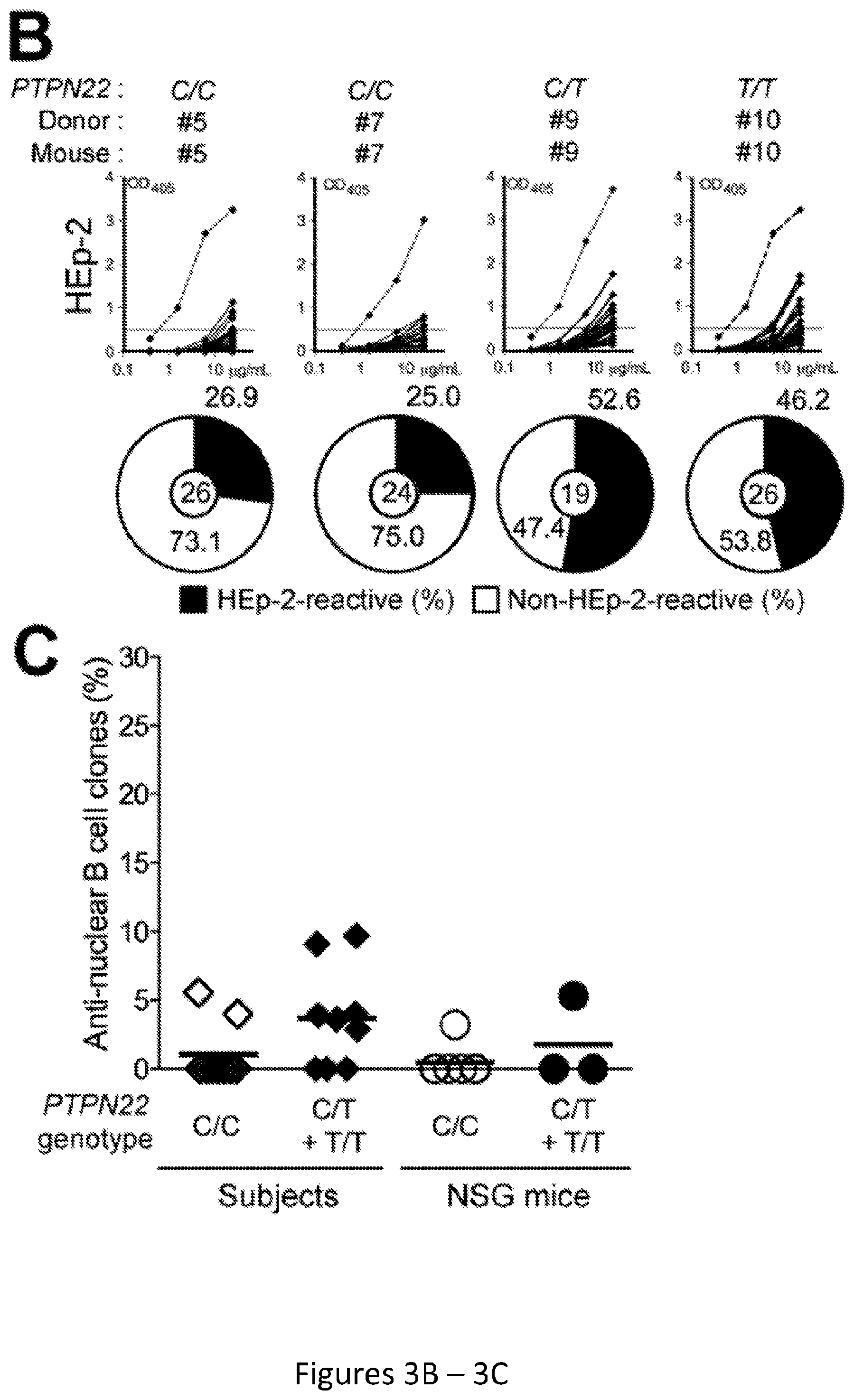
D00008
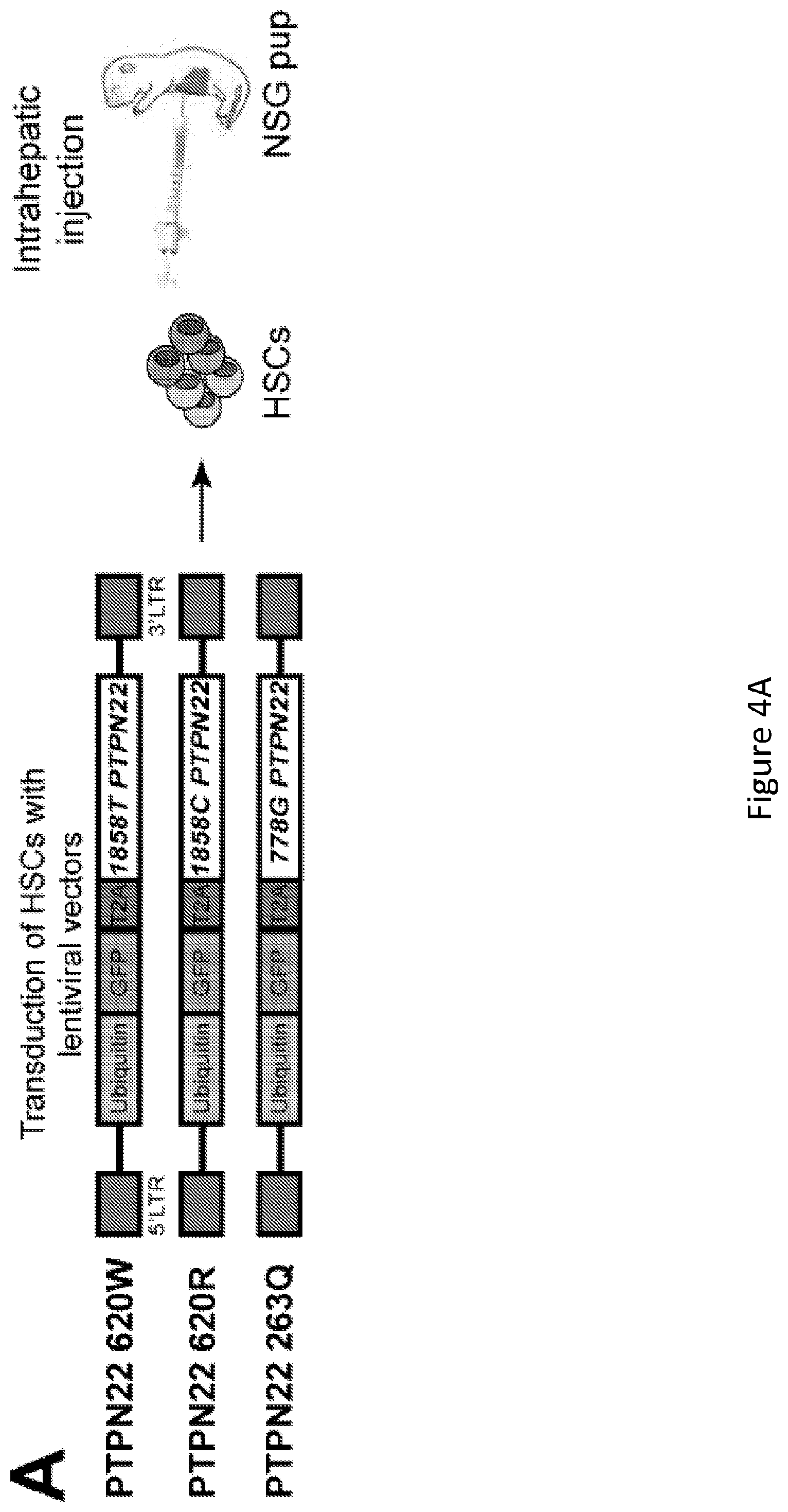
D00009
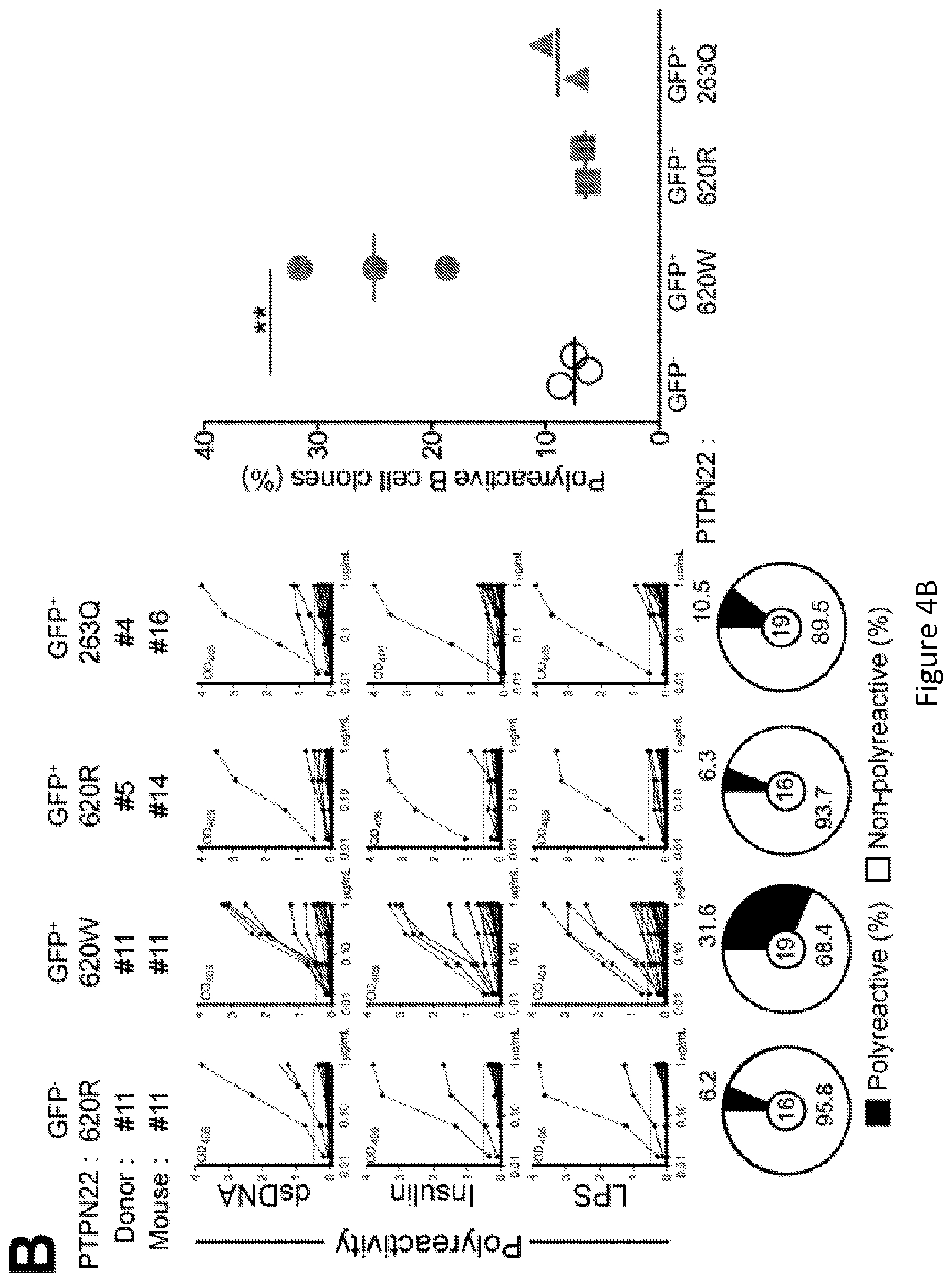
D00010

D00011
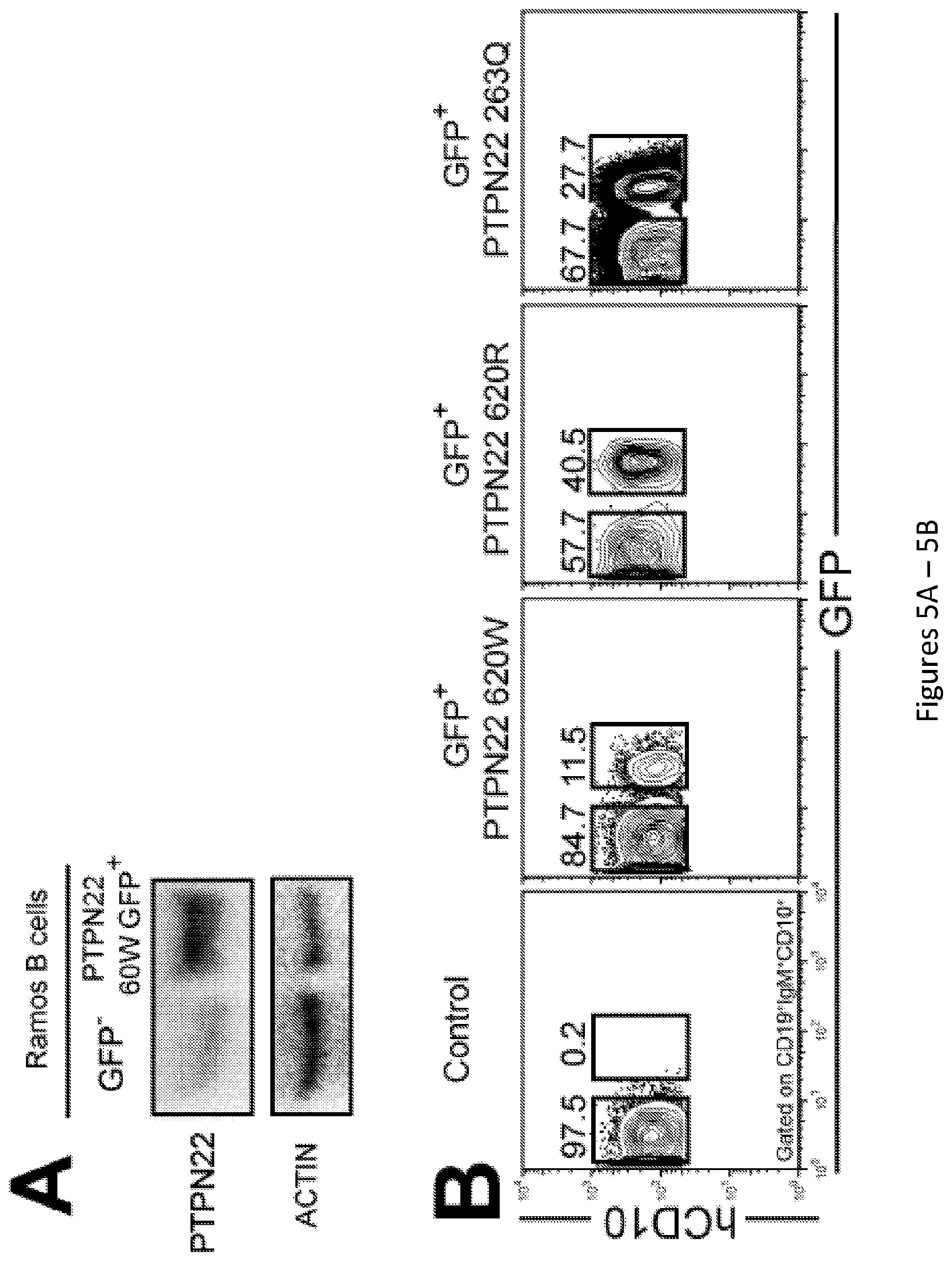
D00012
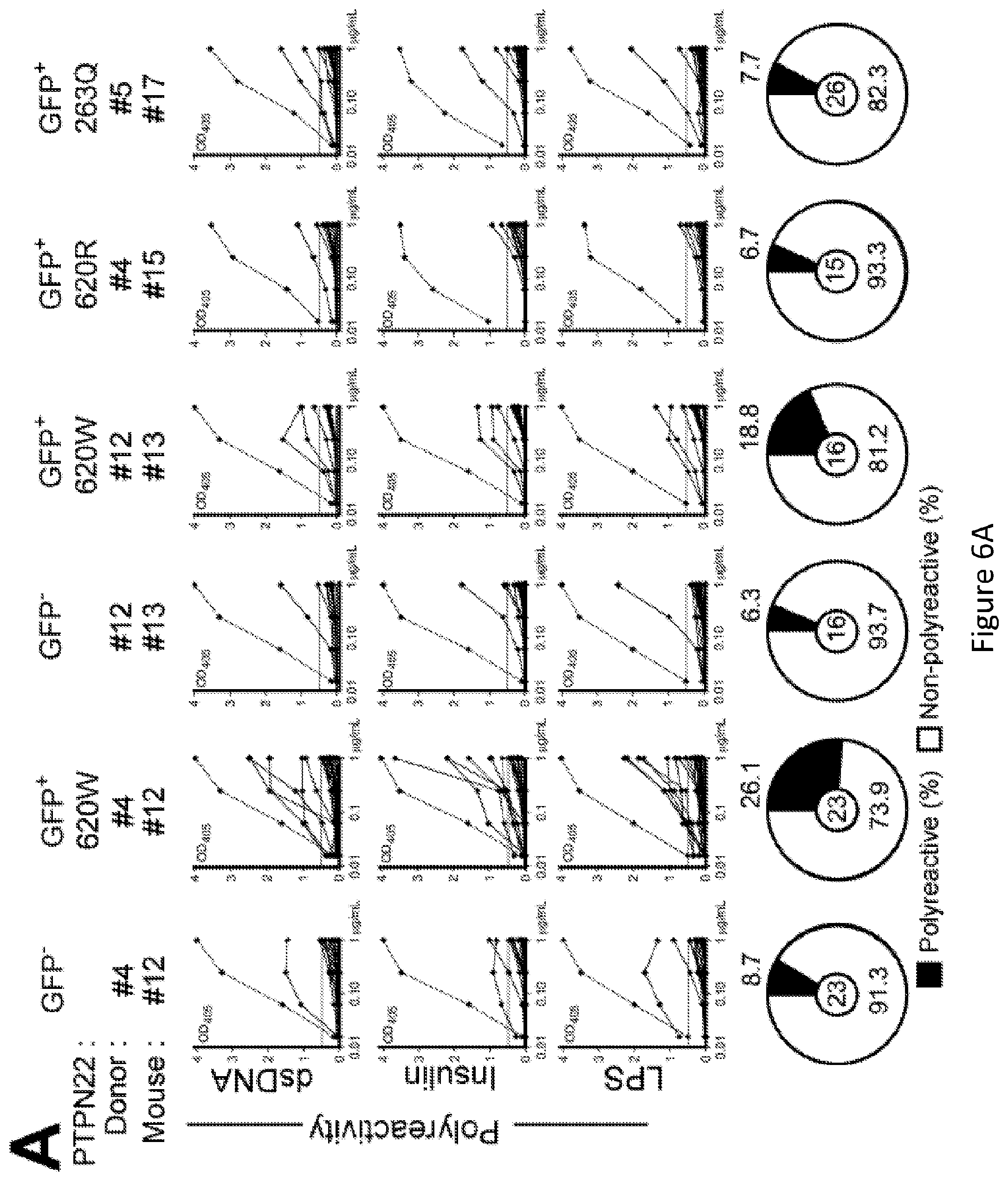
D00013
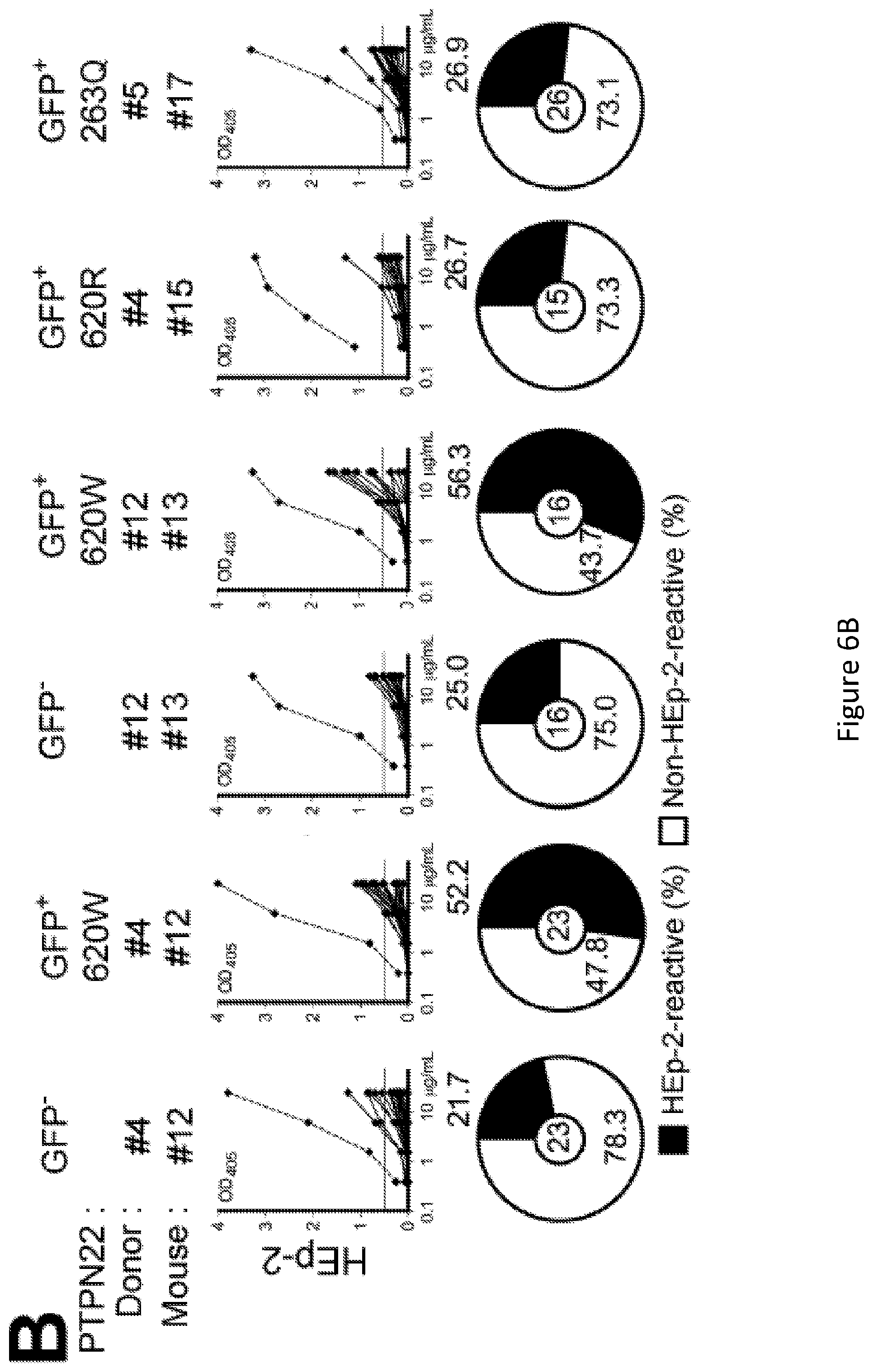
D00014

D00015
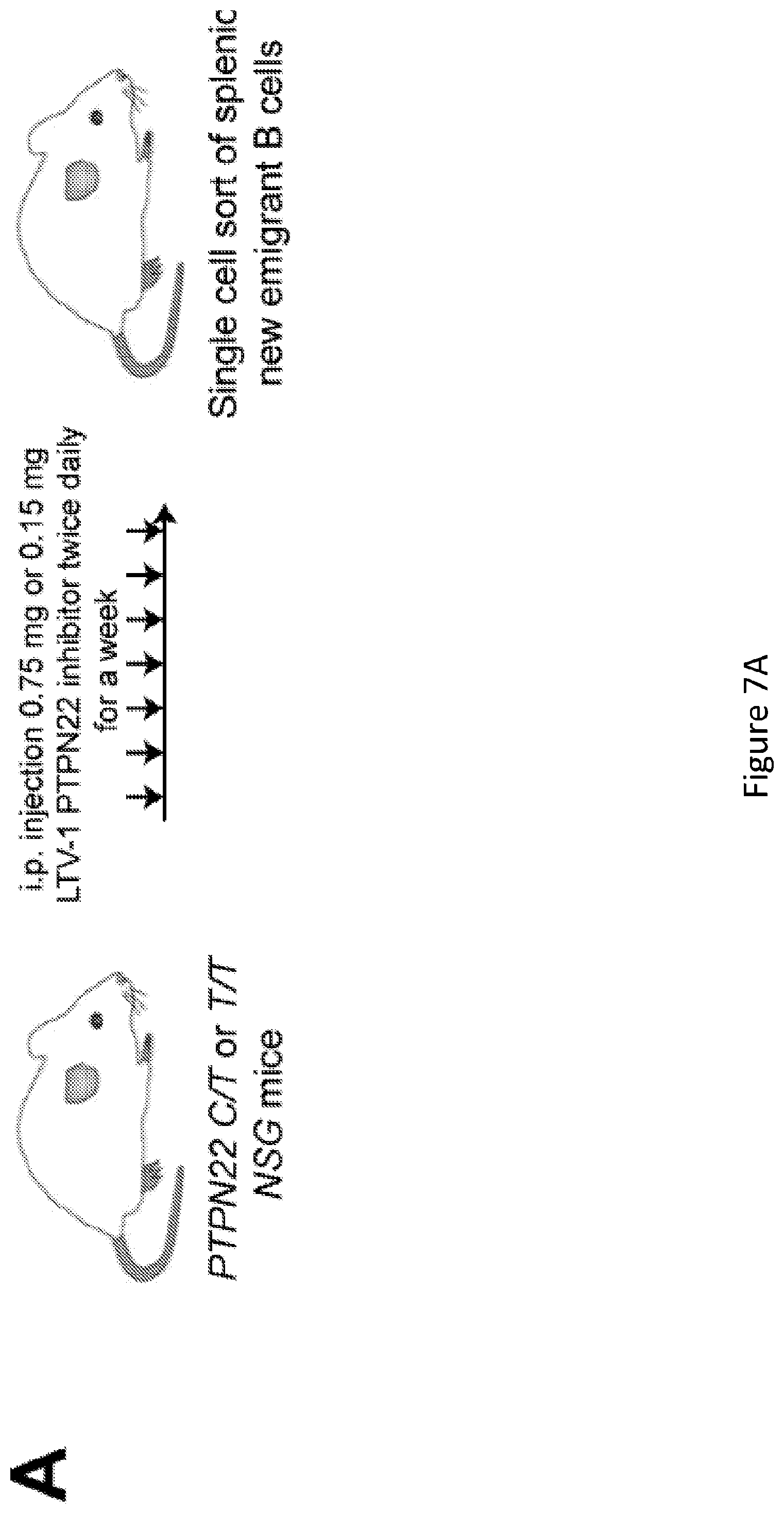
D00016
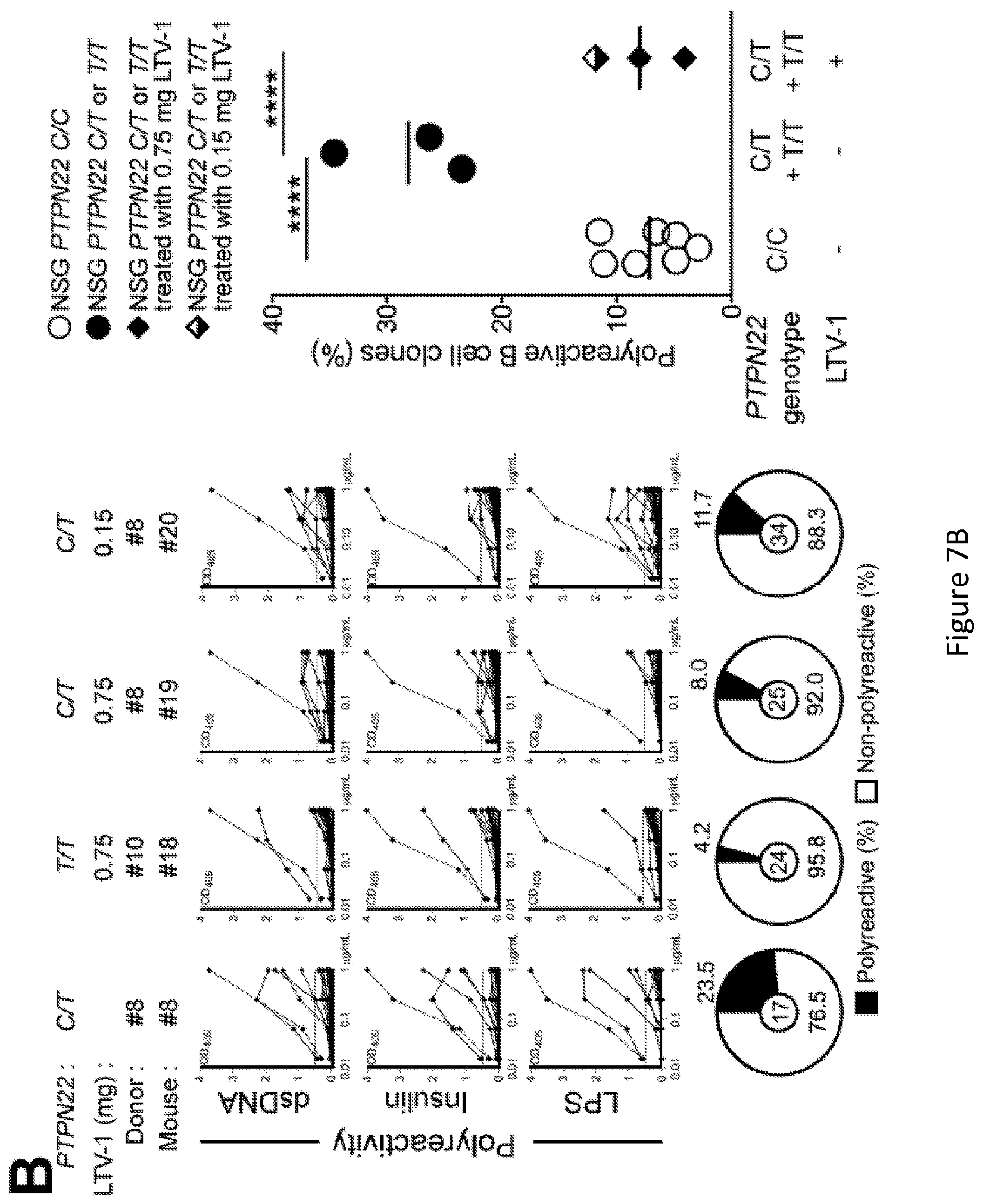
D00017
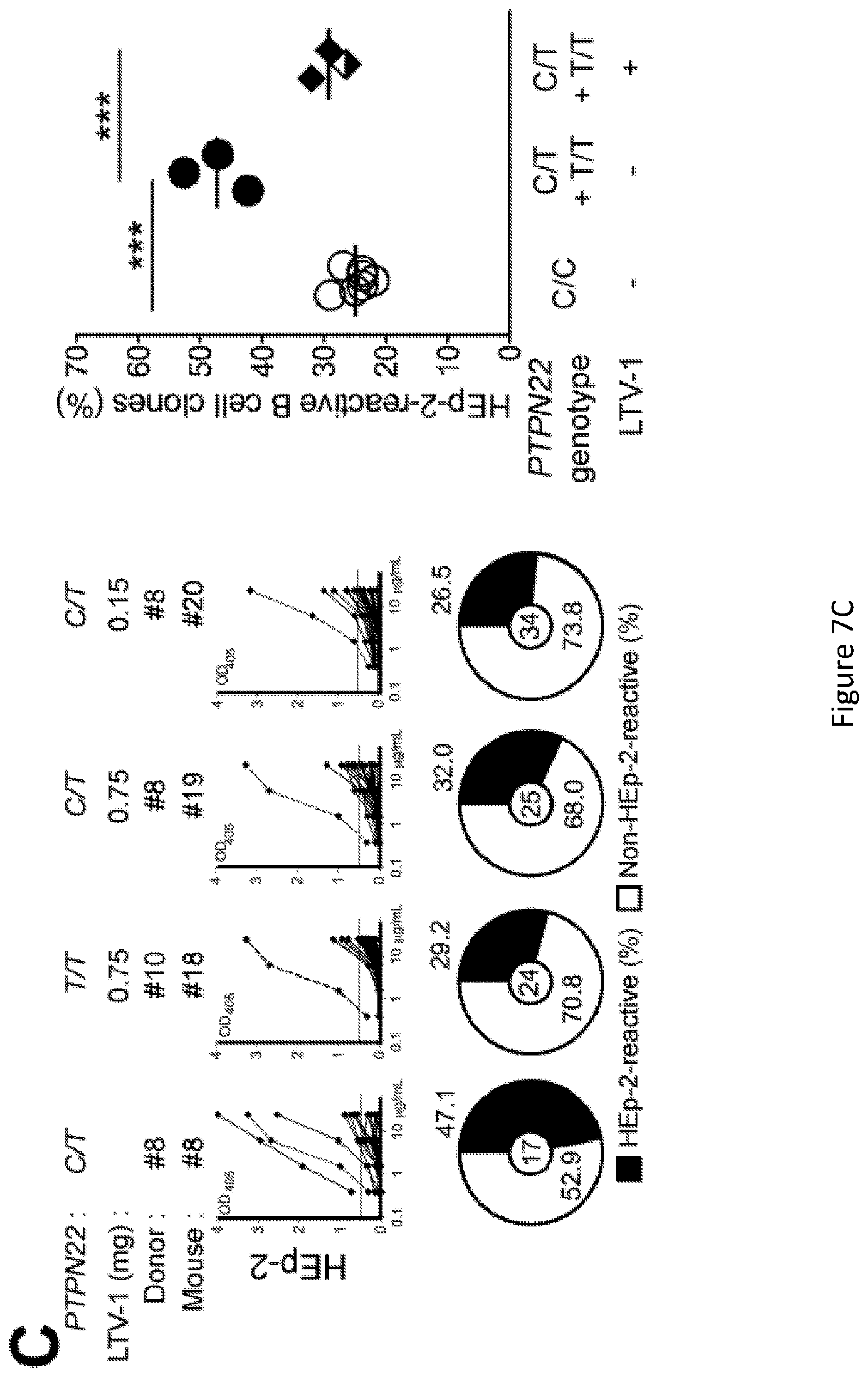
D00018

D00019
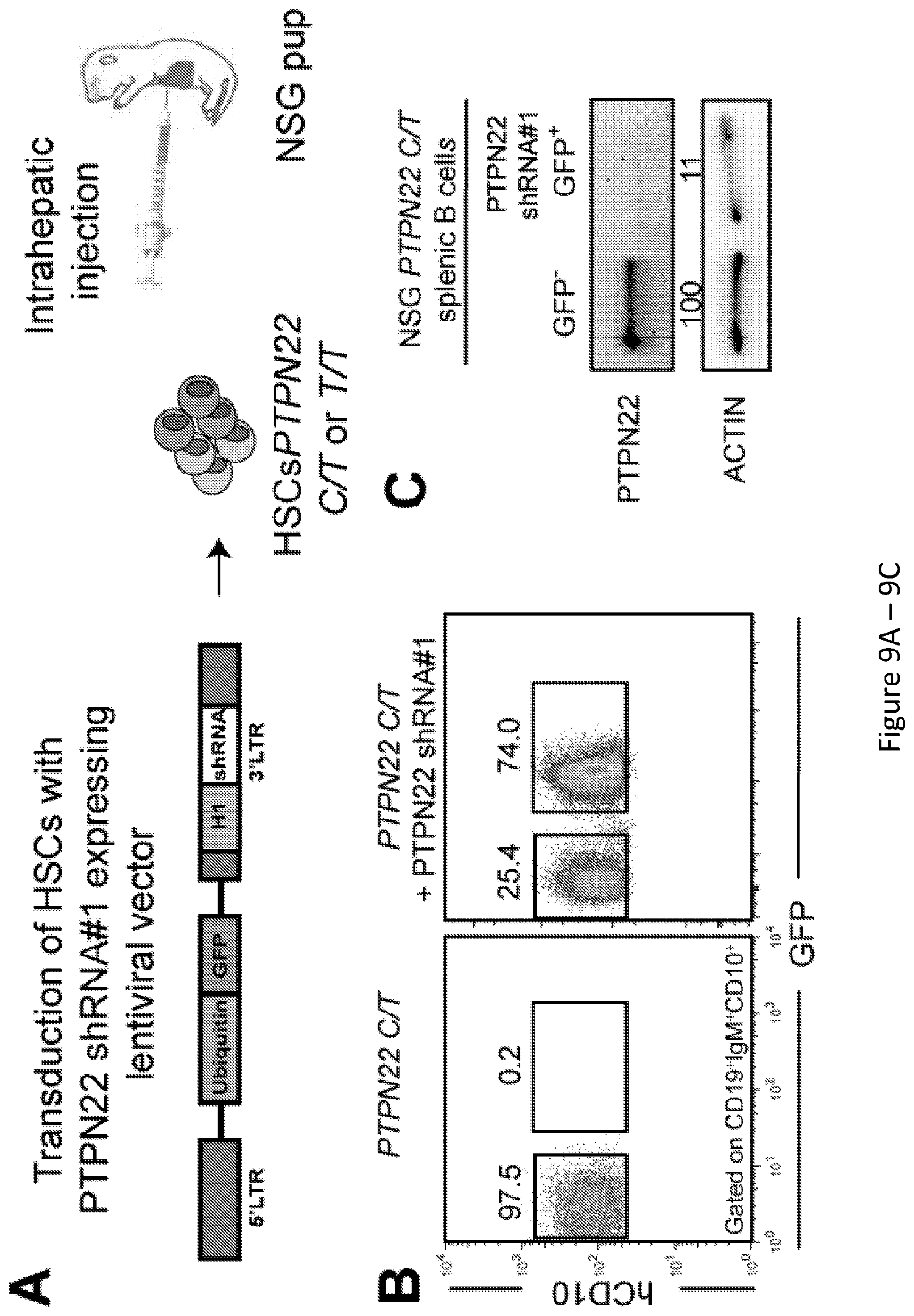
D00020
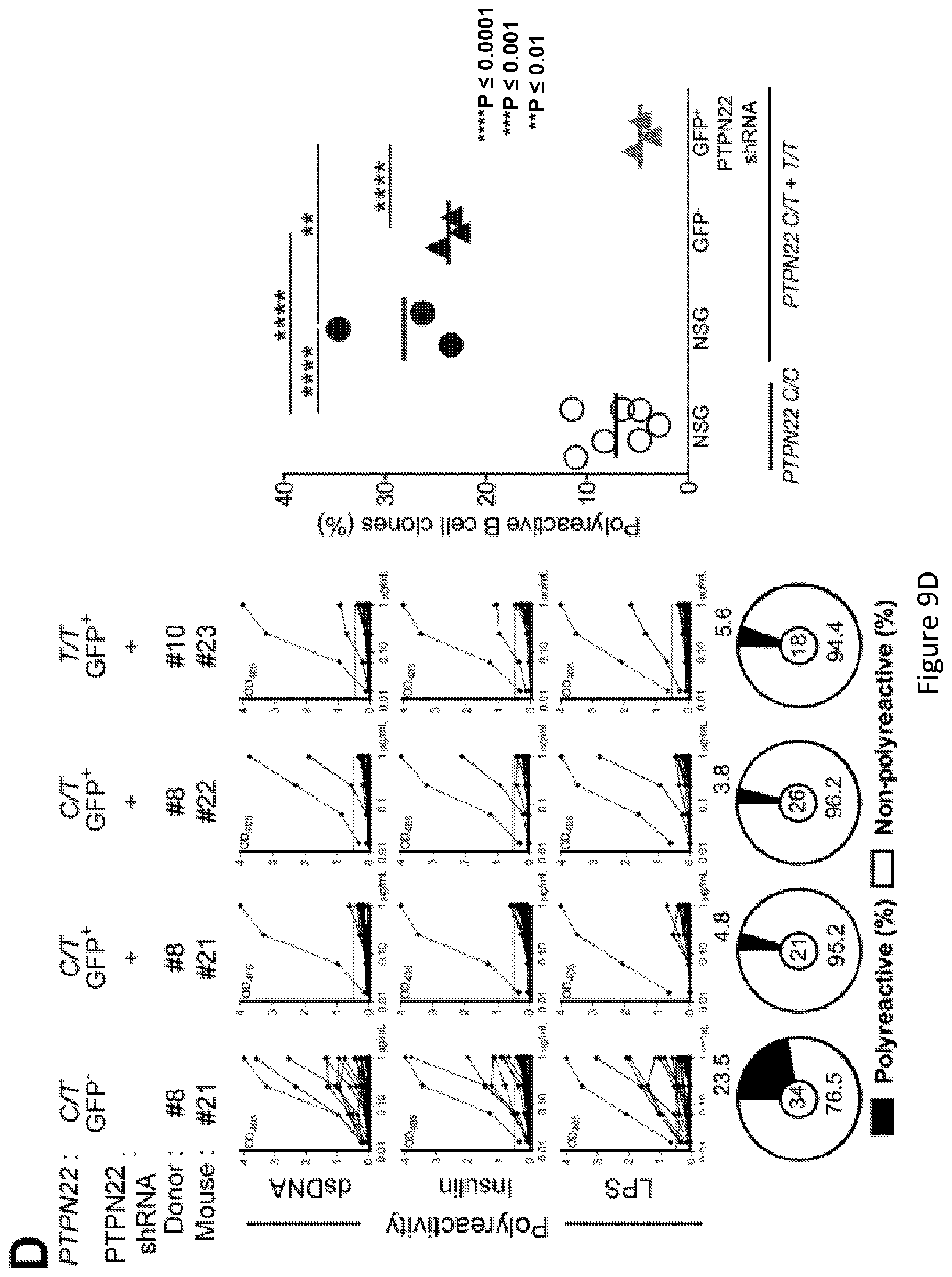
D00021
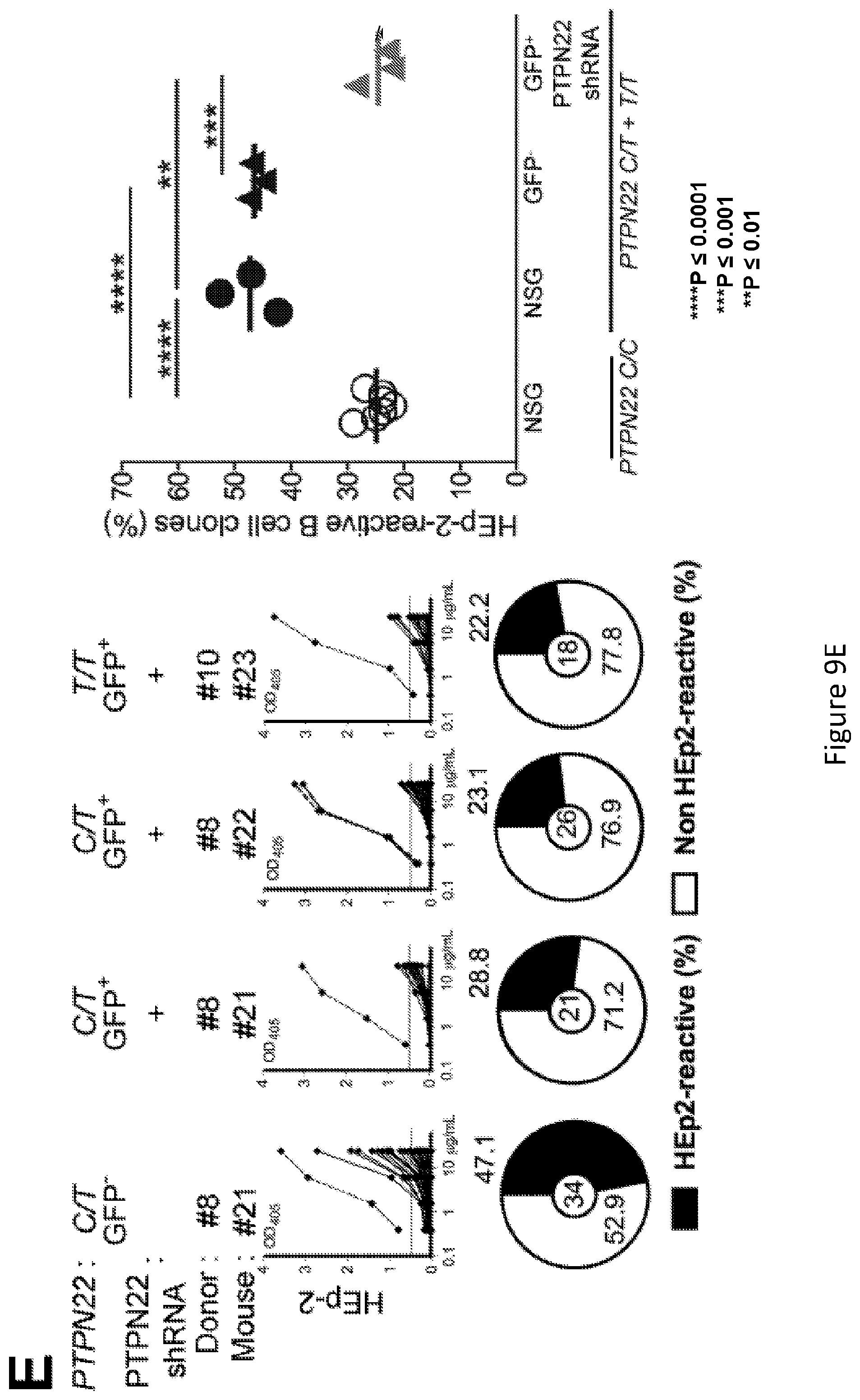
D00022

D00023
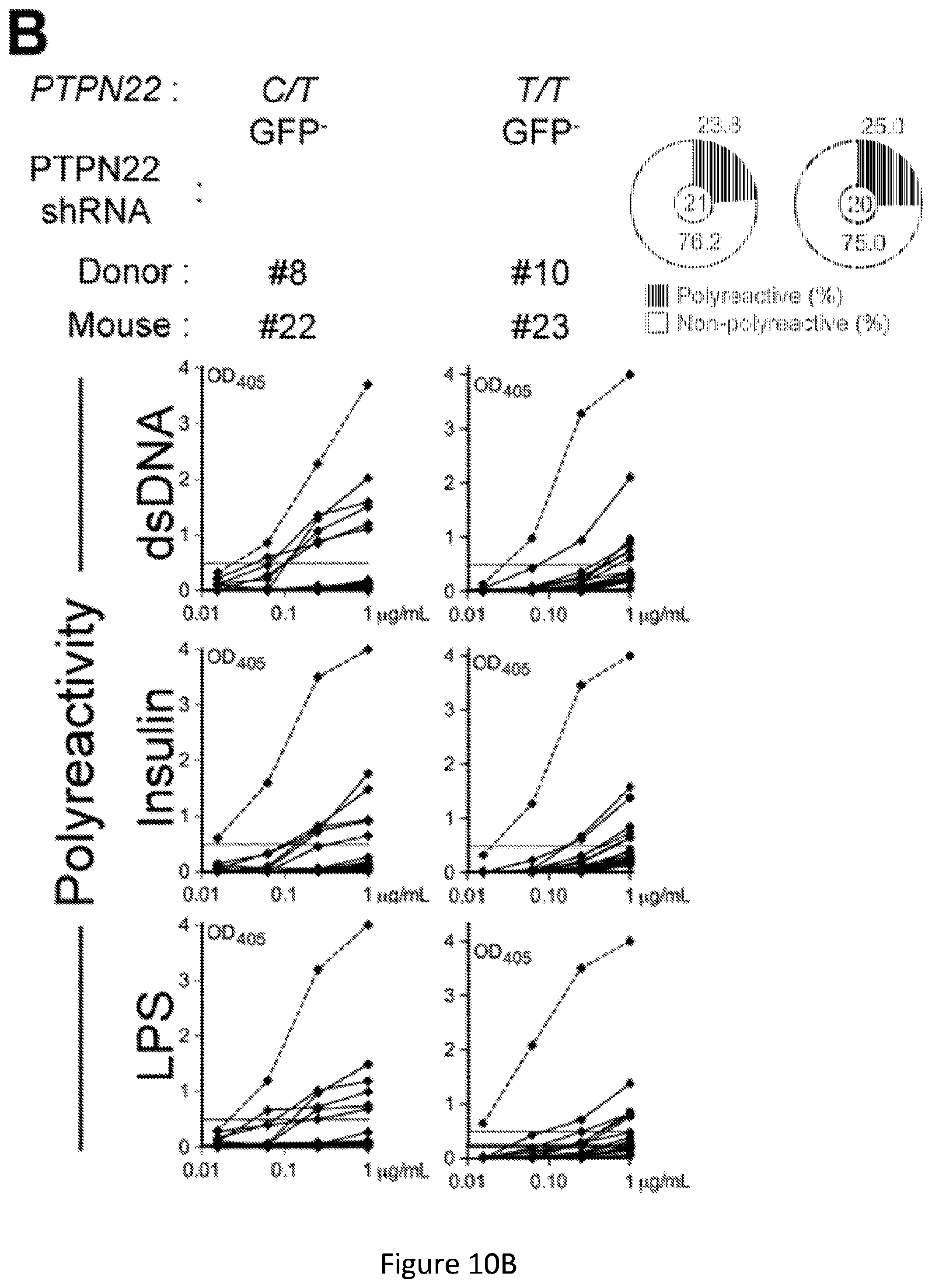
D00024
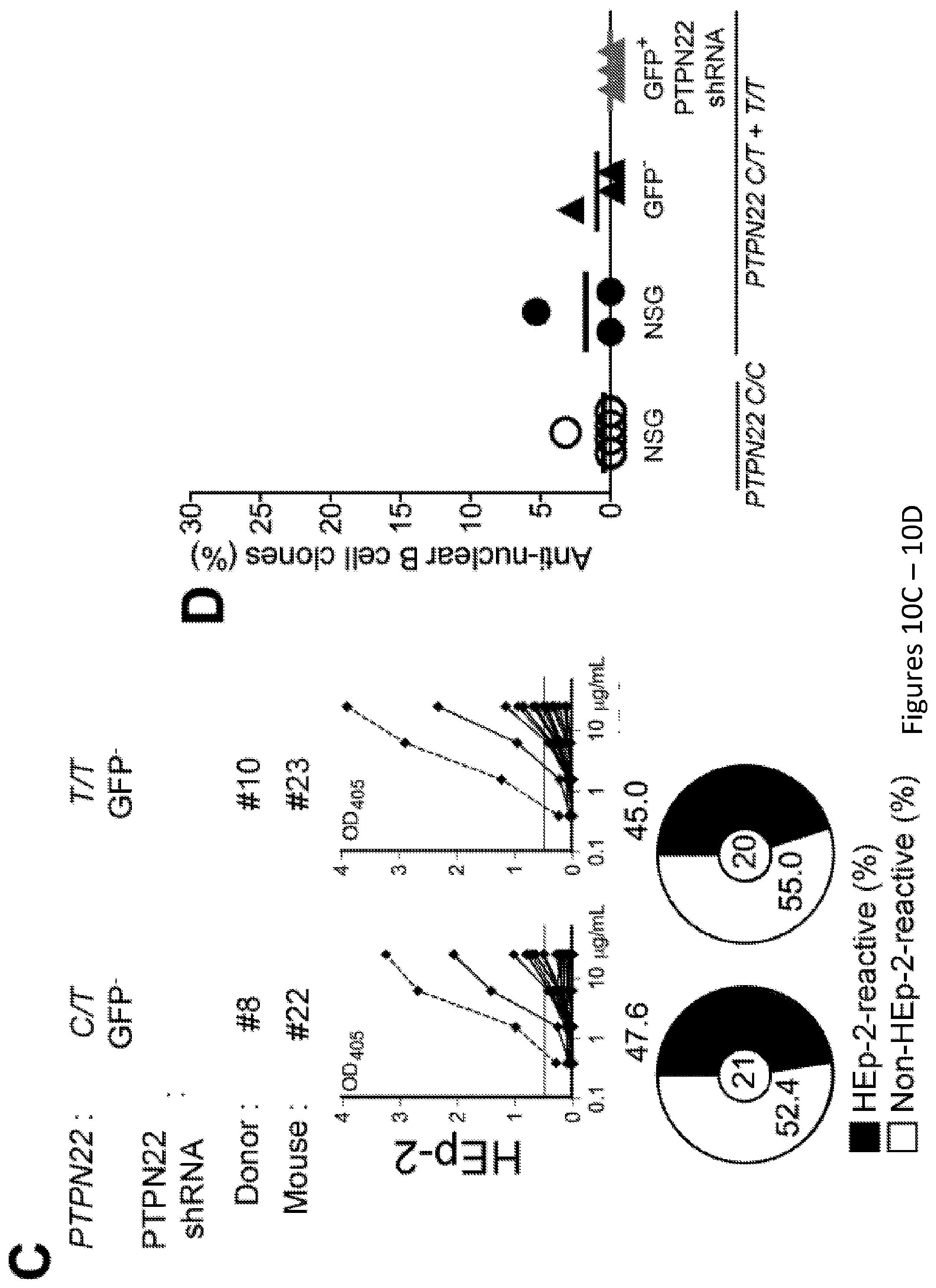
D00025
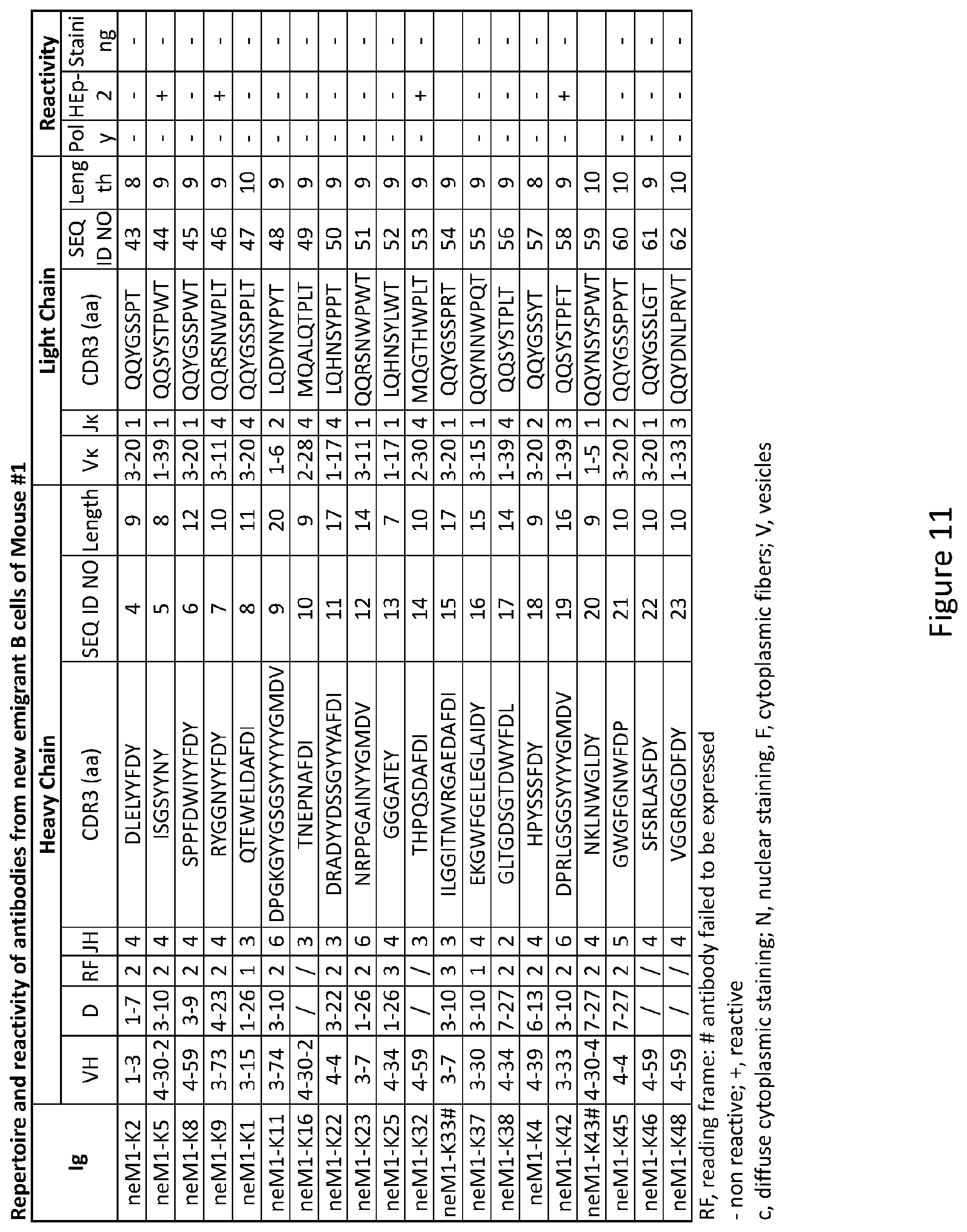
D00026
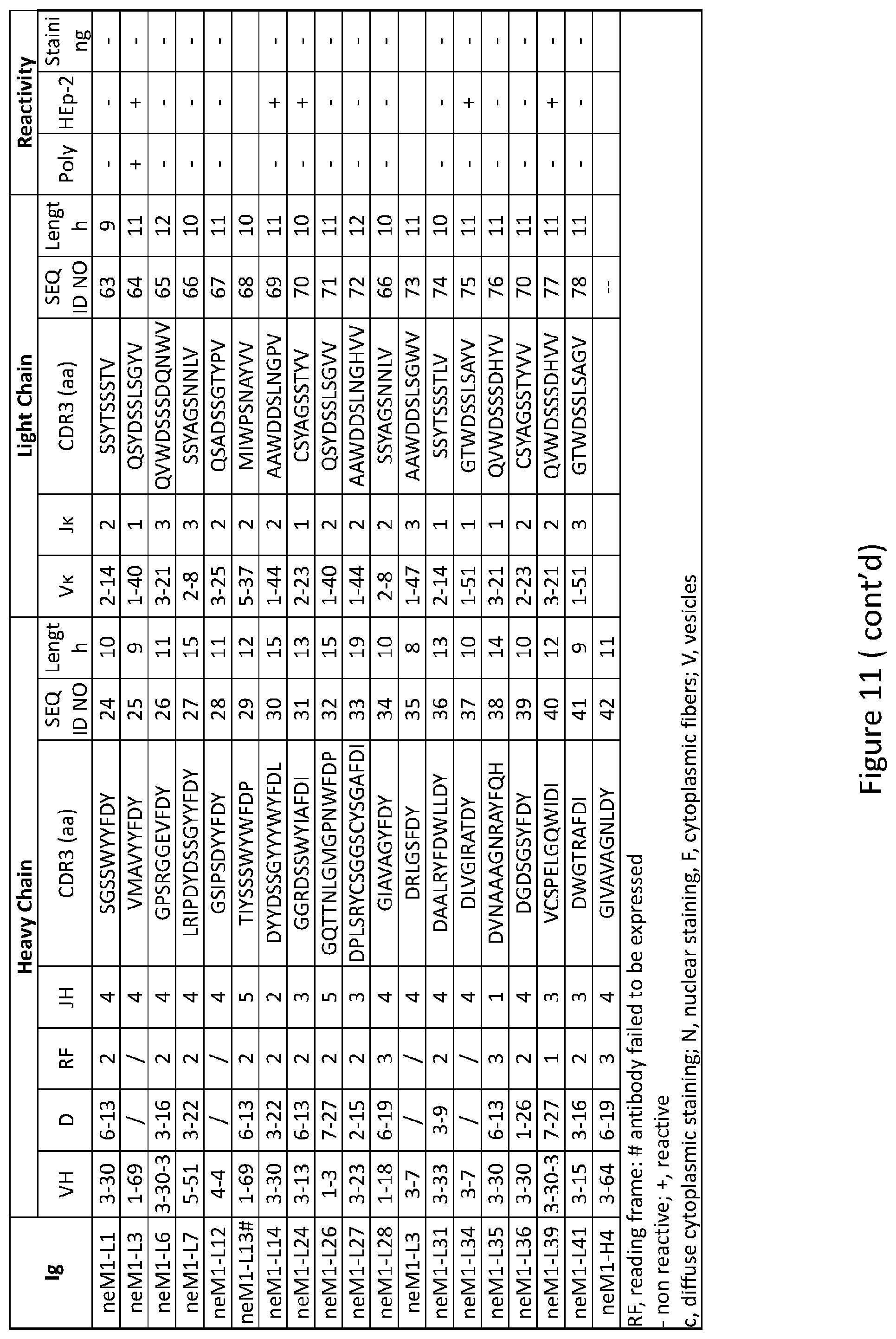
D00027
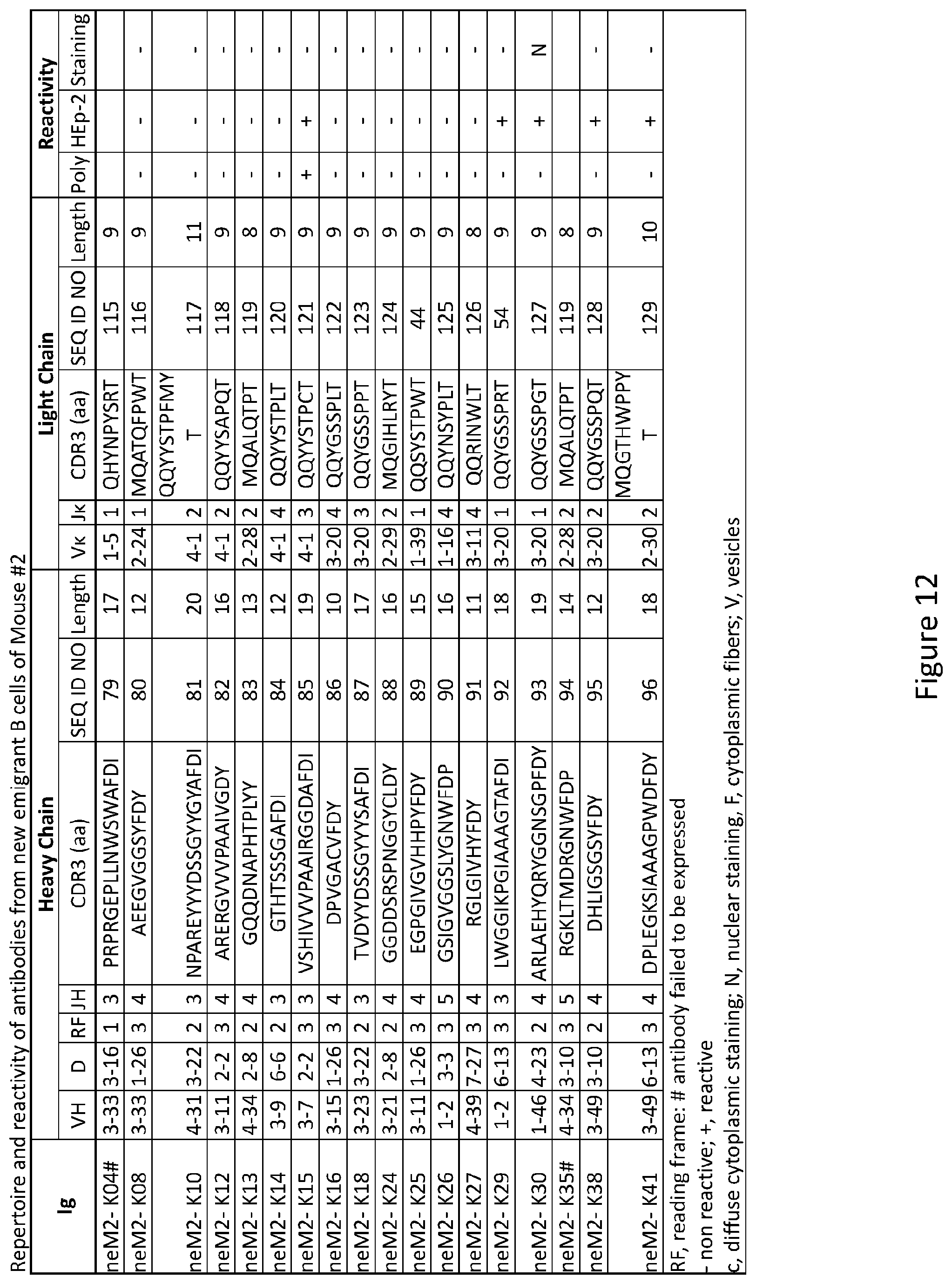
D00028
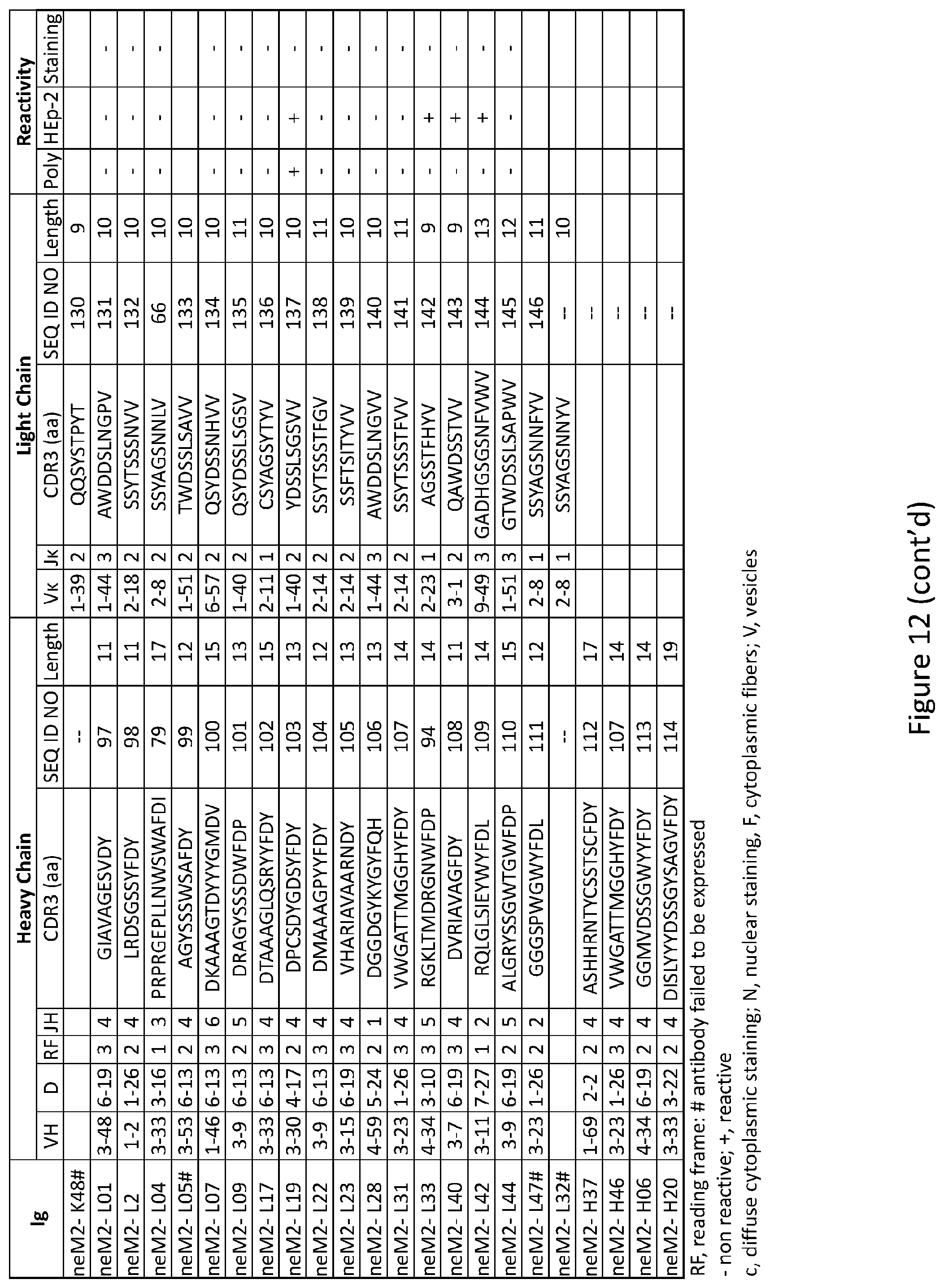
D00029
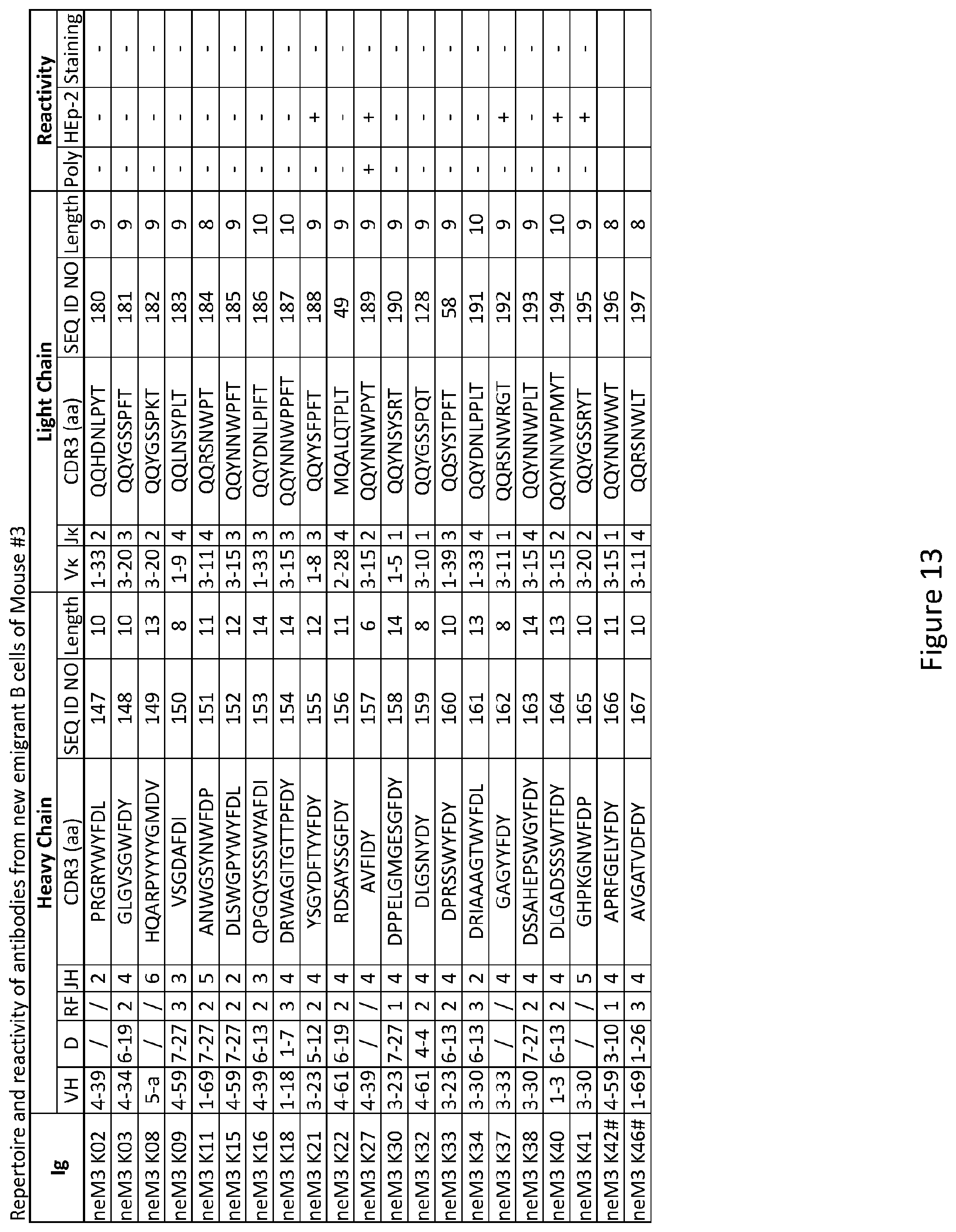
D00030
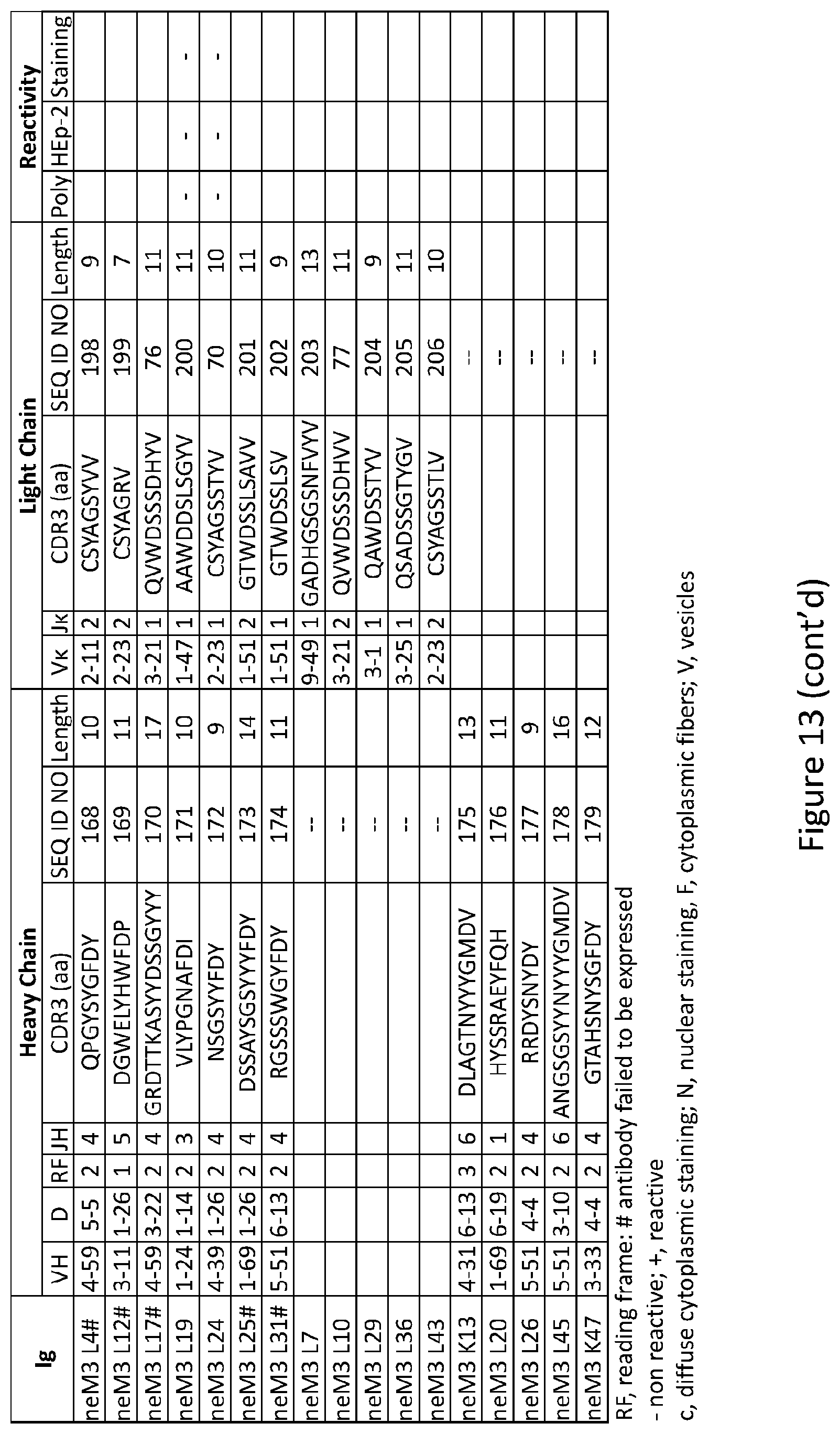
D00031
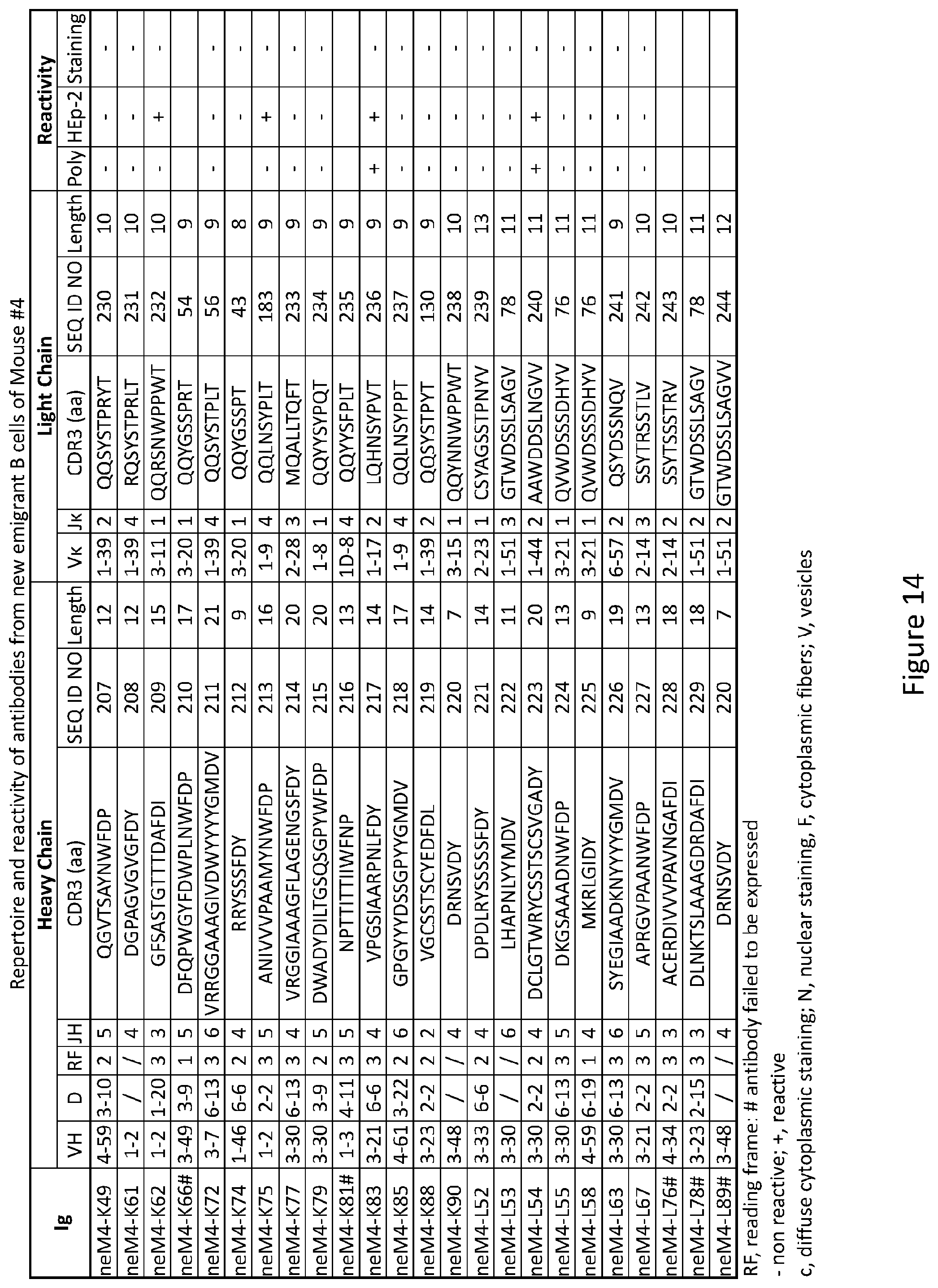
D00032

D00033
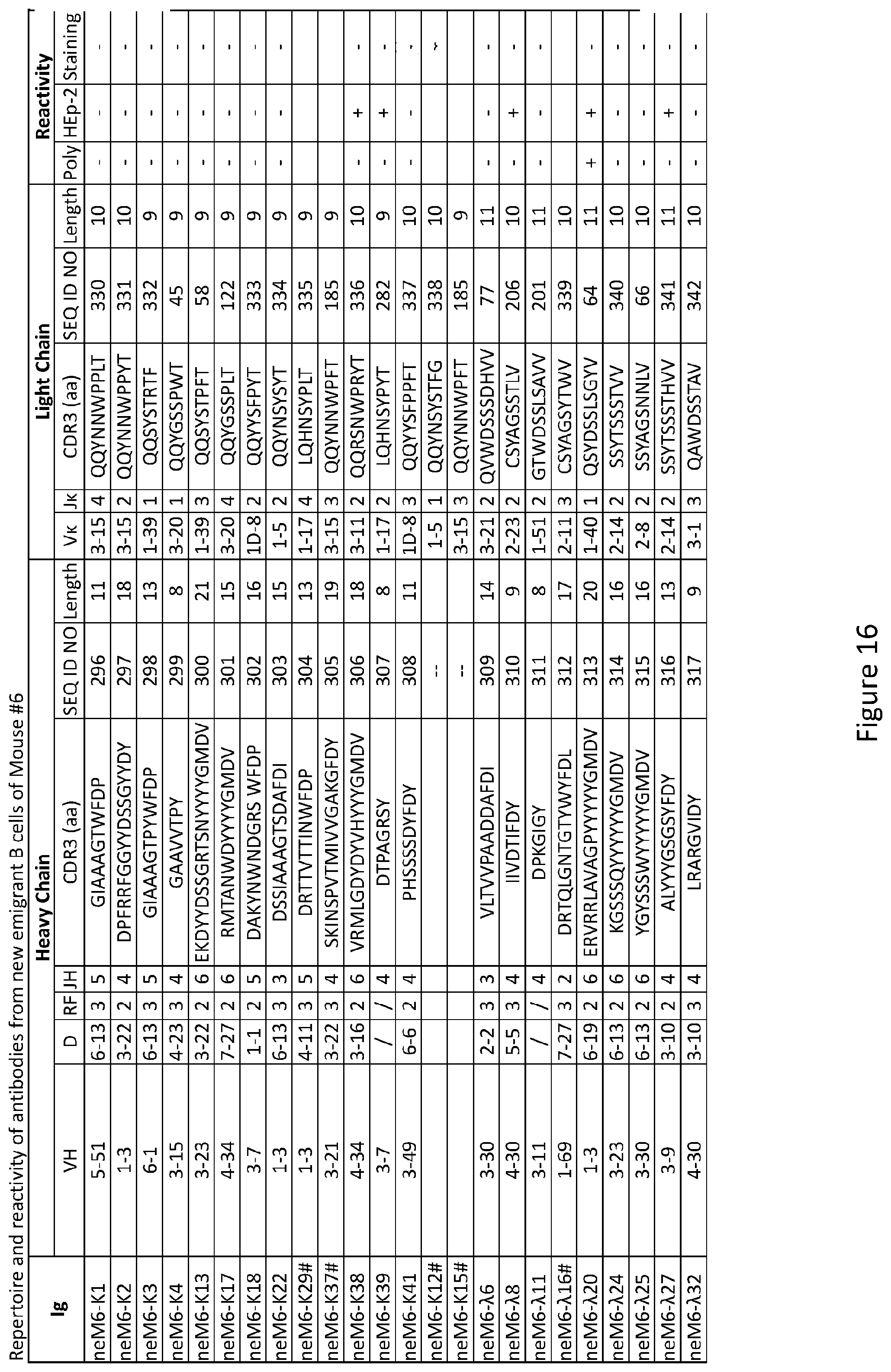
D00034
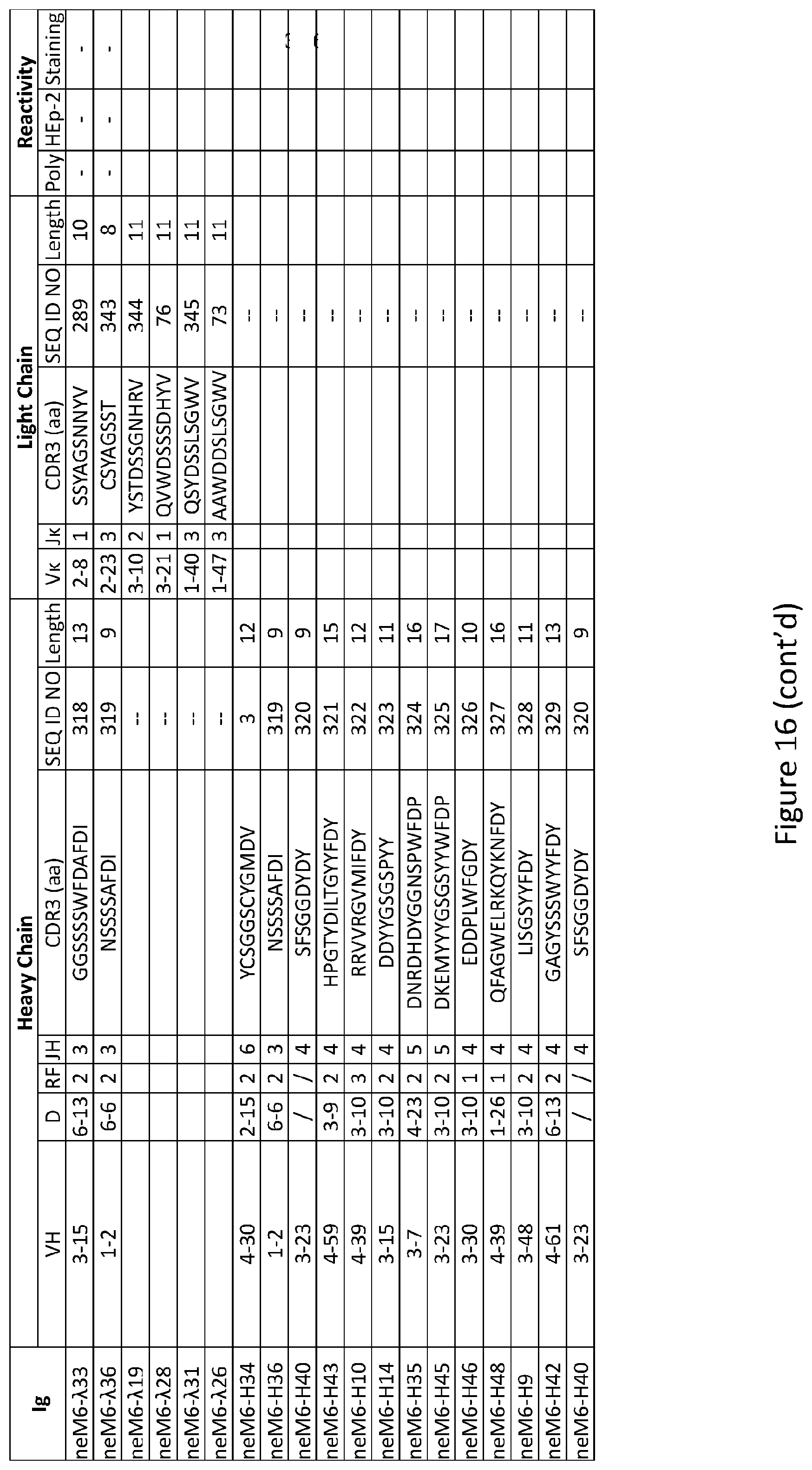
D00035
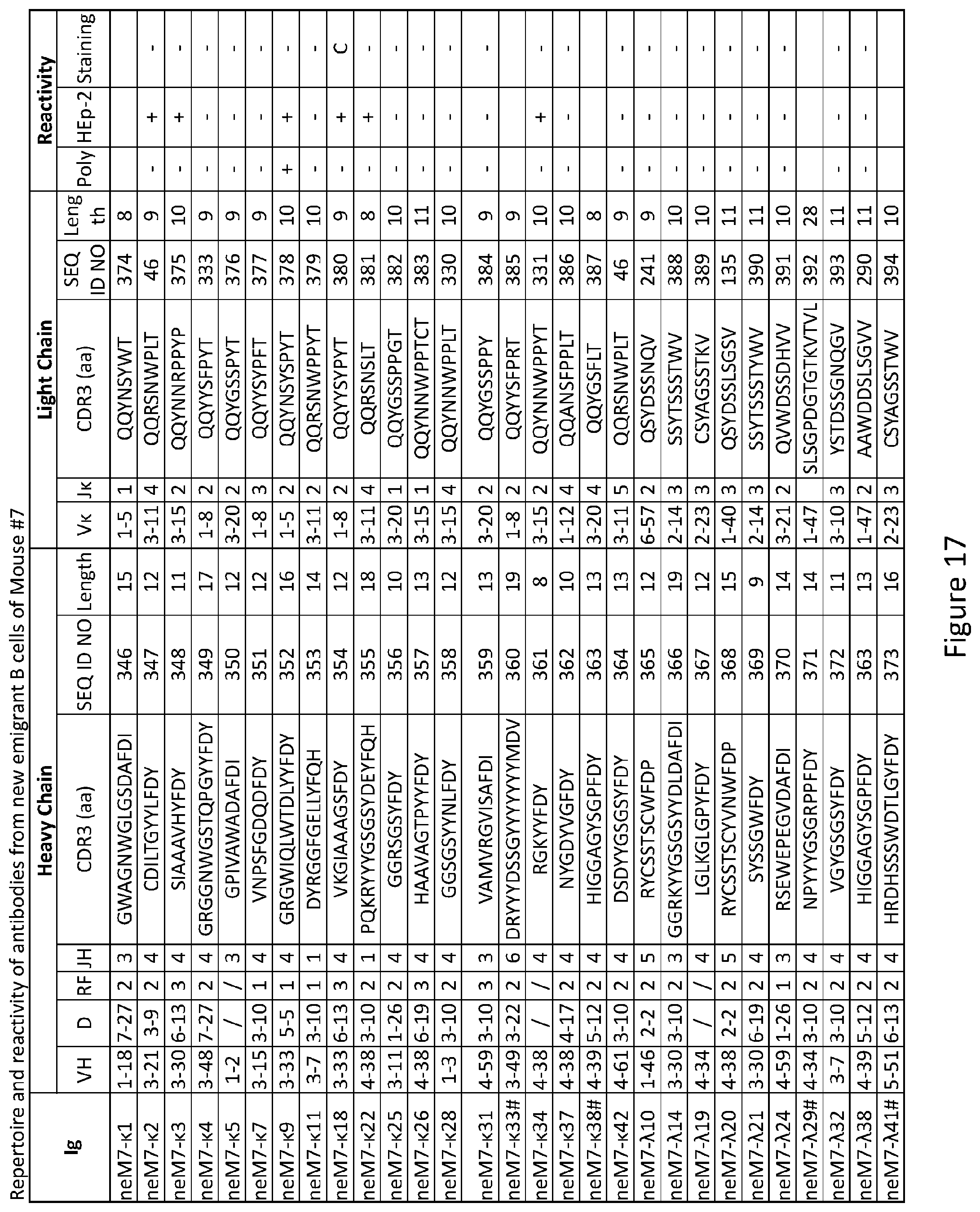
D00036
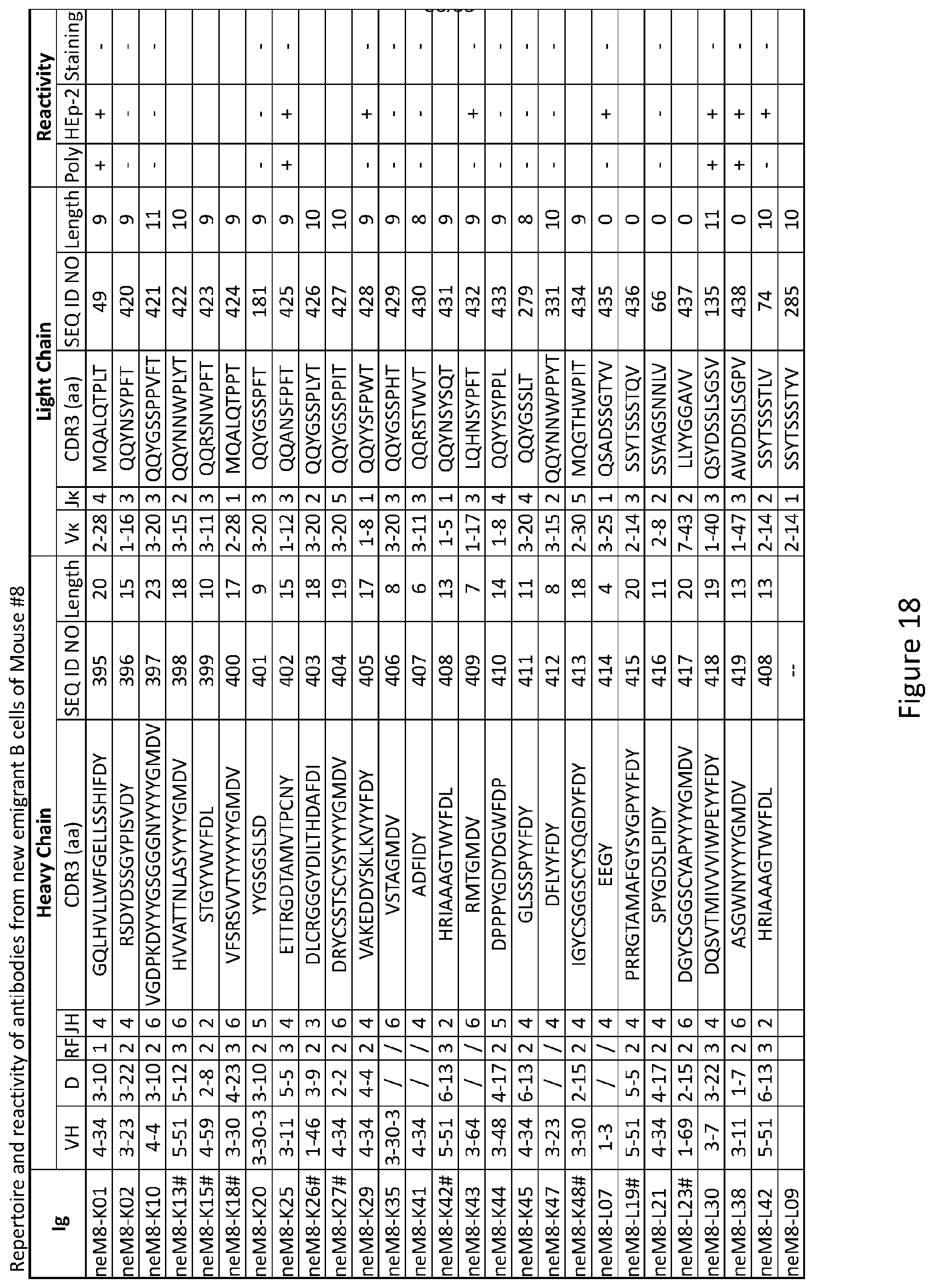
D00037
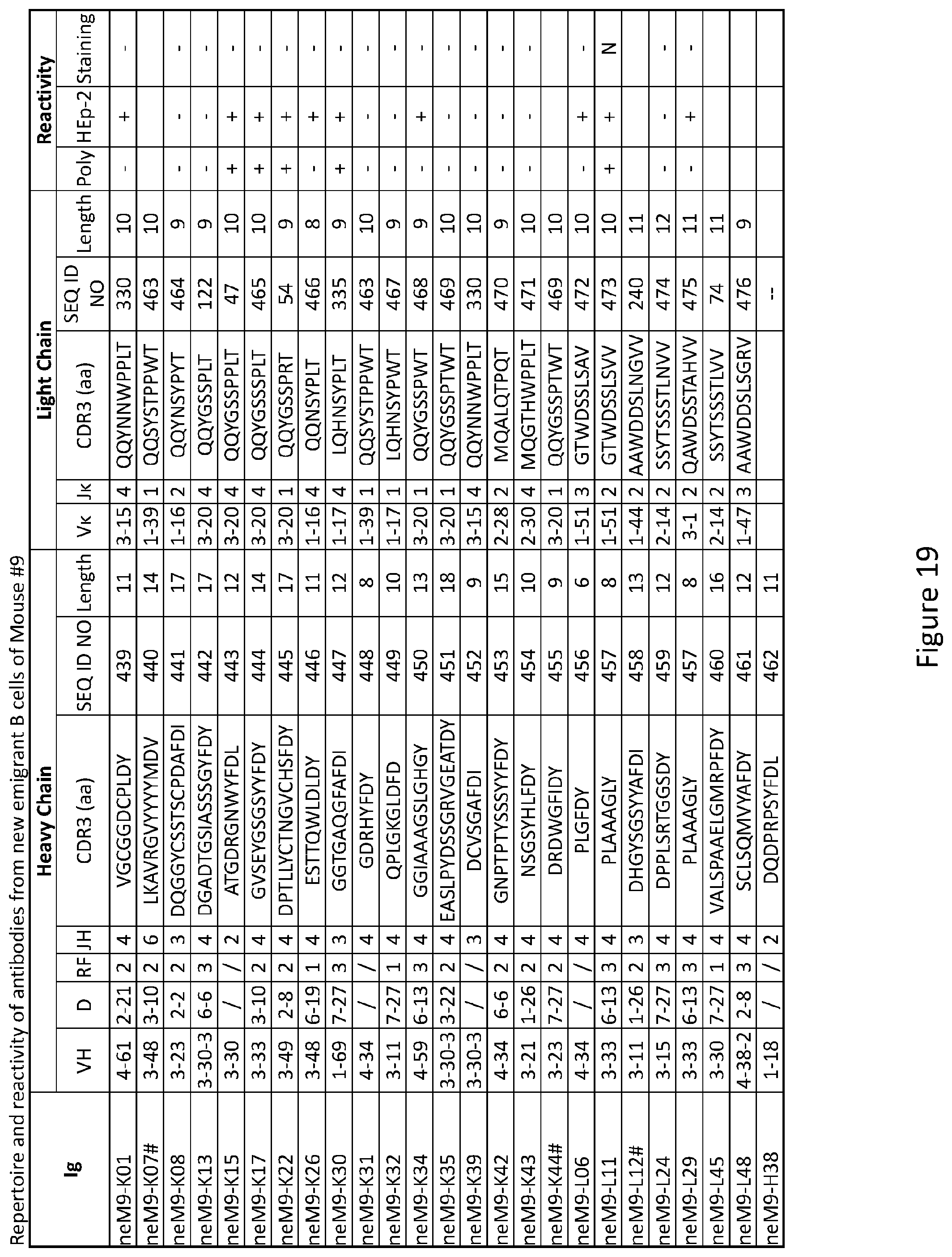
D00038

D00039
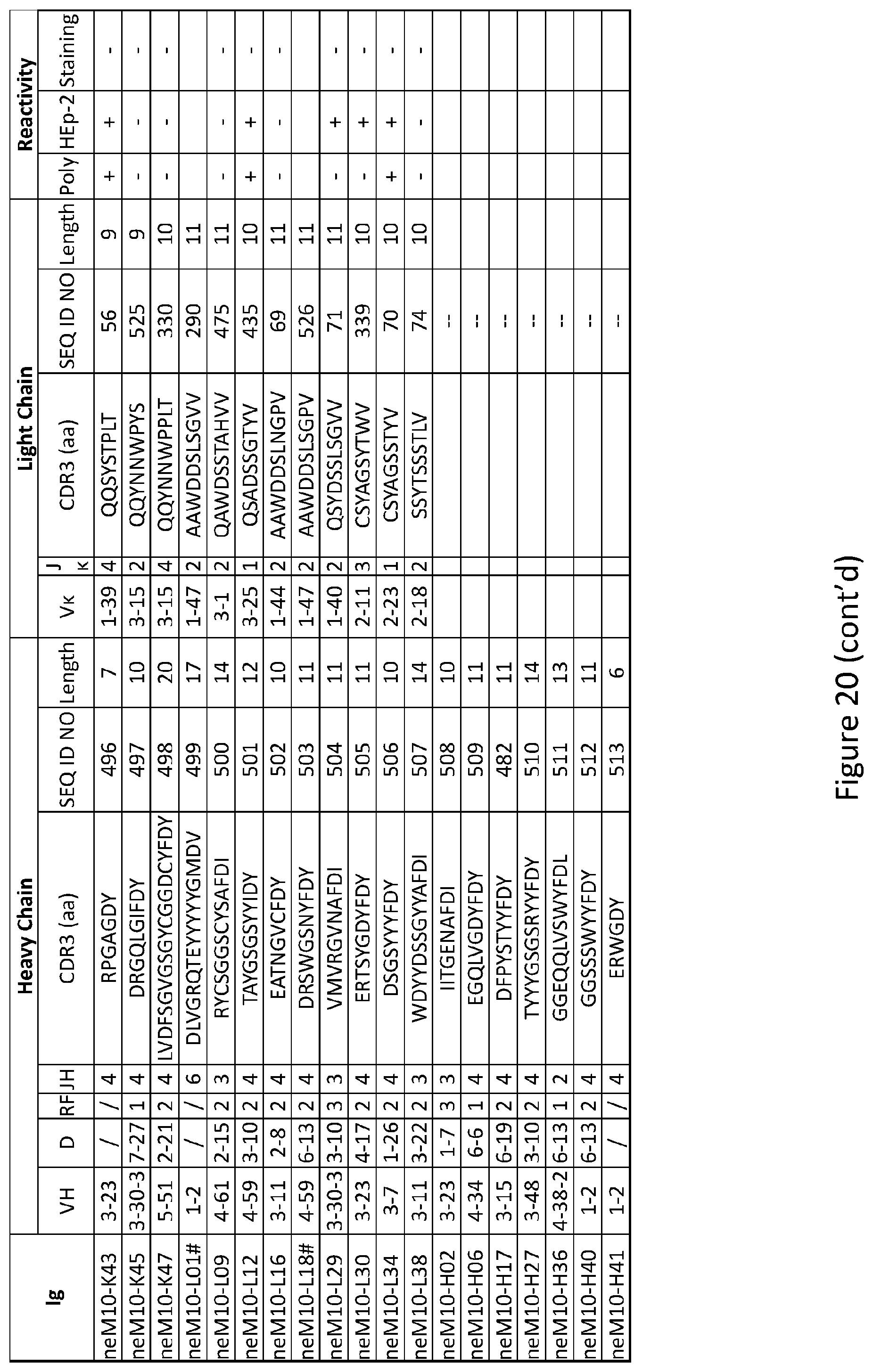
D00040
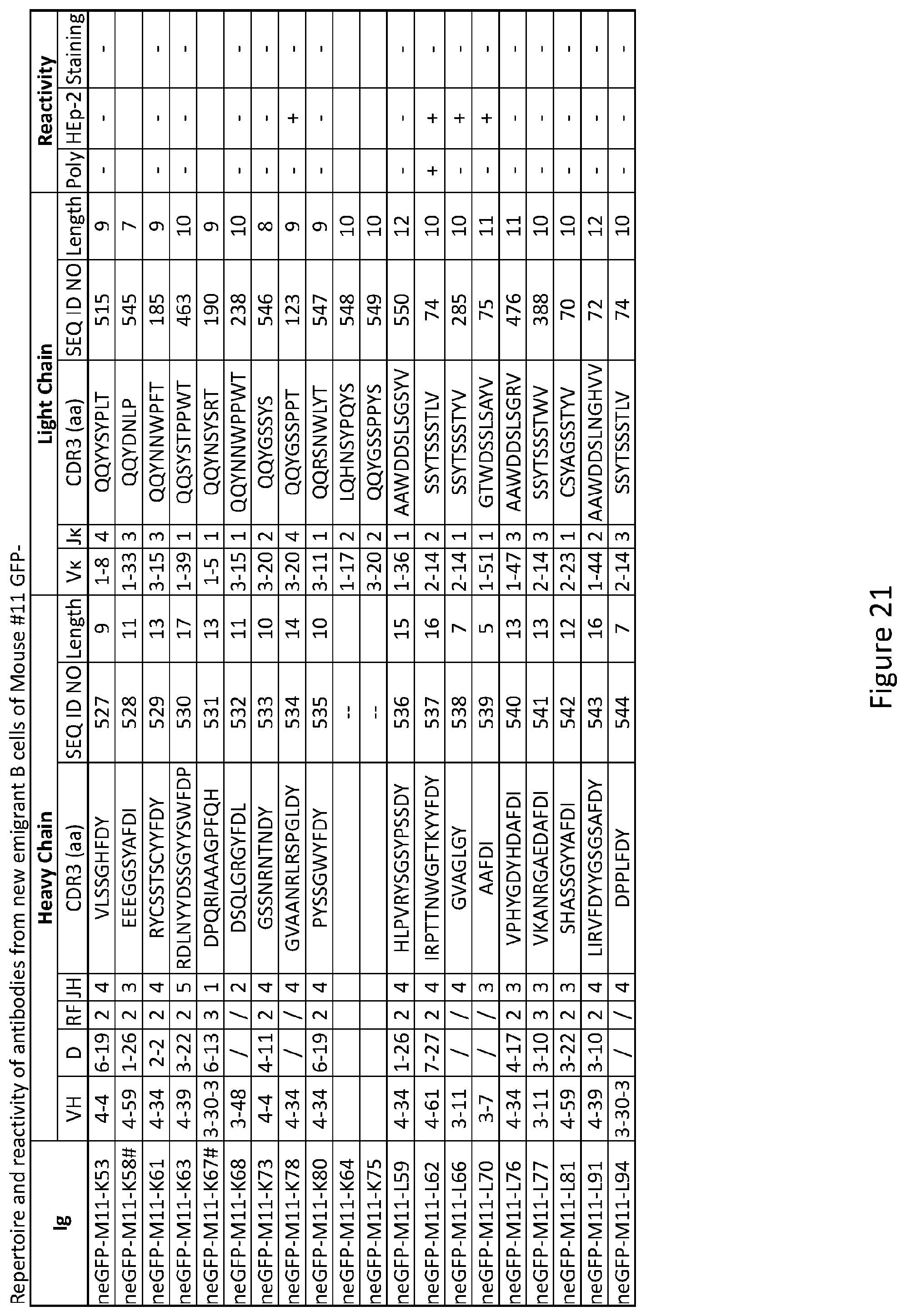
D00041
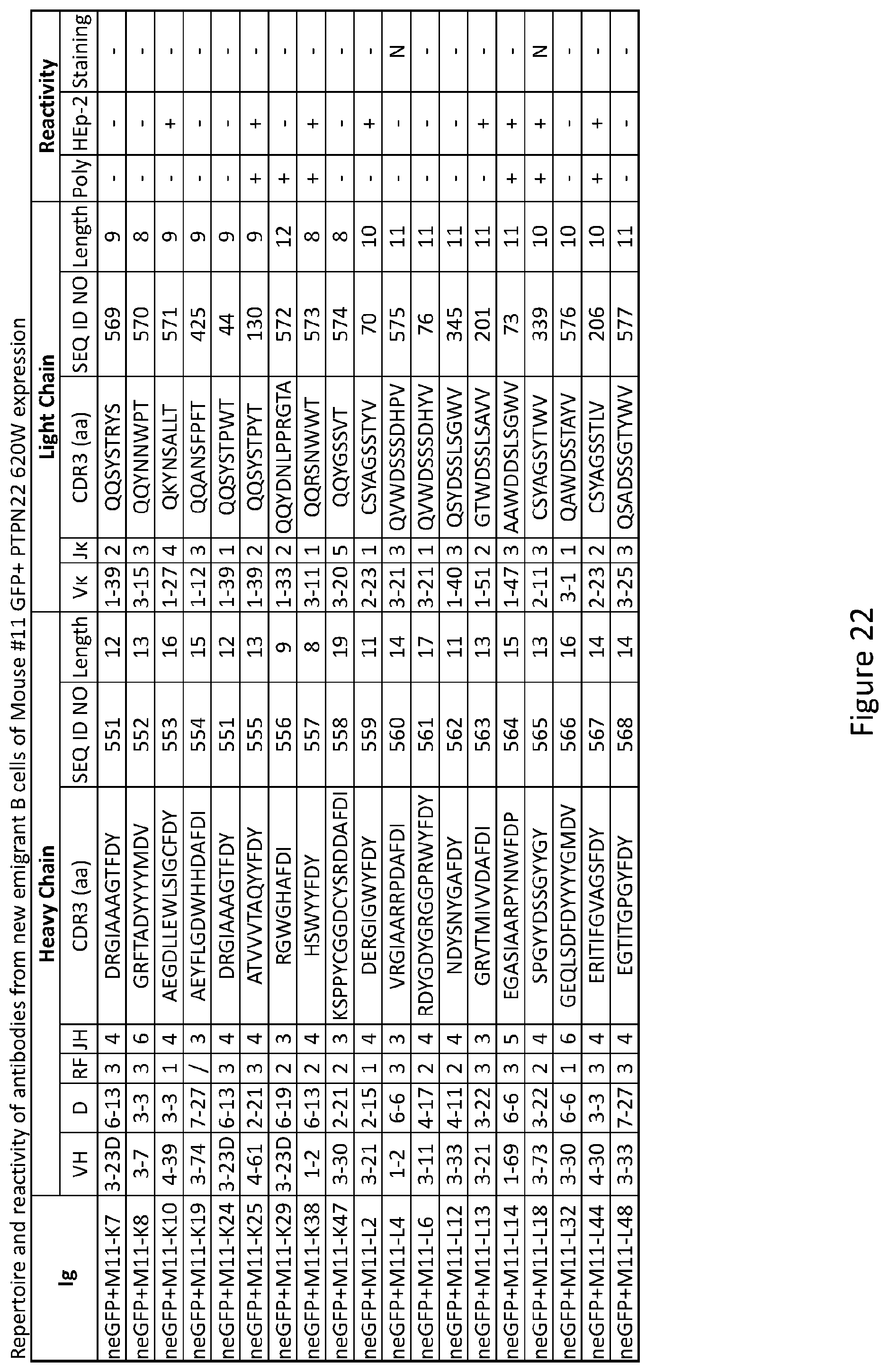
D00042
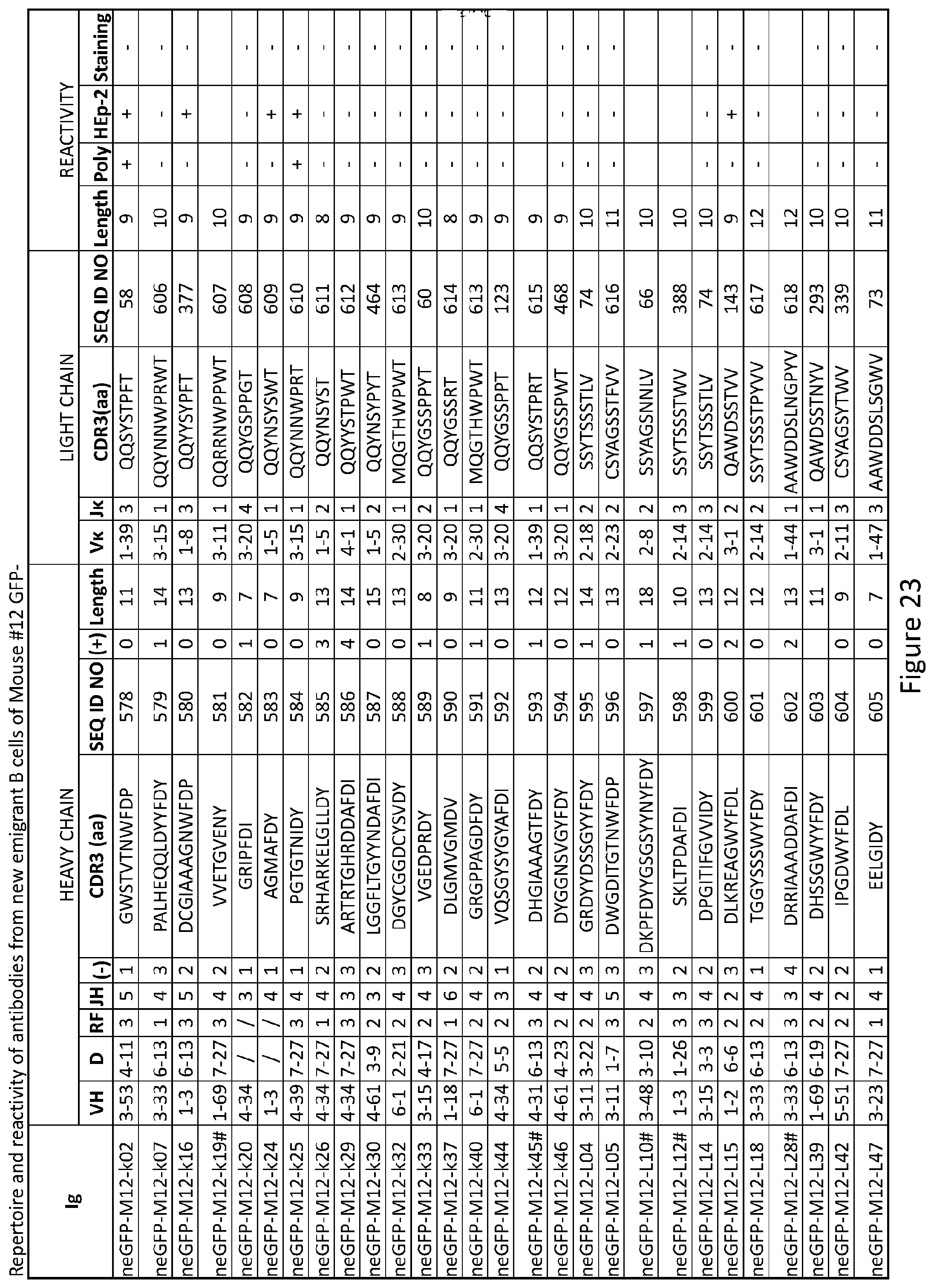
D00043

D00044

D00045
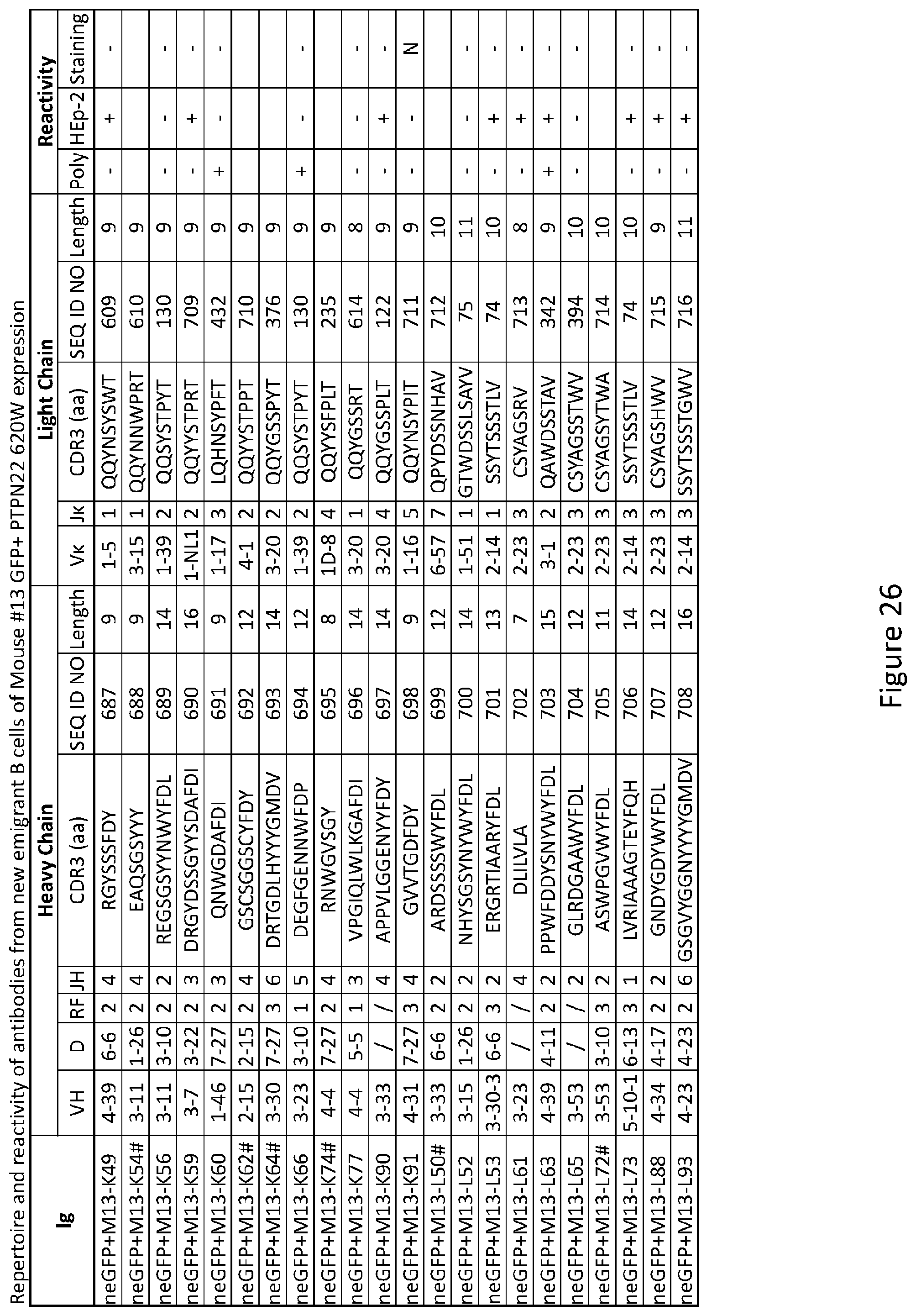
D00046

D00047
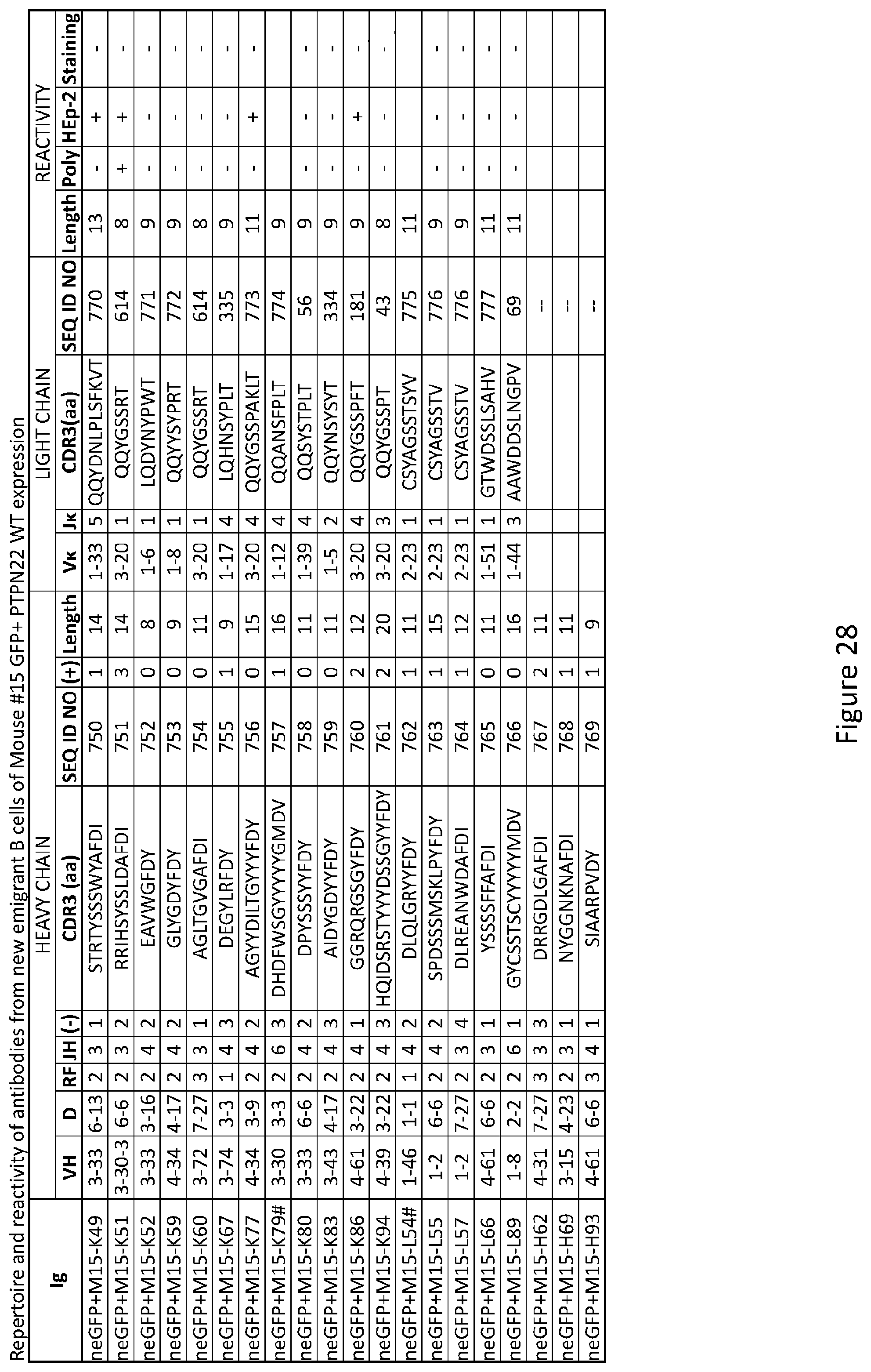
D00048
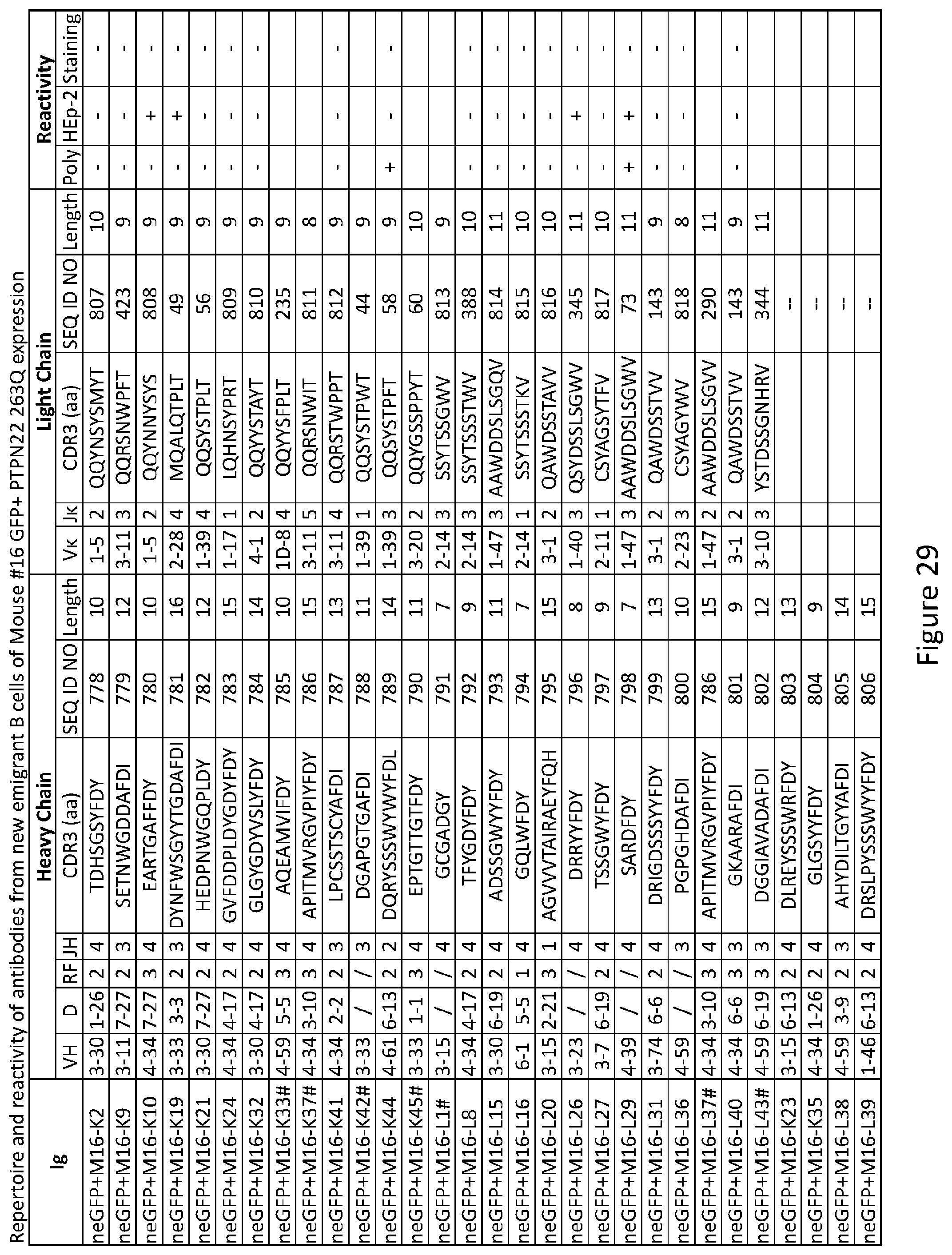
D00049

D00050
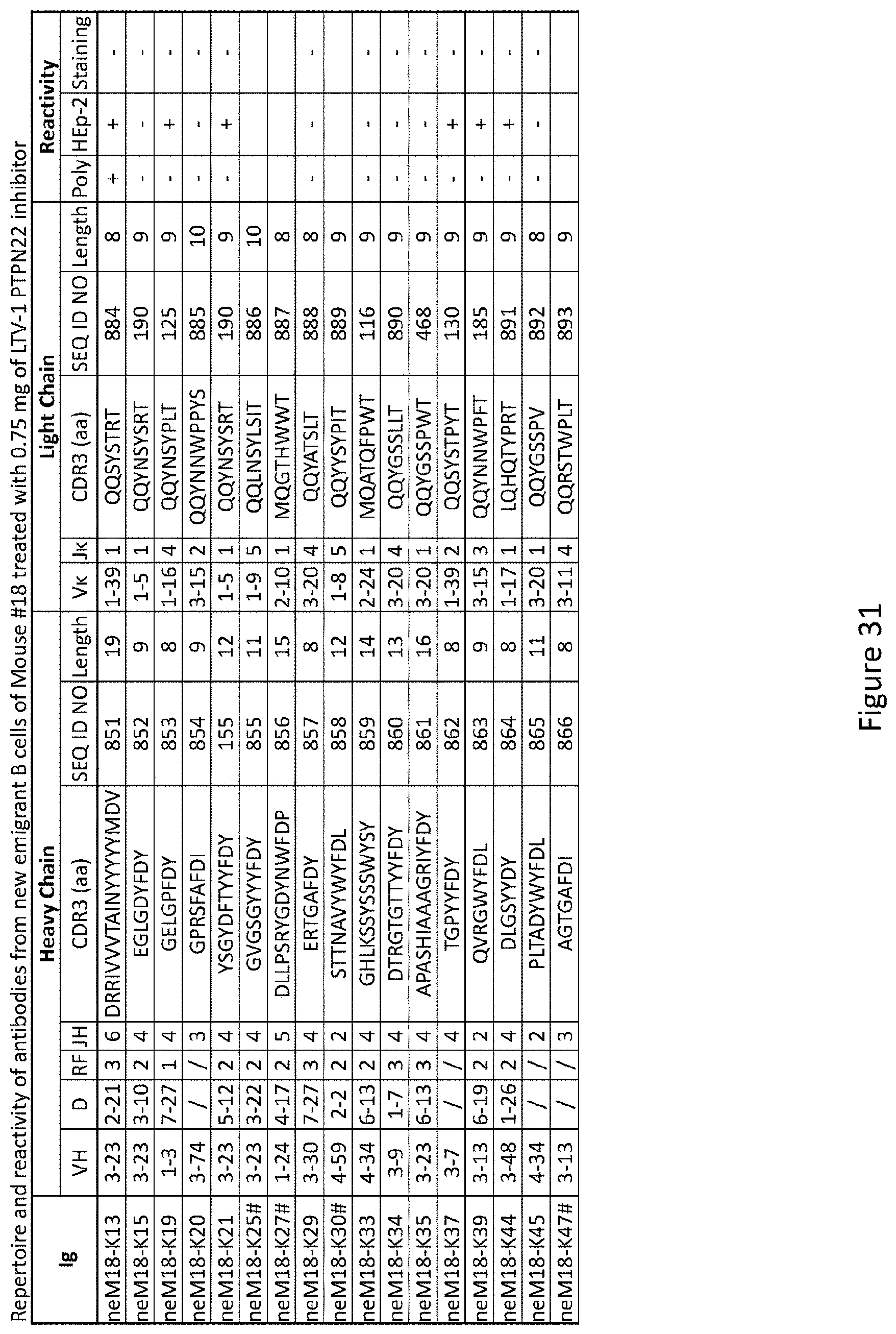
D00051

D00052
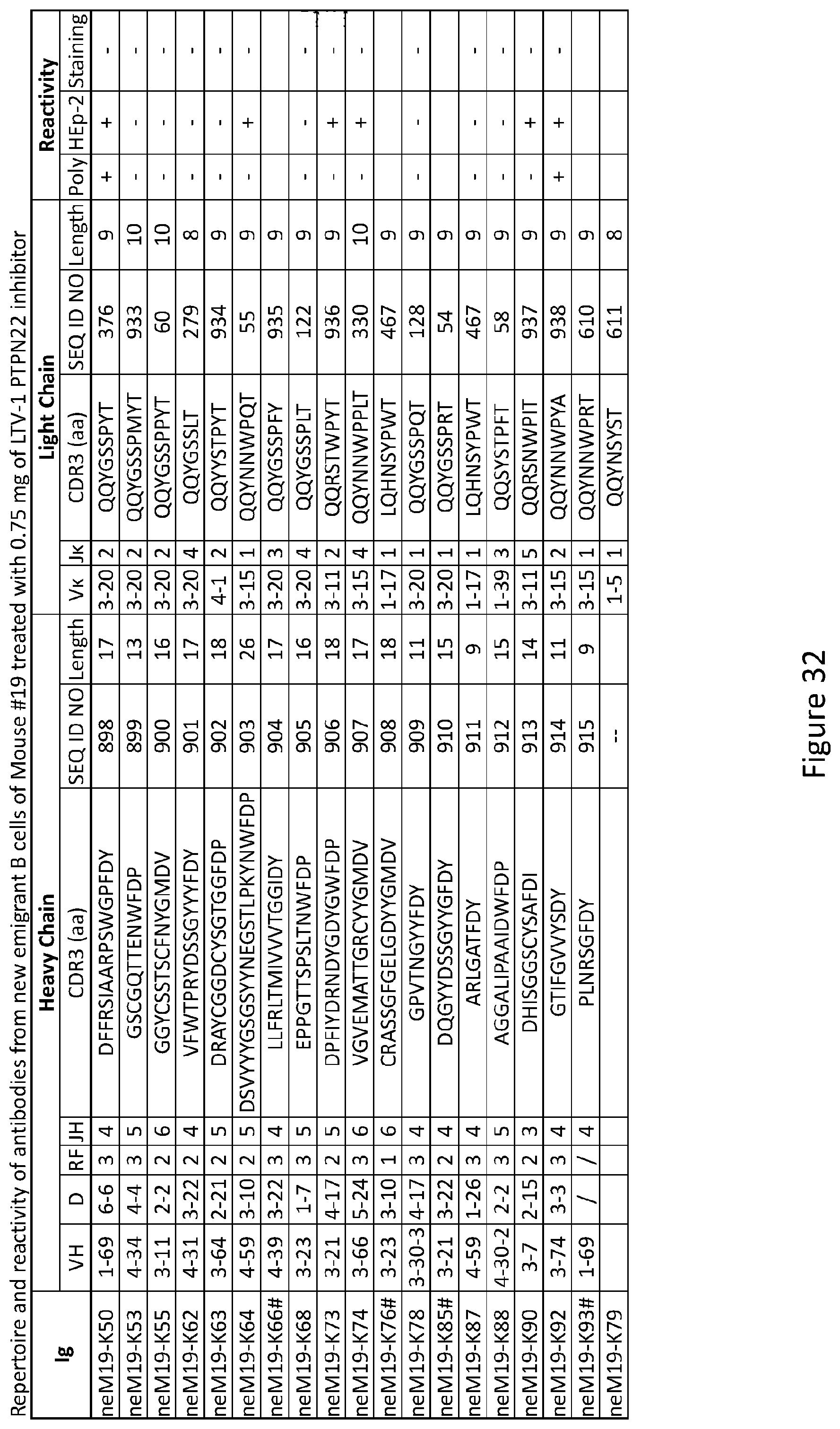
D00053

D00054
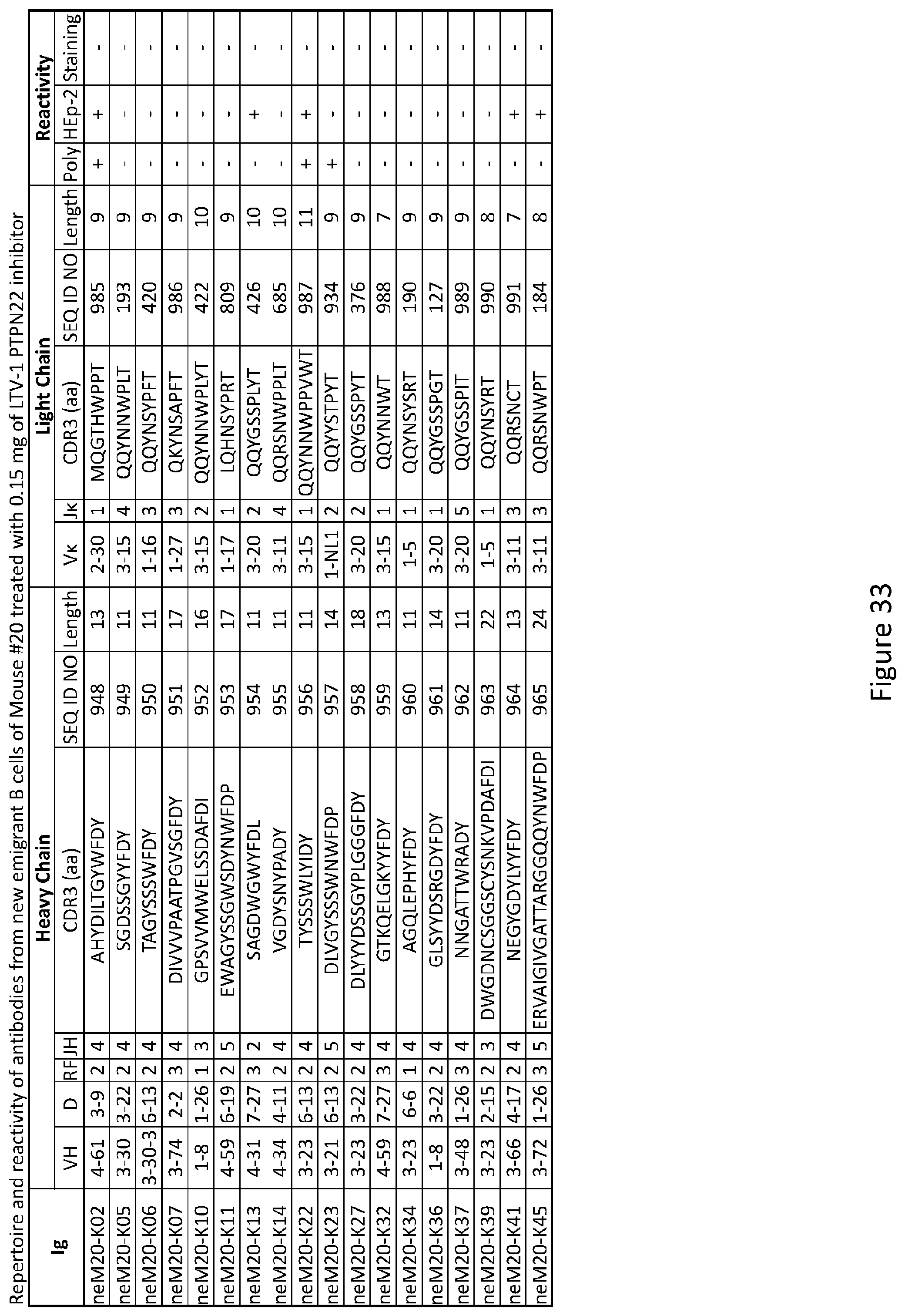
D00055

D00056
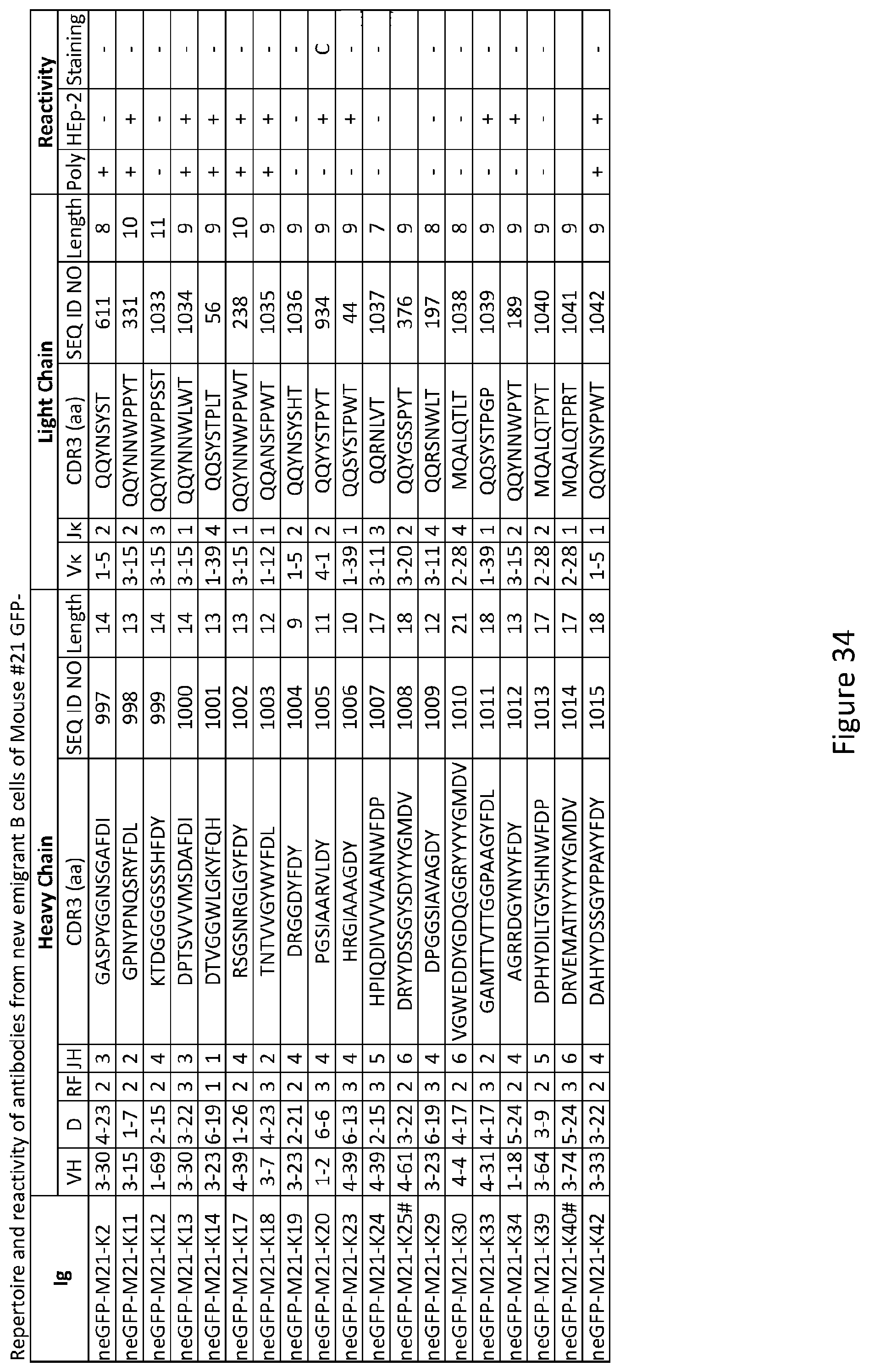
D00057
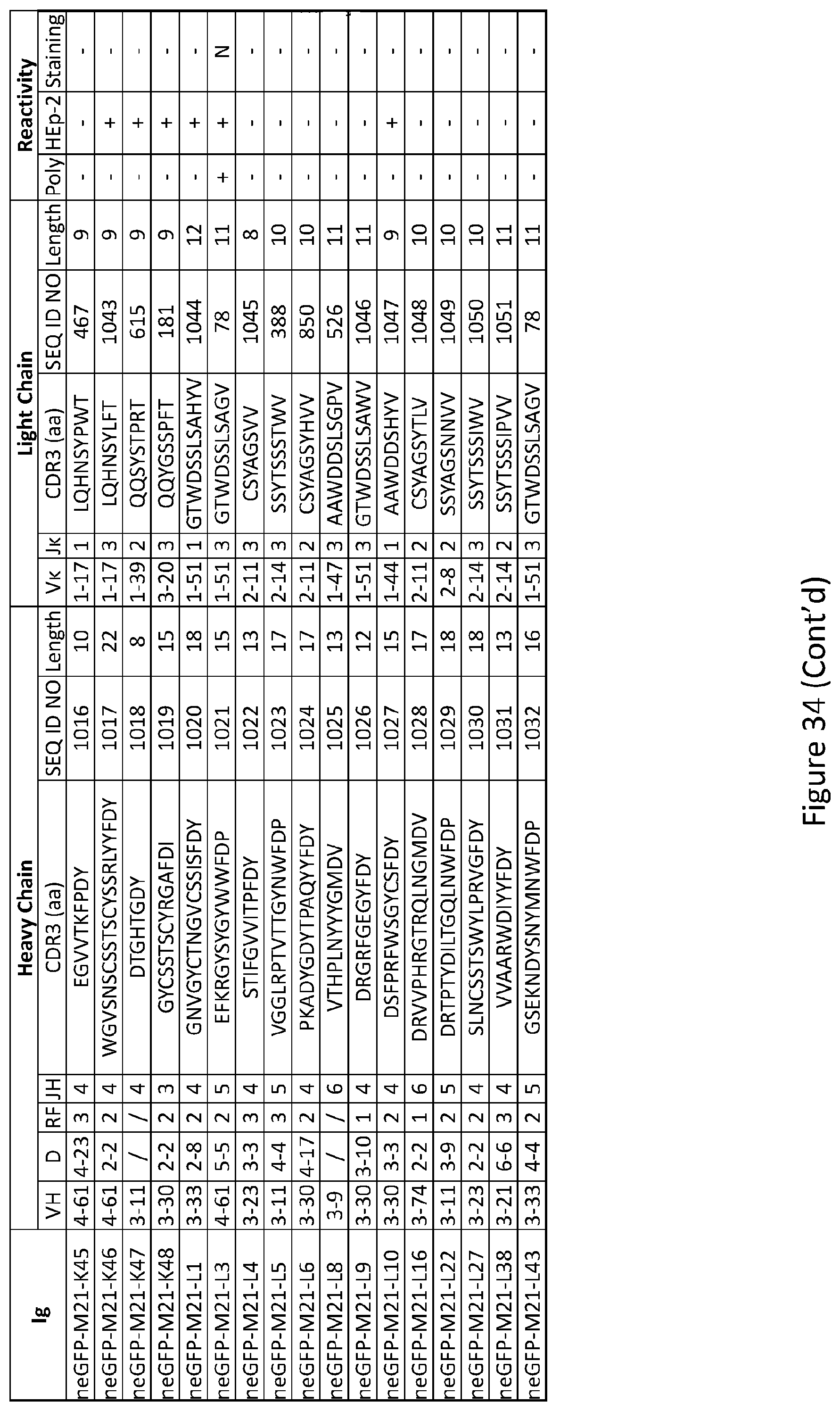
D00058
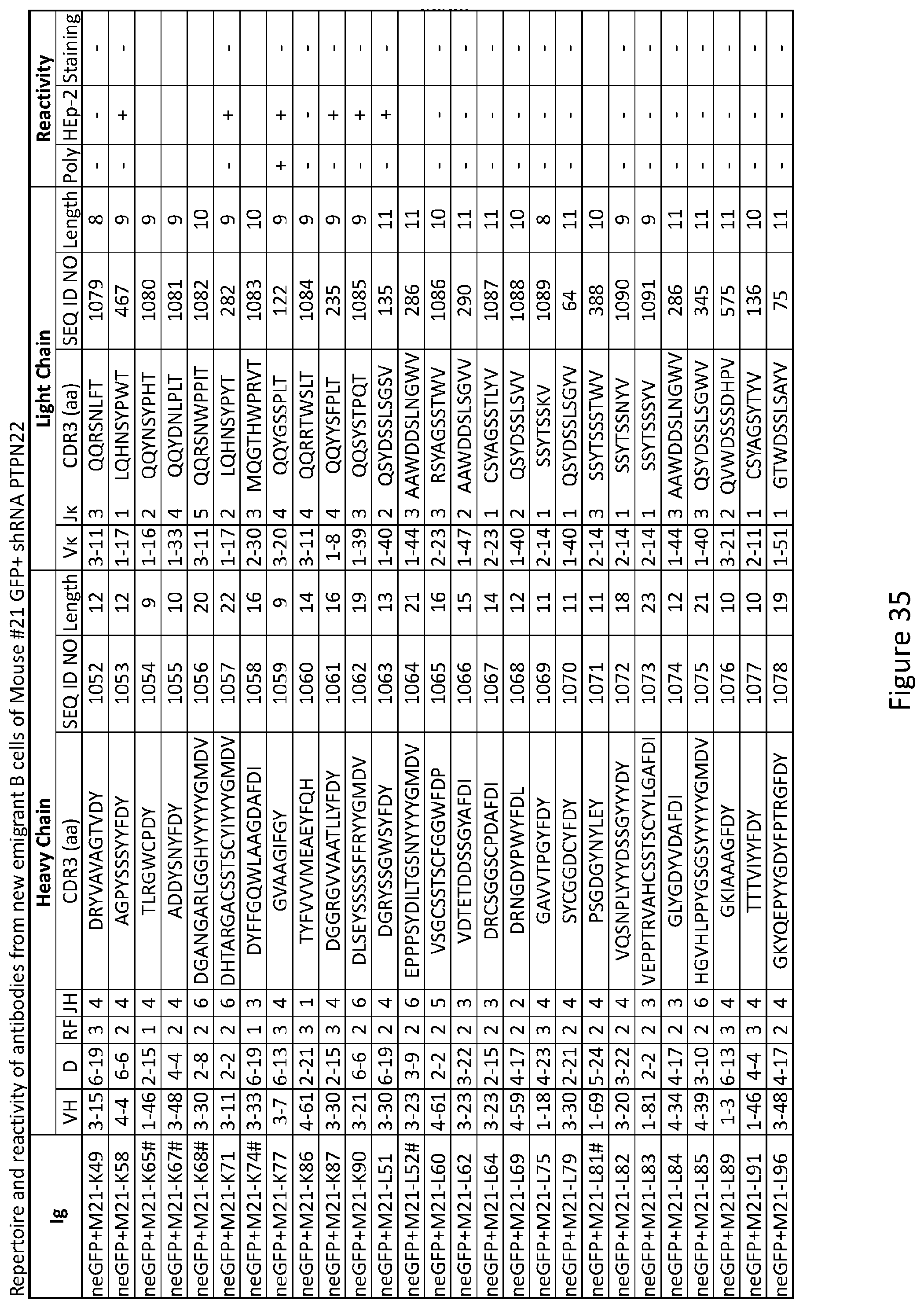
D00059

D00060
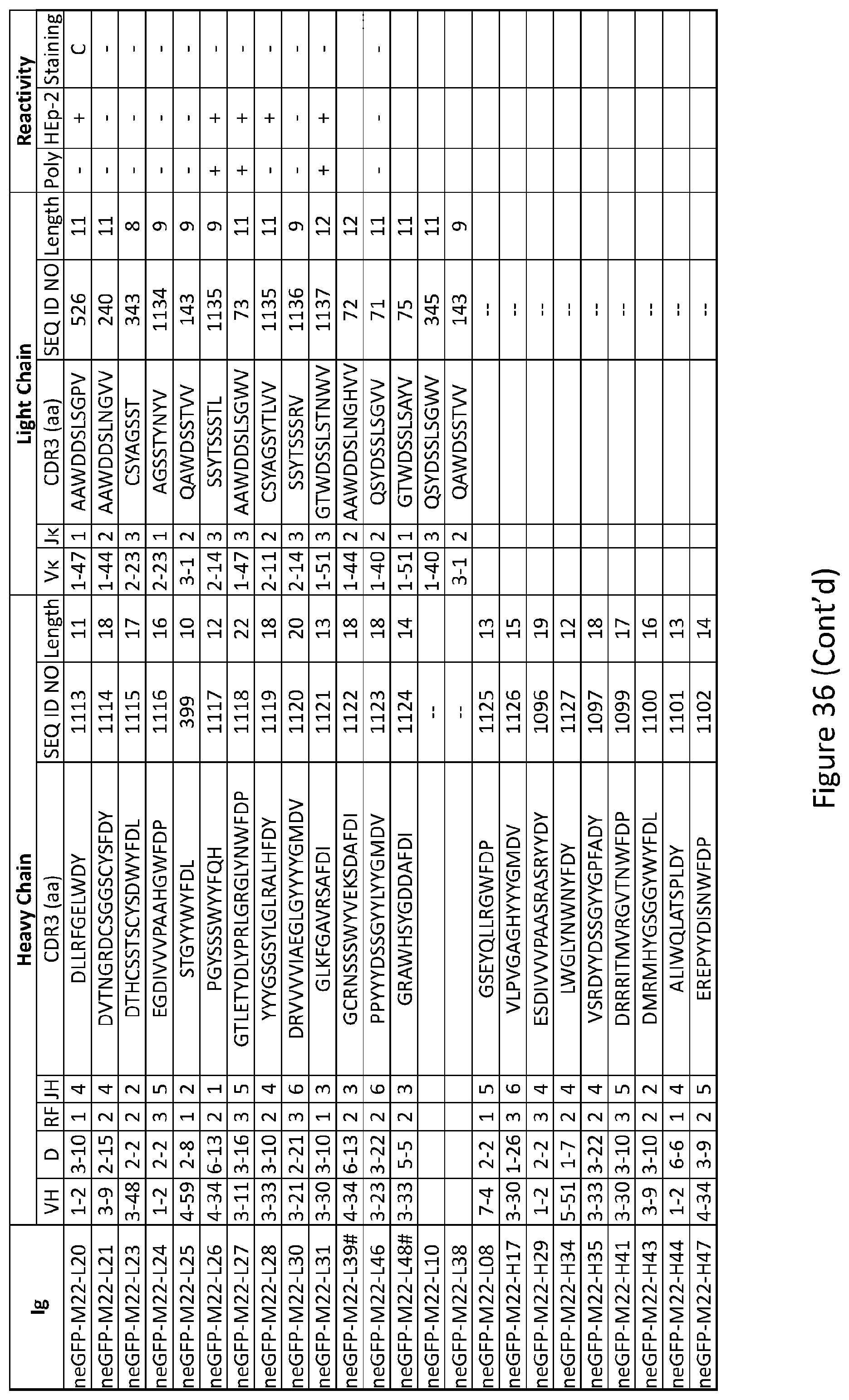
D00061
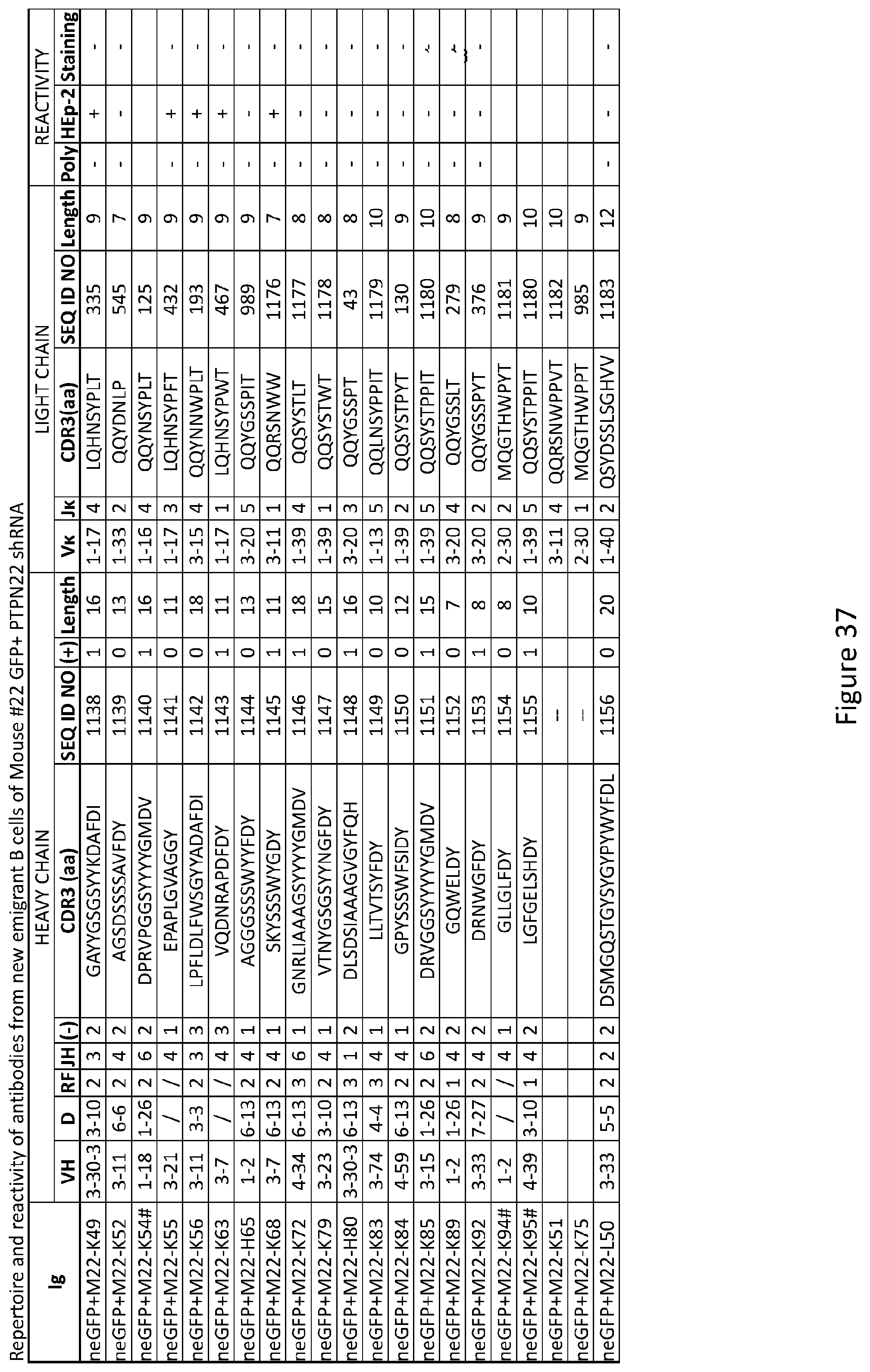
D00062
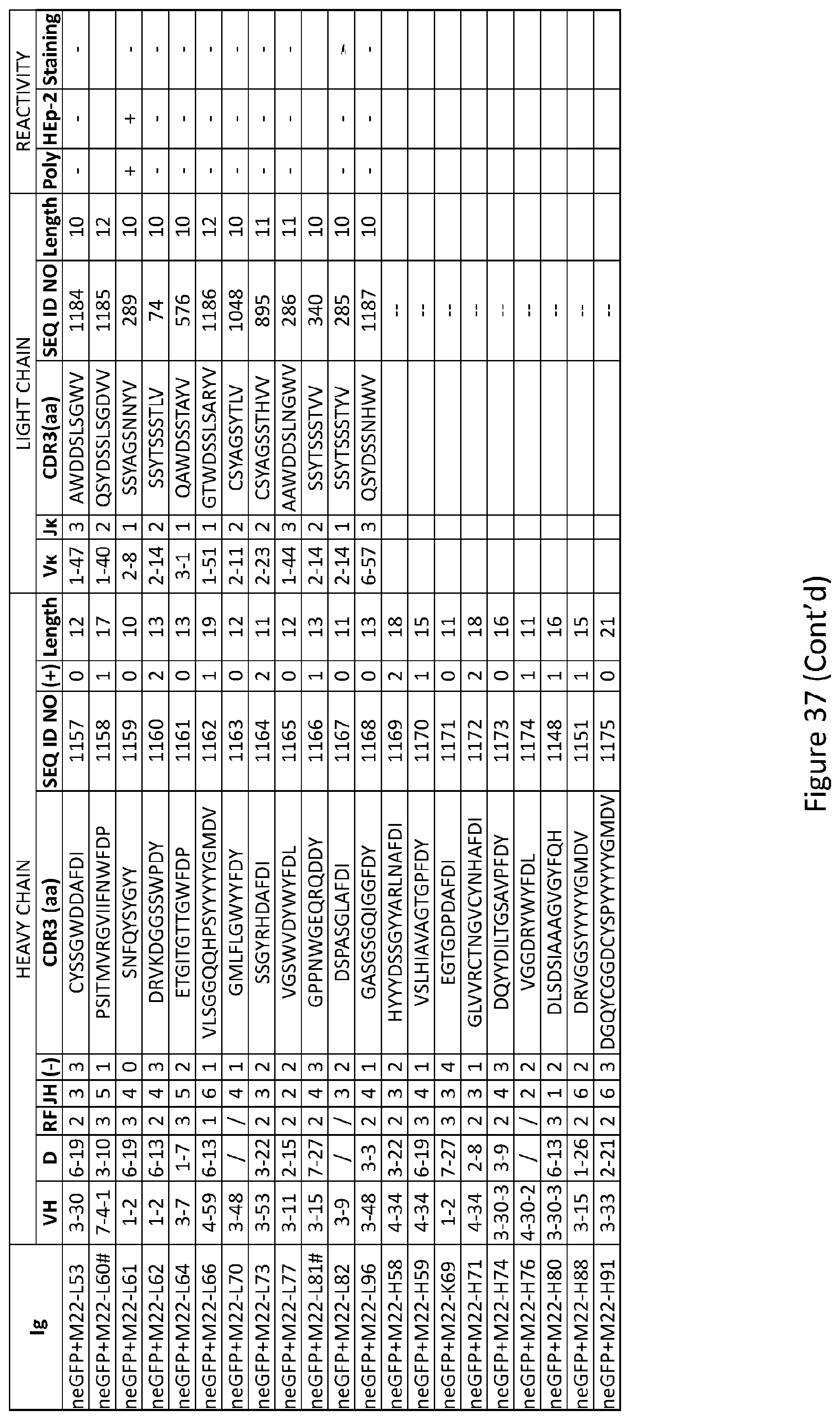
D00063

D00064
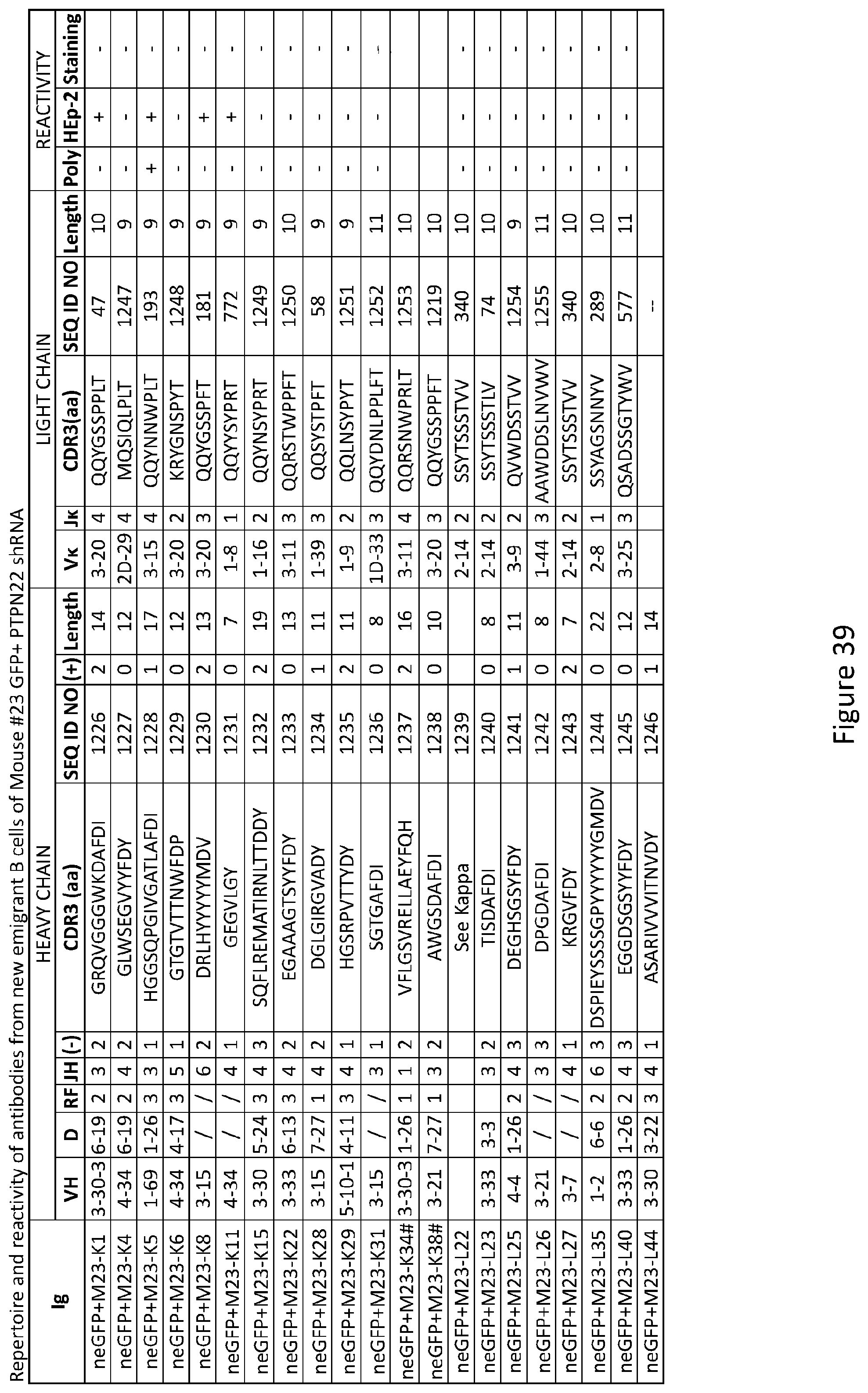
D00065
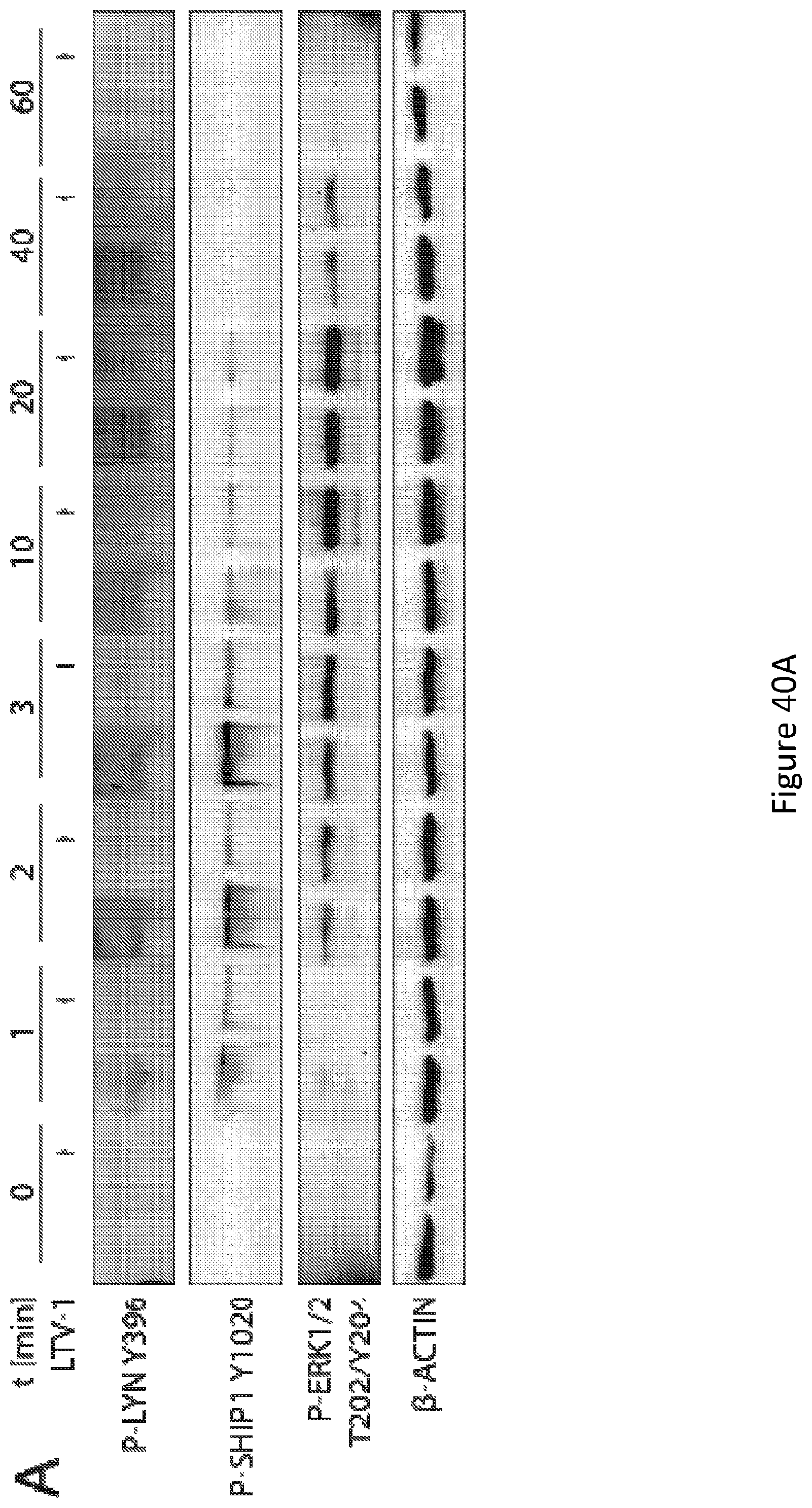
D00066

D00067

D00068
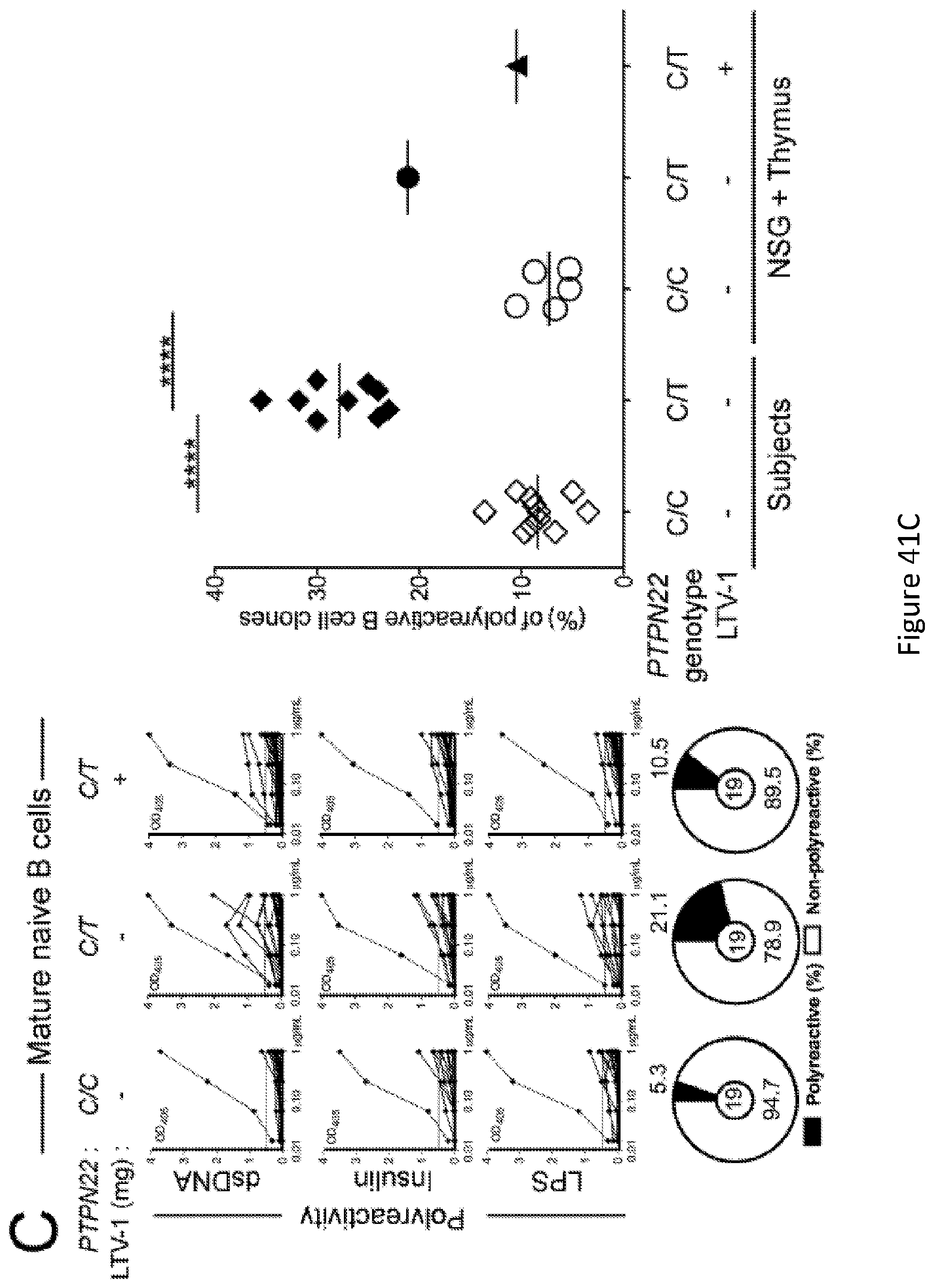
S00001
XML
uspto.report is an independent third-party trademark research tool that is not affiliated, endorsed, or sponsored by the United States Patent and Trademark Office (USPTO) or any other governmental organization. The information provided by uspto.report is based on publicly available data at the time of writing and is intended for informational purposes only.
While we strive to provide accurate and up-to-date information, we do not guarantee the accuracy, completeness, reliability, or suitability of the information displayed on this site. The use of this site is at your own risk. Any reliance you place on such information is therefore strictly at your own risk.
All official trademark data, including owner information, should be verified by visiting the official USPTO website at www.uspto.gov. This site is not intended to replace professional legal advice and should not be used as a substitute for consulting with a legal professional who is knowledgeable about trademark law.